Contents
User Manual

REVIEW DRAFT - CISCO CONFIDENTIAL
Cisco IP Phone 8811, 8841, 8845, 8851, 8851NR, 8861, and 8865 User
Guide for Cisco Unified Communications Manager 11.0
First Published: February 17, 2015
Americas Headquarters
Cisco Systems, Inc.
170 West Tasman Drive
San Jose, CA 95134-1706
USA
http://www.cisco.com
Tel: 408 526-4000
800 553-NETS (6387)
Fax: 408 527-0883
THE SPECIFICATIONS AND INFORMATION REGARDING THE PRODUCTS IN THIS MANUAL ARE SUBJECT TO CHANGE WITHOUT NOTICE. ALL STATEMENTS,
INFORMATION, AND RECOMMENDATIONS IN THIS MANUAL ARE BELIEVED TO BE ACCURATE BUT ARE PRESENTED WITHOUT WARRANTY OF ANY KIND,
EXPRESS OR IMPLIED. USERS MUST TAKE FULL RESPONSIBILITY FOR THEIR APPLICATION OF ANY PRODUCTS.
THE SOFTWARE LICENSE AND LIMITED WARRANTY FOR THE ACCOMPANYING PRODUCT ARE SET FORTH IN THE INFORMATION PACKET THAT SHIPPED WITH
THE PRODUCT AND ARE INCORPORATED HEREIN BY THIS REFERENCE. IF YOU ARE UNABLE TO LOCATE THE SOFTWARE LICENSE OR LIMITED WARRANTY,
CONTACT YOUR CISCO REPRESENTATIVE FOR A COPY.
The following information is for FCC compliance of Class A devices: This equipment has been tested and found to comply with the limits for a Class A digital device, pursuant to part 15
of the FCC rules. These limits are designed to provide reasonable protection against harmful interference when the equipment is operated in a commercial environment. This equipment
generates, uses, and can radiate radio-frequency energy and, if not installed and used in accordance with the instruction manual, may cause harmful interference to radio communications.
Operation of this equipment in a residential area is likely to cause harmful interference, in which case users will be required to correct the interference at their own expense.
The following information is for FCC compliance of Class B devices: This equipment has been tested and found to comply with the limits for a Class B digital device, pursuant to part 15
of the FCC rules. These limits are designed to provide reasonable protection against harmful interference in a residential installation. This equipment generates, uses and can radiate radio
frequency energy and, if not installed and used in accordance with the instructions, may cause harmful interference to radio communications. However, there is no guarantee that interference
will not occur in a particular installation. If the equipment causes interference to radio or television reception, which can be determined by turning the equipment off and on, users are
encouraged to try to correct the interference by using one or more of the following measures:
•Reorient or relocate the receiving antenna.
•Increase the separation between the equipment and receiver.
•Connect the equipment into an outlet on a circuit different from that to which the receiver is connected.
•Consult the dealer or an experienced radio/TV technician for help.
Modifications to this product not authorized by Cisco could void the FCC approval and negate your authority to operate the product
The Cisco implementation of TCP header compression is an adaptation of a program developed by the University of California, Berkeley (UCB) as part of UCB’s public domain version
of the UNIX operating system. All rights reserved. Copyright ©1981, Regents of the University of California.
NOTWITHSTANDING ANY OTHER WARRANTY HEREIN, ALL DOCUMENT FILES AND SOFTWARE OF THESE SUPPLIERS ARE PROVIDED "AS IS" WITH ALL FAULTS.
CISCO AND THE ABOVE-NAMED SUPPLIERS DISCLAIM ALL WARRANTIES, EXPRESSED OR IMPLIED, INCLUDING, WITHOUT LIMITATION, THOSE OF
MERCHANTABILITY, FITNESS FOR A PARTICULAR PURPOSE AND NONINFRINGEMENT OR ARISING FROM A COURSE OF DEALING, USAGE, OR TRADE PRACTICE.
IN NO EVENT SHALL CISCO OR ITS SUPPLIERS BE LIABLE FOR ANY INDIRECT, SPECIAL, CONSEQUENTIAL, OR INCIDENTAL DAMAGES, INCLUDING, WITHOUT
LIMITATION, LOST PROFITS OR LOSS OR DAMAGE TO DATA ARISING OUT OF THE USE OR INABILITY TO USE THIS MANUAL, EVEN IF CISCO OR ITS SUPPLIERS
HAVE BEEN ADVISED OF THE POSSIBILITY OF SUCH DAMAGES.
Any Internet Protocol (IP) addresses and phone numbers used in this document are not intended to be actual addresses and phone numbers. Any examples, command display output, network
topology diagrams, and other figures included in the document are shown for illustrative purposes only. Any use of actual IP addresses or phone numbers in illustrative content is unintentional
and coincidental.
Cisco and the Cisco logo are trademarks or registered trademarks of Cisco and/or its affiliates in the U.S. and other countries. To view a list of Cisco trademarks, go to this URL: http://
www.cisco.com/go/trademarks. Third-party trademarks mentioned are the property of their respective owners. The use of the word partner does not imply a partnership
relationship between Cisco and any other company. (1110R)
©2015 Cisco Systems, Inc. All rights reserved.

CONTENTS
CHAPTER 1
Getting Started 1
Accessibility Features 1
Cisco IP Phone 8811 1
Phone Connections 1
Buttons and Hardware 3
Cisco IP Phone 8841 6
Phone Connections 6
Buttons and Hardware 8
Cisco IP Phone 8845 11
Phone Connections 11
Buttons and Hardware 12
Cisco IP Phone 8851 and 8851NR 14
Phone Connections 14
Buttons and Hardware 16
Cisco IP Phone 8861 19
Phone Connections 19
Buttons and Hardware 21
Cisco IP Phone 8865 24
Phone Connections 24
Buttons and Hardware 25
Power Save and Power Save Plus 27
Power Save 27
Power Save Plus 28
Additional Information 28
CHAPTER 2
Phone Setup 29
Connect Footstand 29
Adjust the Handset Rest 30
Cisco IP Phone 8811, 8841, 8845, 8851, 8851NR, 8861, and 8865 User Guide for Cisco Unified Communications Manager
11.0
iii

Secure the Phone with a Cable Lock 30
CHAPTER 3
Basic Operations 33
Clean the Phone Display 33
Make Calls 34
Predial a Number 34
Place a Call Using the Speakerphone 34
Place a Call Using a Headset 35
Release a Call and Start Another Call 35
Dial an International Number 35
Redial a Number 36
Navigate and Select Items 36
View All Calls on the Phone 37
Answer Calls 37
Answer the Oldest Call First 38
Call Pickup 38
Answer a Call Using PickUp 39
Answer a Call Using Group PickUp and a Phone Number 40
Answer a Call Using Group PickUp and a Group PickUp Number 40
Answer a Call Using Other PickUp 41
Automatically Answer Calls 41
Respond to a Call Waiting Notification 42
Manage Calls 42
Decline a Call 42
Transfer a Call to Another Number 43
Toggle Between Calls Before Completing a Transfer 43
Monitor and Record Calls 44
Call Forward 44
Forward All Calls 44
Mute Phone 45
Hold Calls 45
Swap Between Active and Held Calls 45
Put a Call on Hold by Answering a New Call 46
Respond to a Hold Reversion Notification 46
Determine If a Shared Line Is On Hold 46
Cisco IP Phone 8811, 8841, 8845, 8851, 8851NR, 8861, and 8865 User Guide for Cisco Unified Communications
Manager 11.0
iv
Contents
REVIEW DRAFT - CISCO CONFIDENTIAL

Remote Hold 46
Set Up Call Back Notification 47
Call Park 47
Park and Retrieve a Call Using Call Park 48
Park a Call Using Assisted Directed Call Park 48
Park a Call Using Manual Directed Call Park 49
Manage Intercom Calls 49
Place a Dedicated Intercom Call 49
Place a Dialable Intercom Call 50
Receive an Intercom Call 50
View Phone Information 50
Video Calls 51
Hide or Show Video 51
Hide Softkeys in Full-Screen Video 51
Enable Full Screen Video 52
Mute Video 52
Swap Views 52
Adjust Picture-In-Picture Position 53
Sign In To the Cisco Unified Communications Self Care Portal 53
CHAPTER 4
Contacts 55
Corporate Directory 55
Search and Dial a Contact 55
Search and Dial a Contact While On a Call 56
Personal Directory 56
Sign In and Out of the Personal Directory 57
Add a Personal Directory Entry from the Phone 57
Search for an Entry in the Personal Directory 57
Dial a Number from the Personal Directory 58
Edit a Personal Directory Entry 58
Delete a Personal Directory Entry 59
Fast Dial 59
Place a Call With a Fast-Dial Button 59
Fast-Dial Codes with Personal Directory 59
Assign a Fast Dial Code to a Personal Directory Entry 60
Cisco IP Phone 8811, 8841, 8845, 8851, 8851NR, 8861, and 8865 User Guide for Cisco Unified Communications Manager
11.0
v
Contents
REVIEW DRAFT - CISCO CONFIDENTIAL

Place a Call Using a Fast Dial Code 60
Delete a Fast Dial Code 60
Cisco WebDialer 61
Use Cisco WebDialer with Another Online Corporate Directory 61
Change Cisco WebDialer Preferences 61
Sign Out of Cisco WebDialer 62
CHAPTER 5
Call History 63
Call History Overview 63
View the Call History 65
View Call Record Details 65
Filter the Call History 65
Dial From the Call History 66
Edit a Phone Number 66
Clear the Call History 67
Delete a Call Record 67
CHAPTER 6
Voicemail 69
Access Voicemail 69
Check for Voice Messages 69
Listen to Voice Messages 70
Visual Voicemail 70
CHAPTER 7
Advanced Calling Features 73
Conference 73
Add a Third Party to a Conference 74
Join Calls Into a Conference 74
Swap Between Calls Before Completing a Conference 74
View Conference Participants 75
Remove Conference Participants 75
Meet Me Conference 75
Host a Meet Me Conference 76
Join a Meet Me Conference 76
Speed Dial 76
Place a Call with a Speed-Dial Button 77
Cisco IP Phone 8811, 8841, 8845, 8851, 8851NR, 8861, and 8865 User Guide for Cisco Unified Communications
Manager 11.0
vi
Contents
REVIEW DRAFT - CISCO CONFIDENTIAL

Use a Speed-Dial Code On Hook 77
Use a Speed-Dial Code Off Hook 77
Pause in Speed Dial 77
Do Not Disturb 78
Turn DND On and Off 79
Malicious Call Identification 79
Trace a Suspicious Call 79
Extension Mobility 79
Enable Extension Mobility 80
Mobile Connect 80
Enable Mobile Connect 81
Turn Mobile Connect On or Off for All Remote Destinations from a Desk Phone 81
Switch a Desk Phone Call to a Mobile Phone 81
Switch a Mobile Call to the Desk Phone 81
Hand Off a Call from a Mobile Phone to the Desk Phone 82
Line Status 82
Line Status Indicators 82
Custom Line Filters 83
Add a Line Filter 84
Select an Active Line Filter 84
Delete a Line Filter 84
Duplicate a Line Filter 85
Edit a Line Filter 85
Rename a Line Filter 86
Hunt Groups 86
Sign In and Out of a Hunt Group 86
Display Queue Statistics 87
Barge 87
Set Up Barge Alert 87
Add Yourself to a Call on a Shared Line 87
Enable Privacy on a Shared Line 87
Dismiss the Barge Alert Prompt Window 88
Call Chaperone 88
Record a Chaperoned Call 89
Uniform Resource Identifier Dialing 89
Cisco IP Phone 8811, 8841, 8845, 8851, 8851NR, 8861, and 8865 User Guide for Cisco Unified Communications Manager
11.0
vii
Contents
REVIEW DRAFT - CISCO CONFIDENTIAL

Intelligent Proximity for Mobile Devices 90
Pair a Mobile Device 91
Switch Connected Mobile Devices 91
Delete a Mobile Device 92
Answer a Mobile Call 92
Decline a Mobile Call 92
Ignore a Mobile Call 92
Place a Mobile Call 93
Move a Call Between the IP Phone and a Mobile Phone 93
Adjust the Mobile Device Volume 93
Mobile Contacts and Mobile Call History Sharing 93
Synchronize Bluetooth Contacts 94
Save Bluetooth Contacts 94
Delete Bluetooth Contacts 94
Intelligent Proximity for Tablets 94
Pair a Tablet 95
Move Audio from the Tablet to the Phone 95
Manage Tablet Audio on Phone 96
CHAPTER 8
Advanced Operations 97
Applications 97
View Active Applications 97
Switch to Active Applications 98
Close Active Applications 98
Mobile and Remote Access Through Expressway 98
Phone Features Available for Mobile and Remote Access Through Expressway 99
Sign in with Mobile and Remote Access Through Expressway 100
Cisco Collaboration Problem Reporting Tool 101
Report a Problem with Cisco Collaboration Problem Reporting Tool 101
Set Up a VPN Phone for Mobile and Remote Access Through Expressway 102
Set Up a Phone for Use with VPN 102
Turn Off the Alternate TFTP Server 103
Video Calls and Security 103
Call Functions 104
Agent Greeting 104
Cisco IP Phone 8811, 8841, 8845, 8851, 8851NR, 8861, and 8865 User Guide for Cisco Unified Communications
Manager 11.0
viii
Contents
REVIEW DRAFT - CISCO CONFIDENTIAL

Alert Calls 104
Actionable Incoming Call Alert 104
Answer 104
Client Matter Code 105
Forced Authorization Code 105
Secure and Nonsecure Indication Tones 105
Shared Lines 106
Feature Buttons and Softkey 106
Survivable Remote Site Telephony Overview 108
CHAPTER 9
User Preferences 111
Change the Wallpaper 111
Change the Ringtone 112
Adjust the Phone Screen Brightness 112
Adjust Phone Screen Contrast 112
Change the Font Size 113
Change the Phone Name 114
Adjust the Headset Sidetone 114
Phone Services 115
Line Settings 115
CHAPTER 10
Cisco Unified Video Camera 117
Install Cisco Unified Video Camera 117
Mount Camera on Phone 117
Mount Camera on Monitor 118
View Camera Details 119
Cisco Unified Video Camera Features 119
Camera Lens Shutter 120
Close Camera Lens Shutter 121
Camera Preferences 121
Enable Auto Transmit 121
Adjust Camera Brightness 122
Adjust Camera View Area 122
Access Preview Video 123
Enable Video 123
Cisco IP Phone 8811, 8841, 8845, 8851, 8851NR, 8861, and 8865 User Guide for Cisco Unified Communications Manager
11.0
ix
Contents
REVIEW DRAFT - CISCO CONFIDENTIAL

Reset Camera 124
CHAPTER 11
Accessories 125
Accessory List 125
View the Accessories List 126
View Accessories Details 126
USB Devices 127
Mobile Device Charging 127
Set Up Wideband for an Analog Headset 128
Bluetooth Headsets 129
Add a Bluetooth Accessory 130
Connect a Bluetooth Accessory 130
Turn On Bluetooth 131
Disconnect a Bluetooth Accessory 131
Delete a Bluetooth Accessory 131
USB Headsets 132
Cisco IP Phone 8800 Key Expansion Module 132
Cisco IP Phone 8800 Key Expansion Module Features 133
Place a Call on the Key Expansion Module 136
Configure KEM Buttons 136
Adjust Key Expansion Module Brightness 137
CHAPTER 12
Frequently Asked Questions 139
Why Can't I See All Active Calls on My Phone? 140
How Do I Redirect an Incoming Call? 140
How Do I Silence a Ringing Call If I'm On a Call? 140
How Do I Resume a Call That is On Hold? 140
What Is the Difference Between Buttons on the Left and Those on the Right of the
Screen? 141
Why Do Softkeys Keep Changing? 141
What Is the Best Way to Look at Calls When I Have a Shared Line or Multiple Lines? 141
What Should I Do If I Accidentally Press a Button While on a Call? 142
How Do I Check Missed Calls? 142
How Do I Exit from a Running Application? 142
How Do I Connect Two Calls and then Drop from the Line Myself? 143
Cisco IP Phone 8811, 8841, 8845, 8851, 8851NR, 8861, and 8865 User Guide for Cisco Unified Communications
Manager 11.0
x
Contents
REVIEW DRAFT - CISCO CONFIDENTIAL

What Does the Swap Softkey Do? 143
How Do I Cancel a Conference or Transfer After I Start It? 143
How Can I Combine Two Calls Into a Single Conference Call? 144
Why Does My Phone Not Wake Up? 144
What Do Four Rings in Succession Mean? 144
Where Should I Mount My Cisco Unified Video Camera? 145
How Can I Prevent Theft of my Cisco Unified Video Camera? 145
Why Do Some Calls Not Present Video On My Video Phone? 145
What Happens to Video When I Put a Call On Hold? 146
What Do the Light Colors on My Cisco Unified Video Camera Indicate? 146
How Do I Close the Shutter on my Cisco Unified Video Camera? 146
Why Does the Video on my Cisco Unifed Video Camera Appear Too Dark? 146
CHAPTER 13
Troubleshooting 149
Missing Alert Calls Button 149
Missing All Calls Button 149
Missing Mobile and Remote Access through Expressway Sign-in Window 150
Cannot Sign In to Personal Directory 150
Cannot Access Self Care Portal 151
Security Error Message 151
Report Phone Problems 151
Documentation, Service Requests, and Additional Information 152
CHAPTER 14
Product Safety and Security 153
Safety and Performance Information 153
Power Outage 153
External Devices 153
Bluetooth Wireless Headset Performance 154
Power Information 154
FCC Compliance Statements 154
FCC Part 15.21 Statement 154
FCC RF Radiation Exposure Statement 154
FCC Receivers and Class B Digital Statement 155
Cisco Product Security Overview 155
Cisco IP Phone 8811, 8841, 8845, 8851, 8851NR, 8861, and 8865 User Guide for Cisco Unified Communications Manager
11.0
xi
Contents
REVIEW DRAFT - CISCO CONFIDENTIAL

CHAPTER 1
Getting Started
•Accessibility Features, page 1
•Cisco IP Phone 8811, page 1
•Cisco IP Phone 8841, page 6
•Cisco IP Phone 8845, page 11
•Cisco IP Phone 8851 and 8851NR, page 14
•Cisco IP Phone 8861, page 19
•Cisco IP Phone 8865, page 24
•Power Save and Power Save Plus, page 27
•Additional Information, page 28
Accessibility Features
Cisco IP Phones provide accessibility features for the vision impaired, the blind, and the hearing and mobility
impaired.
For detailed information about the accessibility features on these phones, see http://www.cisco.com/c/en/us/
support/collaboration-endpoints/unified-ip-phone-8800-series/products-technical-reference-list.html.
You can also find more information about accessibility at this Cisco website:
http://www.cisco.com/web/about/responsibility/accessibility/index.html
Cisco IP Phone 8811
The following sections describe attributes of the Cisco IP Phone 8811.
Phone Connections
Connect your phone to the corporate IP telephony network, using the following diagram.
Cisco IP Phone 8811, 8841, 8845, 8851, 8851NR, 8861, and 8865 User Guide for Cisco Unified Communications Manager
11.0
1
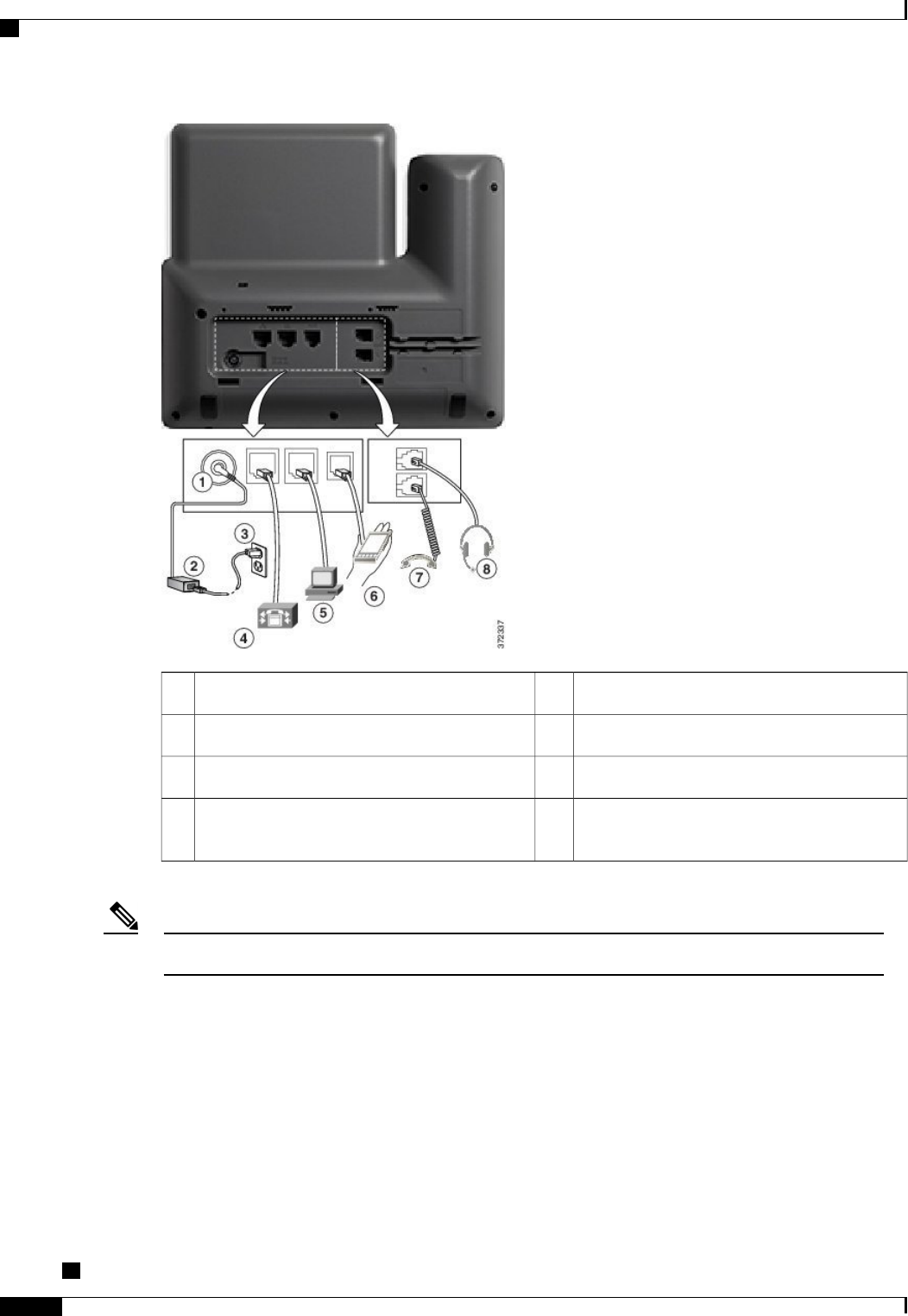
Access port (10/100/1000 PC) connection.5DC adaptor port (DC48V).1
Auxiliary port.6AC-to-DC power supply (optional).2
Handset connection.7AC power wall plug (optional).3
Analog headset connection (optional).8Network port (10/100/1000 SW) connection.
IEEE 802.3at power enabled.
4
The Cisco IP Phone 8811 does not support the Cisco IP Phone 8800 Key Expansion Module.Note
Cisco IP Phone 8811, 8841, 8845, 8851, 8851NR, 8861, and 8865 User Guide for Cisco Unified Communications
Manager 11.0
2
Getting Started
Phone Connections
REVIEW DRAFT - CISCO CONFIDENTIAL
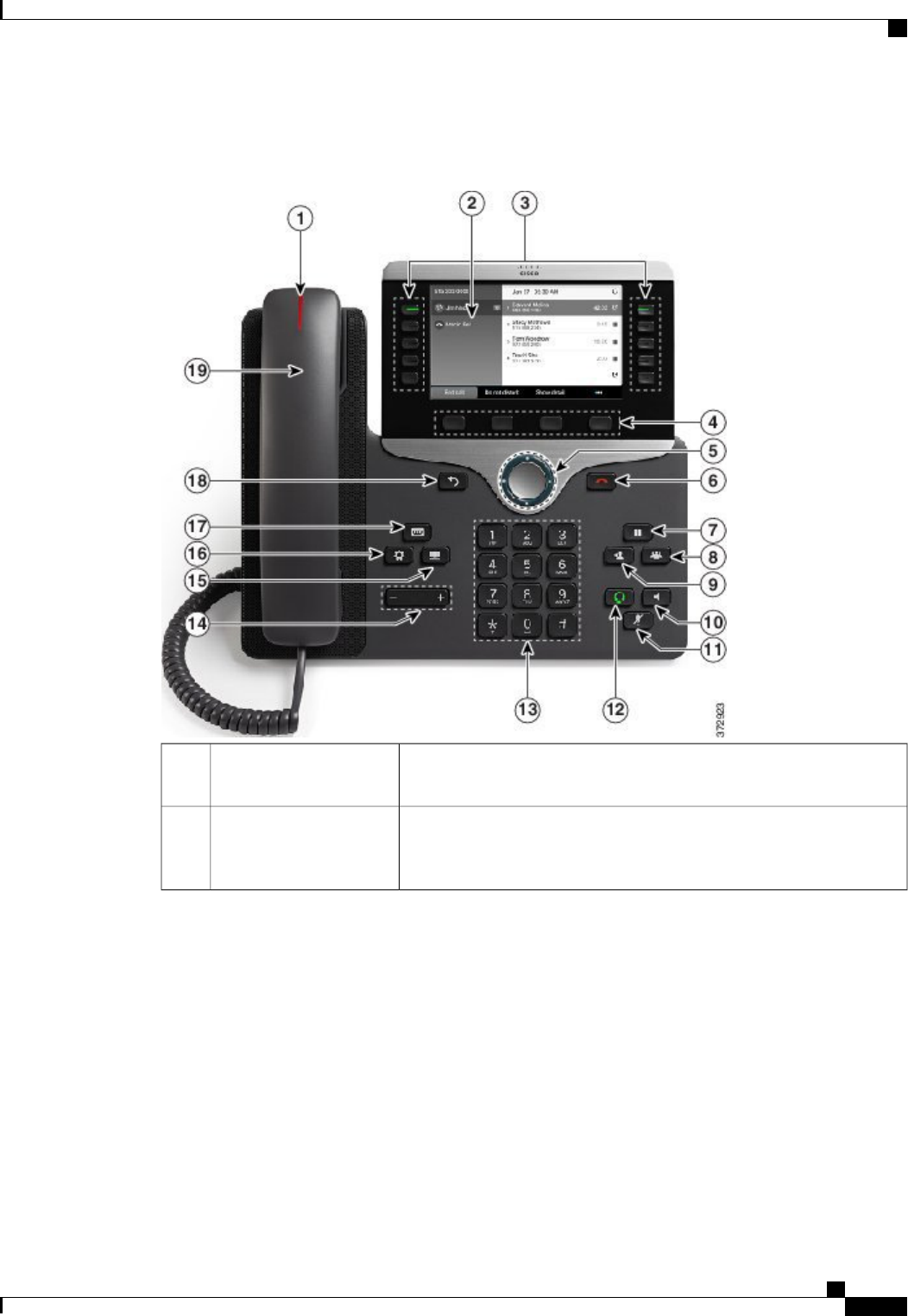
Buttons and Hardware
Indicates an incoming call (flashing red) or new voice message (steady
red).
Handset light strip1
Shows information about your phone such as directory number, active
call and line status, softkey options, speed dials, placed calls, and phone
menu listings. The Cisco IP Phone 8811 screen is grayscale.
Phone screen2
Cisco IP Phone 8811, 8841, 8845, 8851, 8851NR, 8861, and 8865 User Guide for Cisco Unified Communications Manager
11.0
3
Getting Started
Buttons and Hardware
REVIEW DRAFT - CISCO CONFIDENTIAL
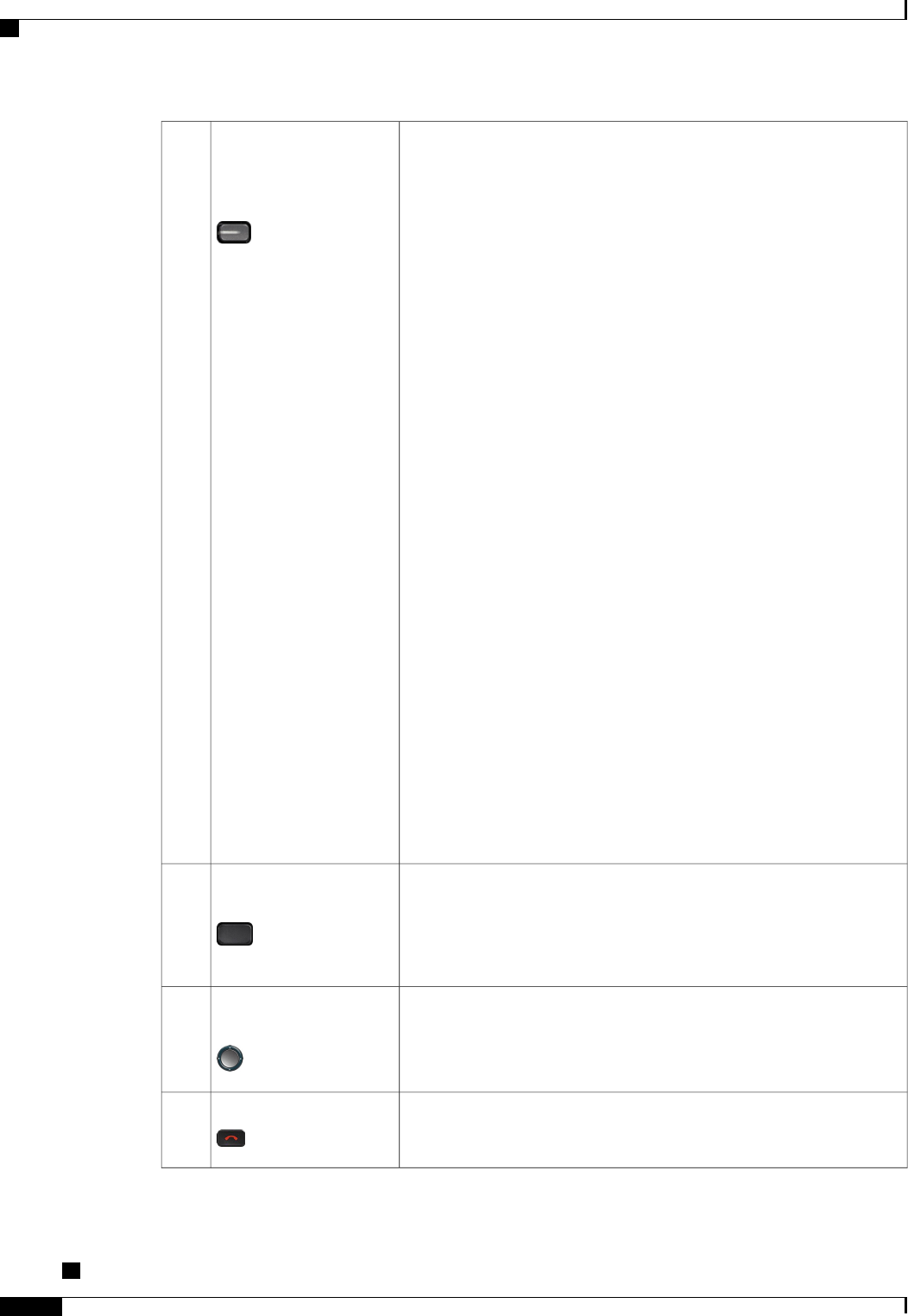
Your phone provides quick access to your phone lines, features, and call
sessions:
•Programmable feature buttons (left side): Use to view calls on a
line or access features such as Speed Dial or All Calls. These buttons
are also called feature buttons.
•Session buttons (right side): Use to perform tasks such as answering
a call, resuming a held call, or (when not being used for an active
call) initiating phone functions such as displaying missed calls. Each
call on your phone is associated with a session button.
If you are using a locale that reads right to left, such as Arabic,
the line button and session button locations are swapped.
Note
Depending on how your system administrator sets up the phone, the
buttons provide access to:
•Phone lines and intercom lines
•Speed-dial numbers (speed-dial buttons, including the Line Status
speed-dial features)
•Web-based services (for example, a Personal Address Book button)
•Call features (for example, a Privacy button)
Buttons illuminate to indicate status:
•Green, steady: Active call or two-way intercom call
•Green, flashing: Held call
•Amber, steady: Privacy in use, one-way intercom call, DND active,
or logged into Hunt Group
•Amber, flashing: Incoming call or reverting call
•Red, steady: Remote line in use (shared line or Line Status)
•Red, flashing: Remote line on hold
Programmable feature
buttons and Session
buttons
3
Depending on how your system administrator sets up the phone, enable
softkey options displayed on your phone screen.
Softkey buttons4
The Navigation cluster and Select button allows you to scroll through
menus, highlight items, and select the highlighted item.
Navigation cluster and
Select button
5
Ends a connected call or session.Release Button
6
Cisco IP Phone 8811, 8841, 8845, 8851, 8851NR, 8861, and 8865 User Guide for Cisco Unified Communications
Manager 11.0
4
Getting Started
Buttons and Hardware
REVIEW DRAFT - CISCO CONFIDENTIAL
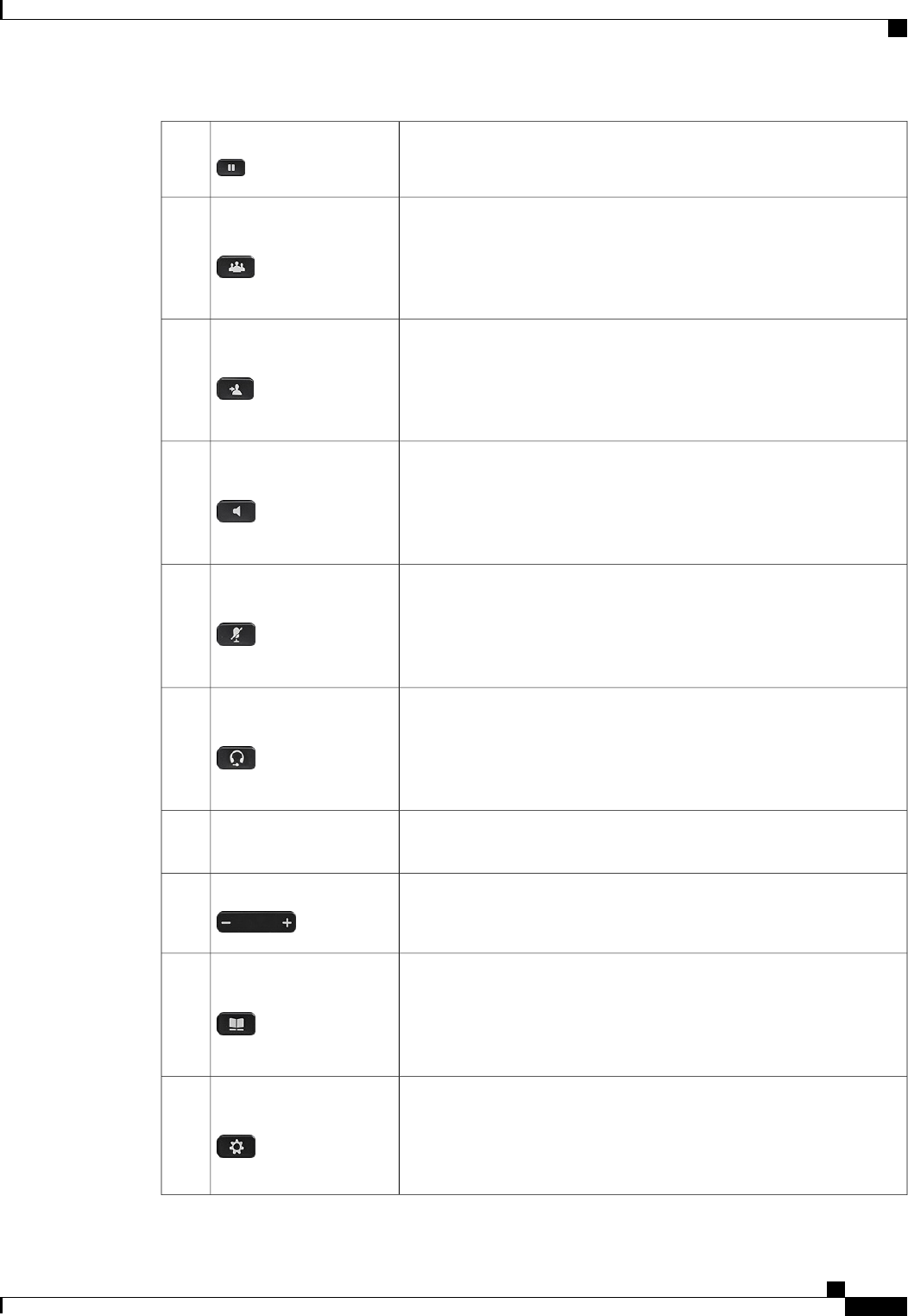
Places an active call on hold and resumes the held call.Hold/Resume button7
Creates a conference call.Conference button8
Transfers a call.Transfer button
9
Toggles the speakerphone on or off. When the speakerphone is on, the
button is lit.
Speakerphone button10
Toggles the microphone on or off. When the microphone is muted, the
button is lit.
Mute button
11
Toggles the headset on or off. When the headset is on, the button is lit.Headset button
12
Allows you to dial phone numbers, enter letters, and select menu items
(by entering the item number).
Keypad13
Controls the handset, headset, and speakerphone volume (off hook) and
the ringer volume (on hook).
Volume button
14
Opens or closes the Directories menu. Use the Contacts button to access
personal and corporate directories.
Contacts button
15
Opens or closes the Applications menu. Use the Applications button to
access call history, user preferences, phone settings, and phone model
information.
Applications button
16
Cisco IP Phone 8811, 8841, 8845, 8851, 8851NR, 8861, and 8865 User Guide for Cisco Unified Communications Manager
11.0
5
Getting Started
Buttons and Hardware
REVIEW DRAFT - CISCO CONFIDENTIAL
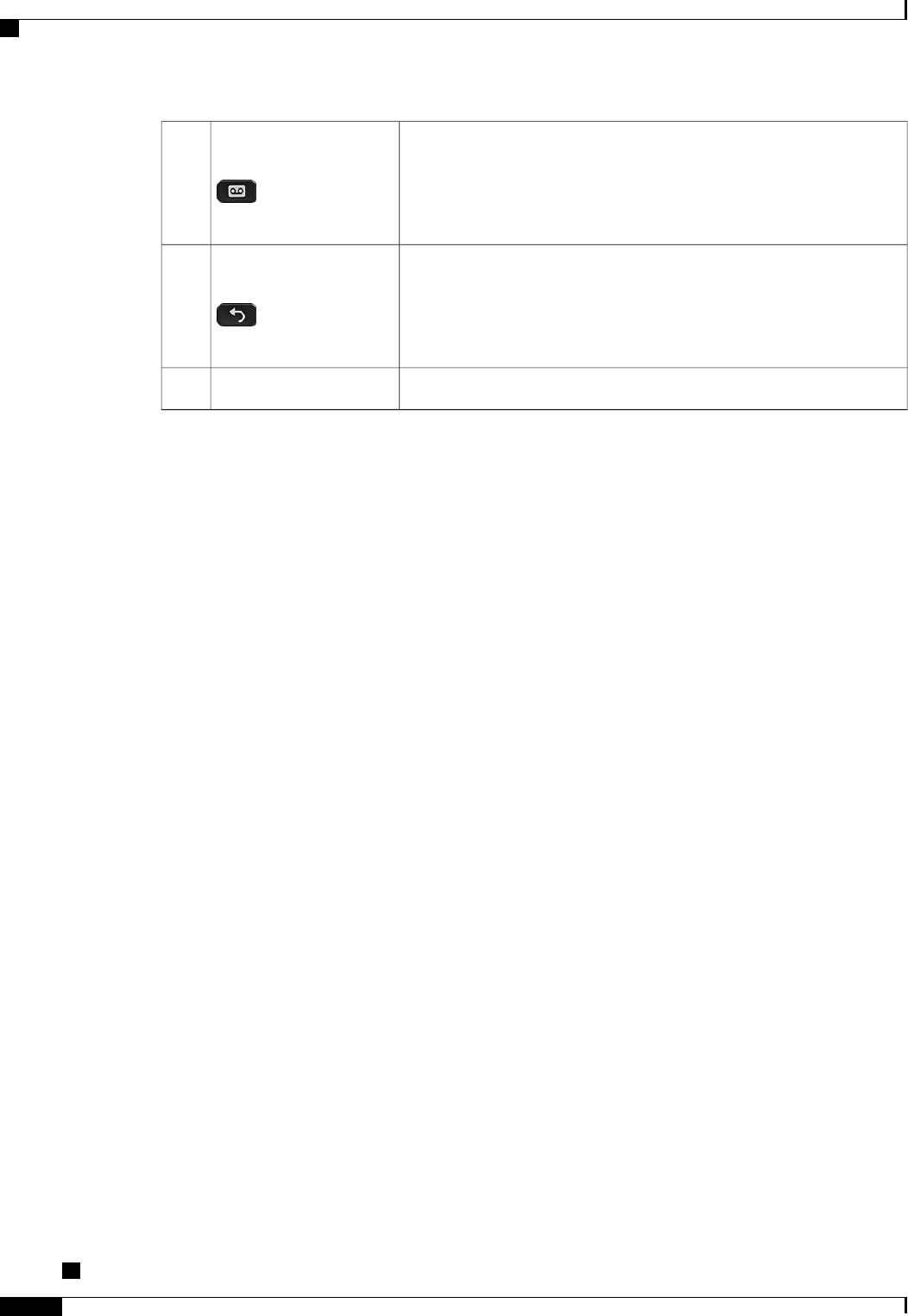
Autodials your voice messaging system (varies by system).Messages button17
Returns to the previous screen or menu.Back button
18
Phone handset.Handset19
Cisco IP Phone 8841
The following sections describe attributes of the Cisco IP Phone 8841.
Phone Connections
Connect your phone to the corporate IP telephony network, using the following diagram.
Cisco IP Phone 8811, 8841, 8845, 8851, 8851NR, 8861, and 8865 User Guide for Cisco Unified Communications
Manager 11.0
6
Getting Started
Cisco IP Phone 8841
REVIEW DRAFT - CISCO CONFIDENTIAL
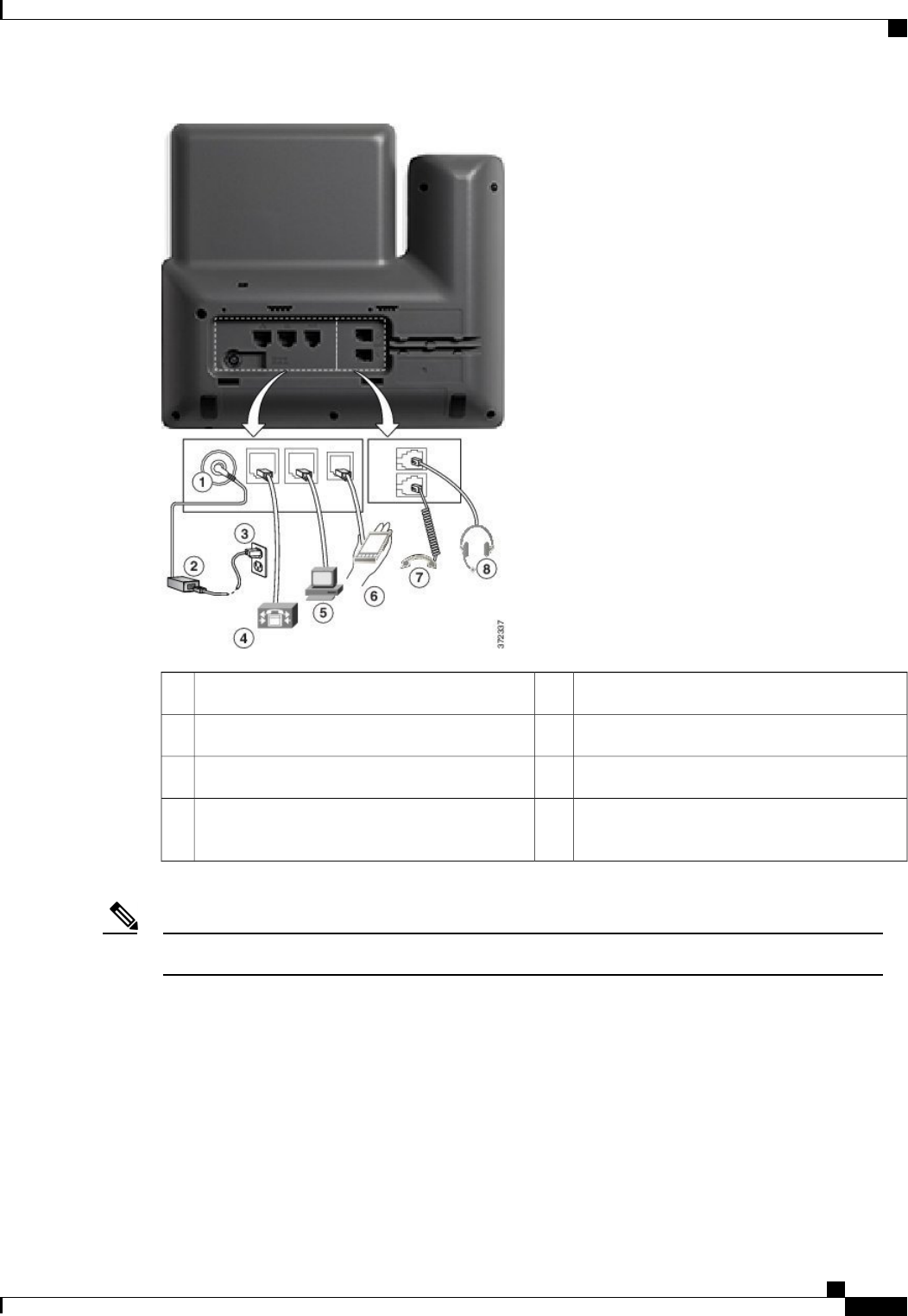
Access port (10/100/1000 PC) connection.5DC adaptor port (DC48V).1
Auxiliary port.6AC-to-DC power supply (optional).2
Handset connection.7AC power wall plug (optional).3
Analog headset connection (optional).8Network port (10/100/1000 SW) connection.
IEEE 802.3at power enabled.
4
The Cisco IP Phone 8841 does not support the Cisco IP Phone 8800 Key Expansion Module.Note
Cisco IP Phone 8811, 8841, 8845, 8851, 8851NR, 8861, and 8865 User Guide for Cisco Unified Communications Manager
11.0
7
Getting Started
Phone Connections
REVIEW DRAFT - CISCO CONFIDENTIAL
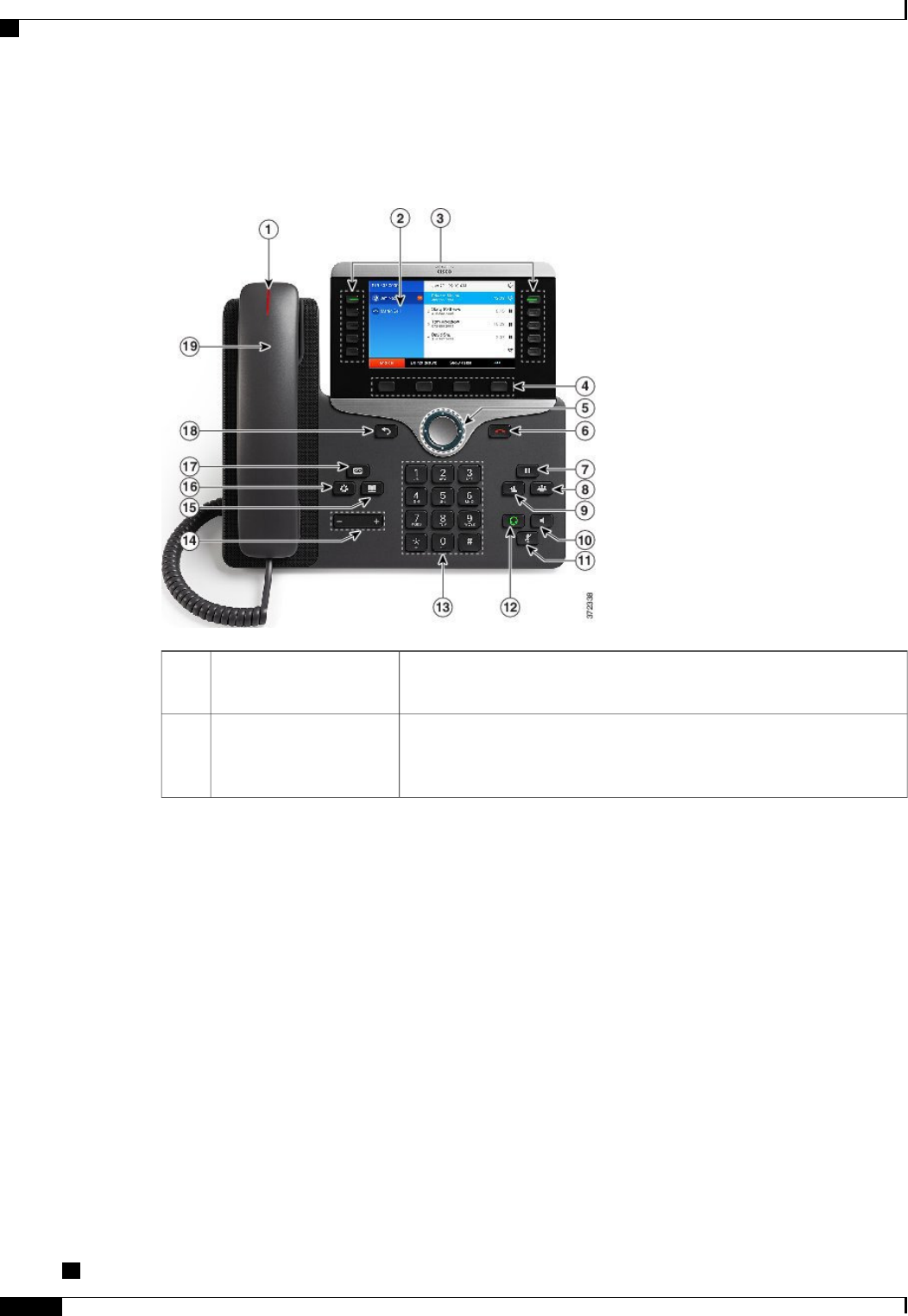
Buttons and Hardware
Indicates an incoming call (flashing red) or new voice message (steady
red).
Handset light strip1
Shows information about your phone such as directory number, active
call and line status, softkey options, speed dials, placed calls, and phone
menu listings.
Phone screen2
Cisco IP Phone 8811, 8841, 8845, 8851, 8851NR, 8861, and 8865 User Guide for Cisco Unified Communications
Manager 11.0
8
Getting Started
Buttons and Hardware
REVIEW DRAFT - CISCO CONFIDENTIAL
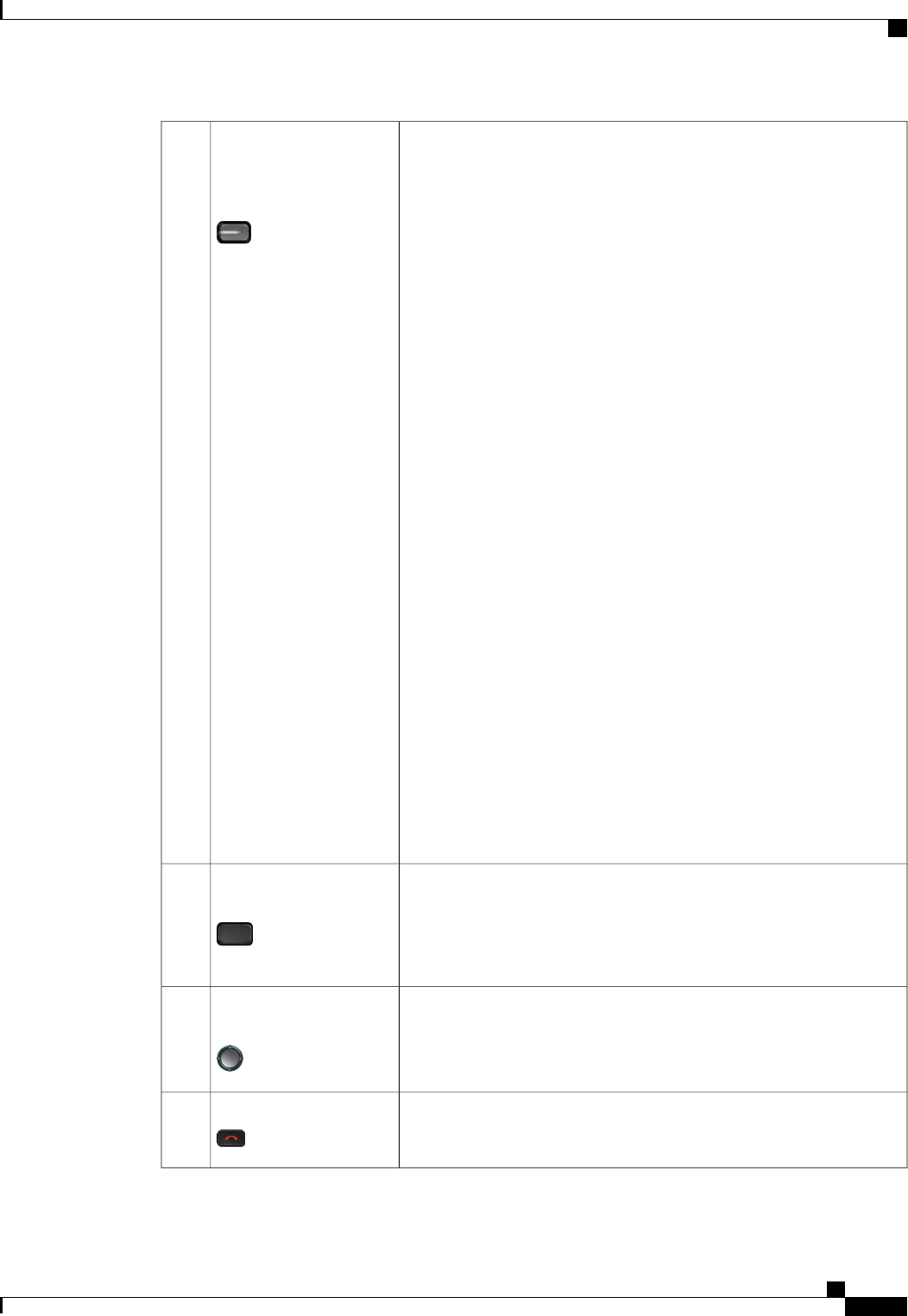
Your phone provides quick access to your phone lines, features, and call
sessions:
•Programmable feature buttons (left side): Use to view calls on a
line or access features such as Speed Dial or All Calls. These buttons
are also called feature buttons.
•Session buttons (right side): Use to perform tasks such as answering
a call, resuming a held call, or (when not being used for an active
call) initiating phone functions such as displaying missed calls. Each
call on your phone is associated with a session button.
If you are using a locale that reads right to left, such as Arabic,
the line button and session button locations are swapped.
Note
Depending on how your system administrator sets up the phone, the
buttons provide access to:
•Phone lines and intercom lines
•Speed-dial numbers (speed-dial buttons, including the Line Status
speed-dial features)
•Web-based services (for example, a Personal Address Book button)
•Call features (for example, a Privacy button)
Buttons illuminate to indicate status:
•Green, steady: Active call or two-way intercom call
•Green, flashing: Held call
•Amber, steady: Privacy in use, one-way intercom call, DND active,
or logged into Hunt Group
•Amber, flashing: Incoming call or reverting call
•Red, steady: Remote line in use (shared line or Line Status)
•Red, flashing: Remote line on hold
Programmable feature
buttons and Session
buttons
3
Depending on how your system administrator sets up the phone, enable
softkey options displayed on your phone screen.
Softkey buttons4
The Navigation cluster and Select button allows you to scroll through
menus, highlight items and select the highlighted item.
Navigation cluster and
Select button
5
Ends a connected call or session.Release Button
6
Cisco IP Phone 8811, 8841, 8845, 8851, 8851NR, 8861, and 8865 User Guide for Cisco Unified Communications Manager
11.0
9
Getting Started
Buttons and Hardware
REVIEW DRAFT - CISCO CONFIDENTIAL
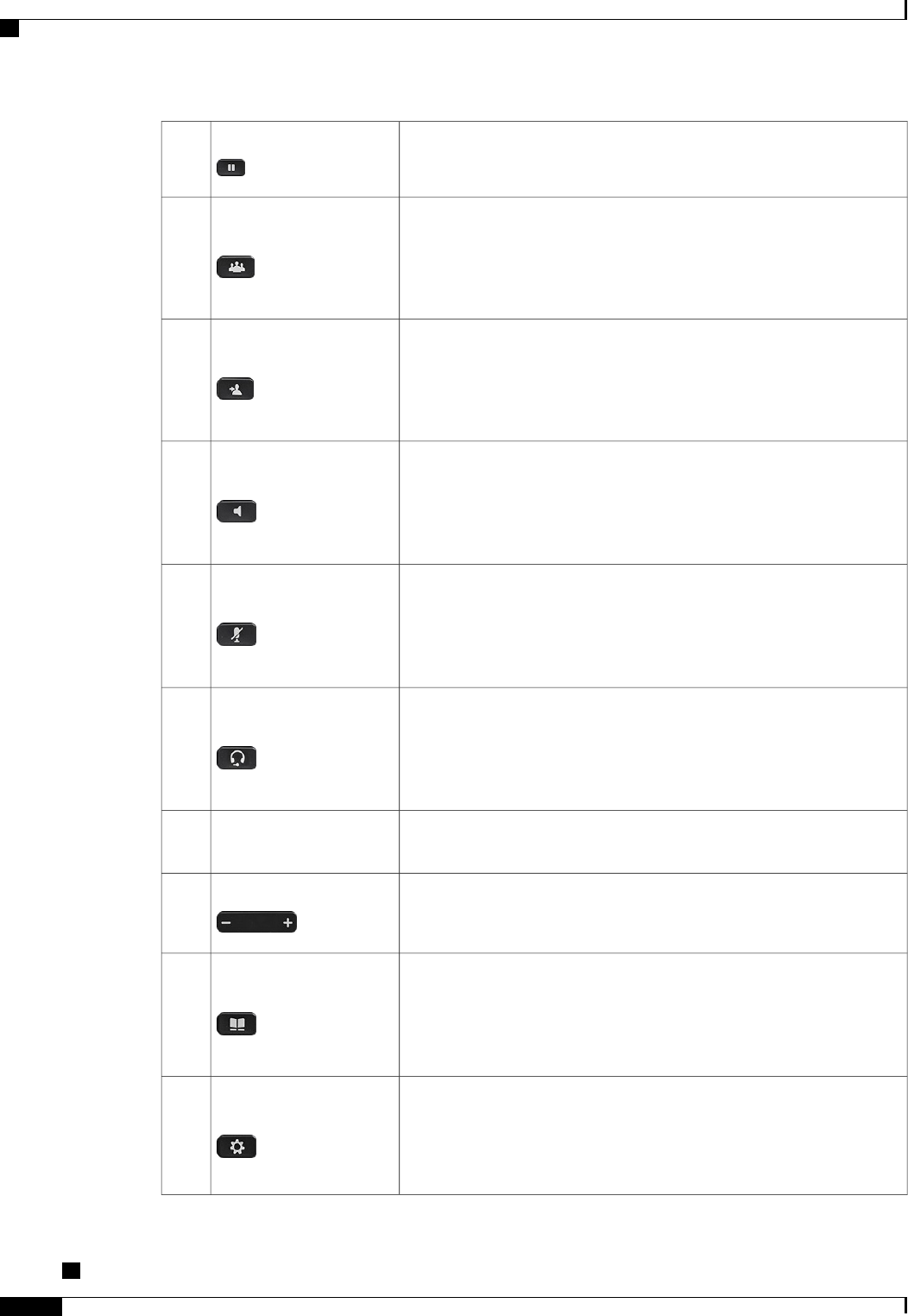
Places an active call on hold and resumes the held call.Hold/Resume button7
Creates a conference call.Conference button8
Transfers a call.Transfer button
9
Toggles the speakerphone on or off. When the speakerphone is on, the
button is lit.
Speakerphone button10
Toggles the microphone on or off. When the microphone is muted, the
button is lit.
Mute button
11
Toggles the headset on or off. When the headset is on, the button is lit.Headset button
12
Allows you to dial phone numbers, enter letters, and select menu items
(by entering the item number).
Keypad13
Controls the handset, headset, and speakerphone volume (off hook) and
the ringer volume (on hook).
Volume button
14
Opens or closes the Directories menu. Use the Contacts button to access
personal and corporate directories.
Contacts button
15
Opens or closes the Applications menu. Use the Applications button to
access call history, user preferences, phone settings, and phone model
information.
Applications button
16
Cisco IP Phone 8811, 8841, 8845, 8851, 8851NR, 8861, and 8865 User Guide for Cisco Unified Communications
Manager 11.0
10
Getting Started
Buttons and Hardware
REVIEW DRAFT - CISCO CONFIDENTIAL
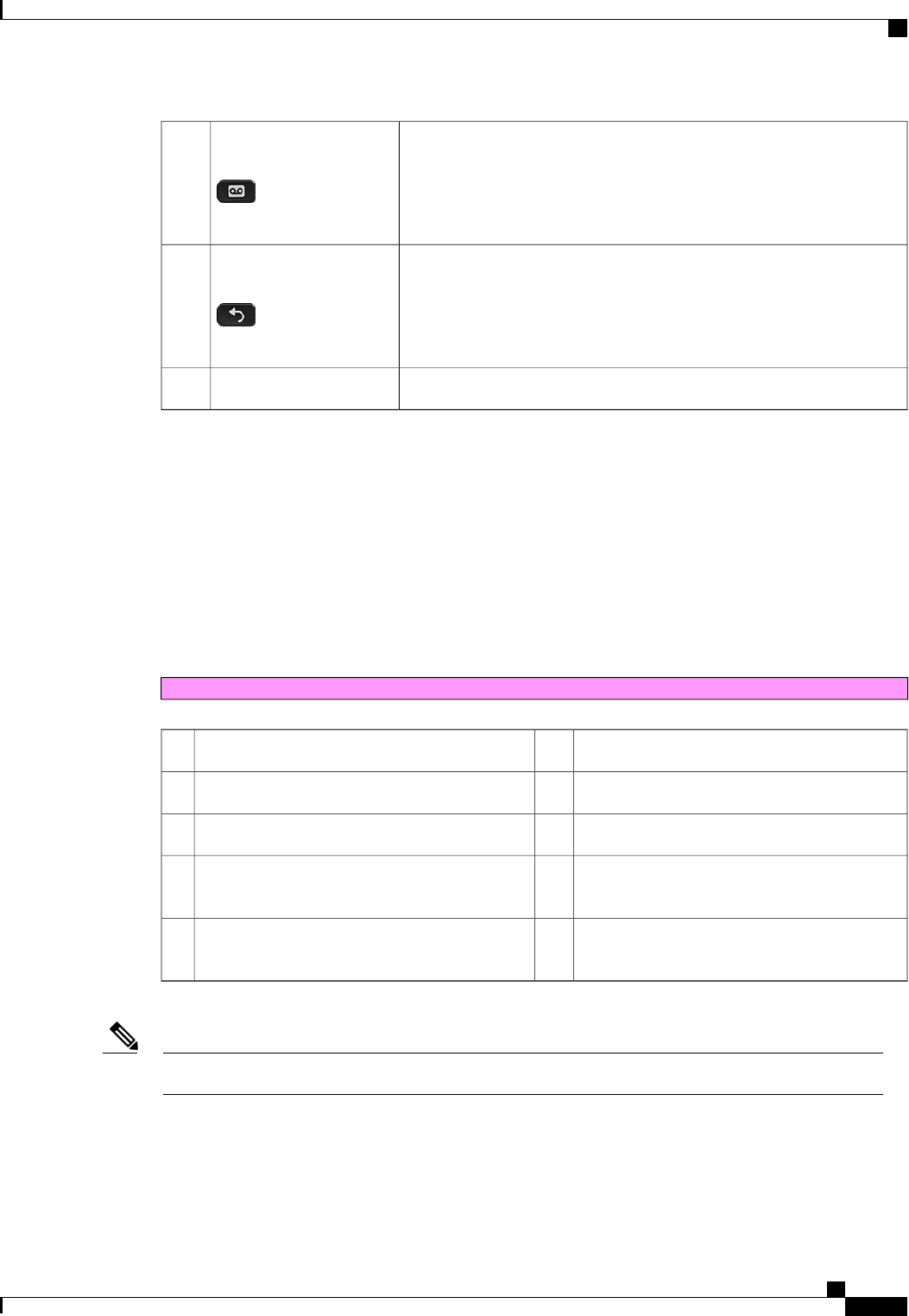
Autodials your voice messaging system (varies by system).Messages button17
Returns to the previous screen or menu.Back button
18
Phone handset.Handset19
Cisco IP Phone 8845
The following sections describe attributes of the Cisco IP Phone 8845.
Phone Connections
Connect your phone to the corporate IP telephony network, using the following diagram.
Draft comment: Design Team: Please provide graphic.
Access port (10/100/1000 PC) connection.5DC adaptor port (DC48V).1
Auxiliary port.6AC-to-DC power supply (optional).2
Handset connection.7AC power wall plug (optional).3
Analog headset connection (optional).8Network port (10/100/1000 SW) connection.
IEEE 802.3at power enabled.
4
Camera pin holes (for Cisco Unified Video
Camera)
9
The Cisco IP Phone 8845 does not support the Cisco IP Phone 8800 Key Expansion Module.Note
Cisco IP Phone 8811, 8841, 8845, 8851, 8851NR, 8861, and 8865 User Guide for Cisco Unified Communications Manager
11.0
11
Getting Started
Cisco IP Phone 8845
REVIEW DRAFT - CISCO CONFIDENTIAL
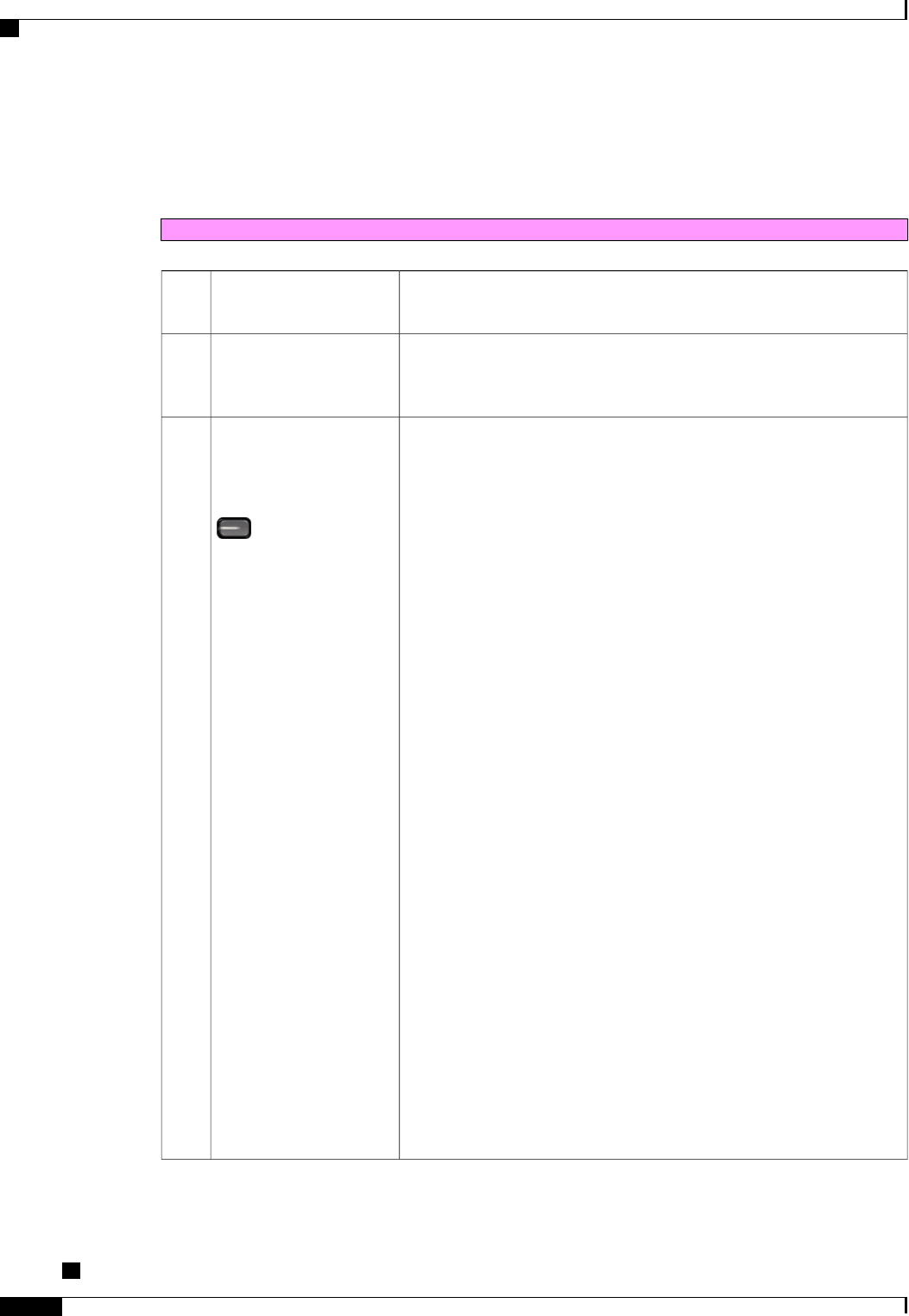
Buttons and Hardware
Draft comment: Design Team: Please provide graphic.
Indicates an incoming call (flashing red) or new voice message (steady
red).
Handset light strip1
Shows information about your phone such as directory number, active
call and line status, softkey options, speed dials, placed calls, and phone
menu listings.
Phone screen2
Your phone provides quick access to your phone lines, features, and call
sessions:
•Programmable feature buttons (left side): Use to view calls on a
line or access features such as Speed Dial or All Calls. These buttons
are also called feature buttons.
•Session buttons (right side): Use to perform tasks such as answering
a call, resuming a held call, or (when not being used for an active
call) initiating phone functions such as displaying missed calls. Each
call on your phone is associated with a session button.
If you are using a locale that reads right to left, such as Arabic,
the line button and session button locations are swapped.
Note
Depending on how your system administrator sets up the phone, the
buttons provide access to:
•Phone lines and intercom lines
•Speed-dial numbers (speed-dial buttons, including the Line Status
speed-dial features)
•Web-based services (for example, a Personal Address Book button)
•Call features (for example, a Privacy button)
Buttons illuminate to indicate status:
•Green, steady: Active call or two-way intercom call
•Green, flashing: Held call
•Amber, steady: Privacy in use, one-way intercom call, DND active,
or logged into Hunt Group
•Amber, flashing: Incoming call or reverting call
•Red, steady: Remote line in use (shared line or Line Status)
•Red, flashing: Remote line on hold
Programmable feature
buttons and Session
buttons
3
Cisco IP Phone 8811, 8841, 8845, 8851, 8851NR, 8861, and 8865 User Guide for Cisco Unified Communications
Manager 11.0
12
Getting Started
Buttons and Hardware
REVIEW DRAFT - CISCO CONFIDENTIAL
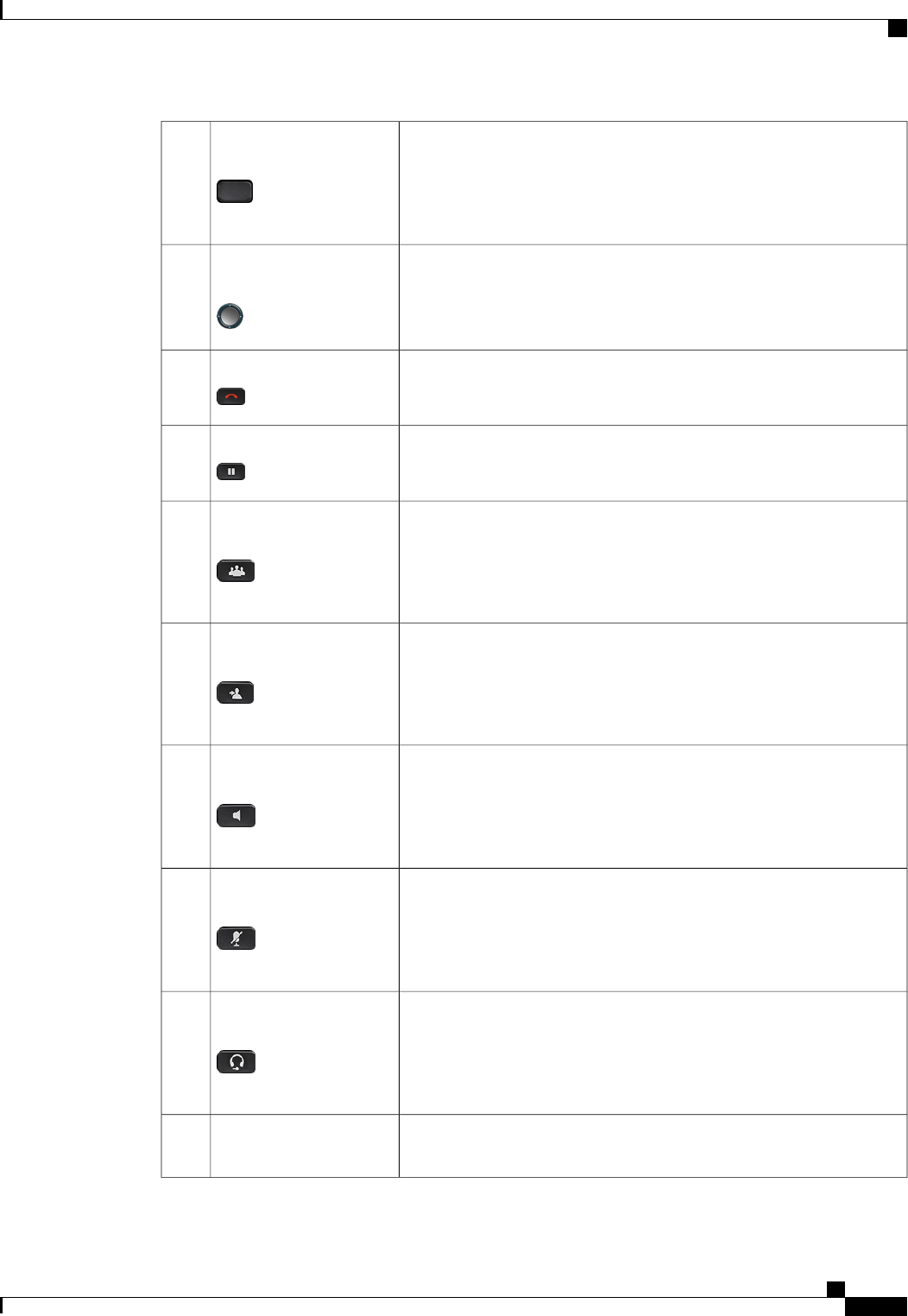
Depending on how your system administrator sets up the phone, enable
softkey options displayed on your phone screen.
Softkey buttons4
The Navigation cluster and Select button allows you to scroll through
menus, highlight items and select the highlighted item.
Navigation cluster and
Select button
5
Ends a connected call or session.Release Button
6
Places an active call on hold and resumes the held call.Hold/Resume button7
Creates a conference call.Conference button
8
Transfers a call.Transfer button
9
Toggles the speakerphone on or off. When the speakerphone is on, the
button is lit.
Speakerphone button10
Toggles the microphone on or off. When the microphone is muted, the
button is lit.
Mute button
11
Toggles the headset on or off. When the headset is on, the button is lit.Headset button
12
Allows you to dial phone numbers, enter letters, and select menu items
(by entering the item number).
Keypad13
Cisco IP Phone 8811, 8841, 8845, 8851, 8851NR, 8861, and 8865 User Guide for Cisco Unified Communications Manager
11.0
13
Getting Started
Buttons and Hardware
REVIEW DRAFT - CISCO CONFIDENTIAL
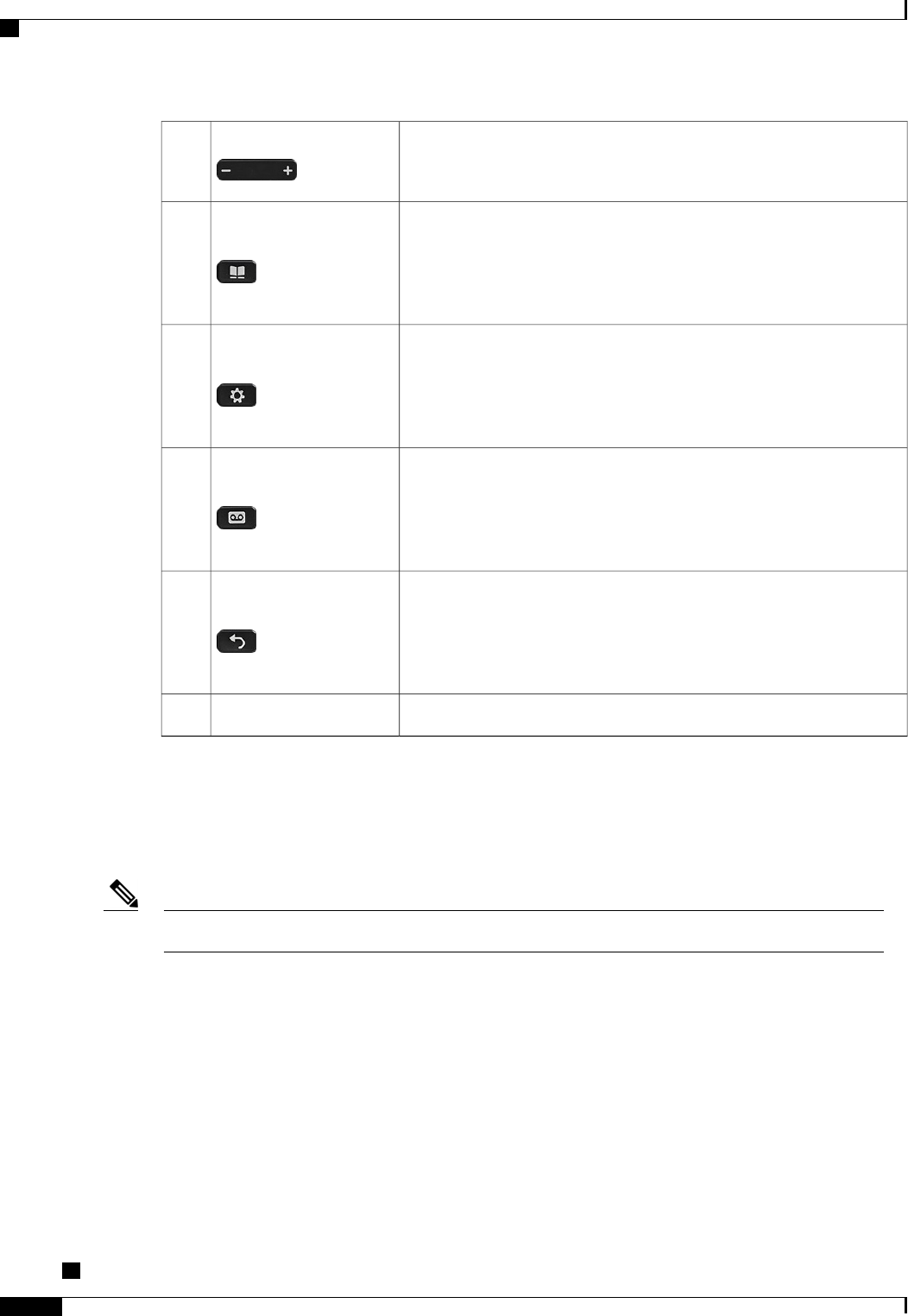
Controls the handset, headset, and speakerphone volume (off hook) and
the ringer volume (on hook).
Volume button14
Opens or closes the Directories menu. Use the Contacts button to access
personal and corporate directories.
Contacts button
15
Opens or closes the Applications menu. Use the Applications button to
access call history, user preferences, phone settings, and phone model
information.
Applications button
16
Autodials your voice messaging system (varies by system).Messages button
17
Returns to the previous screen or menu.Back button
18
Phone handset.Handset19
Cisco IP Phone 8851 and 8851NR
The following sections describe attributes of the Cisco IP Phone 8851 and 8851NR.
Cisco IP Phone 8851NR is only supported by firmware release 10.3(1) and later.Note
Phone Connections
Connect your phone to the corporate IP telephony network, using the following diagram.
Cisco IP Phone 8811, 8841, 8845, 8851, 8851NR, 8861, and 8865 User Guide for Cisco Unified Communications
Manager 11.0
14
Getting Started
Cisco IP Phone 8851 and 8851NR
REVIEW DRAFT - CISCO CONFIDENTIAL
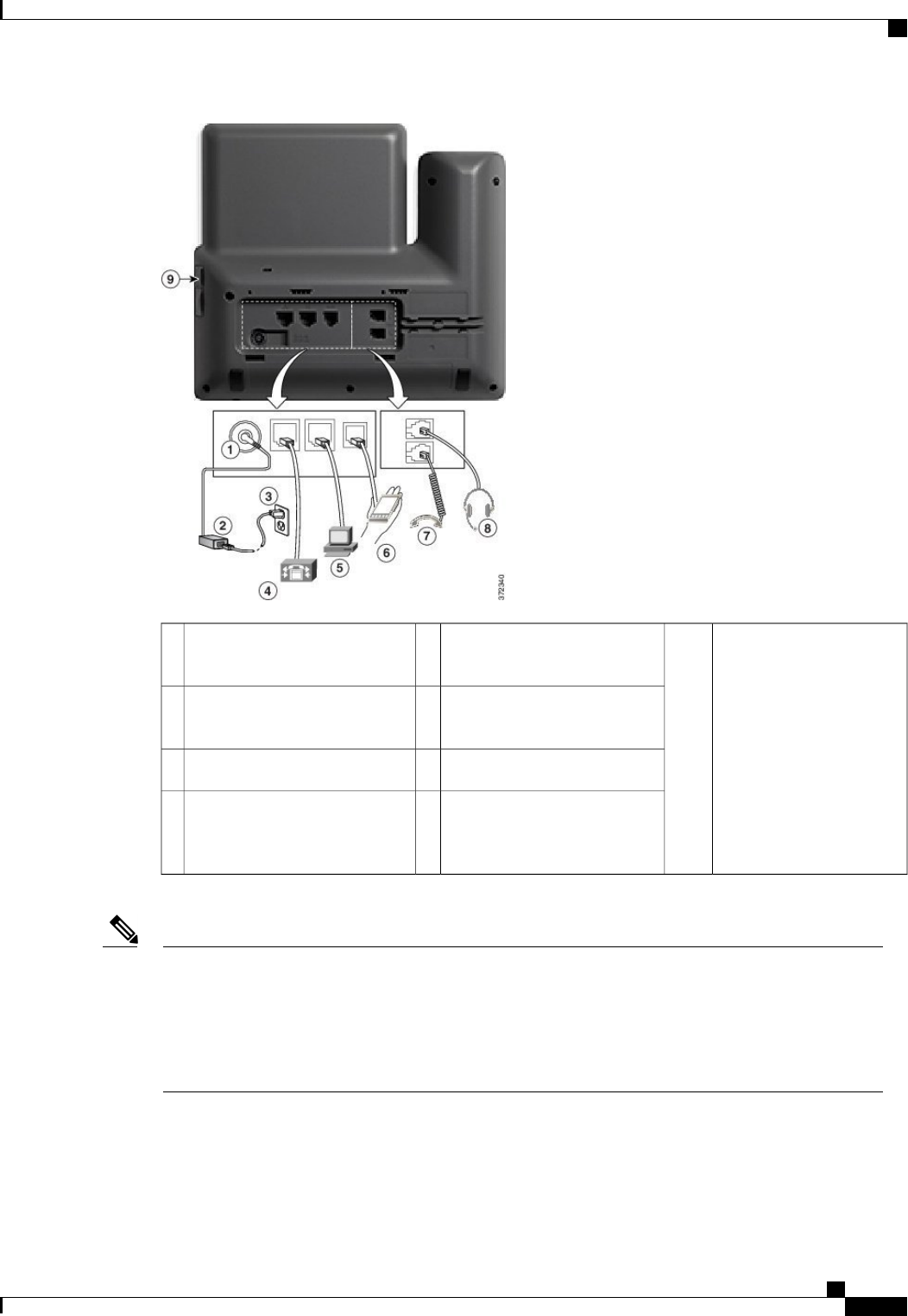
USB port9Access port (10/100/1000 PC)
connection.
5DC adaptor port (DC48V).1
Auxiliary port.6AC-to-DC power supply
(optional).
2
Handset connection.7AC power wall plug (optional).3
Analog headset connection
(optional).
8Network port (10/100/1000 SW)
connection. IEEE 802.3at power
enabled.
4
Each USB port supports the connection of up to five supported and nonsupported devices. Each device
connected to the phone is included in the maximum device count. For example, your phone can support
five USB devices (such as two Cisco IP Phone 8800 Key Expansion Modules, one headset, one hub, and
one other standard USB device) on the side port. Many third-party USB products count as multiple USB
devices, for example, a device containing USB hub and headset can count as two USB devices. For more
information, see the USB device documentation.
Note
Cisco IP Phone 8811, 8841, 8845, 8851, 8851NR, 8861, and 8865 User Guide for Cisco Unified Communications Manager
11.0
15
Getting Started
Phone Connections
REVIEW DRAFT - CISCO CONFIDENTIAL
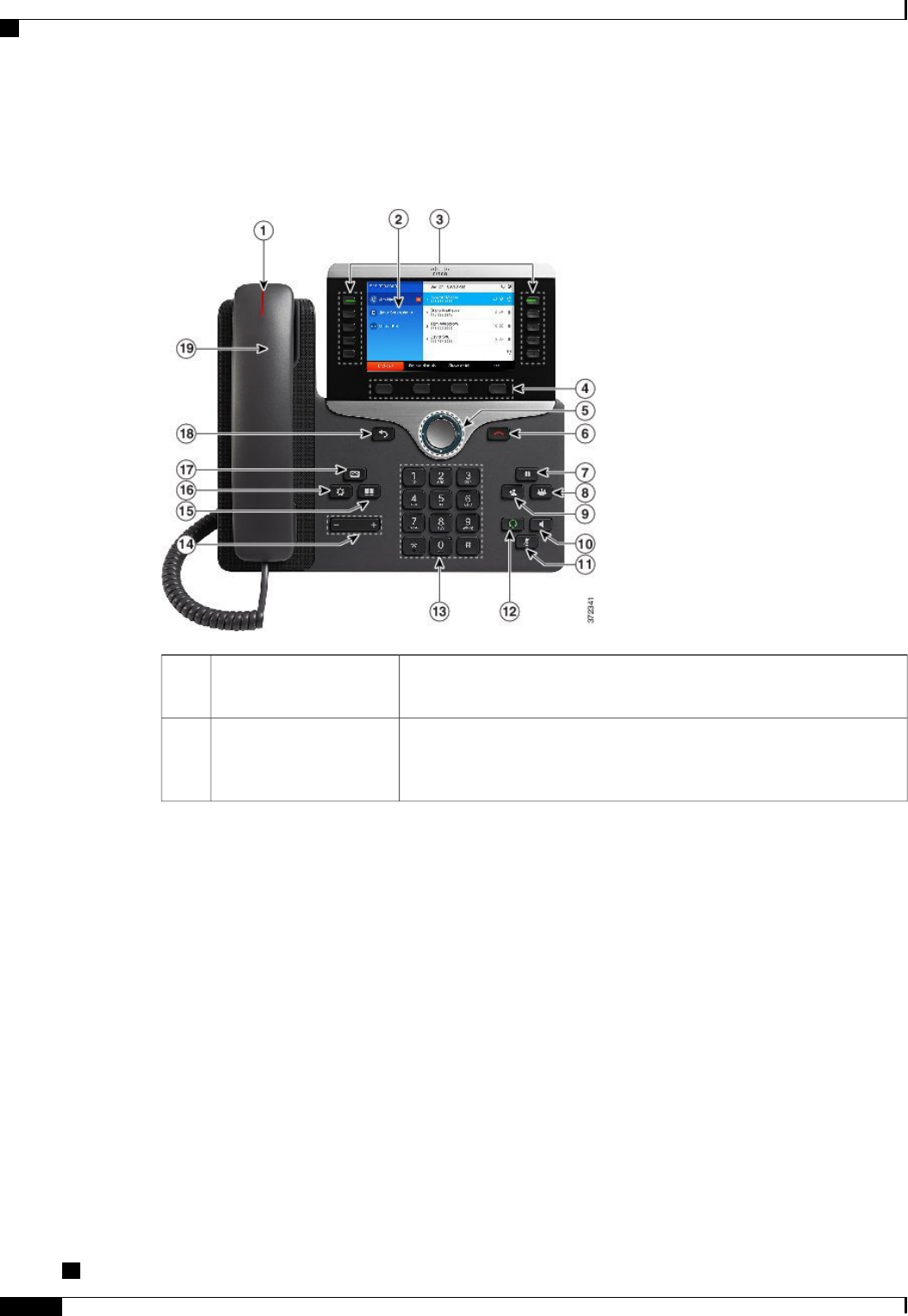
Buttons and Hardware
Indicates an incoming call (flashing red) or new voice message (steady
red).
Handset light strip1
Shows information about your phone such as directory number, active
call and line status, softkey options, speed dials, placed calls, and phone
menu listings.
Phone screen2
Cisco IP Phone 8811, 8841, 8845, 8851, 8851NR, 8861, and 8865 User Guide for Cisco Unified Communications
Manager 11.0
16
Getting Started
Buttons and Hardware
REVIEW DRAFT - CISCO CONFIDENTIAL
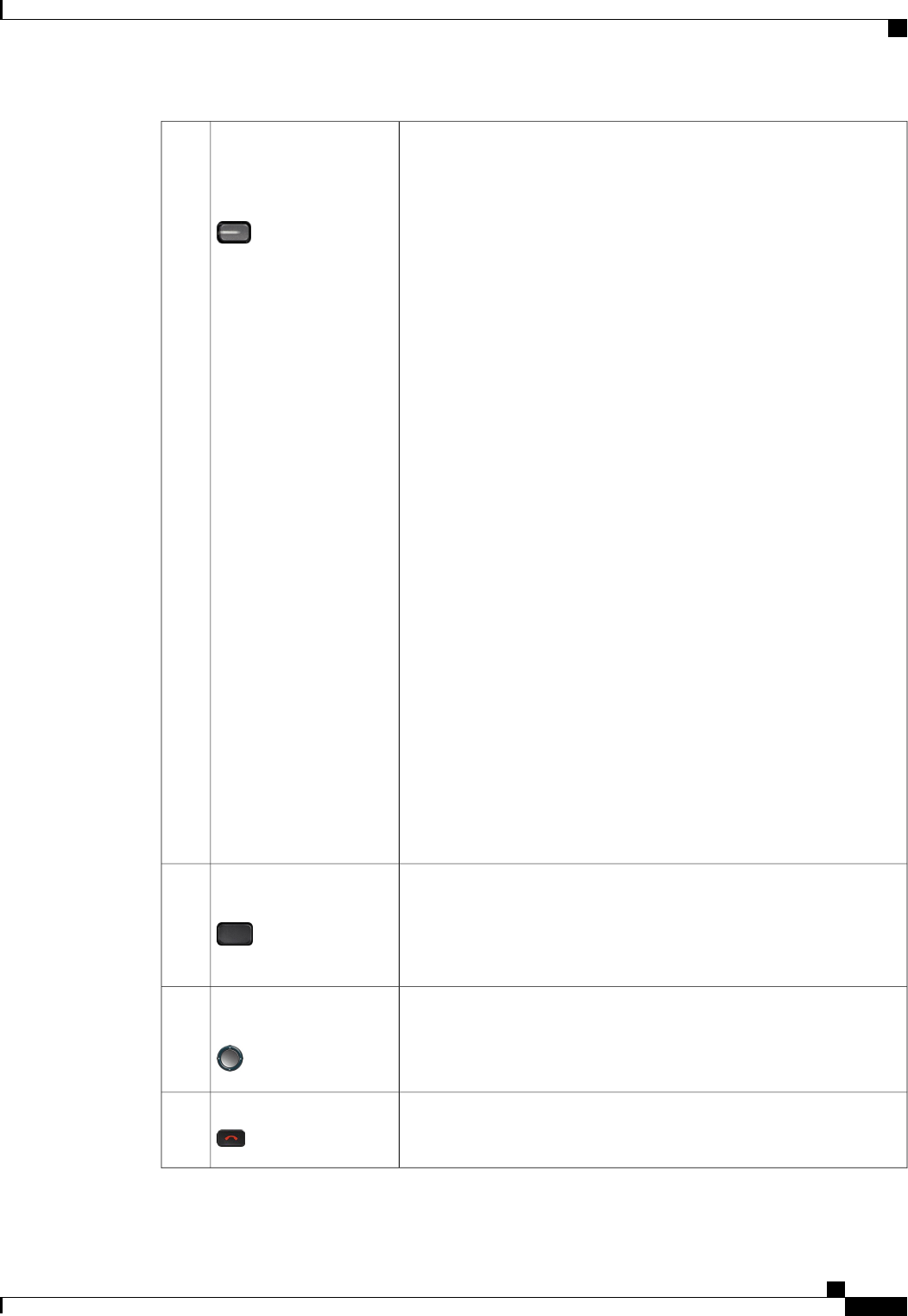
Your phone provides quick access to your phone lines, features, and call
sessions:
•Programmable feature buttons (left side): Use to view calls on a
line or access features such as Speed Dial or All Calls. These buttons
are also called feature buttons.
•Session buttons (right side): Use to perform tasks such as answering
a call, resuming a held call, or (when not being used for an active
call) initiating phone functions such as displaying missed calls. Each
call on your phone is associated with a session button.
If you are using a locale that reads right to left, such as Arabic,
the line button and session button locations are swapped.
Note
Depending on how your system administrator sets up the phone, the
buttons provide access to:
•Phone lines and intercom lines
•Speed-dial numbers (speed-dial buttons, including the Line Status
speed-dial features)
•Web-based services (for example, a Personal Address Book button)
•Call features (for example, a Privacy button)
Buttons illuminate to indicate status:
•Green, steady: Active call or two-way intercom call
•Green, flashing: Held call
•Amber, steady: Privacy in use, one-way intercom call, DND active,
or logged into Hunt Group
•Amber, flashing: Incoming call or reverting call
•Red, steady: Remote line in use (shared line or Line Status)
•Red, flashing: Remote line on hold
Programmable feature
buttons and Session
buttons
3
Depending on how your system administrator sets up the phone, enable
softkey options displayed on your phone screen.
Softkey buttons4
The Navigation cluster and Select button allows you to scroll through
menus, highlight items and select the highlighted item.
Navigation cluster and
Select button
5
Ends a connected call or session.Release Button
6
Cisco IP Phone 8811, 8841, 8845, 8851, 8851NR, 8861, and 8865 User Guide for Cisco Unified Communications Manager
11.0
17
Getting Started
Buttons and Hardware
REVIEW DRAFT - CISCO CONFIDENTIAL
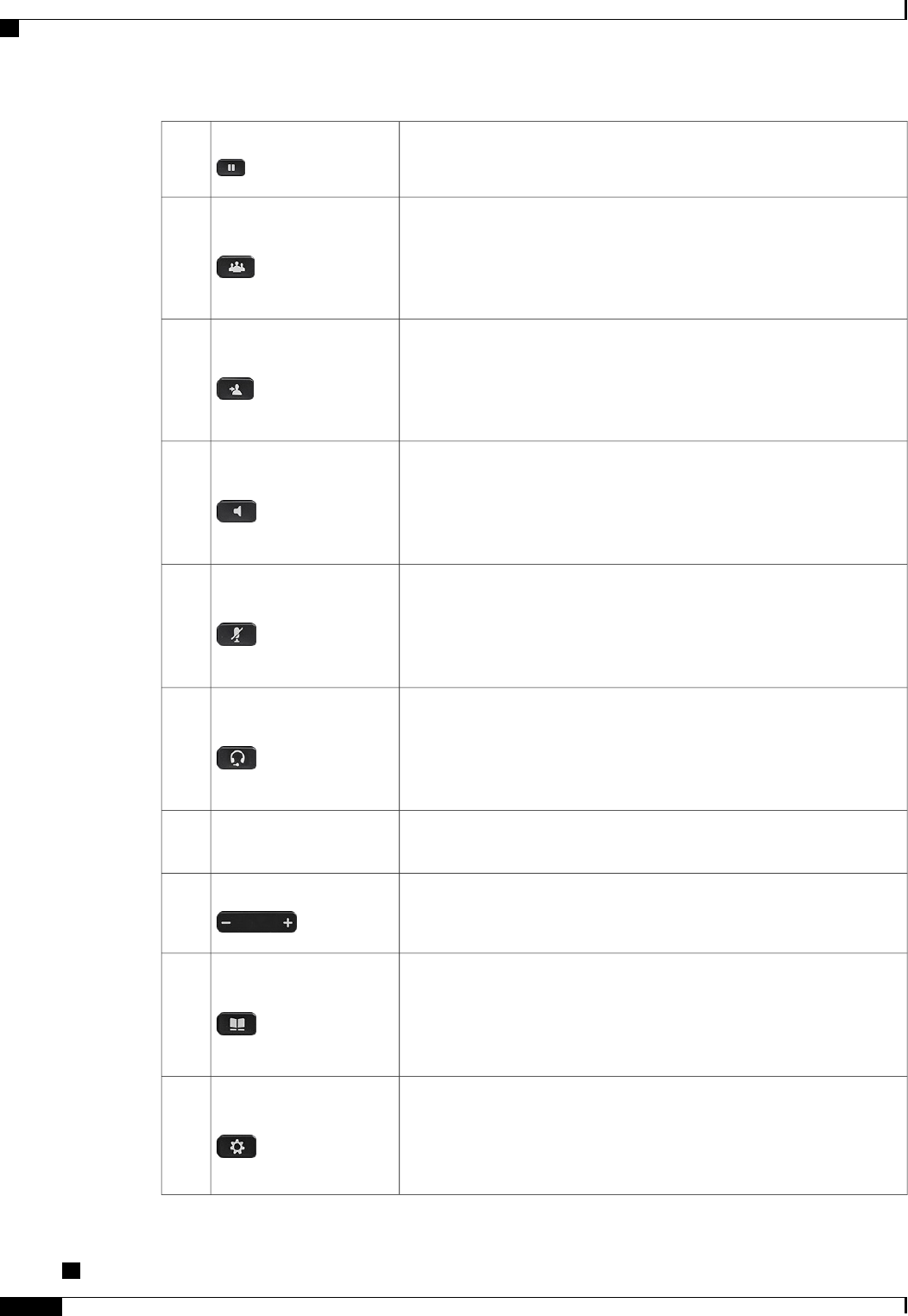
Places an active call on hold and resumes the held call.Hold/Resume button7
Creates a conference call.Conference button8
Transfers a call.Transfer button
9
Toggles the speakerphone on or off. When the speakerphone is on, the
button is lit.
Speakerphone button10
Toggles the microphone on or off. When the microphone is muted, the
button is lit.
Mute button
11
Toggles the headset on or off. When the headset is on, the button is lit.Headset button
12
Allows you to dial phone numbers, enter letters, and select menu items
(by entering the item number).
Keypad13
Controls the handset, headset, and speakerphone volume (off hook) and
the ringer volume (on hook).
Volume button
14
Opens or closes the Directories menu. Use the Contacts button to access
personal and corporate directories.
Contacts button
15
Opens or closes the Applications menu. Use the Applications button to
access call history, user preferences, phone settings, and phone model
information.
Applications button
16
Cisco IP Phone 8811, 8841, 8845, 8851, 8851NR, 8861, and 8865 User Guide for Cisco Unified Communications
Manager 11.0
18
Getting Started
Buttons and Hardware
REVIEW DRAFT - CISCO CONFIDENTIAL
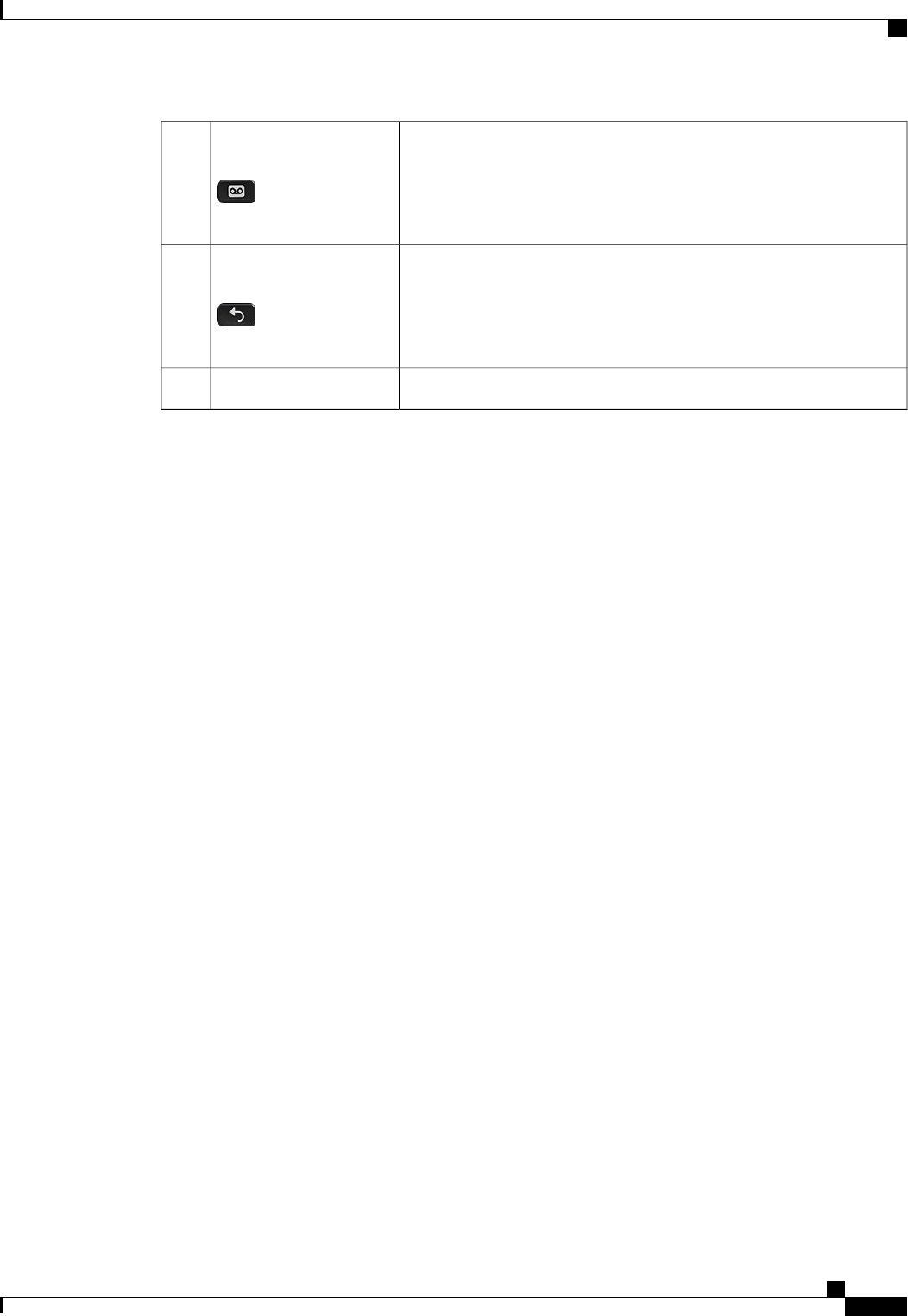
Autodials your voice messaging system (varies by system).Messages button17
Returns to the previous screen or menu.Back button
18
Phone handset.Handset19
Cisco IP Phone 8861
The following sections describe attributes of the Cisco IP Phone 8861.
Phone Connections
Connect your phone to the corporate IP telephony network, using the following diagram.
Cisco IP Phone 8811, 8841, 8845, 8851, 8851NR, 8861, and 8865 User Guide for Cisco Unified Communications Manager
11.0
19
Getting Started
Cisco IP Phone 8861
REVIEW DRAFT - CISCO CONFIDENTIAL
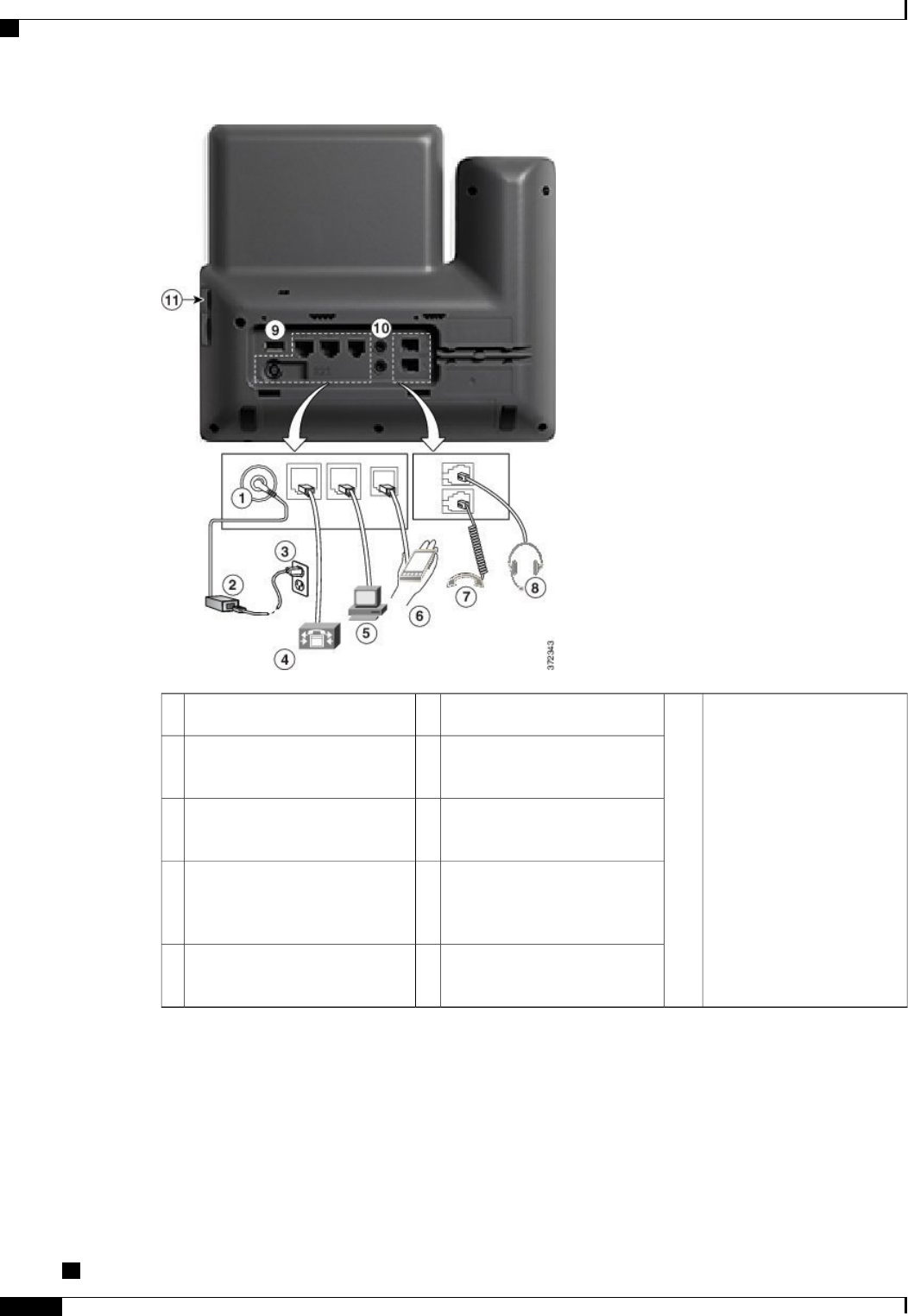
USB port11Auxiliary port.6DC adaptor port (DC48V).1
Handset connection.7AC-to-DC power supply
(optional).
2
Analog headset connection
(optional).
8AC power wall plug (optional).3
USB port9Network port (10/100/1000 SW)
connection. IEEE 802.3at power
enabled.
4
Audio In/Out ports10Access port (10/100/1000 PC)
connection.
5
Cisco IP Phone 8811, 8841, 8845, 8851, 8851NR, 8861, and 8865 User Guide for Cisco Unified Communications
Manager 11.0
20
Getting Started
Phone Connections
REVIEW DRAFT - CISCO CONFIDENTIAL
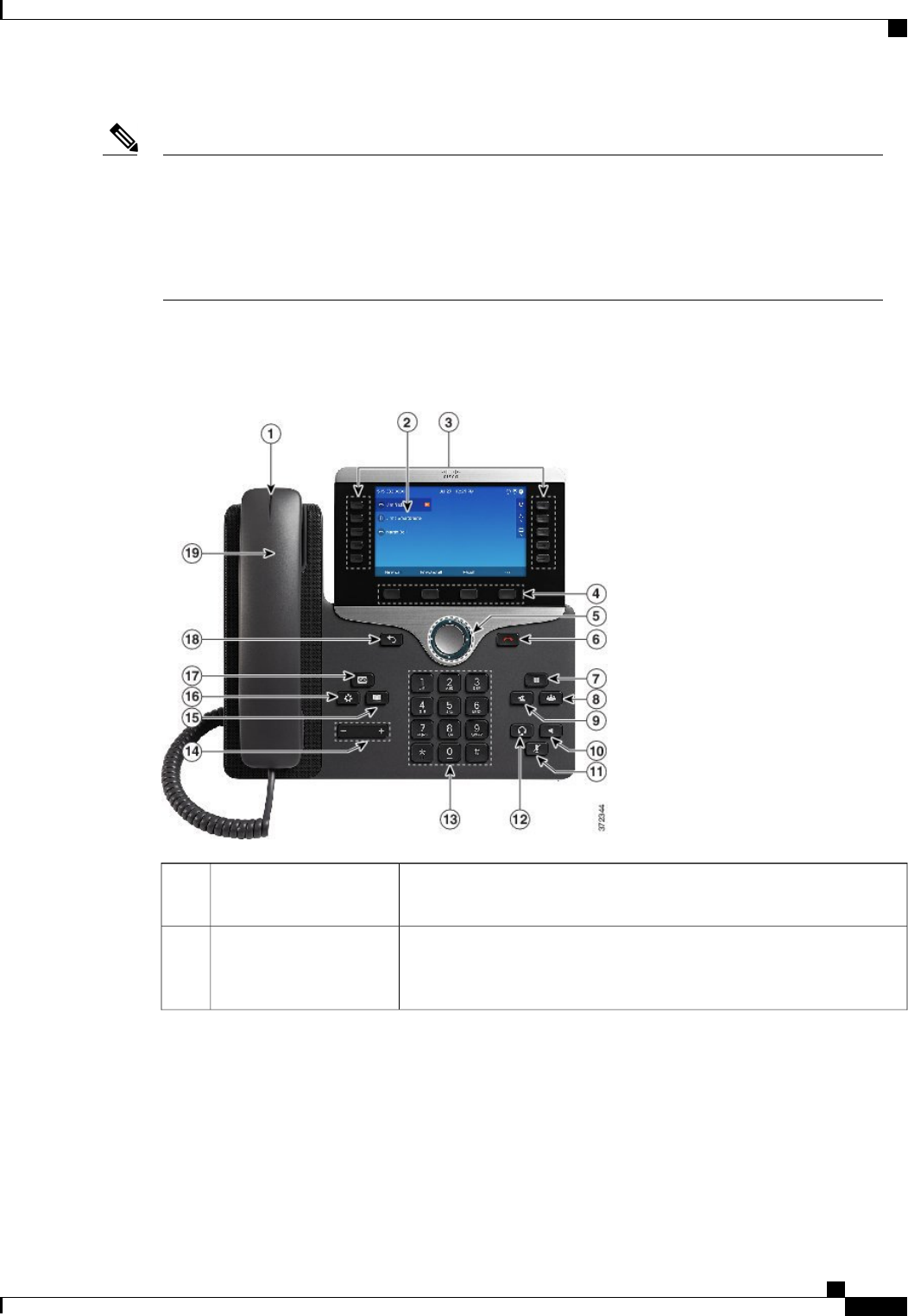
Each USB port supports the connection of up to five supported and nonsupported devices. Each device
connected to the phone is included in the maximum device count. For example, your phone can support
five USB devices (such as three Cisco IP Phone 8800 Key Expansion Modules, one hub, and one other
standard USB device) on the side port and five additional standard USB devices on the back port. Many
third-party USB products count as multiple USB devices, for example, a device containing USB hub and
headset can count as two USB devices. For more information, see the USB device documentation.
Note
Buttons and Hardware
Indicates an incoming call (flashing red) or new voice message (steady
red).
Handset light strip1
Shows information about your phone such as directory number, active
call and line status, softkey options, speed dials, placed calls, and phone
menu listings.
Phone screen2
Cisco IP Phone 8811, 8841, 8845, 8851, 8851NR, 8861, and 8865 User Guide for Cisco Unified Communications Manager
11.0
21
Getting Started
Buttons and Hardware
REVIEW DRAFT - CISCO CONFIDENTIAL
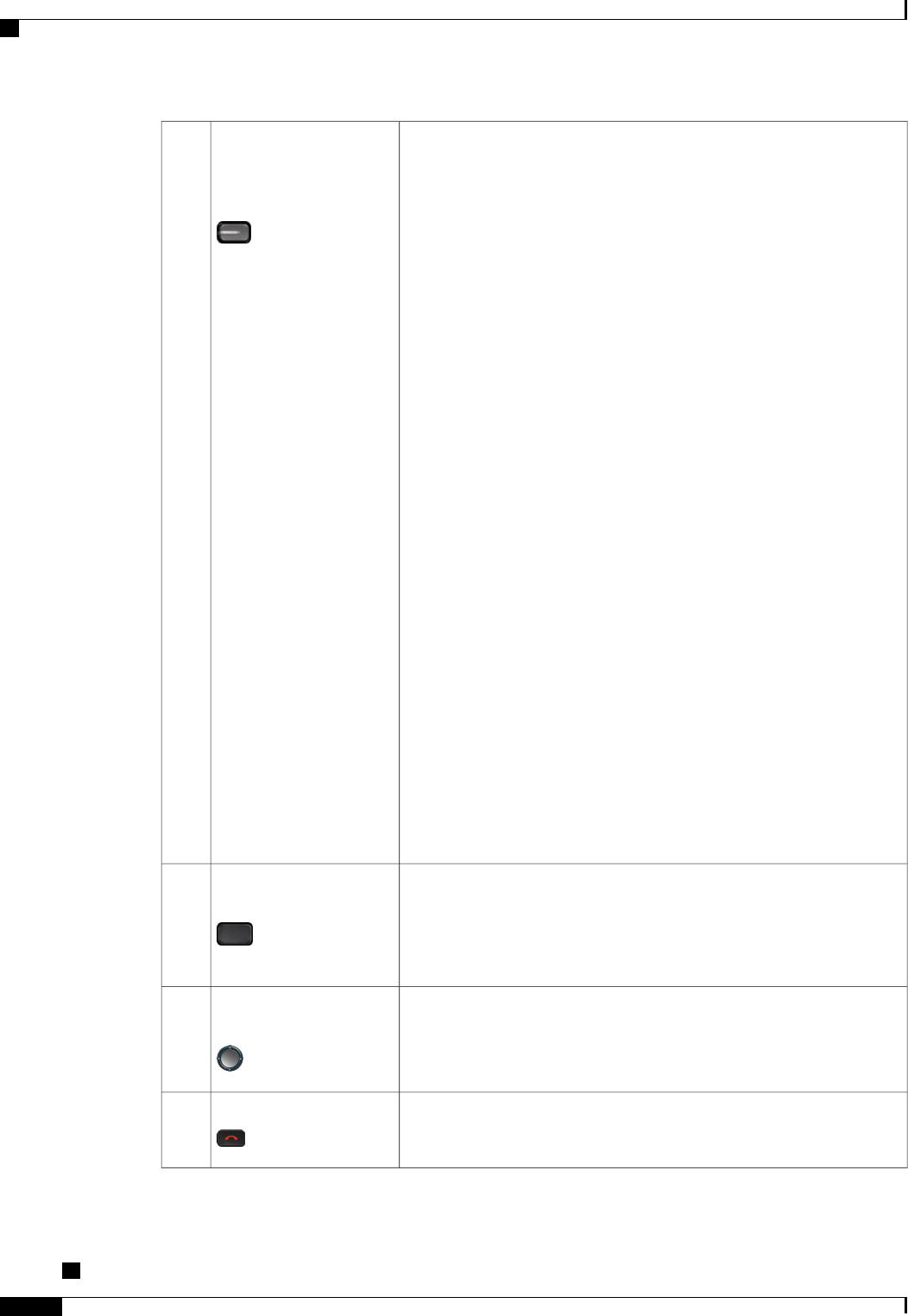
Your phone provides quick access to your phone lines, features, and call
sessions:
•Programmable feature buttons (left side): Use to view calls on a
line or access features such as Speed Dial or All Calls. These buttons
are also called feature buttons.
•Session buttons (right side): Use to perform tasks such as answering
a call, resuming a held call, or (when not being used for an active
call) initiating phone functions such as displaying missed calls. Each
call on your phone is associated with a session button.
If you are using a locale that reads right to left, such as Arabic,
the line button and session button locations are swapped.
Note
Depending on how your system administrator sets up the phone, the
buttons provide access to:
•Phone lines and intercom lines
•Speed-dial numbers (speed-dial buttons, including the Line Status
speed-dial features)
•Web-based services (for example, a Personal Address Book button)
•Call features (for example, a Privacy button)
Buttons illuminate to indicate status:
•Green, steady: Active call or two-way intercom call
•Green, flashing: Held call
•Amber, steady: Privacy in use, one-way intercom call, DND active,
or logged into Hunt Group
•Amber, flashing: Incoming call or reverting call
•Red, steady: Remote line in use (shared line or Line Status)
•Red, flashing: Remote line on hold
Programmable feature
buttons and Session
buttons
3
Depending on how your system administrator sets up the phone, enable
softkey options displayed on your phone screen.
Softkey buttons4
The Navigation cluster and Select button allows you to scroll through
menus, highlight items and select the highlighted item.
Navigation cluster and
Select button
5
Ends a connected call or session.Release Button
6
Cisco IP Phone 8811, 8841, 8845, 8851, 8851NR, 8861, and 8865 User Guide for Cisco Unified Communications
Manager 11.0
22
Getting Started
Buttons and Hardware
REVIEW DRAFT - CISCO CONFIDENTIAL
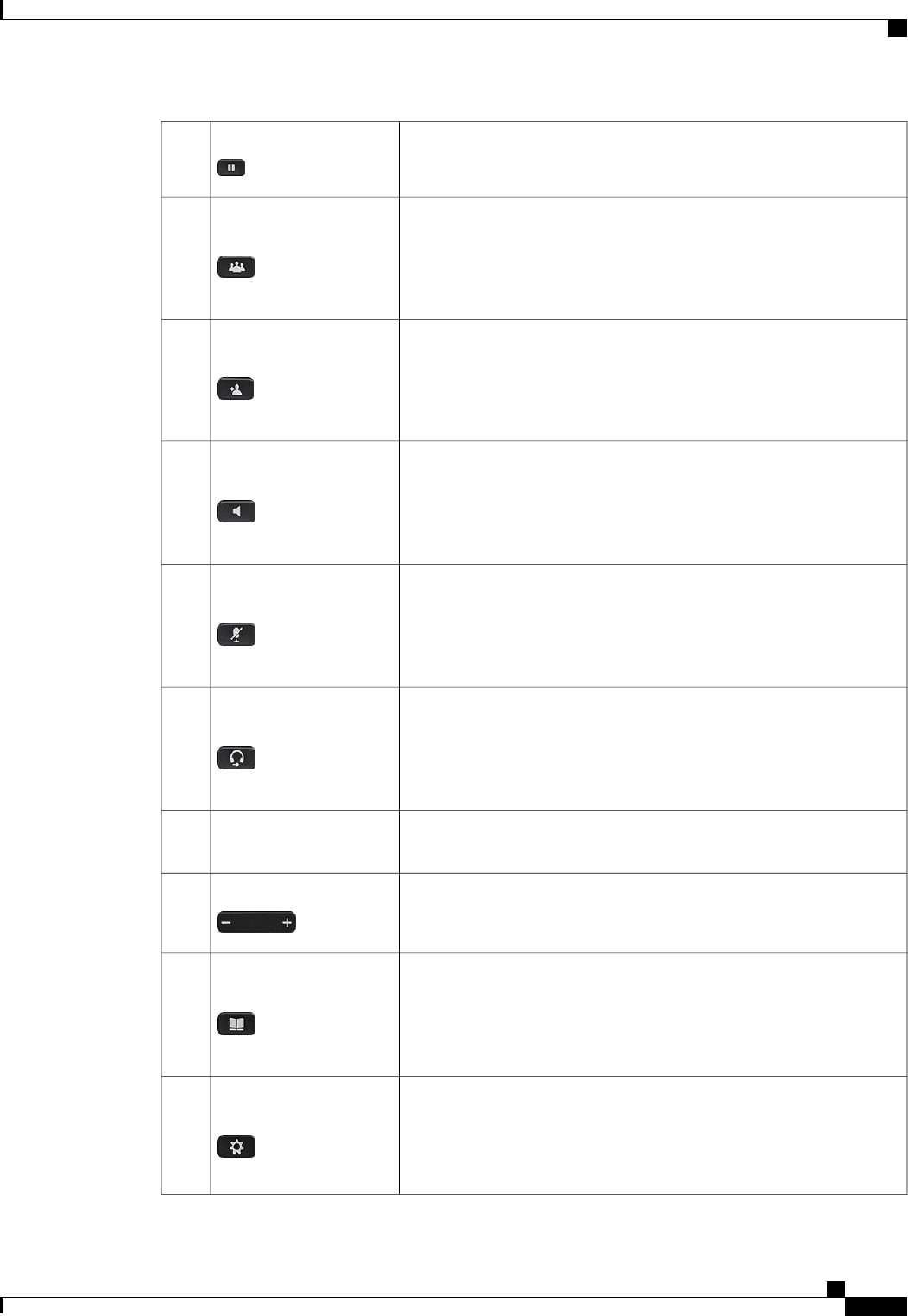
Places an active call on hold and resumes the held call.Hold/Resume button7
Creates a conference call.Conference button8
Transfers a call.Transfer button
9
Toggles the speakerphone on or off. When the speakerphone is on, the
button is lit.
Speakerphone button10
Toggles the microphone on or off. When the microphone is muted, the
button is lit.
Mute button
11
Toggles the headset on or off. When the headset is on, the button is lit.Headset button
12
Allows you to dial phone numbers, enter letters, and select menu items
(by entering the item number).
Keypad13
Controls the handset, headset, and speakerphone volume (off hook) and
the ringer volume (on hook).
Volume button
14
Opens or closes the Directories menu. Use the Contacts button to access
personal and corporate directories.
Contacts button
15
Opens or closes the Applications menu. Use the Applications button to
access call history, user preferences, phone settings, and phone model
information.
Applications button
16
Cisco IP Phone 8811, 8841, 8845, 8851, 8851NR, 8861, and 8865 User Guide for Cisco Unified Communications Manager
11.0
23
Getting Started
Buttons and Hardware
REVIEW DRAFT - CISCO CONFIDENTIAL
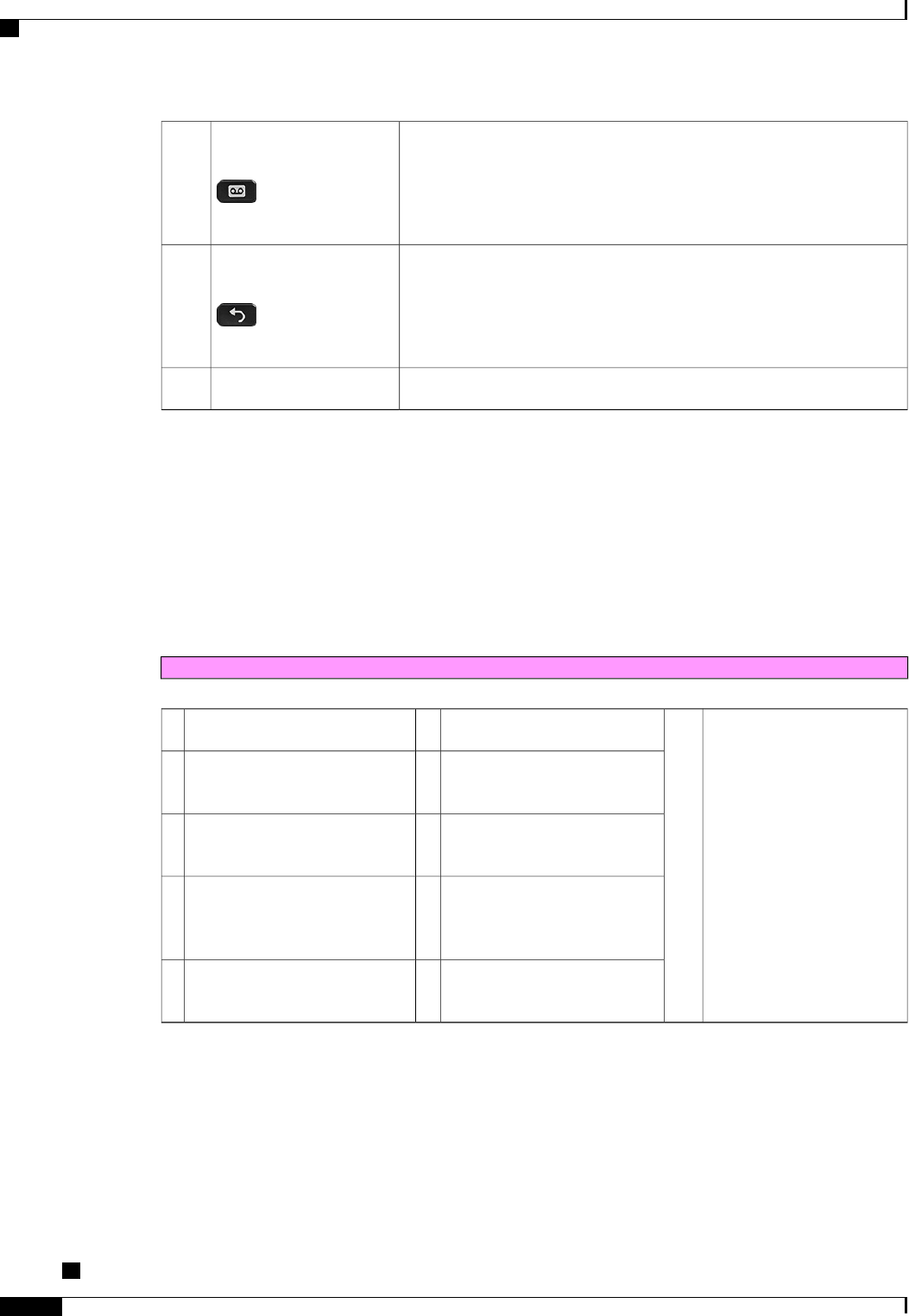
Autodials your voice messaging system (varies by system).Messages button17
Returns to the previous screen or menu.Back button
18
Phone handset.Handset19
Cisco IP Phone 8865
The following sections describe attributes of the Cisco IP Phone 8865.
Phone Connections
Draft comment: Design Team: Please provide graphic.
USB port11Auxiliary port.6DC adaptor port (DC48V).1
Handset connection.7AC-to-DC power supply
(optional).
2
Analog headset connection
(optional).
8AC power wall plug (optional).3
USB port9Network port (10/100/1000 SW)
connection. IEEE 802.3at power
enabled.
4
Audio In/Out ports10Access port (10/100/1000 PC)
connection.
5
Each USB port supports the connection of up to five supported and nonsupported devices. Each device
connected to the phone is included in the maximum device count. For example, your phone can support five
USB devices (such as three Cisco IP Phone 8800 Key Expansion Modules, one hub, and one other standard
USB device) on the side port and five additional standard USB devices on the back port. Many third-party
USB products count as multiple USB devices, for example, a device containing USB hub and headset can
count as two USB devices. For more information, see the USB device documentation.
Cisco IP Phone 8811, 8841, 8845, 8851, 8851NR, 8861, and 8865 User Guide for Cisco Unified Communications
Manager 11.0
24
Getting Started
Cisco IP Phone 8865
REVIEW DRAFT - CISCO CONFIDENTIAL
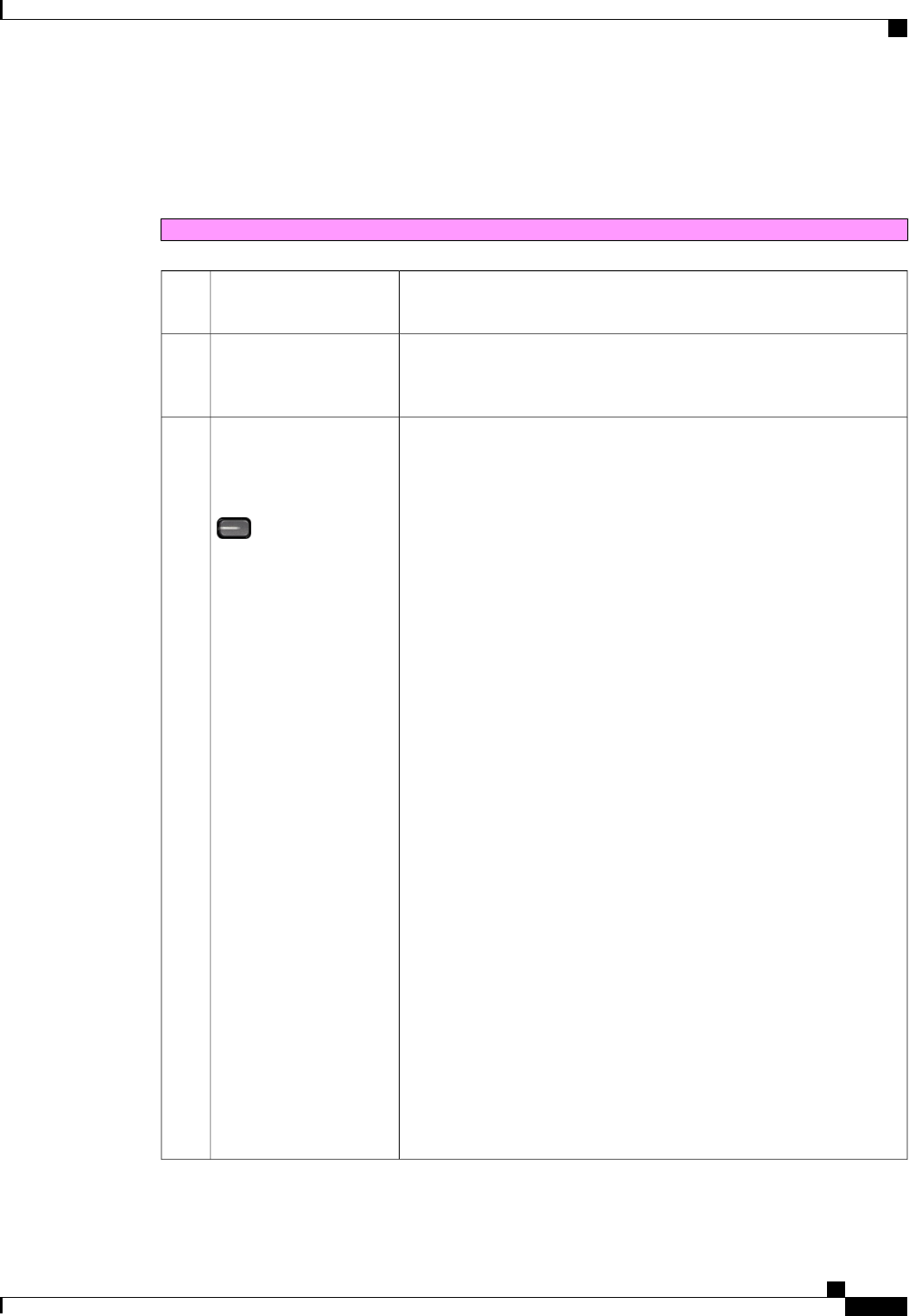
Buttons and Hardware
Draft comment: Design Team: Please provide graphic.
Indicates an incoming call (flashing red) or new voice message (steady
red).
Handset light strip1
Shows information about your phone such as directory number, active
call and line status, softkey options, speed dials, placed calls, and phone
menu listings.
Phone screen2
Your phone provides quick access to your phone lines, features, and call
sessions:
•Programmable feature buttons (left side): Use to view calls on a
line or access features such as Speed Dial or All Calls. These buttons
are also called feature buttons.
•Session buttons (right side): Use to perform tasks such as answering
a call, resuming a held call, or (when not being used for an active
call) initiating phone functions such as displaying missed calls. Each
call on your phone is associated with a session button.
If you are using a locale that reads right to left, such as Arabic,
the line button and session button locations are swapped.
Note
Depending on how your system administrator sets up the phone, the
buttons provide access to:
•Phone lines and intercom lines
•Speed-dial numbers (speed-dial buttons, including the Line Status
speed-dial features)
•Web-based services (for example, a Personal Address Book button)
•Call features (for example, a Privacy button)
Buttons illuminate to indicate status:
•Green, steady: Active call or two-way intercom call
•Green, flashing: Held call
•Amber, steady: Privacy in use, one-way intercom call, DND active,
or logged into Hunt Group
•Amber, flashing: Incoming call or reverting call
•Red, steady: Remote line in use (shared line or Line Status)
•Red, flashing: Remote line on hold
Programmable feature
buttons and Session
buttons
3
Cisco IP Phone 8811, 8841, 8845, 8851, 8851NR, 8861, and 8865 User Guide for Cisco Unified Communications Manager
11.0
25
Getting Started
Buttons and Hardware
REVIEW DRAFT - CISCO CONFIDENTIAL
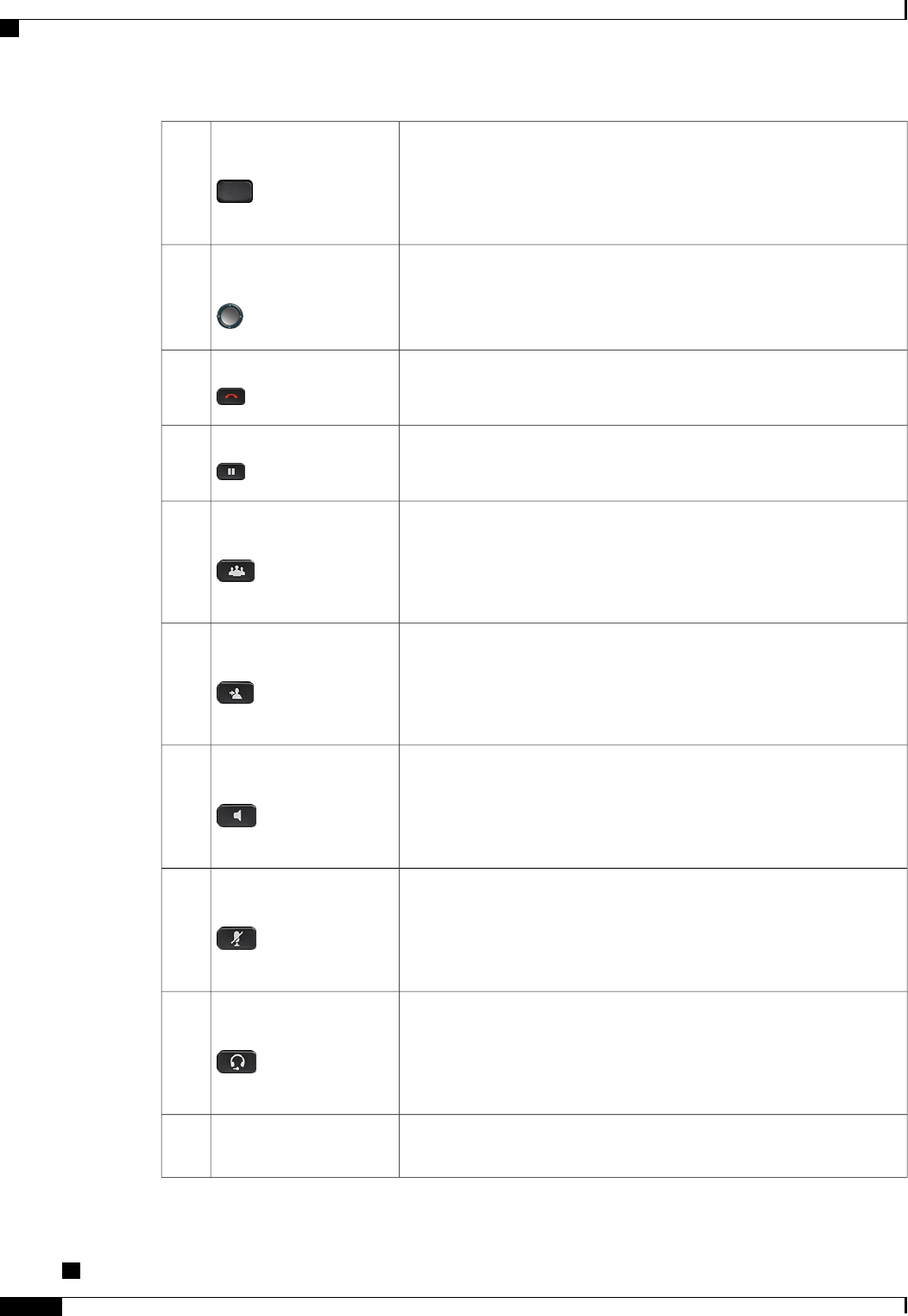
Depending on how your system administrator sets up the phone, enable
softkey options displayed on your phone screen.
Softkey buttons4
The Navigation cluster and Select button allows you to scroll through
menus, highlight items and select the highlighted item.
Navigation cluster and
Select button
5
Ends a connected call or session.Release Button
6
Places an active call on hold and resumes the held call.Hold/Resume button7
Creates a conference call.Conference button
8
Transfers a call.Transfer button
9
Toggles the speakerphone on or off. When the speakerphone is on, the
button is lit.
Speakerphone button10
Toggles the microphone on or off. When the microphone is muted, the
button is lit.
Mute button
11
Toggles the headset on or off. When the headset is on, the button is lit.Headset button
12
Allows you to dial phone numbers, enter letters, and select menu items
(by entering the item number).
Keypad13
Cisco IP Phone 8811, 8841, 8845, 8851, 8851NR, 8861, and 8865 User Guide for Cisco Unified Communications
Manager 11.0
26
Getting Started
Buttons and Hardware
REVIEW DRAFT - CISCO CONFIDENTIAL
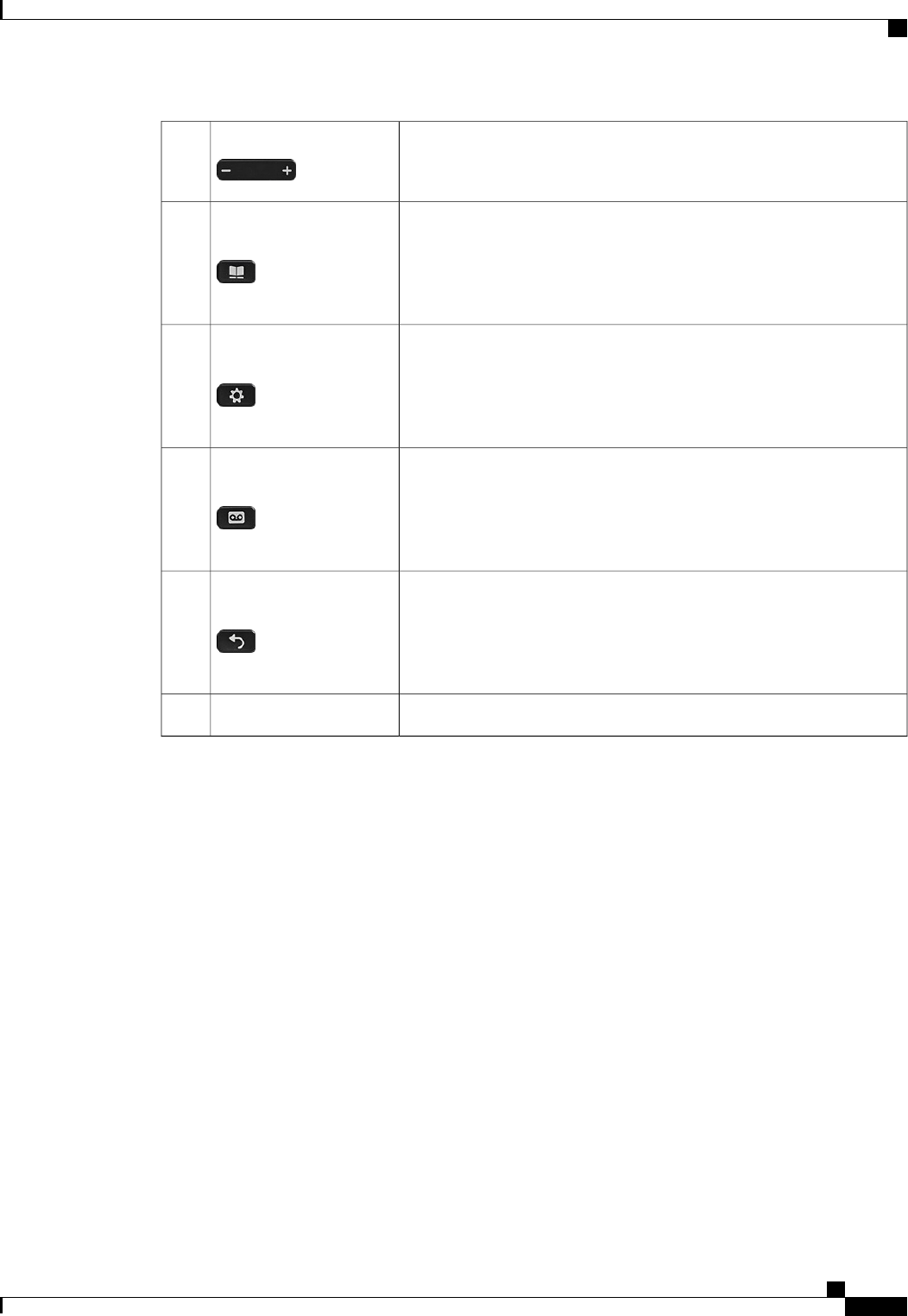
Controls the handset, headset, and speakerphone volume (off hook) and
the ringer volume (on hook).
Volume button14
Opens or closes the Directories menu. Use the Contacts button to access
personal and corporate directories.
Contacts button
15
Opens or closes the Applications menu. Use the Applications button to
access call history, user preferences, phone settings, and phone model
information.
Applications button
16
Autodials your voice messaging system (varies by system).Messages button
17
Returns to the previous screen or menu.Back button
18
Phone handset.Handset19
Power Save and Power Save Plus
There are two levels of energy-saving modes that your system administrator can set up:
•Backlight turns off when not in use for a period of time, reducing the power requirements.
•Power Save Plus: The phone display goes blank, turning the phone off and on at predetermined times.
The power to the phone is significantly reduced.
Power Save
Depending on how your system administrator set up your phone, the phone display may go into a power-save
mode (the phone screen appears blank and the Select button is lit white).
To turn on the phone display, press any button or pick up the handset.
Cisco IP Phone 8811, 8841, 8845, 8851, 8851NR, 8861, and 8865 User Guide for Cisco Unified Communications Manager
11.0
27
Getting Started
Power Save and Power Save Plus
REVIEW DRAFT - CISCO CONFIDENTIAL

Power Save Plus
Your phone supports the Cisco EnergyWise (EW) program, also known as Power Save Plus. Your system
administrator sets up sleep (power down) and wake (power up) times for your phone to save energy. If your
phone goes into the Power Save Plus mode, the Select button is lit white.
Ten minutes before the scheduled sleep time, the Select button lights up and you receive a message that your
phone will power off at a specific time. If enabled by your system administrator, you also hear your ringtone
play. The ringtone plays according to the following schedule:
•At 10 minutes before power off, the ringtone plays four times
•At 7 minutes before power off, the ringtone plays four times
•At 4 minutes before power off, the ringtone plays four times
•At 30 seconds before power off, the ring tone plays 15 times or until the phone powers off
If your phone is inactive (idle) at the sleep time, you see a message to remind you that your phone is about
to power down. To keep the phone active, you need to press OK in the message or any key on the phone. If
you do not press the button or any key, your phone powers down.
If your phone is active (for example, on a call), your phone waits until it has been inactive for a period of time
before telling you of the pending power shutdown. Before the shutdown happens, you see a message to remind
you that your phone is about to power off.
After your phone goes to sleep, press Select to wake up your phone. After the phone is inactive for a period
of time, a message displays to alert you that the phone is about to power down. At the configured wake time,
your phone powers up.
Wake and sleep times are also linked to the configured days that you normally work. If your requirements
change (for example, your work hours or work days change), contact your system administrator to have your
phone reconfigured.
For more information about EnergyWise and your phone, contact your system administrator.
Additional Information
You can access the Cisco website at this URL: http://www.cisco.com/
Within the Cisco website, you can find the following information:
•Quick reference cards, quick start guides, and end-user guides:
http://www.cisco.com/c/en/us/support/collaboration-endpoints/unified-ip-phone-8800-series/
products-user-guide-list.html
•Licensing information:
http://www.cisco.com/c/en/us/support/collaboration-endpoints/unified-ip-phone-8800-series/
products-licensing-information-listing.html
•Cisco international websites:
Allows access to international Cisco websites from www.cisco.com by clicking the Worldwide [change]
link at the top of the web page.
Cisco IP Phone 8811, 8841, 8845, 8851, 8851NR, 8861, and 8865 User Guide for Cisco Unified Communications
Manager 11.0
28
Getting Started
Power Save Plus
REVIEW DRAFT - CISCO CONFIDENTIAL
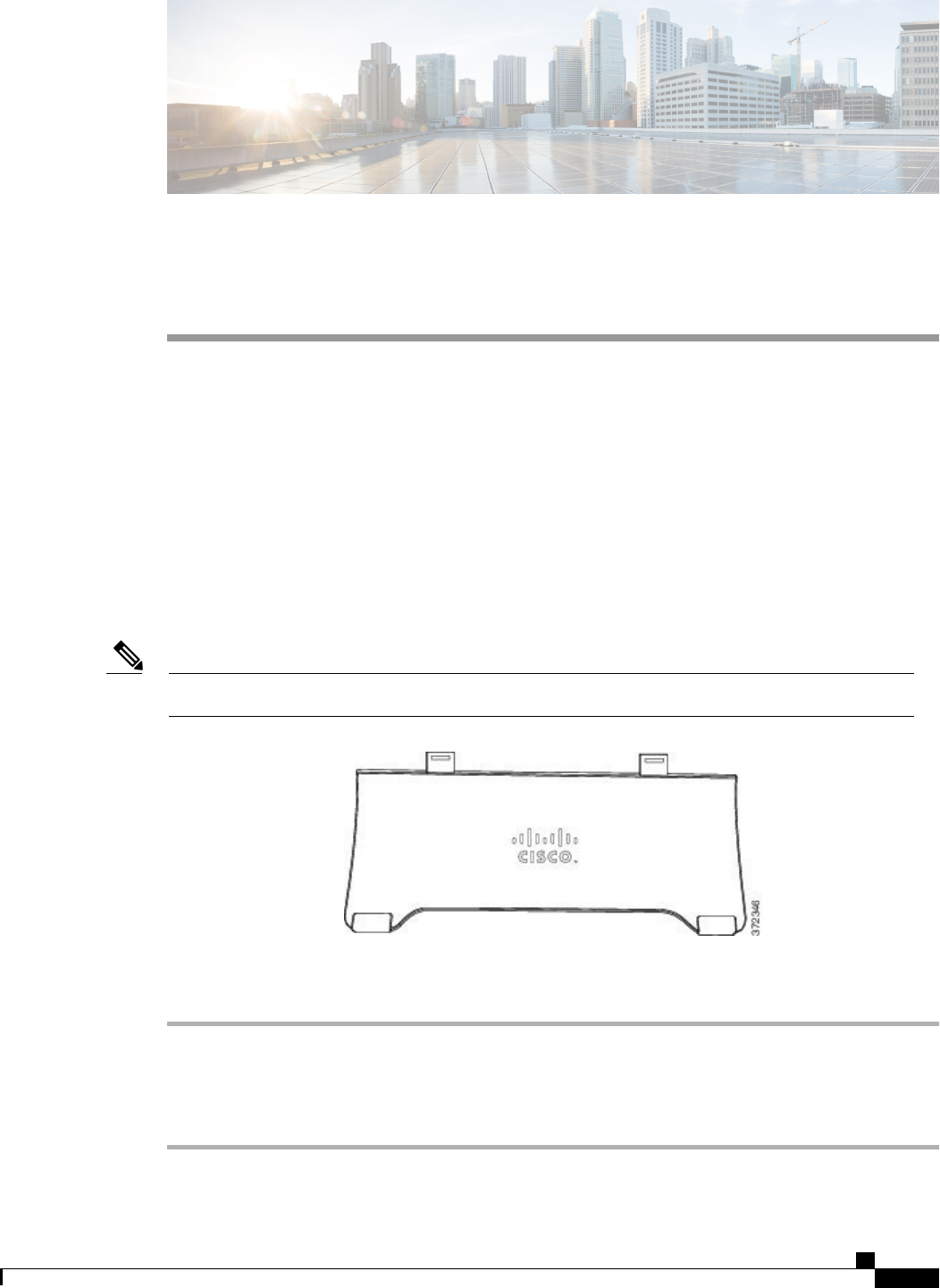
CHAPTER 2
Phone Setup
•Connect Footstand, page 29
•Adjust the Handset Rest, page 30
•Secure the Phone with a Cable Lock, page 30
Connect Footstand
The phone includes an adjustable footstand. If the phone is placed on a table or desk, the footstand can be
connected to the back of the phone. The footstand enables the phone angle to be adjusted from a minimum
of 35 degrees to a maximum of 50 degrees to ensure an optimal viewing angle.
Adjusting the footstand to the required angle may require more force than you expect.Note
Procedure
Step 1 Insert the connectors into the slots provided.
Step 2 Press the footstand until the connectors snap into place.
Step 3 Adjust the angle by pressing down or pulling up on the footstand. The connectors are made of a flexible
material.
Cisco IP Phone 8811, 8841, 8845, 8851, 8851NR, 8861, and 8865 User Guide for Cisco Unified Communications Manager
11.0
29
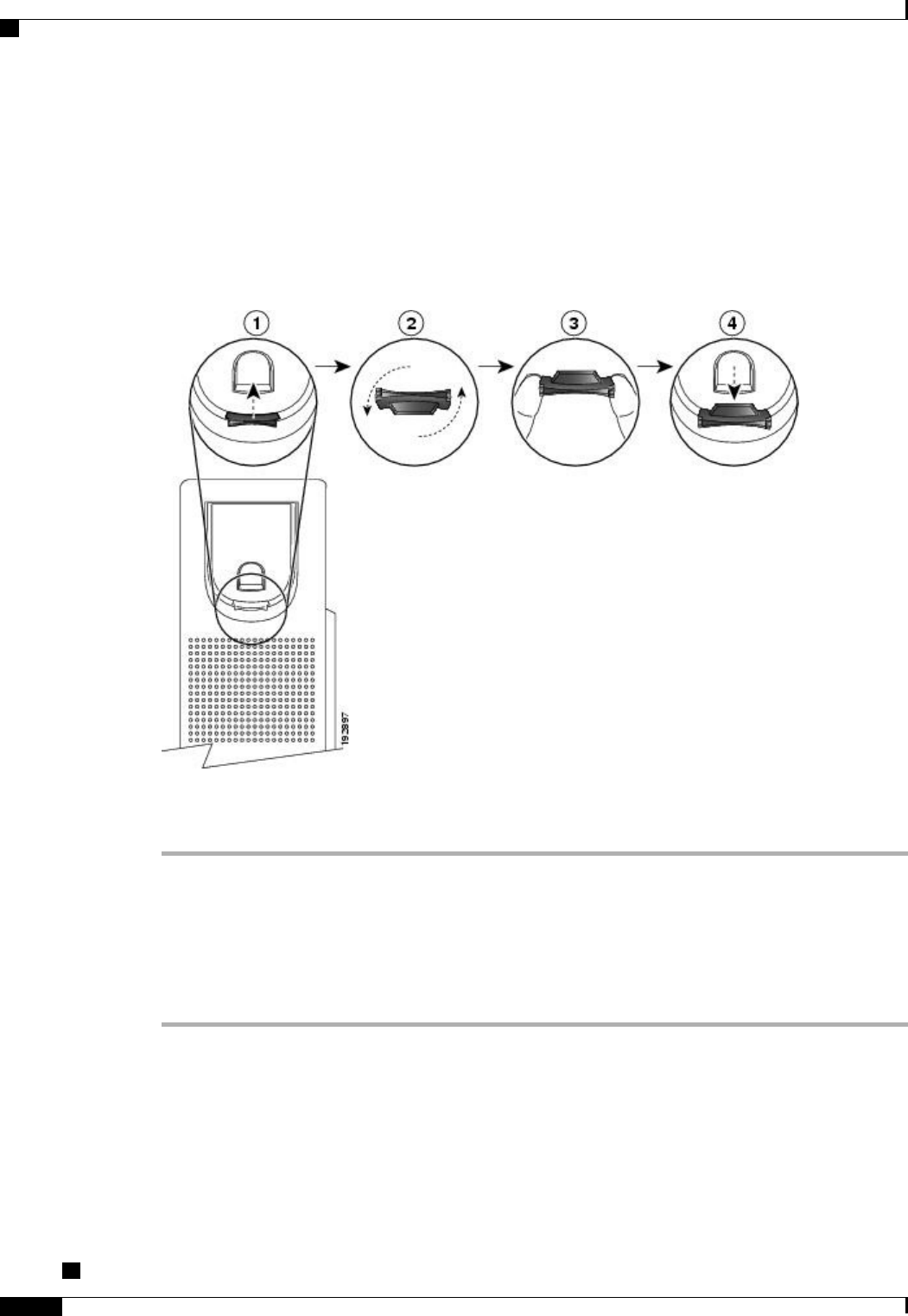
Adjust the Handset Rest
If your phone is wall-mounted, you may need to adjust the handset rest to ensure that the receiver does not
slip out of the cradle.
Procedure
Step 1 Remove the handset from the cradle and pull the plastic tab from the handset rest.
Step 2 Rotate the tab 180 degrees.
Step 3 Hold the tab between two fingers, with the corner notches facing you.
Step 4 Line up the tab with the slot in the cradle and press the tab evenly into the slot. An extension protrudes from
the top of the rotated tab.
Step 5 Return the handset to the handset rest.
Secure the Phone with a Cable Lock
You can secure the phone to a desktop with a laptop cable lock. The lock connects to the antitheft security
connector on the back of the phone and the cable can be secured to a desktop.
Cisco IP Phone 8811, 8841, 8845, 8851, 8851NR, 8861, and 8865 User Guide for Cisco Unified Communications
Manager 11.0
30
Phone Setup
Adjust the Handset Rest
REVIEW DRAFT - CISCO CONFIDENTIAL

The security slot can accommodate a lock up to 20 mm wide. Compatible laptop cable locks include the
Kensington laptop cable lock and laptop cable locks from other manufacturers that can fit into the security
slot on the back of the phone.
Procedure
Step 1 Wrap the looped end of the cable lock and wrap it around object to which you want to secure your phone.
Step 2 Pass the lock through the looped end of the cable.
Step 3 Unlock the cable lock.
There are two kinds of cable locks: keyed and combination. Depending on the type of lock you have,
unlock it by using the key or the correct combination.
Note
Step 4 Press and hold the locking button to align the locking teeth.
Step 5 Insert the cable lock into the lock slot of your phone and release the locking button.
Step 6 Lock the cable lock.
For keyed locks, turn the key 90 degrees in the clockwise direction and pull the key out of the lock.
For combination locks, rotate the lock 90 degrees and then scramble the combination.
Note
Cisco IP Phone 8811, 8841, 8845, 8851, 8851NR, 8861, and 8865 User Guide for Cisco Unified Communications Manager
11.0
31
Phone Setup
Secure the Phone with a Cable Lock
REVIEW DRAFT - CISCO CONFIDENTIAL

Cisco IP Phone 8811, 8841, 8845, 8851, 8851NR, 8861, and 8865 User Guide for Cisco Unified Communications
Manager 11.0
32
Phone Setup
Secure the Phone with a Cable Lock
REVIEW DRAFT - CISCO CONFIDENTIAL

CHAPTER 3
Basic Operations
•Clean the Phone Display, page 33
•Make Calls, page 34
•Navigate and Select Items, page 36
•View All Calls on the Phone, page 37
•Answer Calls, page 37
•Automatically Answer Calls, page 41
•Respond to a Call Waiting Notification, page 42
•Manage Calls, page 42
•Call Forward, page 44
•Mute Phone, page 45
•Hold Calls, page 45
•Set Up Call Back Notification, page 47
•Call Park, page 47
•Manage Intercom Calls, page 49
•View Phone Information, page 50
•Video Calls, page 51
•Sign In To the Cisco Unified Communications Self Care Portal, page 53
Clean the Phone Display
Phone displays that are not touchscreens can be easily cleaned.
Procedure
Wipe the screen with a soft, dry cloth.
Cisco IP Phone 8811, 8841, 8845, 8851, 8851NR, 8861, and 8865 User Guide for Cisco Unified Communications Manager
11.0
33

Use only a soft, dry cloth to wipe the phone display. Do not use any liquids or powders on the
phone because they can contaminate phone components and cause failures.
Caution
Make Calls
If the phone window displays the Unprovisioned message for your primary line, contact your system
administrator to get the primary line set up.
Predial a Number
You can dial a number while your phone is on-hook (without hearing dial tone); this dialing action is called
predial.
Procedure
Step 1 Enter a number using the keypad.
Step 2 Go off-hook using one of the following actions:
•Lift the handset.
•Press Call.
•Press Handset .
•Press Speakerphone .
Place a Call Using the Speakerphone
Your administrator can configure your phone so that the speakerphone is disabled. If the speakerphone is
disabled, the softkeys are dimmed or blank.
Procedure
Step 1 Press Speakerphone .
Step 2 Enter a number.
Cisco IP Phone 8811, 8841, 8845, 8851, 8851NR, 8861, and 8865 User Guide for Cisco Unified Communications
Manager 11.0
34
Basic Operations
Make Calls
REVIEW DRAFT - CISCO CONFIDENTIAL

Place a Call Using a Headset
Procedure
Step 1 Press New Call.
Step 2 Ensure the headset button is lit. If the headset button is not lit, press Headset .
Step 3 Enter a number.
Release a Call and Start Another Call
When you are on an active call or dialing, and want to release the call, the following actions occur:
•The active call ends.
•The phone provides dial tone.
•You can dial the new call.
Procedure
Step 1 When you are on an active call or while dialing, press End Call.
Step 2 Enter the required number and press Call.
Dial an International Number
Plus Dialing allows you to press and hold the star (*) key for at least 1 second to insert a plus (+) sign as the
first digit in a phone number for international dialing. The plus sign applies only for on-hook or off-hook
calling.
When you see phone numbers with the + sign in them, you can select and dial the entry without having to add
digits for international calls.
Procedure
Step 1 Press and hold star (*) for at least 1 second.
The plus (+) sign displays as the first digit in the phone number. The corresponding tone stops to indicate that
the * has changed to a + sign. You can only hear the tone in off-hook state.
Step 2 Dial the number.
Cisco IP Phone 8811, 8841, 8845, 8851, 8851NR, 8861, and 8865 User Guide for Cisco Unified Communications Manager
11.0
35
Basic Operations
Place a Call Using a Headset
REVIEW DRAFT - CISCO CONFIDENTIAL

Redial a Number
Redial allows you to call the most recently dialed phone number.
Procedure
Step 1 To place a call from any phone line, press Redial.
Step 2 To place the call on a specific phone line, select the line to obtain dial tone and press Redial.
Navigate and Select Items
ExampleActionTask
Highlight a call from the missed call list.Press the Navigation cluster and Select
button.
Scroll to highlight an item.
Press 2 to select the second item in the
Applications menu.
Press the corresponding number on the
keypad.
Select an item by number.
Highlight the Settings application and press
Select.
Press Select at the center of the Navigation
cluster and Select button.
Select an item using the Select button.
Highlight the Network Setup menu, then press
1 to open the submenu.
Highlight the menu item and press the item
number on the keypad.
Or press the Navigation cluster and Select
button.
Navigate to a submenu.
(A right arrow (>) next to the menu
item indicates that a submenu exists.)
Press the line button and then press Forward
All to forward calls on that line.
Press the line button.
Indicators of your line selection include:
•The selected line is displayed on the
phone screen header.
•On phones with color screens, the color
of the icon (on the line label) changes
to blue.
Select a line to use a calling feature
(when the line is idle).
Cisco IP Phone 8811, 8841, 8845, 8851, 8851NR, 8861, and 8865 User Guide for Cisco Unified Communications
Manager 11.0
36
Basic Operations
Redial a Number
REVIEW DRAFT - CISCO CONFIDENTIAL

ExampleActionTask
Press the line button twice and then press
Forward All to forward calls on that line.
Press the line button.
Indicators of your line selection include:
•The selected line is displayed on the
phone screen header.
•On phones with color screens, the color
of the icon (on the line label) changes
to blue.
Select a line to use a calling feature
(when the line has one or more active
calls).
View All Calls on the Phone
All Calls allows you to view a list, sorted in chronological order (oldest first), of all active calls on all of your
phone lines. You see the normal phone calls as well as shared line, barged calls, and conference calls.
You use this feature if you have multiple lines or if you share lines with other users. With the All Calls view:
•All active calls display on one place, making it easy to view and interact with calls on any line.
•When you lift the handset, the phone selects your primary line, which helps prevent inadvertent use of
a shared line for dialing.
•You can press the flashing amber session button to answer a ringing call on any line. You do not need
to first select the line with the ringing call before answering it.
Your system administrator sets up the All Calls button depending on your call-handling needs and work
environment.
The All Calls button is the session key with an associated icon. When the icon changes, you have missed a
call. Press the icon to view the call history information for the missed call.
Your system administrator can also set up your primary line to automatically display all calls. Your system
administrator can also set up your phone so that after a call completes, the primary line with the All Calls
view displays.
Procedure
Step 1 To view all calls, press All Calls.
Step 2 If you do not see the All Calls button, press Primary Line.
Answer Calls
Answer allows you to answer the oldest call that is available on all line appearances on your phone, including
Hold Reversion and Park Reversion calls that are in an alerting state. Incoming calls always have priority
over Held or Park Reversion calls.
Cisco IP Phone 8811, 8841, 8845, 8851, 8851NR, 8861, and 8865 User Guide for Cisco Unified Communications Manager
11.0
37
Basic Operations
View All Calls on the Phone
REVIEW DRAFT - CISCO CONFIDENTIAL

Your system administrator sets up the Answer button depending on your call-handling needs and work
environment. This feature is typically set up for users who have multiple lines.
When you get a call, you see a notification window on the phone screen, called a call toast. The call toast
remains visible for a preset amount of time. If an incoming call has been call forwarded from another phone,
you may see additional information in the call toast to identify that the call has been forwarded.
If an incoming call has been call forwarded from another phone, you may see additional information to identify
that the call has been forwarded. Your system administrator controls the amount of additional information
that is displayed. Additional information can identify the person who forwarded the call to you and the caller
information.
For more information, contact your system administrator.
Answer the Oldest Call First
Answer allows you to answer the oldest call that is available on all line appearances on your phone, including
Hold Reversion and Park Reversion calls that are in an alerting state. Incoming calls always have priority
over Held or Park Reversion calls.
Your system administrator sets up the Answer button depending on your call-handling needs and work
environment. Typically, the Answer is set up if you have multiple lines.
When you get a call, you see a notification window on the phone screen, called a call toast. The call toast
remains visible for a preset amount of time. Your system administrator sets up the default time.
If an incoming call has been call forwarded from another phone, you may see additional information in the
call toast to identify that the call has been forwarded. Your system administrator controls the amount of
additional information displayed. Additional information can identify the person who forwarded the call to
you and the caller information.
Procedure
To answer the oldest incoming call first, press Answer.
Call Pickup
Call Pickup allows you to answer a call that is ringing on a coworker’s phone by redirecting the call to your
phone. Your system administrator sets up call groups and can assign you to one or more call groups. Your
system administrator also sets up the Call Pickup softkeys depending on your call-handling needs and work
environment.
You might use Call Pickup if you share call-handling tasks with coworkers.
There are three ways you can pick up a call:
Pickup
Allows you to answer a call that is ringing on another phone within your call pickup group.
If multiple calls are available for pick up, your phone picks up the oldest call first (the call that has been
ringing for the longest time).
Cisco IP Phone 8811, 8841, 8845, 8851, 8851NR, 8861, and 8865 User Guide for Cisco Unified Communications
Manager 11.0
38
Basic Operations
Answer the Oldest Call First
REVIEW DRAFT - CISCO CONFIDENTIAL

Group Pickup
Allows you to answer a call on a phone that is outside your call pickup group by:
•Using a group pickup number (provided by your system administrator).
•Dialing the number of the ringing phone.
Other Pickup
Allows you to answer a call that is ringing on another phone within in your call pickup group or in an
associated call pickup group.
You can also monitor and pick up ringing calls using Line Status indicators if your system administrator has
set up Line Status indicators on speed-dial buttons for you. Line Status indicators allow you to see if a line
associated with a speed-dial button is idle, in-use, in a Do Not Disturb state, or ringing.
Related Topics
Line Status Indicators, on page 82
Answer a Call Using PickUp
Call PickUp allows you to answer a call ringing on a coworker’s phone by redirecting the call to your phone.
You might use Call PickUp if you share call-handling tasks with coworkers.
There are three ways you can pick up a call:
•PickUp: Allows you to answer a call ringing on another phone within your call pickup group.
If multiple calls are available for pick up, your phone picks up the oldest call first (the call that has been
ringing for the longest time).
•Group PickUp: Allows you to answer a call on a phone that is outside your call pickup group by:
•Using a group pickup number (provided by your system administrator).
•Dialing the number of the ringing phone.
•Other PickUp: Allows you to answer a call ringing on another phone within in your call pickup group
or in an associated call pickup group.
Your system administrator sets up your call pickup group and your call pickup softkeys, depending on your
call-handling needs and work environment.
You can also monitor and pick up ringing calls using Line Status indicators if your system administrator has
set up Line Status indicators on speed-dial buttons for you. Line Status indicators allow you to see if a line
that is associated with a speed-dial button is idle, in-use, in a Do Not Disturb state, or ringing.
Procedure
Step 1 Perform one of the following actions:
•Press PickUp to transfer a ringing call within your pickup group to your phone.
Cisco IP Phone 8811, 8841, 8845, 8851, 8851NR, 8861, and 8865 User Guide for Cisco Unified Communications Manager
11.0
39
Basic Operations
Call Pickup
REVIEW DRAFT - CISCO CONFIDENTIAL

•If you have multiple lines and want to pick up the call on a nonprimary line, first press the desired line
button, then press PickUp.
If your phone supports autopickup, you are connected to the call.
Step 2 If the call rings, press Answer to connect to the call.
Answer a Call Using Group PickUp and a Phone Number
Procedure
Step 1 Perform one of the following actions:
•Press Group PickUp.
•If you have multiple lines and want to pick up the call on a nonprimary line, first press the desired line
button, and then press Group PickUp.
Step 2 Enter the number of the phone line with the call that you want to pick up.
For example, if the call is ringing on line 12345, enter 12345.
If your phone supports autopickup, you are now connected to the call.
Step 3 If the call rings, press Answer to connect to the call.
Answer a Call Using Group PickUp and a Group PickUp Number
Procedure
Step 1 Perform one of the following actions:
•Press Group PickUp to answer a call on a phone outside your pickup group.
•If you have multiple lines and want to pick up the call on another line, first press the desired line button,
then press Group PickUp.
Step 2 Enter the group pickup number.
If your phone supports autopickup, you are now connected to the call.
Step 3 If the call rings, press Answer to connect to the call.
Cisco IP Phone 8811, 8841, 8845, 8851, 8851NR, 8861, and 8865 User Guide for Cisco Unified Communications
Manager 11.0
40
Basic Operations
Call Pickup
REVIEW DRAFT - CISCO CONFIDENTIAL

Answer a Call Using Other PickUp
Procedure
Step 1 Perform one of the following actions:
•Press OPickUp to answer a call in your pickup group or in an associated group to your phone.
•If you have multiple lines and want to pick up the call on another line, first press the desired line button,
then press OPickUp.
Step 2 If the call rings, press Answer to connect to the call.
Automatically Answer Calls
Incoming calls can be answered automatically by your phone after one ring. Your administrator sets up the
Auto Answer feature to work with either your speakerphone or headset. For more information, contact your
administrator.
Procedure
Step 1 When your phone is set up to autoanswer calls using your headset,
a) To answer calls automatically with a headset, prepare your phone in the following way:
•Ensure that your headset is connected to the phone.
•Ensure that the headset button is illuminated.
When you get a call, the call answers automatically and you interact with the caller using the headset.
b) To end calls or make calls, use the buttons and softkeys. Do not use the headset button .
c) If you do not want calls to automatically answer on your headset, press the headset button to turn off
the headset and use the handset or speakerphone to make and answer calls.
Step 2 When your phone is set up to autoanswer calls using the speakerphone,
a) To answer calls automatically on the speakerphone, prepare your phone in the following way:
•Ensure that the headset button is not illuminated.
•Leave the handset in the cradle.
When you get a call, the call answers automatically and you interact with the caller using the
speakerphone.
Cisco IP Phone 8811, 8841, 8845, 8851, 8851NR, 8861, and 8865 User Guide for Cisco Unified Communications Manager
11.0
41
Basic Operations
Automatically Answer Calls
REVIEW DRAFT - CISCO CONFIDENTIAL

b) If you do not want calls to answer automatically on your speakerphone, press the headset button to
make and answer calls using a headset or the handset.
Respond to a Call Waiting Notification
Call Waiting provides the following to notify you that a new call is ringing on your phone when you are
talking on another call:
•Call Waiting tone (single beep)
•An amber flashing line button
This feature is configured by the administrator.
Procedure
Step 1 To answer the ringing call, press the flashing amber session button or press Answer to answer the call. You
can also scroll to the call and press Select to answer it. Your phone puts the original call on hold automatically
and connects the ringing call.
Step 2 If the call is on a different line, you must first press the line button or All Calls, if available, to display the
ringing session and then answer the call.
Step 3 If the call is on the same line and not visible, as there are many calls, then you must scroll to display the
sessions.
Step 4 If a programmable feature button is set up by your system administrator to answer calls, you can press the
feature button to answer a ringing call, regardless of the line of the call or the line that is currently visible.
The phone automatically switches the line to display the call.
Manage Calls
Decline a Call
Decline allows you to send an active or ringing call to your voicemail system or to a predetermined phone
number. For more information, contact your system administrator.
You can silence the incoming (ringing) call. Press Volume down once, then let the incoming call go to the
target number (voicemail or predetermined number set up the system administrator).
Cisco IP Phone 8811, 8841, 8845, 8851, 8851NR, 8861, and 8865 User Guide for Cisco Unified Communications
Manager 11.0
42
Basic Operations
Respond to a Call Waiting Notification
REVIEW DRAFT - CISCO CONFIDENTIAL
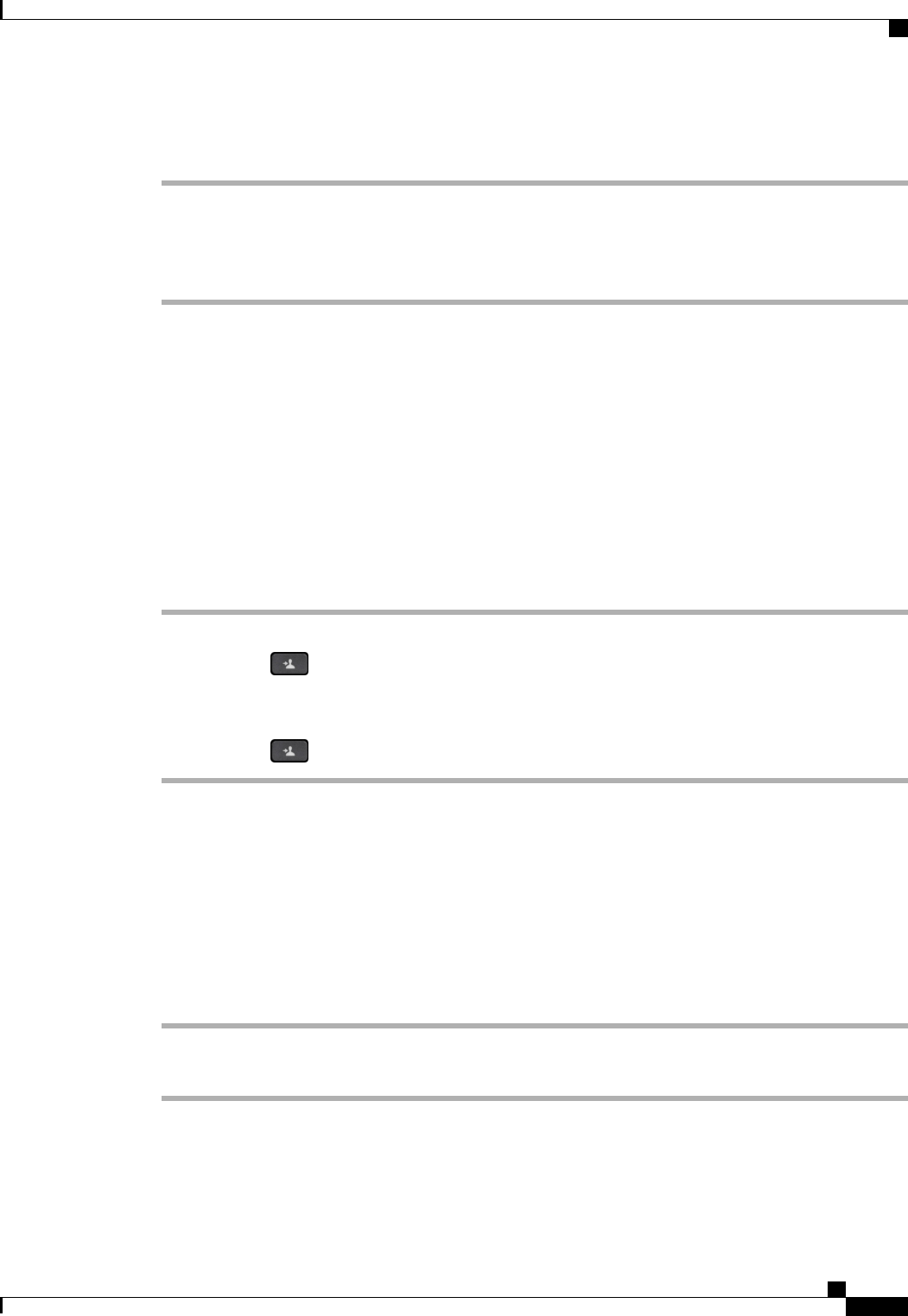
Procedure
Step 1 To redirect an incoming (ringing) call while on another call, highlight the incoming call, then press Decline.
Otherwise, press Decline to redirect the current, active call.
Step 2 To redirect an incoming call while not on a call, press Decline.
Step 3 To redirect a held call, first resume the call and then press Decline.
Transfer a Call to Another Number
Transfer allows you to redirect a connected call from your phone to another number.
•You can redirect a single call to another number that you specify.
•You can connect two calls to each other without remaining on the line yourself.
Your system administrator controls the ability to transfer calls from one line to another line.
Procedure
Step 1 Verify that you are on an active call (not on hold).
Step 2 Press Transfer .
Step 3 Enter the transfer recipient’s phone number or press a speed-dial button.
Step 4 Wait for the recipient to answer or skip to Step 5 while the call is ringing.
Step 5 Press Transfer again.
Toggle Between Calls Before Completing a Transfer
After you connect to the transfer recipient, but before you transfer a call to this party, you can press Swap to
toggle between the two calls. This allows you to consult privately with the party on each call before you
complete the transfer.
Procedure
Step 1 Call a new conference participant, but do not add the participant to the conference.
Step 2 Press Swap to toggle between the participant and the conference.
Cisco IP Phone 8811, 8841, 8845, 8851, 8851NR, 8861, and 8865 User Guide for Cisco Unified Communications Manager
11.0
43
Basic Operations
Transfer a Call to Another Number
REVIEW DRAFT - CISCO CONFIDENTIAL

Monitor and Record Calls
Monitoring and Recording allows you to monitor and record calls if desired. Your system administrator enables
this feature, which can be set up for automatic recording of all calls or recording of individual calls, when
required.
Procedure
To start or stop recording, press Record on your phone.
You may hear notification tones while you monitor and record calls. By default, the person who monitors the
call and records it (if also configured) does not hear the notification tones.
Call Forward
Call Forward allows you to forward calls from any line on your phone to another number.
There are two types of call-forwarding features that your system administrator may set up on your phone:
•Unconditional call forwarding (Call Forward All): Applies to all calls that you receive. You can set up
Call Forward All directly on your phone for any line. To set up Call Forward All remotely, go to the
Self Care Portal.
•Conditional call forwarding (Call Forward No Answer, Call Forward Busy, Call Forward No Coverage):
Applies to certain calls that you receive, according to conditions, and is set up from the Self Care Portal.
When forwarding calls from your phone:
•Enter the call forward target number exactly as you would dial it from your phone. For example, enter
an access code or the area code, if necessary.
•Call forward is phone-line specific. If a call reaches you on a line where call forwarding is not enabled,
the call rings as usual.
•Your system administrator can set up other call-forward options:
◦Allow calls placed from the call forward target number to your phone to ring through, rather than
be forwarded.
◦Prevent you from creating a call-forward loop or exceeding the maximum number of links in a
call forwarding chain.
Forward All Calls
Procedure
Step 1 On any idle line from which you want to forward your calls, press Forward All.
Step 2 Enter a phone number, or select an entry from the Call History list.
Cisco IP Phone 8811, 8841, 8845, 8851, 8851NR, 8861, and 8865 User Guide for Cisco Unified Communications
Manager 11.0
44
Basic Operations
Monitor and Record Calls
REVIEW DRAFT - CISCO CONFIDENTIAL
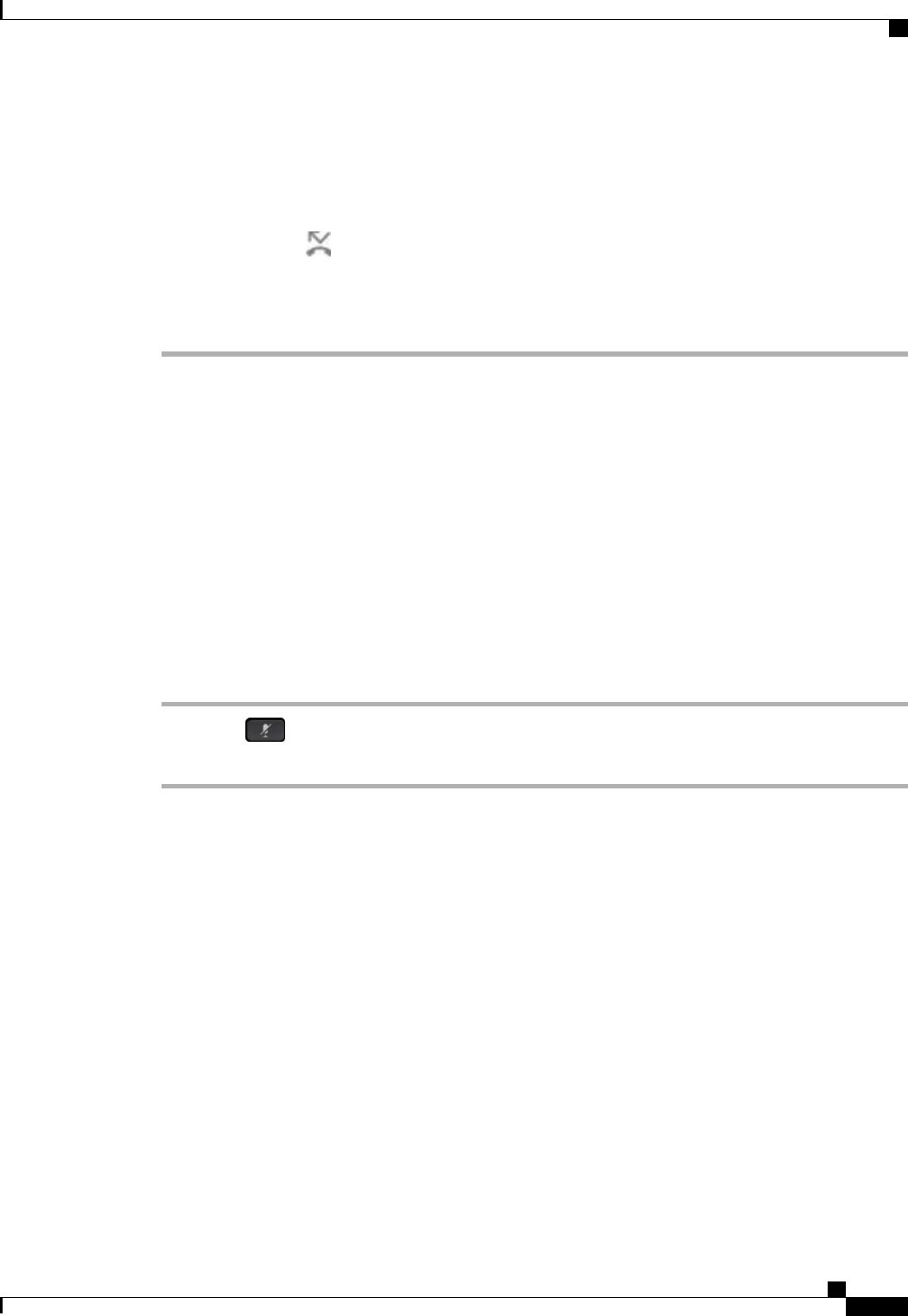
Depending on how your voicemail system is set up, you may be able to press Messages to forward all calls
to voicemail.
Visual confirmation displays for a few seconds to confirm the number to which your calls will be forwarded.
Step 3 To verify that your calls are forwarded, look for:
•A Forward All icon in the line label.
•The forwarding information in the header.
Step 4 To cancel call forwarding, press Forward Off.
Mute Phone
Mute allows you to block audio input for your handset, headset, and speakerphone, so that you can hear other
parties on the call but they cannot hear you.
When the Separate Audio and Video Mute feature is enabled, you mute the audio but continue to transmit a
video image when you press Mute during a video call. This allows the other parties to see you but not to hear
you. When this feature is disabled, you mute both the audio and the video image when you press Mute during
a video call.
The Separate Audio and Video Mute feature is disabled by default. See your administrator to have it enabled.
Procedure
Step 1 Press Mute to turn Mute on.
Step 2 Press Mute again to turn Mute off.
Hold Calls
Hold allows you to put an active call into a held state. Your phone allows one active call at a time; other calls
are put on hold. Hold works with your phone handset as well as with USB headsets.
Procedure
While on an active call, press Hold.
Swap Between Active and Held Calls
Use the line buttons to swap between held and connected calls.
Cisco IP Phone 8811, 8841, 8845, 8851, 8851NR, 8861, and 8865 User Guide for Cisco Unified Communications Manager
11.0
45
Basic Operations
Mute Phone
REVIEW DRAFT - CISCO CONFIDENTIAL

Procedure
If you have a held call and an active call, press the line button for the held call to resume that call and place
the other call on hold automatically.
Put a Call on Hold by Answering a New Call
If you are already on a call and receive a new call, answering the new call puts the first call on hold
automatically.
Procedure
Press flashing amber line button or press Answer to answer the ringing call.
Respond to a Hold Reversion Notification
Hold Reversion notifies you when a call is left on hold.
A Hold Reversion notification is similar to a new call notification and includes these cues:
•Single ring, repeating at intervals
•Flashing amber line button
•Flashing message indicator on the handset
•Visual notification on the phone screen
Procedure
Press the flashing amber line button or Answer to resume the held call.
Determine If a Shared Line Is On Hold
If a call on a shared line has been put on hold remotely by another user, a pulsing red line button and the Hold
icon are displayed.
Remote Hold
When you place a call on hold while using a shared line, the line button pulses green and the phone displays
the Hold icon. When another phone places a call on hold, the line button pulses red and the phone displays
the Remote Hold icon.
Cisco IP Phone 8811, 8841, 8845, 8851, 8851NR, 8861, and 8865 User Guide for Cisco Unified Communications
Manager 11.0
46
Basic Operations
Put a Call on Hold by Answering a New Call
REVIEW DRAFT - CISCO CONFIDENTIAL

Set Up Call Back Notification
Procedure
Step 1 Press Callback while listening to the busy tone or ring sound.
Step 2 Press Exit to exit the confirmation screen.
Your phone alerts you when the line is free.
Step 3 Press Call to place the call again.
Call Park
Call Park allows you to use your phone to park (temporarily store) a call, which you can then retrieve from
another phone (such as a phone at a coworker’s desk or in a conference room).
There are two ways you can park a call:
Park
Allows you to park an active call that you answered on your phone, and retrieve it using another phone
in the Cisco Unified Communications Manager system.
Directed Call Park
Allows you to park and retrieve an active call in two different ways:
•Assisted Directed Call Park: Allows you to park an active call using a feature button, which your
system administrator sets up as a speed-dial line.
With this type of directed call, you can monitor the status of the line (in-use or idle) using Line
Status indicators.
•Manual Directed Call Park: Allows you to park an active call by transferring it to a Directed Call
number, which your system administrator sets up.
You retrieve the call at another phone by dialing a park retrieval prefix number (provided by your
system administrator) and then dialing the Directed Call number you used to park the call.
Your system administrator sets up either the Directed Call Park or the Park feature on your phone, but not
both.
Related Topics
Line Status, on page 82
Cisco IP Phone 8811, 8841, 8845, 8851, 8851NR, 8861, and 8865 User Guide for Cisco Unified Communications Manager
11.0
47
Basic Operations
Set Up Call Back Notification
REVIEW DRAFT - CISCO CONFIDENTIAL

Park and Retrieve a Call Using Call Park
Procedure
Step 1 During a call, press Park, and then hang up.
Your phone displays the number where the system parked the call. The parked call is put on hold, and you
can press Resume to resume the call on your phone.
Step 2 From any other Cisco IP Phone in your network, enter the number where the call is parked to retrieve the call.
Step 3 If you do not retrieve the call within a certain amount of time (set by your system administrator) you receive
an alert tone, at which time you can:
•Press Answer to answer the call on your phone.
•Retrieve the call from another phone.
If you fail to retrieve or answer the call within a specified amount of time, the call is redirected to another
destination (set up by your system administrator), such as voicemail. If the call gets redirected, it can no longer
be retrieved by using Call Park.
Park a Call Using Assisted Directed Call Park
Procedure
Step 1 During a call, press BLF Directed Call Park on a line that displays an idle Line Status indicator.
Step 2 Retrieve the call from any other Cisco IP Phone in your network as follows:
a) Enter the park retrieval prefix.
b) Dial the Directed Call number.
Step 3 If you do not retrieve the call within the time that your system administrator has set, you receive an incoming
call with notification of CallPark Reversion. At that time, you can press answer to answer the call. The other
phones can no longer retrieve that call.
•Press Resume to resume the call on your phone.
•Retrieve the call from another phone.
Cisco IP Phone 8811, 8841, 8845, 8851, 8851NR, 8861, and 8865 User Guide for Cisco Unified Communications
Manager 11.0
48
Basic Operations
Park and Retrieve a Call Using Call Park
REVIEW DRAFT - CISCO CONFIDENTIAL

Park a Call Using Manual Directed Call Park
Procedure
Step 1 During a call, press Transfer .
Step 2 Enter the Directed Call number where you will park the call.
Step 3 Press Transfer again to finish parking the call and then hang up.
Step 4 Retrieve the call from any other Cisco IP Phone in your network as follows:
a) Enter the park retrieval prefix.
b) Dial the Directed Call number.
Step 5 If you do not retrieve the call within the time that your system administrator has set, you receive an alert tone.
At that time, you can:
•Press Resume to resume the call on your phone.
•Retrieve the call from another phone.
Manage Intercom Calls
Intercom allows you to place and receive one-way calls using a dedicated or dialable intercom line.
When you place an intercom call, the recipient’s phone autoanswers with mute activated (whisper mode) and
broadcasts your message through the recipient’s speakerphone, headset, or handset, if one of these devices is
active.
After receiving the intercom call, the recipient can initiate two-way audio (connected mode) to allow for
further conversation.
Place a Dedicated Intercom Call
Intercom allows you to place and receive one-way calls using a dedicated or dialable intercom line.
When you place an intercom call, the recipient phone autoanswers with mute activated (whisper mode) and
broadcasts your message through the recipient’s speakerphone, headset, or handset, if one of these devices is
active.
After receiving the intercom call, the recipient can initiate two-way audio (connected mode) to allow for
further conversation.
Procedure
Step 1 Press Intercom.
Cisco IP Phone 8811, 8841, 8845, 8851, 8851NR, 8861, and 8865 User Guide for Cisco Unified Communications Manager
11.0
49
Basic Operations
Park a Call Using Manual Directed Call Park
REVIEW DRAFT - CISCO CONFIDENTIAL

Your phone enters whisper mode until the recipient accepts the intercom call. If you are on an active
call, that call is placed on hold.
Note
Step 2 Listen for the intercom alert tone, then begin speaking.
Step 3 Press Intercom to end the call.
Place a Dialable Intercom Call
Procedure
Step 1 Press Intercom.
Step 2 Enter the intercom code.
Your phone enters whisper mode until the recipient accepts the intercom call. If you are on an active
call, that call is placed on hold.
Note
Step 3 Listen for the intercom alert tone, then begin speaking.
Step 4 Press Intercom to end the call.
Receive an Intercom Call
Intercom allows you to place and receive one-way calls using a dedicated or dialable intercom line.
After receiving the intercom call, the recipient can initiate two-way audio (connected mode) to allow for
further conversation.
Procedure
Step 1 When an intercom call comes to your phone, you receive a message on your phone screen, an audible alert,
and your phone answers the intercom call with mute activated. You can handle the intercom call in one of
these ways:
•Listen to the intercom caller in whisper mode. Any current call activity you are already engaged in
continues simultaneously. In whisper mode, the intercom caller cannot hear you.
•Press Intercom to switch to connected mode. In connected mode, you can speak to the intercom caller.
Step 2 Press Intercom to end the call.
View Phone Information
Phone Information allows you to view the following information for your phone:
Cisco IP Phone 8811, 8841, 8845, 8851, 8851NR, 8861, and 8865 User Guide for Cisco Unified Communications
Manager 11.0
50
Basic Operations
Place a Dialable Intercom Call
REVIEW DRAFT - CISCO CONFIDENTIAL

•Model Number
•IP Address
•Host Name
•Active Load
•Last Upgrade
•Active Server
•Stand-by-Server
Procedure
Step 1 Press Applications .
Step 2 Select Phone Information.
Step 3 Press Exit to return to the Applications screen.
You can press Show detail to view the upgrade process during an upgrade.Note
Video Calls
The Cisco Unified IP Phones supports phone calls that contain video (if present). With these phones, you do
not need to install the Cisco Unified Video camera to receive the video portion of a call.
Press Turn On to enable the Enable Video On/Off feature, or press Return to return to the Setup screen.
Hide or Show Video
Your system administrator sets up the default softkey (either Show Video or Hide Video) and the default view
(video hidden or video displayed).
Procedure
Step 1 To hide the video, press Hide Video.
Step 2 To show the video, press Show Video.
Hide Softkeys in Full-Screen Video
The softkeys display on the screen when a full-screen video call is enabled. If there is no user activity, the
softkeys automatically hide after 10 seconds.
Cisco IP Phone 8811, 8841, 8845, 8851, 8851NR, 8861, and 8865 User Guide for Cisco Unified Communications Manager
11.0
51
Basic Operations
Video Calls
REVIEW DRAFT - CISCO CONFIDENTIAL

Procedure
To display the softkeys, do one of the following actions:
•Press Mute.
•Change the state of the video such as by plugging in the camera.
•Touch the phone screen (Cisco Unified IP Phone 9971 only).
•Press any softkey (Cisco Unified IP Phone 9951 only).
Enable Full Screen Video
Procedure
Step 1 Press Full Screen.
Step 2 Press Minimize to return to the original view.
Mute Video
Mute allows you to block audio input for your handset, headset, and speakerphone, so that you can hear other
parties on the call but they cannot hear you.
When the Separate Audio and Video Mute feature is enabled, you mute the audio but continue to transmit a
video image when you press Mute during a video call. This allows the other parties to see you but not to hear
you. When this feature is disabled, you mute both the audio and the video image when you press Mute during
a video call.
The Separate Audio and Video Mute feature is disabled by default. See your administrator to have it enabled.
Procedure
Step 1 Press Mute Video.
Step 2 Press Unmute Video to unmute the video.
Swap Views
Procedure
Press Swap to toggle between the full-screen view and the picture-in-picture (PIP) view.
Cisco IP Phone 8811, 8841, 8845, 8851, 8851NR, 8861, and 8865 User Guide for Cisco Unified Communications
Manager 11.0
52
Basic Operations
Enable Full Screen Video
REVIEW DRAFT - CISCO CONFIDENTIAL

The Swap is only available if you are in full-screen view.
Adjust Picture-In-Picture Position
Procedure
Step 1 Press PIP to move the picture-in-picture (PIP) window to a different quadrant of the screen.
Step 2 To disable PIP, press PIP five times.
Sign In To the Cisco Unified Communications Self Care Portal
Your phone is a network device that can share information with other network devices in your company,
including your personal computer. You can use your computer to sign in to the Cisco Unified Communications
Self Care Portal, where you can control features, settings, and services for your phone. For example, you can
manage your phone display language, set up services, add entries to your personal address book, and set up
speed-dial codes.
Before you can access any of your options, such as Speed Dial or Personal Address Book, you must sign in.
When you are finished using portal, you must sign out.
In some cases, you can access the Cisco Unified Communications Self Care Portal without having to sign in.
For more information, contact your system administrator.
For assistance in using the portal, see the Cisco Unified Communications Self Care Portal User Guide, located
at http://www.cisco.com/en/US/products/sw/voicesw/ps556/products_user_guide_list.html.
Procedure
Step 1 Obtain the portal URL, user ID, and default password from your system administrator.
Typically, the portal URL is http://<ip_address or hostname>/ucmuser.
Step 2 Open a web browser on your computer and enter the URL.
Step 3 If prompted to accept security settings, select Yes or Install Certificate.
Step 4 Enter your user ID in the Username field.
Step 5 Enter your password in the Password field.
Step 6 Select Login.
Step 7 To sign out, select Logout.
Cisco IP Phone 8811, 8841, 8845, 8851, 8851NR, 8861, and 8865 User Guide for Cisco Unified Communications Manager
11.0
53
Basic Operations
Adjust Picture-In-Picture Position
REVIEW DRAFT - CISCO CONFIDENTIAL

Cisco IP Phone 8811, 8841, 8845, 8851, 8851NR, 8861, and 8865 User Guide for Cisco Unified Communications
Manager 11.0
54
Basic Operations
Sign In To the Cisco Unified Communications Self Care Portal
REVIEW DRAFT - CISCO CONFIDENTIAL

CHAPTER 4
Contacts
•Corporate Directory, page 55
•Personal Directory, page 56
•Fast Dial, page 59
•Fast-Dial Codes with Personal Directory, page 59
•Cisco WebDialer, page 61
Corporate Directory
The Corporate Directory menu contains corporate contacts that you can access on your phone. Your system
administrator sets up and maintains the directory.
Search and Dial a Contact
Procedure
Step 1 Press Contacts .
Step 2 Use the Navigation cluster and Select button to scroll and select Corporate Directory.
Step 3 Select one or all of these search criteria to search for a coworker:
•First Name
•Last Name
Step 4 Enter the search criteria information, press Submit, and select a contact.
Step 5 To dial, perform one of these actions:
•Press Call.
•Press Select.
Cisco IP Phone 8811, 8841, 8845, 8851, 8851NR, 8861, and 8865 User Guide for Cisco Unified Communications Manager
11.0
55
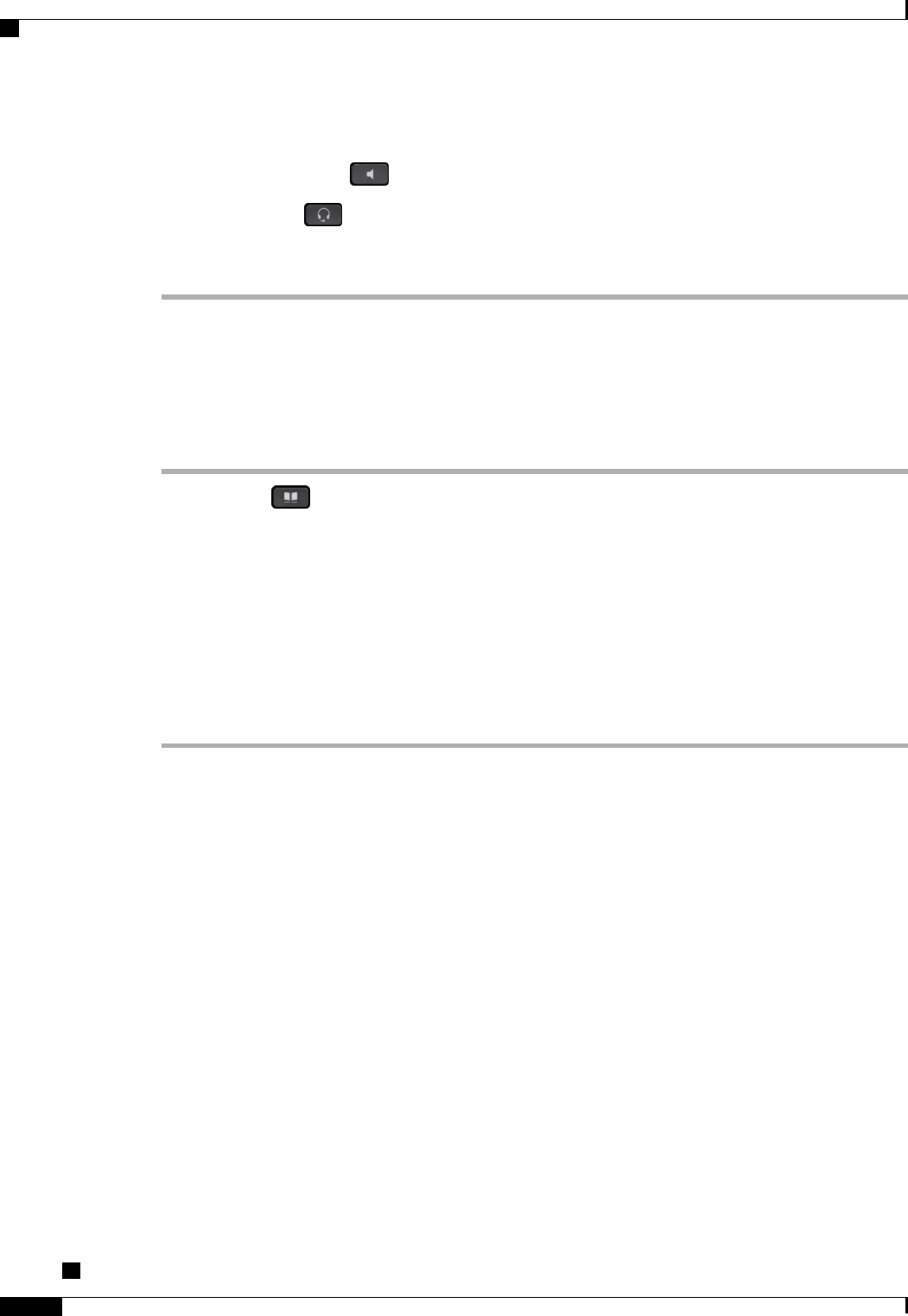
•From the keypad, press the number that displays in the upper right corner of the contact label.
•Press Speakerphone .
•Press Headset .
•Pick up the handset.
Search and Dial a Contact While On a Call
Procedure
Step 1 Press Contacts .
Step 2 Use the Navigation cluster and Select button to scroll and select Corporate Directory.
Step 3 Select one or both of these search criteria to search for a coworker:
•First Name
•Last Name
Step 4 Enter the search criteria information and press Search .
Step 5 Press Call.
The phone puts the existing call on hold and makes the new call.
Personal Directory
The personal directory contains a list of your personal contacts. You can assign fast-dial codes to your personal
directory entries for fast-dialing.
You can set up your personal directory from your phone or from the Cisco Unified Communications Self
Care Portal. Use your phone to assign fast-dial codes to the directory entries. For more information, see the
Cisco Unified Communications Self Care Portal User Guide, located at http://www.cisco.com/en/US/products/
sw/voicesw/ps556/products_user_guide_list.html.
Cisco IP Phone 8811, 8841, 8845, 8851, 8851NR, 8861, and 8865 User Guide for Cisco Unified Communications
Manager 11.0
56
Contacts
Search and Dial a Contact While On a Call
REVIEW DRAFT - CISCO CONFIDENTIAL
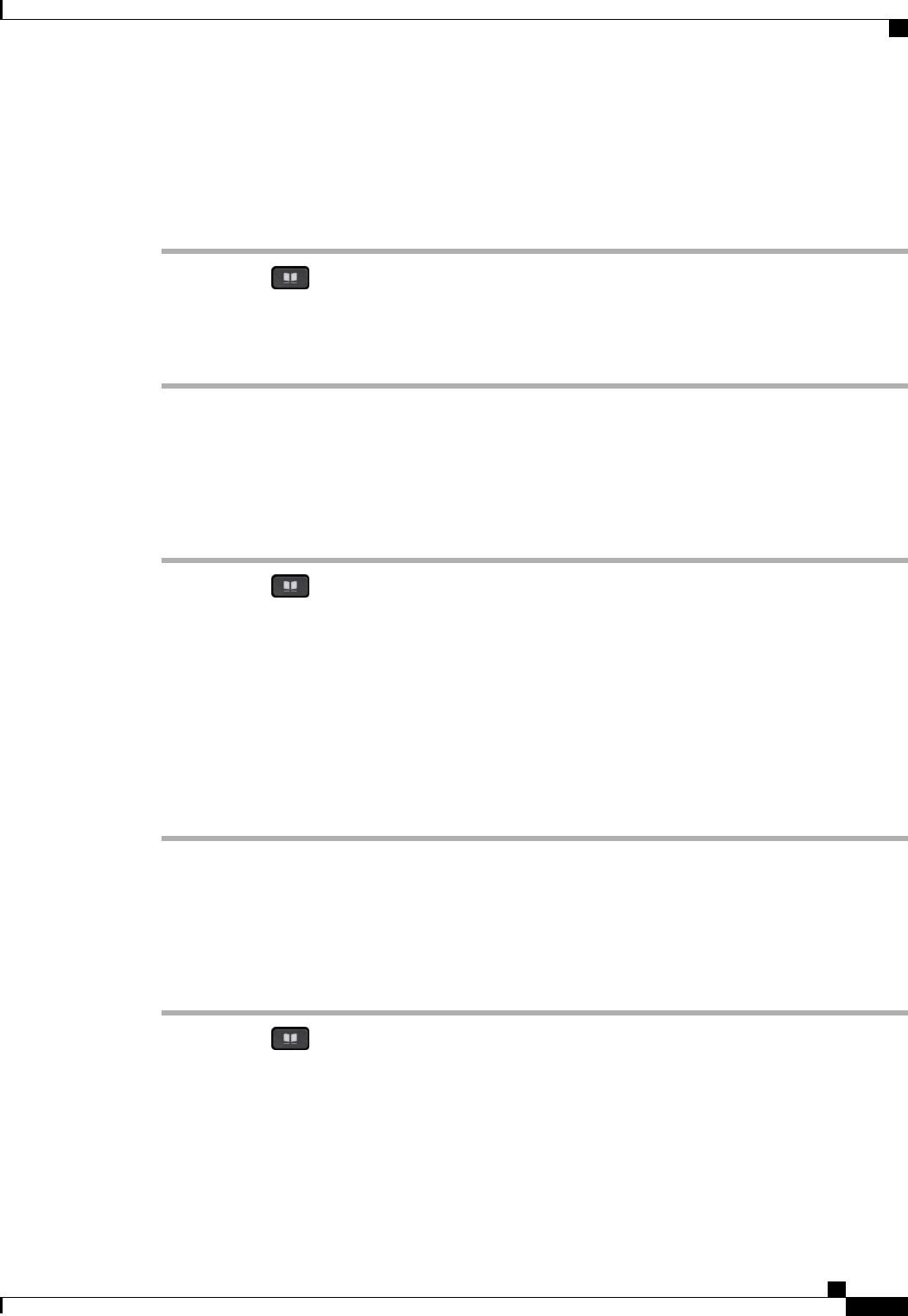
Sign In and Out of the Personal Directory
Procedure
Step 1 Press Contacts .
Step 2 Select Personal Directory.
Step 3 Enter the user ID and PIN, and press Submit.
Step 4 Select Log Out, press Select, and then press OK.
Add a Personal Directory Entry from the Phone
Procedure
Step 1 Press Contacts .
Step 2 Sign in to Personal Directory.
Step 3 Select Personal Address Book.
Step 4 Press Submit.
Step 5 Press New. You may need to press More first.
Step 6 Enter the nickname information.
You can also enter a name.
Step 7 Press Phones and enter the phone numbers.
Make sure you include any required access codes, such as 9 or 1.
Step 8 Press Submit to add the entry to your personal directory.
Search for an Entry in the Personal Directory
Procedure
Step 1 Press Contacts .
Step 2 Sign in to Personal Directory.
Step 3 Select Personal Address Book.
Step 4 Select one or all of the following:
•Last Name
Cisco IP Phone 8811, 8841, 8845, 8851, 8851NR, 8861, and 8865 User Guide for Cisco Unified Communications Manager
11.0
57
Contacts
Sign In and Out of the Personal Directory
REVIEW DRAFT - CISCO CONFIDENTIAL
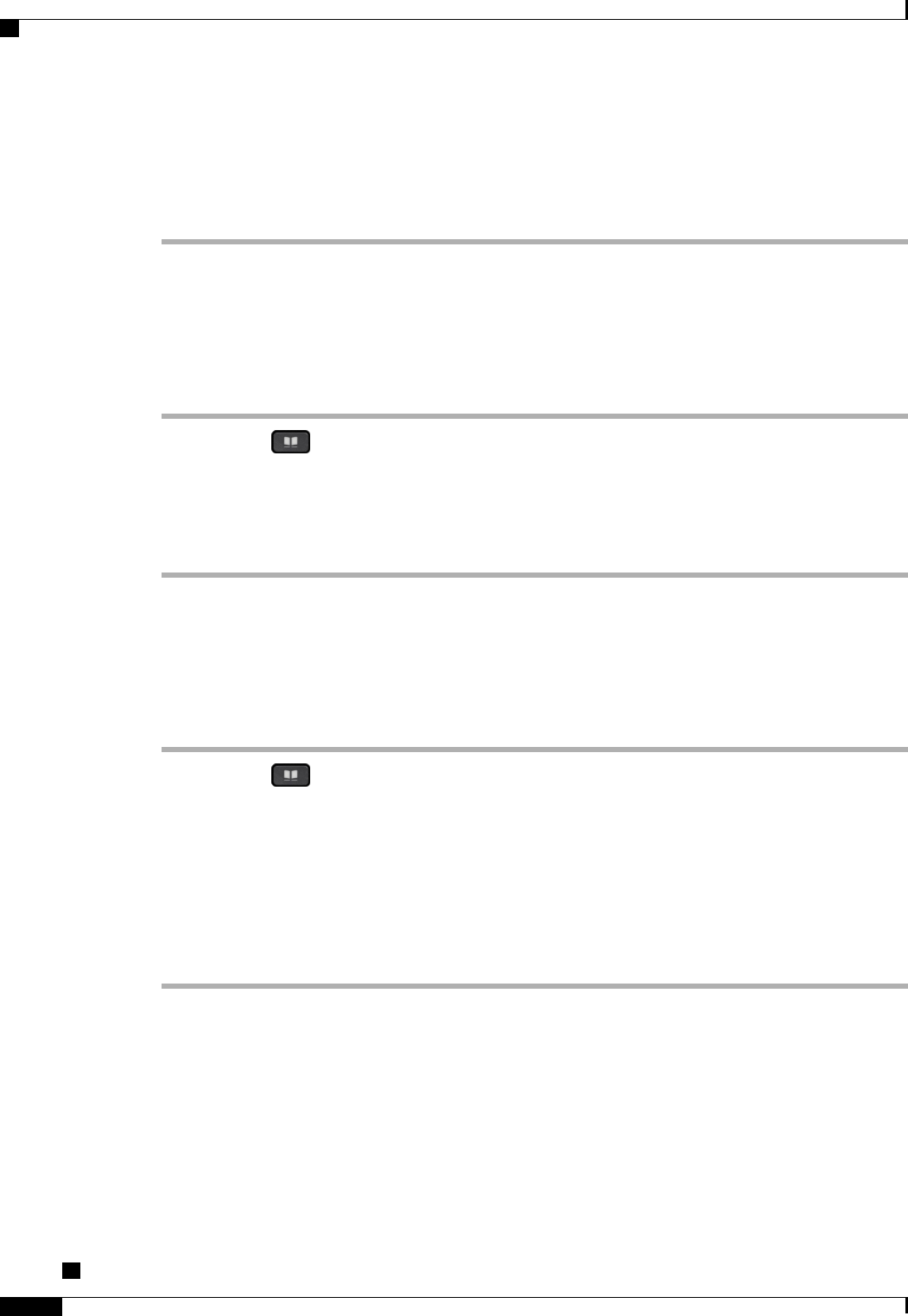
•First Name
•Nickname
Step 5 Enter the search criteria information and press Submit.
Dial a Number from the Personal Directory
Procedure
Step 1 Press Contacts .
Step 2 Sign in to Personal Directory.
Step 3 Select Personal Directory and search for an entry.
Step 4 Select the personal address book entry that you want to dial.
Step 5 Press Call.
Edit a Personal Directory Entry
Procedure
Step 1 Press Contacts .
Step 2 Sign in to Personal Directory.
Step 3 Select Personal Address Book and search for an entry.
Step 4 Press Select.
Step 5 Press Edit.
Step 6 Modify the entry information.
Step 7 Press Phones to modify a phone number.
Step 8 Pres Update.
Cisco IP Phone 8811, 8841, 8845, 8851, 8851NR, 8861, and 8865 User Guide for Cisco Unified Communications
Manager 11.0
58
Contacts
Dial a Number from the Personal Directory
REVIEW DRAFT - CISCO CONFIDENTIAL

Delete a Personal Directory Entry
Procedure
Step 1 Press Contacts .
Step 2 Sign in to Personal Directory.
Step 3 Select Personal Address Book and search for an entry.
Step 4 Press Select.
Step 5 Press Edit.
Step 6 Press Delete.
You may need to press More first.
Step 7 Press OK to confirm the deletion.
Fast Dial
Fast Dial allows you dial a phone number from the Fast Dial service on your phone.
Place a Call With a Fast-Dial Button
Procedure
Step 1 Press Fast Dial.
Step 2 Sign in to Personal Directory.
Step 3 Select Personal Fast Dials.
Step 4 Select a fast-dial code and then press the Dial softkey.
Fast-Dial Codes with Personal Directory
You manage the fast-dial codes with Personal Directory using the Contacts menu on your phone.
Cisco IP Phone 8811, 8841, 8845, 8851, 8851NR, 8861, and 8865 User Guide for Cisco Unified Communications Manager
11.0
59
Contacts
Delete a Personal Directory Entry
REVIEW DRAFT - CISCO CONFIDENTIAL
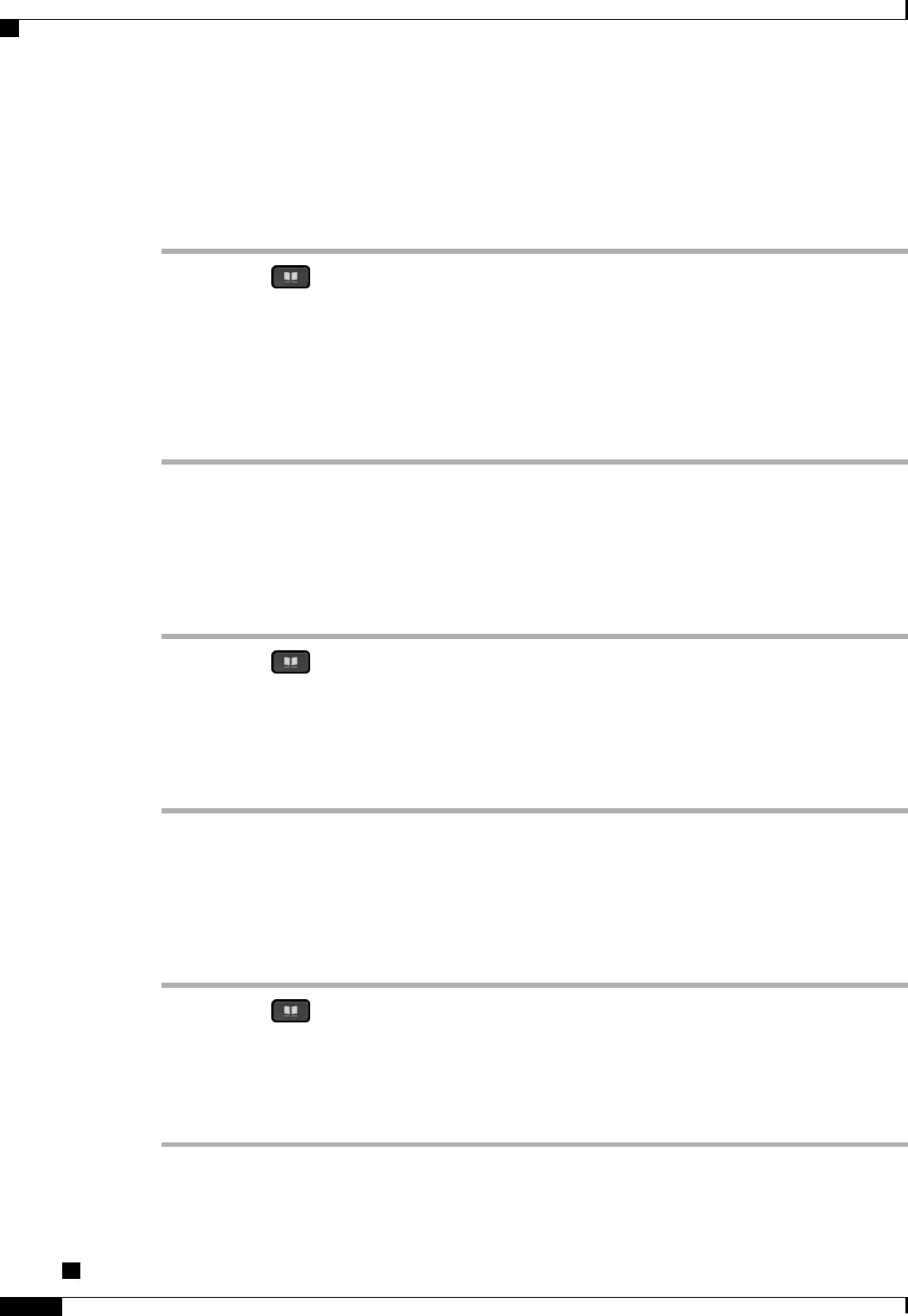
Assign a Fast Dial Code to a Personal Directory Entry
Procedure
Step 1 Press Contacts .
Step 2 Select Personal Directory.
Step 3 Select Personal Address Book.
Step 4 Enter the name and press Submit.
Step 5 Press Select and then press FastDial.
Step 6 Select a number and press Select.
Step 7 Scroll to an unassigned fast-dial index and press Submit.
Place a Call Using a Fast Dial Code
Procedure
Step 1 Press Contacts .
Step 2 Sign in to Personal Directory.
Step 3 Select Personal Fast Dials and scroll to a fast-dial code.
To get more fast-dial codes, press
Next.
Note
Step 4 Select the required fast-dial code and press Call.
Delete a Fast Dial Code
Procedure
Step 1 Press Contacts .
Step 2 Sign in to the Personal Directory.
Step 3 Select Personal Fast Dials and search for a fast-dial code.
Step 4 Select the required code and press Remove.
Step 5 Select the index and press Remove.
Cisco IP Phone 8811, 8841, 8845, 8851, 8851NR, 8861, and 8865 User Guide for Cisco Unified Communications
Manager 11.0
60
Contacts
Assign a Fast Dial Code to a Personal Directory Entry
REVIEW DRAFT - CISCO CONFIDENTIAL
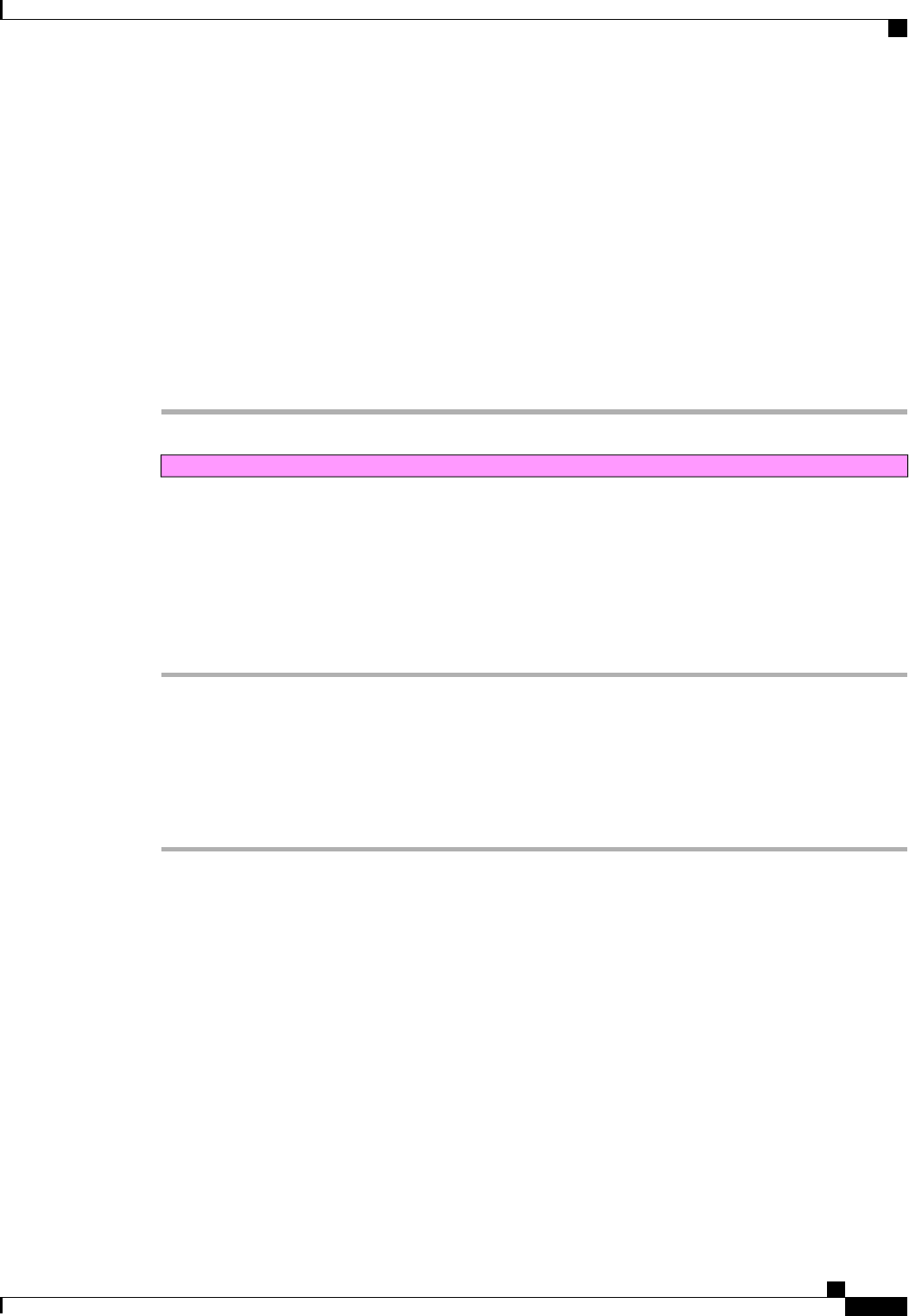
Cisco WebDialer
Cisco WebDialer allows you to make calls on your Cisco IP Phone to directory contacts by selecting items
in a web browser.
For more information, contact your system administrator.
Use Cisco WebDialer with Another Online Corporate Directory
Procedure
Step 1
Draft comment: Once the engineering team provides the information, the correct access details will be added.
In a web browser, type the address of the Cisco WebDialer-enabled page.
Step 2 Search for the required name and select the required number.
Step 3 When prompted, enter your user ID and password.
If you are using Cisco WebDialer for the first time, review preferences on the Make Call window.Note
Step 4 Select Call.
Step 5 Select Hang up or hang up the handset after your call completes.
Change Cisco WebDialer Preferences
Procedure
Step 1 Initiate a call using Cisco WebDialer to access the Make Call window.
Step 2 Select one of the following options from the Make Call window:
•Preferred language
•Preferred device
Step 3 Choose a line or a phone.
If you have one phone with a single line, the appropriate phone and line are automatically selected.
If you have more than one phone of the same type, the list identifies the phone by device type and
MAC address. To display the MAC address on your phone, select Applications >Phone Information.
Note
Step 4 If you have an Extension Mobility profile, select Extension Mobility from the Calling Device drop-down
menu.
Step 5 Ensure that you do not select Do not display call information nor Disable Auto Close.
Cisco IP Phone 8811, 8841, 8845, 8851, 8851NR, 8861, and 8865 User Guide for Cisco Unified Communications Manager
11.0
61
Contacts
Cisco WebDialer
REVIEW DRAFT - CISCO CONFIDENTIAL

If you select Do not display call information, the Make Call Window is not displayed when you
next use the phone. If you select Disable auto close, the call window does not automatically close
after 15 seconds.
Note
Sign Out of Cisco WebDialer
Procedure
Step 1 Access the Make Call or Hang Up window.
Step 2 Select Sign Out.
Cisco IP Phone 8811, 8841, 8845, 8851, 8851NR, 8861, and 8865 User Guide for Cisco Unified Communications
Manager 11.0
62
Contacts
Sign Out of Cisco WebDialer
REVIEW DRAFT - CISCO CONFIDENTIAL

CHAPTER 5
Call History
•Call History Overview, page 63
•View the Call History, page 65
•View Call Record Details, page 65
•Filter the Call History, page 65
•Dial From the Call History, page 66
•Edit a Phone Number, page 66
•Clear the Call History, page 67
•Delete a Call Record, page 67
Call History Overview
Call History allows you to view information about the last 150 calls on your phone. The Call History lists
individual calls and call groups chronologically from the most recent call to the oldest one. If your phone has
multiple lines, calls on all lines are added together. The oldest calls over the 150-call limit are dropped from
the history.
In the Call History screen, the line information (such as “Line: 5623”) displays in the upper-right corner to
indicate the line name or number for which the call history is displayed.
If set up by your administrator, you see icons beside each Call History entry. The icon shows the status
(Unknown, Idle, Busy, or DND) of the person who made the call.
For each call record or call group, an icon to the left of the caller ID shows the call type:
•Received:
•Placed:
•Missed:
Cisco IP Phone 8811, 8841, 8845, 8851, 8851NR, 8861, and 8865 User Guide for Cisco Unified Communications Manager
11.0
63
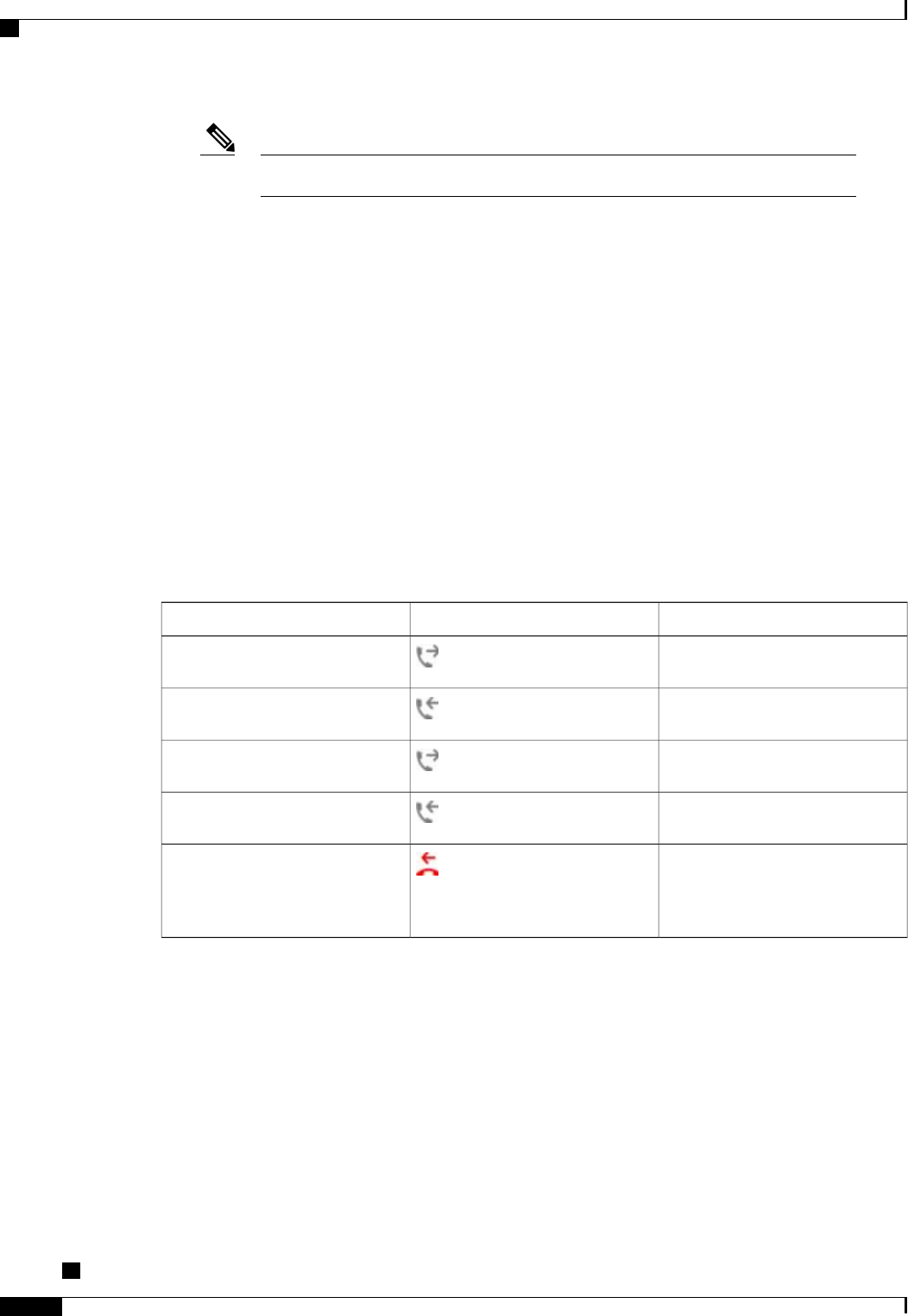
On the Cisco IP Phone 8811, the icon is gray.Note
If the caller ID is unavailable, “Unknown”is displayed, and the phone number is listed.
Calls for the same caller ID and phone number are grouped together only when if they occur in chronological
order and do not have calls associated. For each group, the time of the latest call and the number of calls (such
as “(3)”) are displayed:
•Incoming (Received) and outgoing (Placed) calls are grouped together.
•Missed calls are grouped together in a separate group.
For each individual call record or call group, the phone number is listed in blue and is contact sensitive for
touch dialing.
Hunt group and multiparty calls show an icon to the right of the caller ID that differentiates the call from a
normal call, and these calls are not grouped even when they are next to each other in the list.
A plus (+) symbol on entries in call history, redial, or call directory indicates that your phone is set up to list
international calls. For more information, contact your system administrator.
The received and placed calls from shared lines are logged in the Call History. To view all the call history
logs, open the Call History screen. The following table describes the call state, icon, and tag for shared lines.
TagCall IconCall State
Placed
Locally placed calls
ReceivedLocally received calls
Remote PlacedRemotely placed calls
Remote ReceivedRemotely received calls
Missed
On the Cisco IP Phone
8811, the icon is gray.
Note
Missed calls
Your Call History list displays the status of monitored lines, if the feature is enabled by your system
administrator. Each call history item in the Call History lists displays an icon to identify the state of the line.
The following states are available:
•Offline
•Idle
•Busy
•DND
Cisco IP Phone 8811, 8841, 8845, 8851, 8851NR, 8861, and 8865 User Guide for Cisco Unified Communications
Manager 11.0
64
Call History
Call History Overview
REVIEW DRAFT - CISCO CONFIDENTIAL

View the Call History
Procedure
Step 1 Press Applications .
Step 2 Select Recents.
Step 3 Scroll and select a call record or call group.
Step 4 Press Exit to return to the Applications screen.
View Call Record Details
Procedure
Step 1 If you are on a connected call, press Show Detail to show the Call Details screen. This screen displays single
call information and call duration and updates each second.
Step 2 If you are not on a connected call, follow the steps below.
a) Press Applications and select Recents.
b) Select a call record or group and press Show Detail.
When you are on a call record, you can keep the Navigation cluster and Select button highlighted
to display the call details.
Note
c) Press Return to return to the Call History screen.
d) Press Exit to return to the Applications screen.
Filter the Call History
Procedure
Step 1 Press Applications and select Recents.
Step 2 To sort calls for a specific line, select the required phone line and view the individual calls.
Step 3 To sort by missed calls for a specific line, select the required phone line press Missed Calls.
Step 4 Press Exit to return to the Applications screen.
Cisco IP Phone 8811, 8841, 8845, 8851, 8851NR, 8861, and 8865 User Guide for Cisco Unified Communications Manager
11.0
65
Call History
View the Call History
REVIEW DRAFT - CISCO CONFIDENTIAL

Dial From the Call History
Procedure
Step 1 If the phone is not in idle state, perform the following steps:
a) Press Applications and select Recents.
b) Select the call record that you want to dial and perform one of the following:
•Press Call.
•Pick up the handset.
•Press Details.
•Press Speakerphone or Headset .
Step 2 If the phone is in idle state, press down on the Navigation cluster and Select button to display the On-Hook
Dialing screen.
Edit a Phone Number
Procedure
Step 1 Press Applications and select Recents.
Step 2 Press All Lines or the required line.
Step 3 Select the call you want to edit and press EditDial.
Press the Navigation pad right or left to move the
cursor.
Press to delete the character to the left of the cursor.
Note
Step 4 Press Call to dial the number.
Step 5 Press Return to return to the Call History list.
Cisco IP Phone 8811, 8841, 8845, 8851, 8851NR, 8861, and 8865 User Guide for Cisco Unified Communications
Manager 11.0
66
Call History
Dial From the Call History
REVIEW DRAFT - CISCO CONFIDENTIAL

Clear the Call History
Procedure
Step 1 Press Applications and select Recents.
Step 2 Select All Lines or the required line.
Step 3 Press Clear list and then press Delete to delete the call history list.
Step 4 Press Cancel to go back to the Call History screen.
Delete a Call Record
Procedure
Step 1 Press Applications and select Recents.
Step 2 Highlight the individual call record or call group that you want to delete.
Step 3 Press Delete to delete an individual call record or all calls in a group.
A Delete Record alert message appears for verification.
Step 4 Press Delete to delete the record.
Step 5 Press Exit to return to the Applications screen.
Cisco IP Phone 8811, 8841, 8845, 8851, 8851NR, 8861, and 8865 User Guide for Cisco Unified Communications Manager
11.0
67
Call History
Clear the Call History
REVIEW DRAFT - CISCO CONFIDENTIAL

Cisco IP Phone 8811, 8841, 8845, 8851, 8851NR, 8861, and 8865 User Guide for Cisco Unified Communications
Manager 11.0
68
Call History
Delete a Call Record
REVIEW DRAFT - CISCO CONFIDENTIAL

CHAPTER 6
Voicemail
•Access Voicemail, page 69
•Check for Voice Messages, page 69
•Listen to Voice Messages, page 70
•Visual Voicemail, page 70
Access Voicemail
Procedure
Step 1 Press Messages.
Step 2 Follow the voice prompts.
Check for Voice Messages
Procedure
Check for voice messages in any of these ways:
•Look for a solid red light on your handset.
You can set up the visual message waiting lamp using the Self Care Portal.
•Look for a colored box beside the line button.
The colored background indicates that there are new voice messages and the number of missed calls
and voice mail messages displays in the box.
On the Cisco IP Phone 8811, the box is
gray.
Note
Cisco IP Phone 8811, 8841, 8845, 8851, 8851NR, 8861, and 8865 User Guide for Cisco Unified Communications Manager
11.0
69
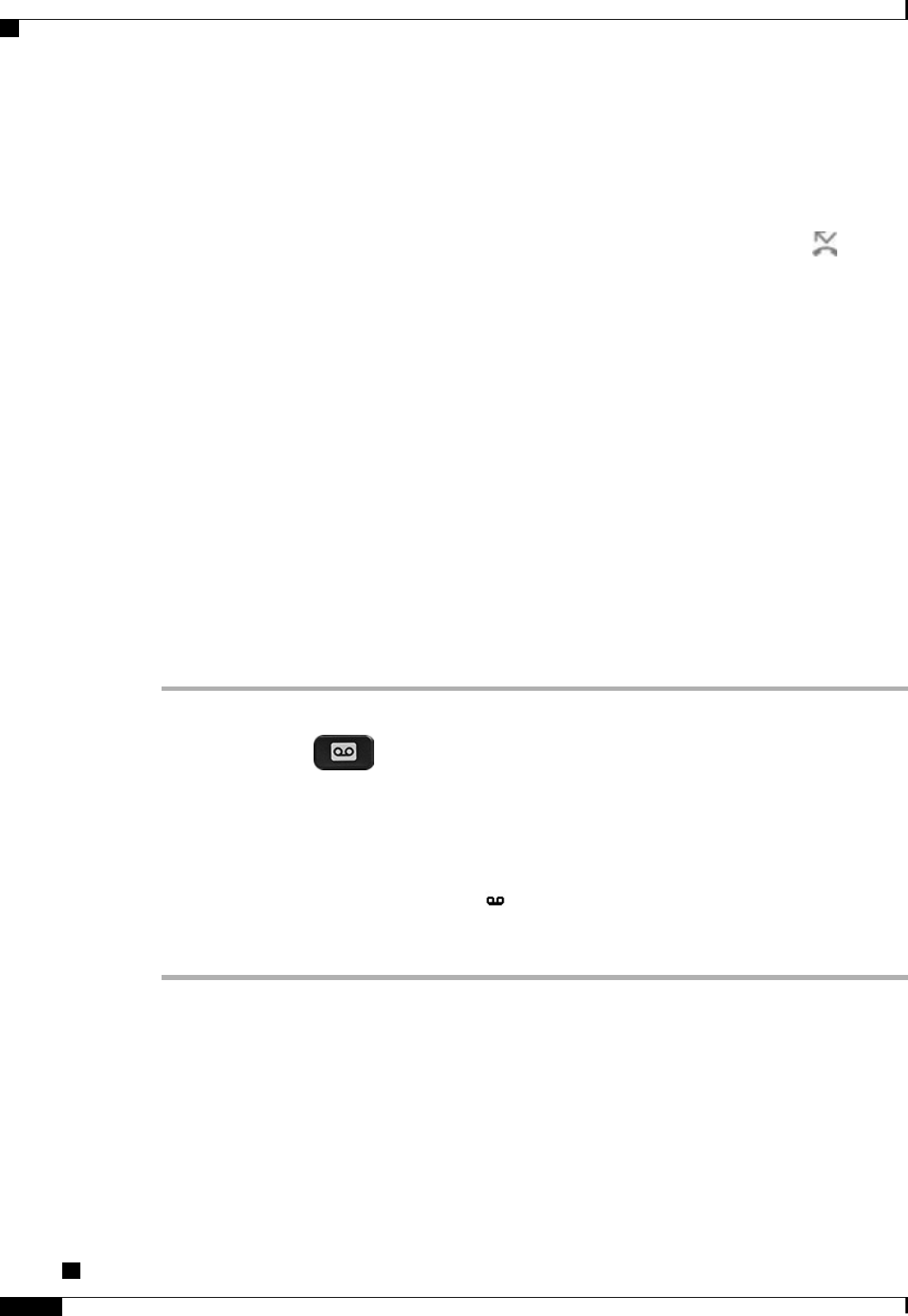
When you select a line with a Message icon, the Login screen displays on the phone screen.
If you had selected Yes in the Remember me screen when you last logged in, the messages list
is displayed.
Note
If there are more than 99 new voice messages, the message count is replaced by a plus (+) sign.
If call forwarding is set up on a line that has new voice messages, the Call Forward icon replaces
the Message icon on the line label.
On the Cisco IP Phone 8811, the Call Forward icon is
gray.
Note
•Listen for a stutter tone (if available) from your handset, headset, or speakerphone when you place a
call.
The stutter tone is line-specific. You hear it only when using the line that has new voice messages.
You can set up audible message waiting tones using the Self Care Portal.
Listen to Voice Messages
After you listen to your new voice messages, the message indicators are updated on the phone screen. If there
are no new voice messages, the Message icon is removed from the line label, and the Voicemail icon is
removed from the right side of the phone screen.
Procedure
Step 1 To listen to voice messages, do one of the following:
•
Press Messages . The Login screen displays.
If you selected Yes in the Remember me screen when you last logged in, the messages list
displays.
Note
•Select a line with colored box beside it. The box indicates the number of messages waiting.
The Cisco IP Phone 8881 displays a gray box.
•Press the line button and then Voicemail .
Step 2 Follow the prompts to listen to your voice message.
Visual Voicemail
Visual Voicemail is an alternative to audio voicemail. You use the screen on your phone to work with your
messages, rather than respond to audio prompts. You can view a list of your messages and play your messages.
You can also compose, reply to, forward, and delete messages.
Cisco IP Phone 8811, 8841, 8845, 8851, 8851NR, 8861, and 8865 User Guide for Cisco Unified Communications
Manager 11.0
70
Voicemail
Listen to Voice Messages
REVIEW DRAFT - CISCO CONFIDENTIAL

For more information, see Quick Start Guide for Visual Voicemail at http://www.cisco.com/c/en/us/support/
unified-communications/unity-connection/products-user-guide-list.html.
Cisco IP Phone 8811, 8841, 8845, 8851, 8851NR, 8861, and 8865 User Guide for Cisco Unified Communications Manager
11.0
71
Voicemail
Visual Voicemail
REVIEW DRAFT - CISCO CONFIDENTIAL

Cisco IP Phone 8811, 8841, 8845, 8851, 8851NR, 8861, and 8865 User Guide for Cisco Unified Communications
Manager 11.0
72
Voicemail
Visual Voicemail
REVIEW DRAFT - CISCO CONFIDENTIAL

CHAPTER 7
Advanced Calling Features
•Conference, page 73
•Meet Me Conference, page 75
•Speed Dial, page 76
•Do Not Disturb, page 78
•Malicious Call Identification, page 79
•Extension Mobility, page 79
•Mobile Connect, page 80
•Line Status, page 82
•Custom Line Filters, page 83
•Hunt Groups, page 86
•Barge , page 87
•Call Chaperone, page 88
•Uniform Resource Identifier Dialing, page 89
•Intelligent Proximity for Mobile Devices, page 90
•Intelligent Proximity for Tablets, page 94
Conference
Conference allows you to talk simultaneously with multiple parties in an ad hoc meeting.
When you are talking on a call, use Conference to dial another party and add them to the call.
If you have multiple phone lines, you can alternately use Conference to combine two calls across two lines.
For example, if you have a call on Line 1 and a call on Line 2, you can combine the calls into a conference.
As the conference host, you can remove individual participants from the conference. The conference ends
when all participants hang up.
Cisco IP Phone 8811, 8841, 8845, 8851, 8851NR, 8861, and 8865 User Guide for Cisco Unified Communications Manager
11.0
73

Add a Third Party to a Conference
Procedure
Step 1 Start with a connected call that is not on hold.
Step 2 Press Conference and do one of the following:
•Enter the phone number for the party you want to add and press Call.
•Press a speed-dial button.
•Press Speed Dial, enter a speed-dial number, and press Speed Dial again.
•Press Active Calls and select a call.
•Select a call from the Call History.
Step 3 Wait for the party to answer or skip to step 4 while the call is ringing.
Step 4 Press Conference.
The conference begins.
Join Calls Into a Conference
The conference is established on the line that had the active call.
Your system administrator controls the ability to transfer calls from one line to another line.
Procedure
Step 1 Start with two connected calls.
Step 2 Make sure that one of the calls is active (not on hold). If both calls are on hold, resume one call.
Step 3 Press Conference .
Step 4 Press the line button for the other (held) call or if the held call is on another line:
a) Press Active Calls.
b) Choose a call from the list.
c) Press Conference.
The conference begins. The conference is established on the line that had the active call.
Swap Between Calls Before Completing a Conference
You can consult privately with the conference and another person, before adding the person into the conference.
Cisco IP Phone 8811, 8841, 8845, 8851, 8851NR, 8861, and 8865 User Guide for Cisco Unified Communications
Manager 11.0
74
Advanced Calling Features
Add a Third Party to a Conference
REVIEW DRAFT - CISCO CONFIDENTIAL

Procedure
Step 1 Call a new conference participant, but do not add the participant to the conference.
You must wait until the call is connected.
Step 2 Press Swap to toggle between the participant and the conference.
View Conference Participants
You can view the details of the last 16 participants who joined the conference.
Procedure
While in a conference, press Show Details to view a list of participants.
When you place a call to another party and the person that you called creates a conference with a
third phone, the Show Details softkey displays only for the person who created the conference.
Note
Remove Conference Participants
Procedure
Step 1 While in a conference, press Show Details.
Step 2 Highlight the participant that you want to remove, then press Remove.
Meet Me Conference
Meet Me allows you to call a predetermined number at a scheduled time to host or join a Meet Me conference.
The Meet Me conference begins when the host connects. Participants who call the conference before the host
has joined hear a busy tone and must dial again.
The conference ends when all participants hang up; the conference does not automatically end when the host
disconnects.
Cisco IP Phone 8811, 8841, 8845, 8851, 8851NR, 8861, and 8865 User Guide for Cisco Unified Communications Manager
11.0
75
Advanced Calling Features
View Conference Participants
REVIEW DRAFT - CISCO CONFIDENTIAL

Host a Meet Me Conference
Procedure
Step 1 Obtain a Meet Me phone number from your system administrator.
Step 2 Distribute the Meet Me phone number to participants.
Step 3 When you are ready to start the meeting, lift the handset to get a dial tone and press Meet Me.
Step 4 Dial the Meet Me phone number.
Join a Meet Me Conference
Procedure
Step 1 Dial the Meet Me phone number that the conference host provides.
Step 2 If you hear a busy tone, the host has not yet joined the conference. In this case, hang up and try your call
again.
Speed Dial
Speed Dial allows you to press a button and enter a preset code to place a call. Before you can use Speed Dial
features on your phone, you must set up speed-dial in the Self Care Portal.
Depending on setup, your phone can support these Speed Dial features:
•Speed-dial buttons: Allow you to quickly dial a phone number from one or more line buttons set up for
speed dialing.
If your system administrator has set up the Line Status feature, you can monitor the status of a speed-dial
line by using the line status indicators.
•Speed-dial codes: Allow you to dial a phone number from a code (sometimes referred to as abbreviated
dialing).
You can use also use Speed Dial to reach telephone numbers that require a Forced Authorization Code (FAC),
Client Matter Code (CMC), or additional digits (such as a user extension, a meeting access code, or a voicemail
password). These numbers usually require you to input pause characters in the digit string.
Related Topics
Pause in Speed Dial, on page 77
Cisco IP Phone 8811, 8841, 8845, 8851, 8851NR, 8861, and 8865 User Guide for Cisco Unified Communications
Manager 11.0
76
Advanced Calling Features
Host a Meet Me Conference
REVIEW DRAFT - CISCO CONFIDENTIAL

Place a Call with a Speed-Dial Button
Before You Begin
Before you can use speed-dial buttons on your phone, you must set up Speed Dial in the Self Care Portal.
Procedure
To place a call, press a speed-dial button on the left side of your phone.
Use a Speed-Dial Code On Hook
Before You Begin
Before you can use speed-dial codes on your phone, you must set up Speed Dial in the Self Care Portal.
Procedure
Enter the speed-dial code and press Speed Dial.
Use a Speed-Dial Code Off Hook
Before You Begin
Before you can use speed-dial codes on your phone, you must set up Speed Dial in the Self Care Portal.
Procedure
Step 1 Lift the handset and press Speed Dial.
Step 2 Enter the speed-dial code and press Speed Dial again to complete the call.
Pause in Speed Dial
You can use Speed Dial to reach destinations that require a Forced Authorization Code (FAC), Client Matter
Code (CMC), dialing pauses, or additional digits (such as a user extension, a meeting access code, or a voice
mail password). When you press the configured Speed Dial, the phone establishes the call to the destination
number and sends the specified FAC, CMC, and additional digits with dialing pauses inserted.
To include dialing pauses in the speed dial, include a comma (,) as part of the speed-dial string. This comma
specifies a pause of 2 seconds. It also allows you to separate FAC and CMC from the other digits in the
speed-dial string.
Cisco IP Phone 8811, 8841, 8845, 8851, 8851NR, 8861, and 8865 User Guide for Cisco Unified Communications Manager
11.0
77
Advanced Calling Features
Place a Call with a Speed-Dial Button
REVIEW DRAFT - CISCO CONFIDENTIAL

Be aware of the following requirements when you include FAC and CMC in the speed-dial string:Note
•FAC must always precede CMC in the speed-dial string.
•A speed-dial label is required for speed dials with FAC and DTMF digits.
•Only one comma is allowed between FAC and CMC digits in the string.
Each comma you include represents an additional pause of 2 seconds. For example, two commas (,,) represent
a pause of 4 seconds.
Before you configure the speed-dial, try to dial the specified digits manually at least once to ensure that
the digit sequence is correct.
Note
The phone does not save the FAC, CMC, or additional digits from the speed dial in the call history. If you
press Redial after connecting to a destination using the speed-dial, the phone prompts you to enter any required
FAC, CMC, or DTMF digits manually.
Example 1
Consider the following requirements to access voicemail:
•Called number to access voicemail: 8000
•PIN: 123456# after announcement of 2 seconds
•Voicemail response: Enter option 3 to read latest message after a pause of 6 seconds (while the automated
announcement lists the available options)
To set up the speed-dial to access this voice mailbox, specify the following speed-dial string:
8000,123456#,,,3
Example 2
Consider the following call requirements
•Called number: 95556543
•FAC: 1234
•CMC: 9876
•Automated phone system response, required 4 seconds after the call is connected: 56789#
To access this destination, specify the following speed-dial string:
95556543,1234,9876,,56789#
Do Not Disturb
Do Not Disturb (DND) allows you to turn off one of the following incoming call indicators:
Cisco IP Phone 8811, 8841, 8845, 8851, 8851NR, 8861, and 8865 User Guide for Cisco Unified Communications
Manager 11.0
78
Advanced Calling Features
Do Not Disturb
REVIEW DRAFT - CISCO CONFIDENTIAL

•The ringer on your phone
•The ringer and any visual notification that you have an incoming call
When DND is enabled, your incoming calls forward to another number, such as your voicemail, if it is set up
and the call is not saved or listed in your Call History.
The DND feature affects all lines on a phone. The feature does not affect intercom or 911 calls.
You can change your DND options from the Self Care Portal. For information on customizing your Do Not
Disturb options, see the Cisco Unified Communications Self Care Portal User Guide, located at http://
www.cisco.com/en/US/products/sw/voicesw/ps556/products_user_guide_list.html.
Turn DND On and Off
Procedure
Step 1 Press DND to turn on DND.
Visual confirmation displays briefly.
Step 2 Press DND again to turn off DND.
Visual confirmation displays briefly.
Malicious Call Identification
Malicious Call Identification (MCID) allows you to identify an active call as suspicious, which initiates a
series of automated tracking and notification messages.
Trace a Suspicious Call
Procedure
Press Report Caller to send a silent notification message to your system administrator.
When the silent notification message is sent, your phone provides both a visual and audible confirmation.
Extension Mobility
Cisco Extension Mobility (EM) allows you to configure a different Cisco IP Phone as your own temporarily.
After you sign in to EM, the phone adopts your user profile, including your phone lines, features, established
services, and web-based settings. Your system administrator sets up EM for you.
The Cisco Extension Mobility ChangePIN feature allows you to change your PIN from your Cisco IP Phone.
Cisco IP Phone 8811, 8841, 8845, 8851, 8851NR, 8861, and 8865 User Guide for Cisco Unified Communications Manager
11.0
79
Advanced Calling Features
Turn DND On and Off
REVIEW DRAFT - CISCO CONFIDENTIAL

Enable Extension Mobility
Procedure
Step 1 Press Applications .
Step 2 Select Extension Mobility (name can vary, including EM Service).
Step 3 Enter your user ID and PIN (provided by your system administrator).
Step 4 Select a device profile if prompted.
Step 5 Press Applications to sign out.
Step 6 Select Services.
Step 7 Select Extension Mobility.
Step 8 Press Yes when prompted to sign out.
Mobile Connect
Mobile Connect allows you to use your mobile phone to handle calls that are associated with your desk phone
number.
When using Cisco Mobile Connect, you must add your mobile and other phones that you want to use to make
and receive calls using the same directory numbers as your desk phone. These phones are called remote
destinations. You can also define access lists to restrict or allow calls from certain numbers to be sent to your
mobile phone.
When you enable Mobile Connect:
•Your desk phone and remote destinations (your mobile phones) receive calls simultaneously.
•When you answer the call on your desk phone, the remote destinations stop ringing, are disconnected,
and display a missed call message.
•When you answer the call on one remote destination, the other remote destinations and desk phone stop
ringing and are disconnected, and a missed call message is shown on the other remote destinations.
•When you answer the call on one remote destination and then switch the call to a Cisco Unified device
that shares lines, the Cisco Unified devices that share the same line display a Remote In Use message.
Cisco IP Phone 8811, 8841, 8845, 8851, 8851NR, 8861, and 8865 User Guide for Cisco Unified Communications
Manager 11.0
80
Advanced Calling Features
Enable Extension Mobility
REVIEW DRAFT - CISCO CONFIDENTIAL

Enable Mobile Connect
Procedure
Step 1 Press Mobility to display the current remote destination status (Enabled or Disabled).
Step 2 Press Select to change the status.
Turn Mobile Connect On or Off for All Remote Destinations from a Desk Phone
Procedure
Step 1 Press Mobility or To Mobile to display the current remote destination status (Enabled or Disabled).
Step 2 Press Select to change the status.
Switch a Desk Phone Call to a Mobile Phone
Procedure
Step 1 Press Mobility.
Step 2 Press Select to send a call to mobile phone.
Step 3 Answer the in-progress call on your mobile phone.
You cannot use the same phone line for any other calls, but if your desk phone supports multiple
lines, you can use another line to make or receive calls.
Note
Switch a Mobile Call to the Desk Phone
Procedure
Step 1 Hang up the call on your mobile phone to disconnect the mobile phone, but not the call.
Step 2 Press the line on your desk phone to resume the call on your desk phone within 5 to 10 seconds and start
talking on the desk phone.
Cisco IP Phone 8811, 8841, 8845, 8851, 8851NR, 8861, and 8865 User Guide for Cisco Unified Communications Manager
11.0
81
Advanced Calling Features
Enable Mobile Connect
REVIEW DRAFT - CISCO CONFIDENTIAL
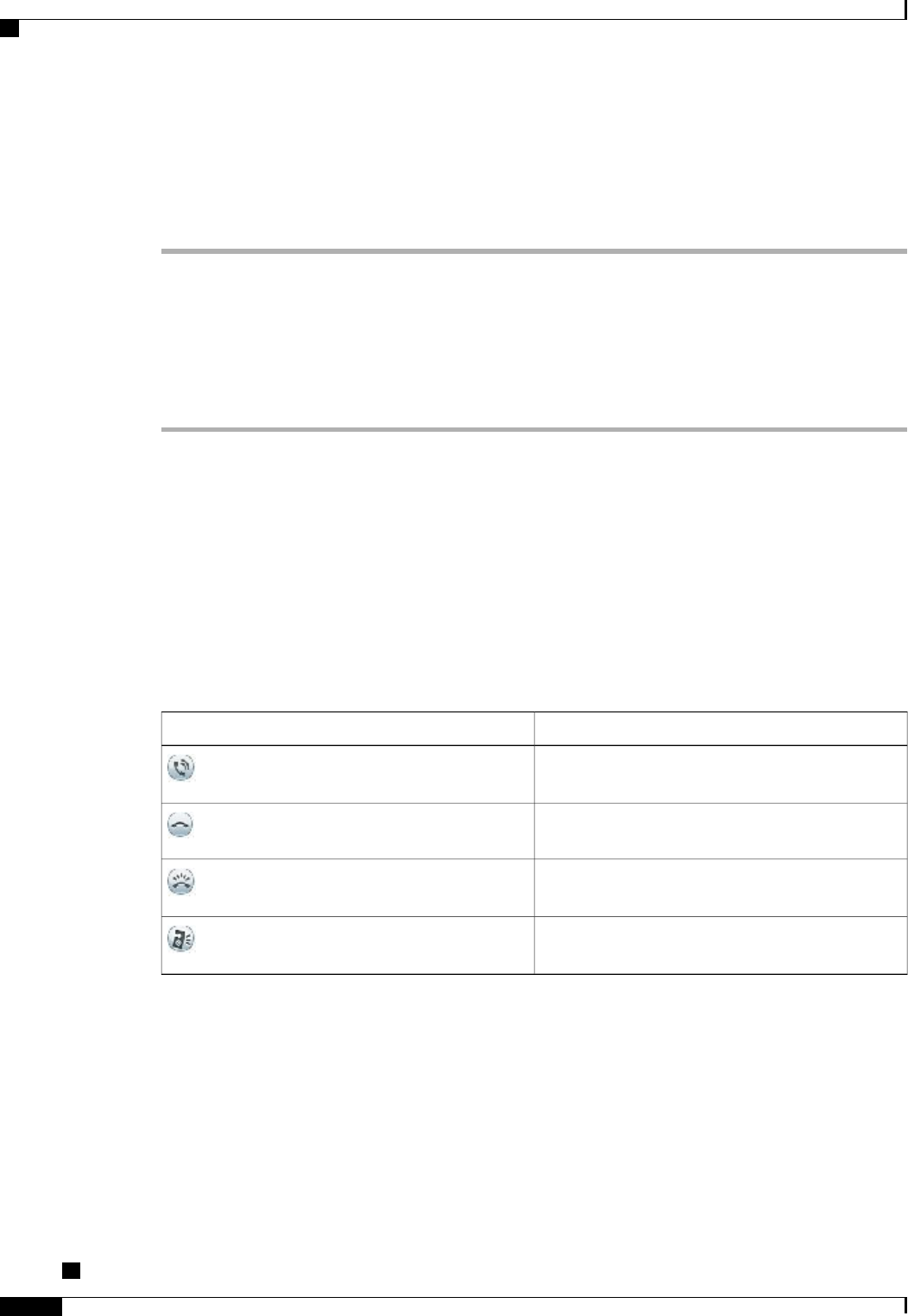
Hand Off a Call from a Mobile Phone to the Desk Phone
Procedure
Step 1 While on your mobile phone, enter the access code for the hand off feature.
For more information, contact your system administrator.
Step 2 Hang up the call on your mobile phone to disconnect the mobile phone, but not the call.
Step 3 Press Answer on your desk phone within 10 seconds and start talking on the desk phone.
For more information, contact your system administrator. The Cisco Unified devices that share the same line
display a Remote In Use message.
Line Status
Line Status indicators allow you to view the state of a phone line that is associated with a speed-dial button.
Your system administrator sets up Line Status indicators on your phone.
Line Status Indicators
Line Status indicators show the state of a line.
IndicatorIcon
Line is in use.
Line is idle.
Line is ringing. (Only for Call Pickup.)
Line is in a Do Not Disturb (DND) state.
Line Status indicators can be set up on speed-dial buttons by your system administrator and can be used with
these features:
Speed Dial
Allows you to monitor the status of (and dial) a specific number on a speed-dial button. If the monitored
line is unavailable, the Line Status button changes to a normal speed-dial button.
Cisco IP Phone 8811, 8841, 8845, 8851, 8851NR, 8861, and 8865 User Guide for Cisco Unified Communications
Manager 11.0
82
Advanced Calling Features
Hand Off a Call from a Mobile Phone to the Desk Phone
REVIEW DRAFT - CISCO CONFIDENTIAL

Directed Call Park
Allows you to monitor the line status of and dial a Directed Call Park number on a speed-dial button.
Call Pickup
Allows you to monitor the line status of (and pick up a ringing call on) a ringing call on a
speed-dial button.
Your system administrator can also set up your phone to play an audible alert when a call rings on the monitored
line.
Related Topics
Call Park, on page 47
Speed Dial, on page 76
Custom Line Filters
Custom Line Filters enable you to reduce alert activity by filtering it to high-priority lines by allowing you
to set the alerting call notification priority on a subset of lines covered by an alert filter. The custom filter
generates either traditional pop-up alerts or actionable alerts for incoming calls on the selected lines. For each
filter, only the subset of lines under coverage will generate an alert. If a filter is turned off, lines under its
coverage will not show alert notifications.
If this feature has been configured, there are three, selectable, filter types available to you:
•All Calls (on all lines)
•Daily schedule
•Custom user
The administrator configures the default line filter, which is visible to you as the Daily schedule filter. Even
if the administrator has not configured the default filter, the all calls filter and custom filter options are available
to you. If you have not created any custom filters all provisioned lines are covered by the default line filter if
it exists, or all calls if it does not.
You cannot edit either the All Calls filter or the Daily schedule filter, but you can use the Daily schedule filter
as a template for a new, custom filter by duplicating and then editing the duplicate filter.
You save the custom filters directly to your phone so that you can quickly select and change coverage. You
can define a maximum of 20 custom filters, but only one filter may be active at a time.
If both the Custom Line Filters and the Actionable Incoming Call Alert features are enabled, actionable
call alerts apply only to the lines that are covered by filters.
Note
Cisco IP Phone 8811, 8841, 8845, 8851, 8851NR, 8861, and 8865 User Guide for Cisco Unified Communications Manager
11.0
83
Advanced Calling Features
Custom Line Filters
REVIEW DRAFT - CISCO CONFIDENTIAL

Add a Line Filter
Procedure
Step 1 On your phone, go to Applications >Settings.
Step 2 Highlight Call notifications, and press Select.
The current filter displays next to the option.
Step 3 Highlight Add new filter and press Select.
The maximum number of custom filters is 20. If you have already created the maximum number of custom
filters, delete a filter before continuing with this procedure.
Step 4 Press Select a second time to make the text editable.
The Show incoming call notification for selected lines screen with available phone lines displays.
Step 5 Accept the default name for the new filter, or enter a new one.
Step 6 Select the lines to add to the new filter.
All available lines are displayed in the list. If you require a line that is not in the list, contact your administrator.
Step 7 Click Apply.
Step 8 To view the filter, press Back.
Select an Active Line Filter
Procedure
Step 1 On your phone, select Applications >Settings.
Step 2 Highlight Call notifications, and press Select.
The currently available filter options display.
Step 3 Highlight the filter to apply and press Select.
Delete a Line Filter
Procedure
Step 1 On your phone, go to Applications >Settings.
Step 2 Highlight Call notifications, and press Select.
Step 3 Highlight the filter to be deleted and press Delete.
Cisco IP Phone 8811, 8841, 8845, 8851, 8851NR, 8861, and 8865 User Guide for Cisco Unified Communications
Manager 11.0
84
Advanced Calling Features
Add a Line Filter
REVIEW DRAFT - CISCO CONFIDENTIAL

The filter is deleted and no longer appears in the list of filters.
Duplicate a Line Filter
Procedure
Step 1 On your phone, go to Applications >Settings.
Step 2 Highlight Call notifications, and press Select.
Step 3 Highlight the filter to be duplicated and press Duplicate.
Step 4 Highlight the duplicated filter and press Edit.
Step 5 (Optional) Enter a new name for the filter.
Step 6 Add or remove available lines from the filter.
Step 7 Click Apply.
Step 8 To view the filter, press Back.
Edit a Line Filter
Procedure
Step 1 On your phone, go to Applications >Settings.
Step 2 Highlight Call notifications, and press Select.
Step 3 Highlight the filter to be edited and press Edit.
You cannot edit the Daily schedule filter. For more information, contact your administrator.Note
Step 4 (Optional) Enter a new name for the filter.
Step 5 Add or remove available lines from the filter.
Step 6 Click Apply.
Step 7 To view the filter, press Back.
Cisco IP Phone 8811, 8841, 8845, 8851, 8851NR, 8861, and 8865 User Guide for Cisco Unified Communications Manager
11.0
85
Advanced Calling Features
Duplicate a Line Filter
REVIEW DRAFT - CISCO CONFIDENTIAL

Rename a Line Filter
Procedure
Step 1 On your phone, go to Applications >Settings.
Step 2 Highlight Call notifications, and press Select.
Step 3 Highlight the filter to be renamed and press Edit.
Step 4 Enter a new name for the filter.
Step 5 Click Apply.
Step 6 To view the filter, press Back.
Hunt Groups
Hunt Groups are used to share the call load in organizations that receive a large number of incoming calls.
Your system administrator sets up a hunt group with a series of directory numbers. When the first directory
number in the hunt group is busy, the system hunts for the next available directory number in the group and
directs the call to that phone.
If you are a member of a hunt group, you sign in to a hunt group when you want to receive calls, and you sign
out of the group when you want to prevent calls from ringing on your phone.
Your administrator sets up the Queue Status button so that you can view statistics about the queue for the
hunt group.
Calls in the group call queue display the same call identification number, no matter which group phone accesses
the list.
Sign In and Out of a Hunt Group
Signing out of a hunt group does not prevent direct calls from ringing your phone.
Procedure
Step 1 Press Hunt Group to sign in.
Visual confirmation displays briefly.
Step 2 Press Hunt Group again to sign out.
Cisco IP Phone 8811, 8841, 8845, 8851, 8851NR, 8861, and 8865 User Guide for Cisco Unified Communications
Manager 11.0
86
Advanced Calling Features
Rename a Line Filter
REVIEW DRAFT - CISCO CONFIDENTIAL

Display Queue Statistics
Use the queue statistics to check the status of the hunt group queue.
Procedure
Step 1 Press Queue Status.
The Queue status window appears.
Step 2 To refresh the statistics, press Update.
Step 3 To exit, press Exit.
Barge
Barge allow you to add yourself to nonprivate calls on a shared line. You access the Barge function using the
Merge softkey. A conference call is set up with yourself and the participants of the nonprivate call on the
Cisco Unified Communications Manager.
Set Up Barge Alert
By default, the Barge Alert option is set to Off and you can barge into an eligible shared lined without receiving
a prompt. When the Barge Alert is set to On, an alert prompt is displayed.
Procedure
Step 1 On your phone, go to Applications >Settings.
Step 2 At the Barge Alert menu item, click On to enable the alert or Off to enable Barge.
By default, the barge alert prompt is toggled Off.
Add Yourself to a Call on a Shared Line
Procedure
Press the line button for the shared line.
Enable Privacy on a Shared Line
Privacy allows you to prevent others who share your line from seeing information about your calls.
Cisco IP Phone 8811, 8841, 8845, 8851, 8851NR, 8861, and 8865 User Guide for Cisco Unified Communications Manager
11.0
87
Advanced Calling Features
Display Queue Statistics
REVIEW DRAFT - CISCO CONFIDENTIAL

Privacy applies to all shared lines on your phone. If you have multiple shared lines and Privacy is enabled,
others cannot view any of your shared lines.
If the phone that shares your line has Privacy enabled, you can make and receive calls using the shared line
as usual.
Procedure
Step 1 Press Privacy to enable the feature.
Visual confirmation displays on your phone screen for as long as the feature is enabled.
Step 2 Press Privacy again to turn off the feature.
Dismiss the Barge Alert Prompt Window
When the Prompt for Barge feature is enabled on your phone, you see a pop-up window when you start to
barge into a call.
Procedure
Press No to cancel the barge, or press any line or session key.
The alert closes automatically if the phone opens a new window, if a new alert window opens, or if
the current session is no longer available for barge.
Note
Call Chaperone
Call Chaperone allows an authorized Call Chaperone user (the chaperone) to supervise (chaperone) and record
a call. Chaperoned calls have a minimum of three parties: the calling party, the chaperone, and the called
party. To determine if you are an authorized chaperone, contact your system administrator.
The chaperone answers a call, creates a conference call, and remains on the conference call to chaperone and
record the call. Cisco IP Phones that are set up with the Call Chaperone feature also have a Record button.
When the chaperone hangs up the call, the entire conference ends.
The chaperone can perform only the following tasks while chaperoning the call:
•Record the call.
•Conference in one participant. A chaperone can conference the first participant only; subsequent
participants can be added to the conference only by the other participants in the conference.
•End the call.
Cisco IP Phone 8811, 8841, 8845, 8851, 8851NR, 8861, and 8865 User Guide for Cisco Unified Communications
Manager 11.0
88
Advanced Calling Features
Dismiss the Barge Alert Prompt Window
REVIEW DRAFT - CISCO CONFIDENTIAL

Record a Chaperoned Call
Procedure
Step 1 Answer an incoming call.
Record displays if the system determines that the call must be chaperoned and recorded.
Step 2 Press Conference to create a conference call.
Step 3 Enter the phone number for the party you want to add and press Call.
Step 4 When the called party answers, press Conference.
The conference begins.
Step 5 Press Record to begin recording the conference call.
Alternatively, you can begin recording the call before the conference call is established. In this case, press
Conference after answering the incoming call. The call gets put on hold automatically, and the recording
stops while you set up the conference call. The recording restarts automatically when the conference call is
established.
Step 6 Press End Call to end the chaperoned call; all parties are disconnected.
Uniform Resource Identifier Dialing
You can place calls using Uniform Resource Identifier (URI) Dialing, using the alphanumeric URI address
as a directory number; for example, bob@cisco.com. You must enter the URI address to select the contact.
The phone screen displays the call information for the URI call. The phone stores the URI call information
in the Call History and the Details page. When you receive a call with a URI address, the URI address is stored
in your Call History. Press Redial to call the most recently dialed URI address.
Depending upon how the administrator configures your phone, you may see either the URI or the Directory
Number (DN) displayed for the incoming call alerts, call sessions and call history. If the phone is set to display
the DN but only the URI is available, then the URI displays. If the phone is set to display the URI and only
the DN is available, then the DN displays.
URI calls cannot be placed using the soft keypad.Note
To place an on-hook call using a URI address, you need to press the ABC softkey to switch the keypad mode.
To place an off-hook call using a URI address, the URI address must be stored in your Call History or Speed
Dial list.
Cisco IP Phone 8811, 8841, 8845, 8851, 8851NR, 8861, and 8865 User Guide for Cisco Unified Communications Manager
11.0
89
Advanced Calling Features
Record a Chaperoned Call
REVIEW DRAFT - CISCO CONFIDENTIAL
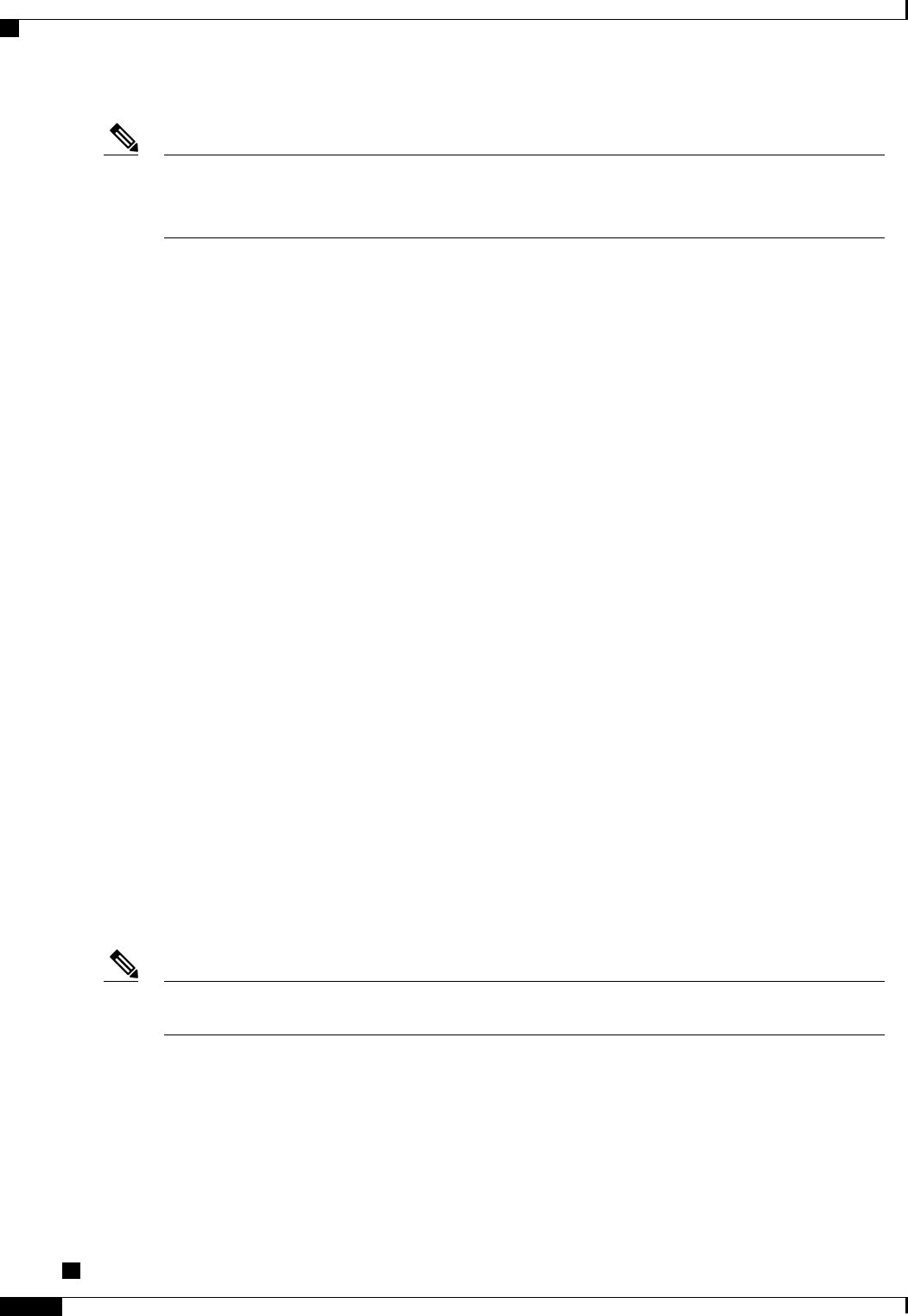
When you enter a URI address to place a call, do not pause for more then 10 seconds between key presses.
After 10 seconds of inactivity, the phone assumes that it has the complete address and attempts to place
the call.
Note
When you dial or receive a call through URI dialing, the call window and incoming call alert display the
complete URI address.
When you enter a URI address, the maximum length is 254 characters. You can enter the complete domain
name to override the default domain.
URI dialing works with the other features of your phone:
•You can configure a URI address as a speed dial entry to place a call.
•You can configure the Call Forward All destination using the Speed Dial or Call History entries.
•You can initiate a conference call and add multiple parties using URI Dialing if the URI address is stored
in the Speed Dial list or Call History.
•You cannot use URI addresses during Meet Me conferences or for Group Call Pickup.
•You can initiate a transfer call using URI dialing if the URI address is stored in the Speed Dial list or
Call History.
•You can monitor the state (in-use or idle) of a call using URI Dialing associated with Speed Dial or Call
History.
•You can initiate URI Dialing when a busy or unavailable party becomes available.
•You can hide the display of the URI address information.
•When the phones are connected to the Cisco Unified Communications Manager Express and Survivable
Remote Site Telephony (CME/SRST), the URI Dialing functions are disabled. The ABC softkey does
not appear on the phone screen.
Intelligent Proximity for Mobile Devices
Intelligent Proximity allows you to pair your mobile device to use the mobile line through your Cisco IP
Phone. Once the mobile device is paired, you can place and receive calls on the mobile line from your Cisco
IP Phone, with either the handset or the speaker. You can also use calling features such as hold and redial
with the mobile line.
If your Cisco IP Phone does not support Bluetooth then it also does not support Intelligent Proximity for
Mobile Devices. For more information, contact your administrator.
Note
You can share your mobile contacts and call history with the Cisco IP Phone, and move calls between your
mobile device and Cisco IP Phone. You can also view signal strength and battery level of the mobile device
on the Cisco IP Phone.
Cisco IP Phone 8811, 8841, 8845, 8851, 8851NR, 8861, and 8865 User Guide for Cisco Unified Communications
Manager 11.0
90
Advanced Calling Features
Intelligent Proximity for Mobile Devices
REVIEW DRAFT - CISCO CONFIDENTIAL
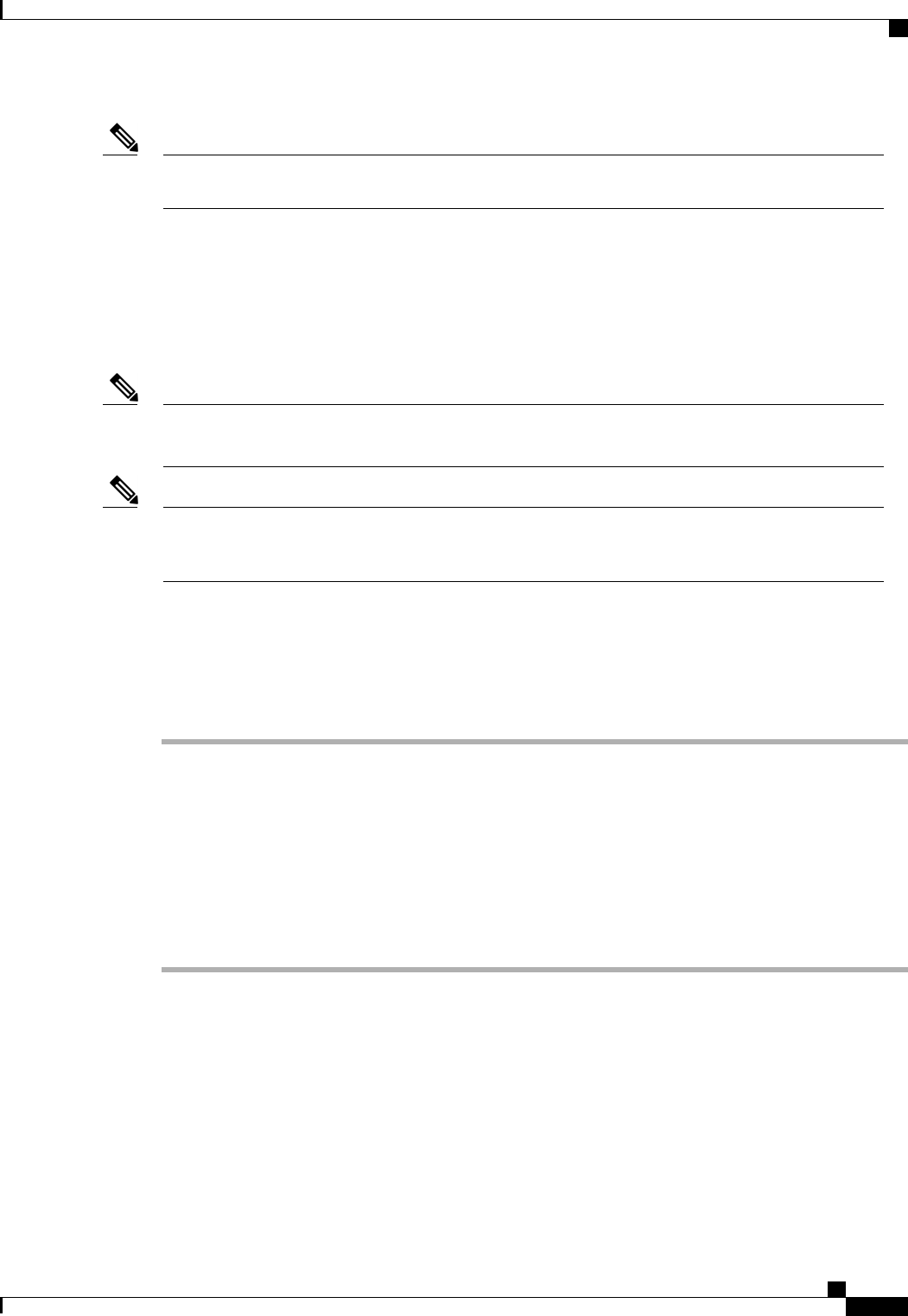
You may experience some variances for feature availability due to the operating system and other differences
in mobile devices.
Note
Pair a Mobile Device
You can connect one mobile device and one Bluetooth headset at the same time. You cannot connect one
mobile device and one tablet at the same time. You can pair multiple mobile devices with the phone, but only
one mobile device and one Bluetooth headset can be active at the same time.
When you connect your Bluetooth headset and your mobile device at the same time, the Bluetooth headset
cannot be used to answer the audio from the mobile device.
Note
If your Cisco IP Phone does not support Bluetooth then it also does not support Pair a Mobile Device. For
example, Cisco IP Phone 8851NR does not support Bluetooth. For more information, contact your
administrator.
Note
You pair the device with the phone to establish a communication path. After you pair your mobile device to
your Cisco IP Phone, the phone automatically connects to the mobile device when the device is in range, and
disconnects from the mobile device when the device is out of range. When the mobile device disconnects, the
mobile line is gray and displays not connected.
Procedure
Step 1 Put the mobile device in discoverable mode.
For more information about discoverable mode, see your mobile device documentation.Note
Step 2 On your Cisco IP Phone, press Applications.
Step 3 Select Bluetooth >Add Bluetooth.
Step 4 Add new device and select the mobile device from the available devices list to pair.
Step 5 Verify the passkey on the mobile device and the Cisco IP Phone.
Step 6 When you are prompted to save mobile contacts, choose to make your mobile device contacts and call history
available on your Cisco IP Phone.
Switch Connected Mobile Devices
If you have more than one paired mobile device in range of your Cisco IP Phone, you can choose which
mobile device to connect.
Cisco IP Phone 8811, 8841, 8845, 8851, 8851NR, 8861, and 8865 User Guide for Cisco Unified Communications Manager
11.0
91
Advanced Calling Features
Pair a Mobile Device
REVIEW DRAFT - CISCO CONFIDENTIAL

Procedure
Step 1 Press the Applications button and select Bluetooth.
Step 2 Select a mobile device from the available devices list.
The previously connected mobile device is disconnected, and the selected mobile device is connected.
Delete a Mobile Device
Procedure
Step 1 Select the mobile device in the available devices list.
Step 2 Press Delete.
Answer a Mobile Call
Procedure
Select Answer.
Decline a Mobile Call
Procedure
Select Decline.
The call ends.
Ignore a Mobile Call
Procedure
Select Ignore.
The call ends.
Cisco IP Phone 8811, 8841, 8845, 8851, 8851NR, 8861, and 8865 User Guide for Cisco Unified Communications
Manager 11.0
92
Advanced Calling Features
Delete a Mobile Device
REVIEW DRAFT - CISCO CONFIDENTIAL

Place a Mobile Call
Procedure
Step 1 Select a mobile line.
Step 2 Enter a ten digit number or select a contact from the call history.
Step 3 Press Call.
Move a Call Between the IP Phone and a Mobile Phone
Use your Cisco IP Phone to move an active call to or from your mobile device.
Procedure
Step 1 To move the call from your Cisco IP Phone to your mobile device, select Move audio.
Step 2 To move the call from your mobile device to your Cisco IP Phone, select Move audio.
Adjust the Mobile Device Volume
Volume controls on your Cisco IP Phone and mobile device are synchronized. Synchronization only occurs
when there is an active call.
Procedure
While on a call, adjust the volume on either the desk phone or on your mobile device to adjust the mobile
device volume.
Mobile Contacts and Mobile Call History Sharing
A paired mobile device displays in Bluetooth >Accounts as Bluetooth. This account remains until the
mobile device is unpaired.
Mobile Contacts can be checked from the Recents menu on the IP phone; Mobile Call History sharing can
be found using the New Call softkey.
If your Cisco IP Phone does not support Bluetooth then it also does not support Mobile Contacts and
Mobile Call History Sharing. For example, Cisco IP Phone 8851NR does not support Bluetooth or Mobile
Contacts and Mobile Call History Sharing. For more information, contact your administrator.
Note
Cisco IP Phone 8811, 8841, 8845, 8851, 8851NR, 8861, and 8865 User Guide for Cisco Unified Communications Manager
11.0
93
Advanced Calling Features
Place a Mobile Call
REVIEW DRAFT - CISCO CONFIDENTIAL
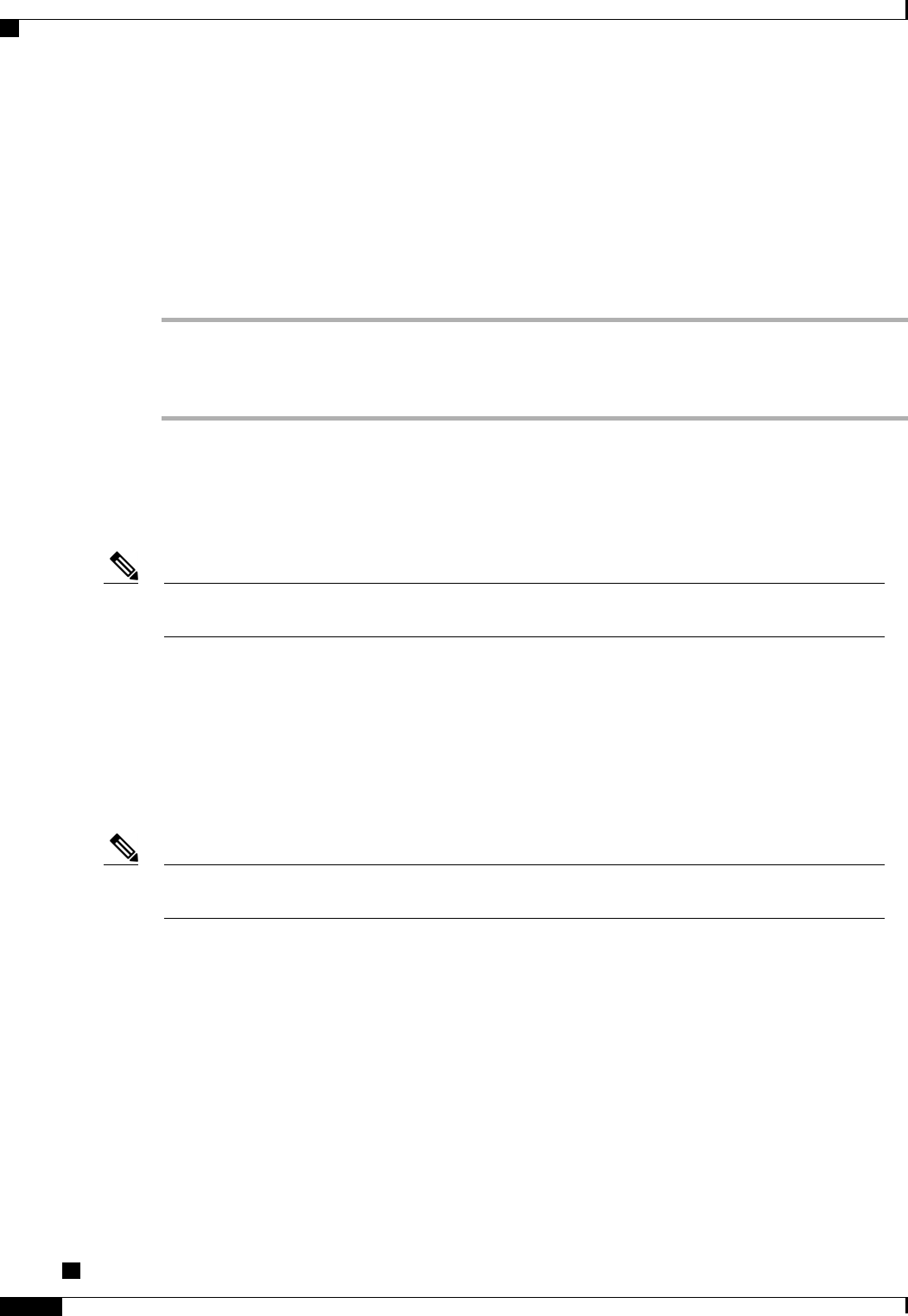
Synchronize Bluetooth Contacts
The contacts automatically synchronize to the Cisco IP phone when the mobile device connected. The contacts
update when a call ends or when the mobile device reconnects. There is no need to sync contact manually.
Use the following procedure to check the status of the contacts.
Procedure
Step 1 Press Contacts.
Step 2 Select Settings.
Step 3 Select Phone Book Access.
Save Bluetooth Contacts
Use this procedure if your Bluetooth Phone Book Access Profile option is No.
This procedure only applies to Cisco IP Phone 8851 and 8861. Cisco IP Phone 8851NR does not support
Bluetooth.
Note
Procedure
On the Contacts screen, select your mobile phone and check Save.
Delete Bluetooth Contacts
Use this procedure if your Bluetooth Phone Book Access Profile option is Save.
This procedure only applies to Cisco IP Phone 8851 and 8861. Cisco IP Phone 8851NR does not support
Bluetooth.
Note
Procedure
On the Contacts screen, select your mobile phone and check Delete.
Intelligent Proximity for Tablets
If you have a tablet, you can pair the tablet to the phone using Bluetooth. After pairing, audio from a soft
client phone call on the tablet can be played on the phone . There are no phone call management options for
calls from tablets.
The phone supports connections from Android and iOS tablets.
Cisco IP Phone 8811, 8841, 8845, 8851, 8851NR, 8861, and 8865 User Guide for Cisco Unified Communications
Manager 11.0
94
Advanced Calling Features
Intelligent Proximity for Tablets
REVIEW DRAFT - CISCO CONFIDENTIAL
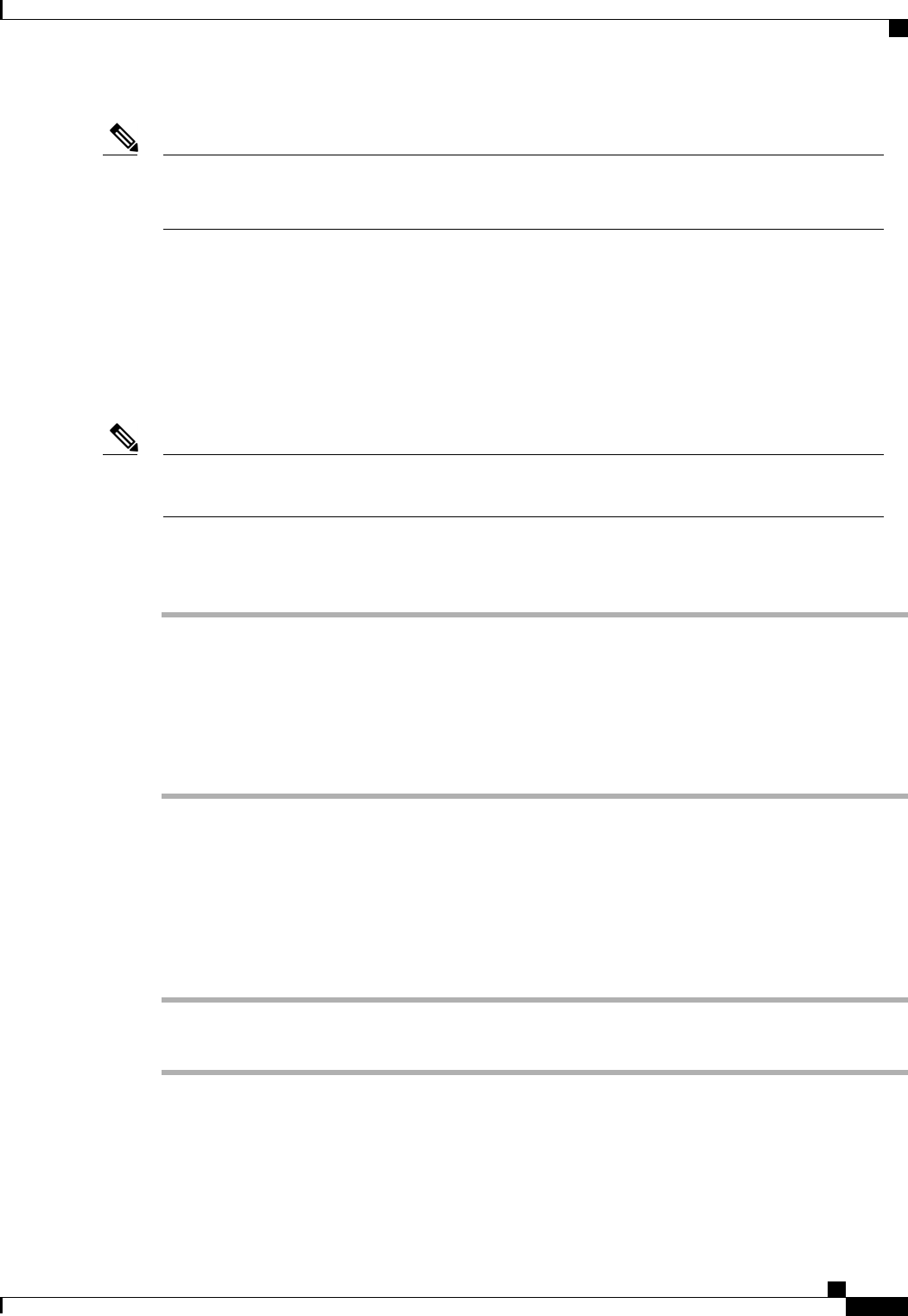
If your Cisco IP Phone does not support Bluetooth then it also does not support Intelligent Proximity for
Tablets. For example, Cisco IP Phone 8851NR does not support Bluetooth and thus it does not support
Intelligent Proximity for Tablets. For more information, contact your administrator.
Note
Pair a Tablet
You can connect a tablet and a Bluetooth headset at the same time. You cannot connect a tablet and a mobile
phone at the same time.
After you pair your tablet to your Cisco IP Phone, the phone will automatically connect to the tablet when
the tablet is in range, and disconnect from the tablet when the tablet is out of range.
When you connect your Bluetooth headset and your tablet at the same time, the Bluetooth headset cannot
be used to answer the audio from the or tablet.
Note
Cisco IP Phone 8851NR does not support Bluetooth
Procedure
Step 1 Put the tablet in discoverable mode.
For more information about discoverable mode, see your tablet documentation.Note
Step 2 On your Cisco IP Phone, press Applications.
Step 3 Choose Bluetooth >Add Bluetooth device.
Step 4 Select the tablet from the available devices list to pair.
Step 5 Verify the passkey on the tablet and the Cisco IP Phone.
Move Audio from the Tablet to the Phone
Cisco IP Phone 8851NR does not support Bluetooth
Procedure
Step 1 When the soft client call comes to the tablet, set the audio path to use the Bluetooth connection to the phone.
Step 2 Listen to the audio on the phone using the headset, handset, or speakerphone.
Cisco IP Phone 8811, 8841, 8845, 8851, 8851NR, 8861, and 8865 User Guide for Cisco Unified Communications Manager
11.0
95
Advanced Calling Features
Pair a Tablet
REVIEW DRAFT - CISCO CONFIDENTIAL

Manage Tablet Audio on Phone
Cisco IP Phone 8851NR does not support Bluetooth
Procedure
Step 1 To move the audio from the phone handset to the phone headset, press Headset.
Step 2 To move the audio from the phone handset to the phone speakerphone, press Speakerphone.
Step 3 To move the audio from the headset or the speakerphone to the handset, pick up the handset.
Step 4 To move the audio back to the tablet, hang up the handset or press Release.
Step 5 To handle an incoming phone call on the phone, answer the phone.
The audio for the active soft client reverts to the tablet automatically.
Cisco IP Phone 8811, 8841, 8845, 8851, 8851NR, 8861, and 8865 User Guide for Cisco Unified Communications
Manager 11.0
96
Advanced Calling Features
Manage Tablet Audio on Phone
REVIEW DRAFT - CISCO CONFIDENTIAL

CHAPTER 8
Advanced Operations
•Applications, page 97
•Mobile and Remote Access Through Expressway, page 98
•Video Calls and Security, page 103
•Call Functions, page 104
•Feature Buttons and Softkey, page 106
•Survivable Remote Site Telephony Overview, page 108
Applications
You can view the applications that are running on your phone, including those that are not under Applications
menu; for example, Directories. You may first see the disclaimer required for remote workers, if you have
not already accepted it.
View Active Applications
Procedure
Step 1 Press Applications .
Step 2 Use the Navigation cluster and Select button to scroll and select Running Applications.
The phone displays a list of applications running on the phone including those that are not under the Application
menu.
Step 3 Press Exit to return to the Applications screen.
Cisco IP Phone 8811, 8841, 8845, 8851, 8851NR, 8861, and 8865 User Guide for Cisco Unified Communications Manager
11.0
97
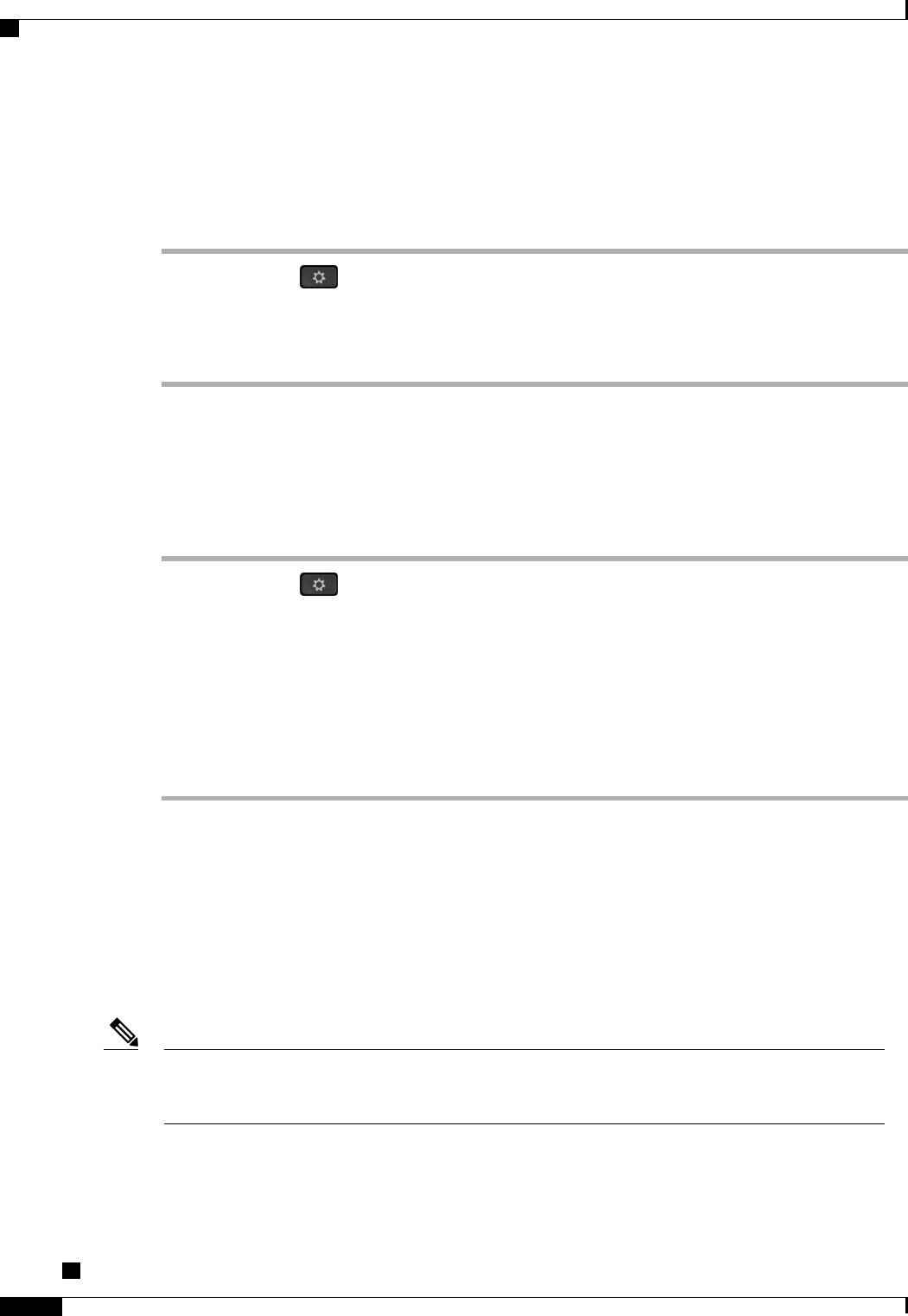
Switch to Active Applications
Procedure
Step 1 Press Applications .
Step 2 Use the Navigation cluster and Select button to scroll and select Running Applications.
Step 3 Choose a running application and press Switch To to open and use the selected application.
Step 4 Press Exit to close the application.
Close Active Applications
Procedure
Step 1 Press Applications .
Step 2 Use the Navigation cluster and Select button to scroll and select Running Applications.
Step 3 Select a running application and press Close App to close the application. Choose one of the following actions
in the alert pop up:
•Press Close to close the application without saving the changes.
•Press Cancel to cancel the close application operations.
Step 4 Press Exit to return back to the Applications screen.
Mobile and Remote Access Through Expressway
Mobile and Remote Access Through Expressway lets you easily and securely connect into your corporate
network when working away from your corporate office (off-site). This feature is enabled by default.
When your phone detects that it is in off-premises mode, the Mobile and Remote Access Through Expressway
sign-in window appears, and you can sign in to your corporate network.
If your phone firmware is not up to date, you must upgrade the firmware while you are on-site. Otherwise
Mobile and Remote Access Through Expressway may not function correctly. For more information,
contact your administrator.
Note
Cisco IP Phone 8811, 8841, 8845, 8851, 8851NR, 8861, and 8865 User Guide for Cisco Unified Communications
Manager 11.0
98
Advanced Operations
Switch to Active Applications
REVIEW DRAFT - CISCO CONFIDENTIAL

If the DHCP option 150 is enabled on your network router, you may have trouble logging in to the corporate
network. Disable DHCP option 150 on your router and configure the static IP address directly.
Note
Phone Features Available for Mobile and Remote Access Through Expressway
Mobile and Remote Access Through Expressway provides secure VPN-less access to collaboration services
for Cisco mobile and remote users. But to preserve network security, it limits access to phone features.
The following table shows the phone features available with Mobile and Remote Access Through Expressway.
Table 1: Available Phone Features forMobile and Remote Access Through Expressway
Available Phone Feature
Abbreviated Dialing1.
Assisted Directed Call Park2.
Busy Lamp Field (BLF)3.
Busy Lamp Field (BLF) Pickup4.
Busy Lamp Field (BLF) Speed Dial5.
Call Back6.
Call Forward7.
Call Forward Notification8.
Call Park9.
Call Pickup10.
Conference11.
Direct Transfer12.
Directed Call Park13.
Divert14.
Do Not Disturb (DND)15.
Group Call Pickup16.
Hold/Resume17.
Cisco IP Phone 8811, 8841, 8845, 8851, 8851NR, 8861, and 8865 User Guide for Cisco Unified Communications Manager
11.0
99
Advanced Operations
Phone Features Available for Mobile and Remote Access Through Expressway
REVIEW DRAFT - CISCO CONFIDENTIAL

Available Phone Feature
Hold Reversion18.
Immediate Divert19.
Join20.
Meet Me Conference21.
Message Waiting Indicator22.
Mobile Connect2.3
Mobile Voice Access24.
Music On Hold25.
Mute26.
Onhook Dialing27.
Plus Dialing28.
Redial29.
Speed Dial30.
Transfer31.
Uniform Resource Identifier (URI) Dialing32.
Visual Voicemail33.
Voice Message System34.
Sign in with Mobile and Remote Access Through Expressway
You can store your login information with User Credentials Persistent for Expressway Sign-In. Contact
your administrator to enable this feature.
Tip
Before You Begin
Before you can connect to your corporate network using Mobile and Remote Access Through Expressway,
you must have a valid service name, username, and password. If you do not have this information, contact
your administrator.
Cisco IP Phone 8811, 8841, 8845, 8851, 8851NR, 8861, and 8865 User Guide for Cisco Unified Communications
Manager 11.0
100
Advanced Operations
Sign in with Mobile and Remote Access Through Expressway
REVIEW DRAFT - CISCO CONFIDENTIAL
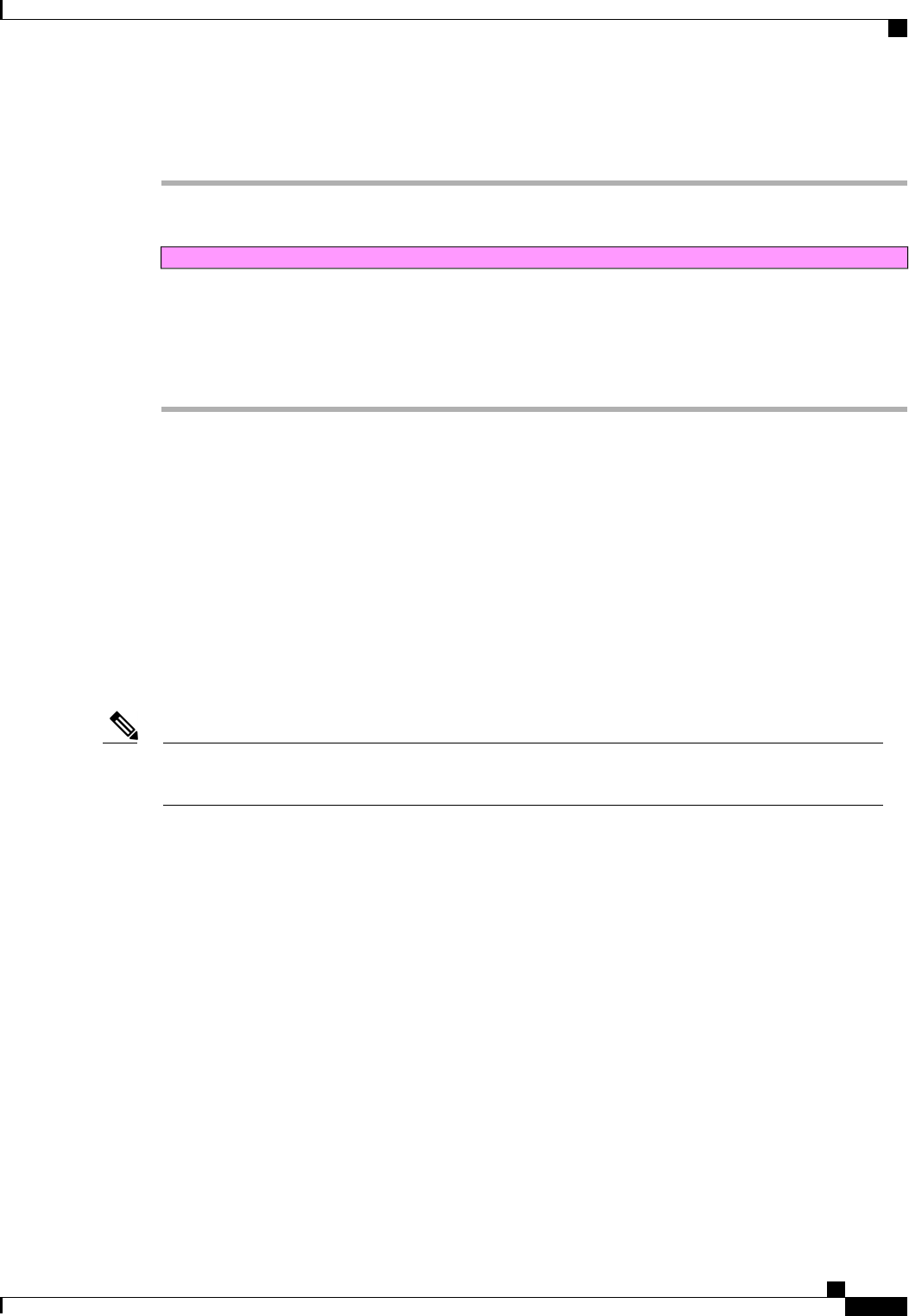
Procedure
Step 1 Enter your service name in the Service Name field.
Draft comment: Design team: Please provide the updated information on how to enter the menu.
Step 2 Enter your username in the Username field.
Step 3 Enter your password in the Password field.
Step 4 Press Submit.
If a login is unsuccessful, an error message appears; log in again, or cancel the login procedure.
Cisco Collaboration Problem Reporting Tool
When you are signed in to your network with Mobile and Remote Access Through Expressway, you can use
the Cisco Collaboration Problem Report Tool (PRT) to collect and send phone logs - and to report problems
to your system administrator. This tool is found on the Phone Information screen.
PRT is available only when your phone is Off-Premises mode and you are connected to your corporate network
with Mobile and Remote Access Through Expressway.
Report a Problem with Cisco Collaboration Problem Reporting Tool
The Cisco Collaboration Problem Reporting Tool may fail to upload your phone logs. If this happens, an
error message appears with an IP address. Use the generated IP address to access the logs from the phone.
Note
Before You Begin
You must be logged in to your corporate network with Mobile and Remote Access Through Expressway
before you can report a Problem with Cisco Collaboration Problem Reporting Tool (PRT).
Cisco IP Phone 8811, 8841, 8845, 8851, 8851NR, 8861, and 8865 User Guide for Cisco Unified Communications Manager
11.0
101
Advanced Operations
Cisco Collaboration Problem Reporting Tool
REVIEW DRAFT - CISCO CONFIDENTIAL
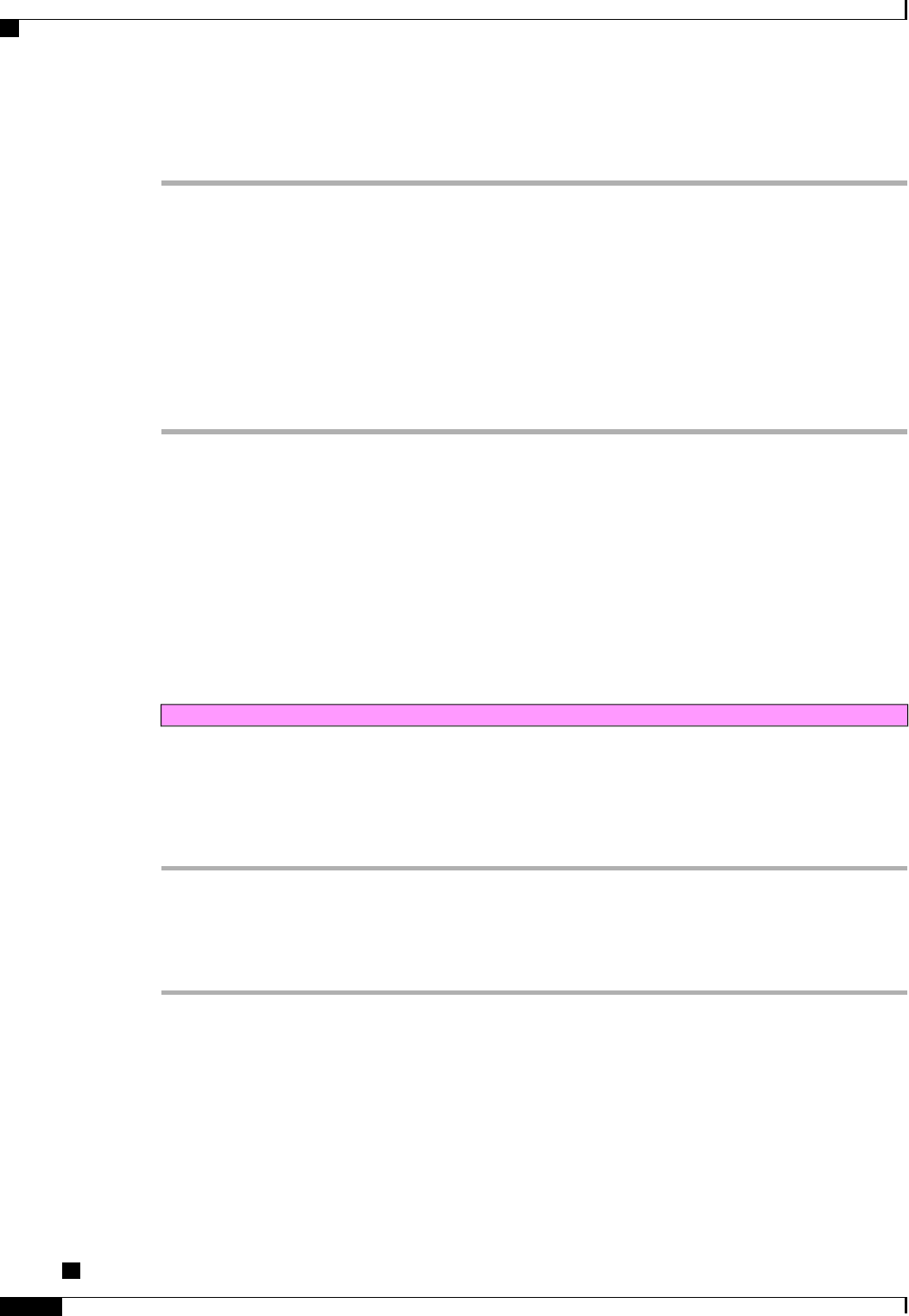
Procedure
Step 1 Press Applications.
Step 2 Select Phone Information.
Step 3 Press Report Problem.
Step 4 Enter the current date in the Date of Problem field. Use the format dd/mm/yyyy. The current date appears
in this field by default.
Step 5 Enter a time into the Time of Problem field. The current time appears in this field by default.
Step 6 Select Problem Description.
Step 7 Select a description from the displayed list.
Step 8 Press Submit.
Set Up a VPN Phone for Mobile and Remote Access Through Expressway
If your phone is set up for use with a virtual private network (VPN), you must reset the Network Settings to
clear the Alternate TFTP setting before you can access your company network with Mobile and Remote
Access Through Expressway. This ensures that the phone detects the off-premises network and stops the
phone from making a VPN connection.
Before You Begin
Draft comment: Design Team: Please confirm this procedure
To complete this procedure, you must have a valid service name, username, and password. If you do not have
this information, contact your administrator.
Procedure
Step 1 Choose Admin Settings from the Applications menu.
Step 2 Choose Reset Settings.
Step 3 Choose Network Settings.
Step 4 Log in to your network with Mobile and Remote Access Through Expressway.
Set Up a Phone for Use with VPN
Before You Begin
Cisco IP Phone 8811, 8841, 8845, 8851, 8851NR, 8861, and 8865 User Guide for Cisco Unified Communications
Manager 11.0
102
Advanced Operations
Set Up a VPN Phone for Mobile and Remote Access Through Expressway
REVIEW DRAFT - CISCO CONFIDENTIAL
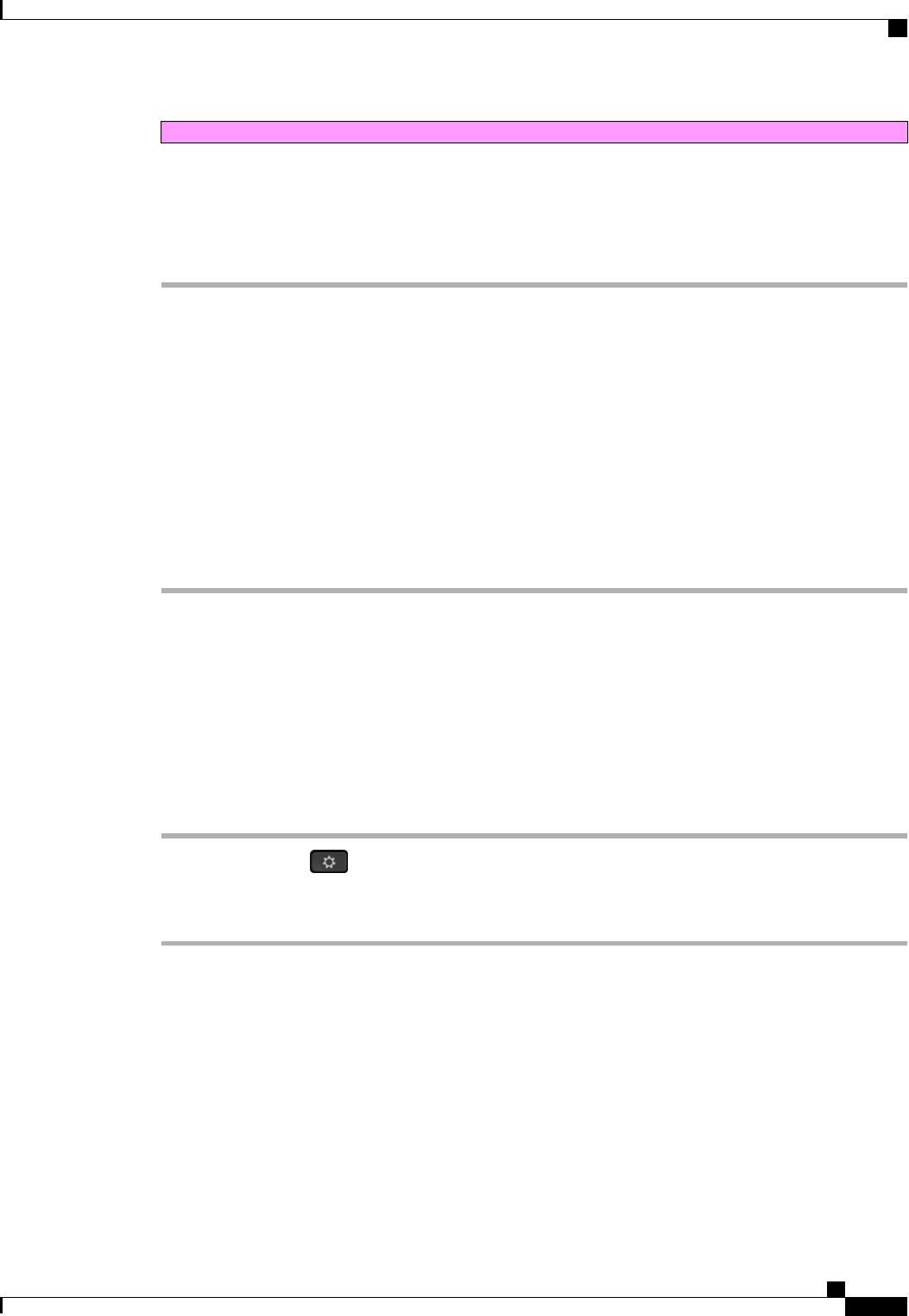
Draft comment: Design Team: Please confirm this procedure
To complete this procedure, you must have a valid TFTP server address, service name, username, and password.
If you do not have this information, contact your administrator.
Procedure
Step 1 Choose Admin Settings from the Applications menu.
Step 2 Choose Reset Settings.
Step 3 Choose Network Settings.
Step 4 Log in to your network with Mobile and Remote Access Through Expressway.
Step 5 Choose Admin Settings from the Applications menu.
Step 6 Choose Ethernet Setup.
Step 7 Choose IPv4 Setup.
Step 8 Choose TFTP server 1.
Step 9 Enter your TFTP server address in the TFTP server 1 field.
Step 10 Choose Apply.
Step 11 Choose Exit.
Turn Off the Alternate TFTP Server
If you are off-premises but the Mobile and Remote Access Through Expressway sign-in window does not
appear on your phone, the Alternate TFTP setting may be turned on. The Alternate TFTP setting must be set
to Off. To turn off the Alternate TFTP setting, follow these steps.
Procedure
Step 1 ChooseApplications .
Step 2 Choose Admin Settings >Ethernet Setup >IPv4 Setup.
Step 3 Set the Alternate TFTP Setting to Off.
Video Calls and Security
The audio for a call can be secure or nonsecure. Similarly, the video stream for a call can be secure or nonsecure.
Depending on the system configuration, the Secure icon displays when only audio stream is secure or when
both audio and video streams are secure. For more information, contact your system administrator.
Cisco IP Phone 8811, 8841, 8845, 8851, 8851NR, 8861, and 8865 User Guide for Cisco Unified Communications Manager
11.0
103
Advanced Operations
Turn Off the Alternate TFTP Server
REVIEW DRAFT - CISCO CONFIDENTIAL

Call Functions
This section provides information about some of the advanced call functions that are available on Cisco IP
Phones.
Agent Greeting
Agent Greeting allows you to create and update a prerecorded greeting that plays at the beginning of a call,
such as a customer call, before you begin the conversation with the caller. You can prerecord a single greeting
or multiple greetings as needed.
When a customer calls, both parties hear the prerecorded greeting. You can remain on mute until the greeting
ends or answer the call over the greeting.
For more information, contact your system administrator.
Alert Calls
The Alert Calls feature allows you to view a list of all Alert Calls in chronological order (oldest to most recent).
You interact with this feature using a programmable line key, which makes it easier to view all of the Alert
Calls that are received across your phone lines.
An Alert Call is a specific phone number that you consider important and want to be alerted to when you
receive a call from or make a call to this number.
System administrators set up the Alert Calls button. For more information, contact your system administrator.
Actionable Incoming Call Alert
The Actionable Incoming Call Alert displays an actionable alert instead of a toast alert when you receive an
incoming call. In addition to displaying incoming caller details, the actionable alert allows you to answer,
ignore, or divert the call.
Your administrator configures the Actionable Incoming Call Alert. By default, this actionable alert is disabled.
If both the Custom Line Filters and the Actionable Incoming Call Alert features are enabled, actionable
call alerts apply only to the lines that are covered by filters.
Note
Answer
Answer allows you to answer the oldest call that is available on all line appearances on your phone, including
Hold Reversion and Park Reversion calls that are in an alerting state. Incoming calls always have priority
over Held or Park Reversion calls.
Your system administrator sets up the Answer button depending on your call-handling needs and work
environment. Typically, the Answer is set up if you have multiple lines.
Cisco IP Phone 8811, 8841, 8845, 8851, 8851NR, 8861, and 8865 User Guide for Cisco Unified Communications
Manager 11.0
104
Advanced Operations
Call Functions
REVIEW DRAFT - CISCO CONFIDENTIAL

When you get a call, you see a notification window on the phone screen, called a call toast. The call toast
remains visible for a preset amount of time. Your system administrator sets up the default time.
If an incoming call has been call forwarded from another phone, you may see additional information in the
call toast to identify that the call has been forwarded. Your system administrator controls the amount of
additional information displayed. Additional information can identify the person who forwarded the call to
you and the caller information.
Client Matter Code
Your administrator may require that you enter a Client Matter Code (CMC) after you dial a phone number.
The CMC can be used for accounting or billing codes. For more information, contact your system administrator.
When you need to enter a CMC, the phone displays Enter Client Matter Code, the dialed number
changes to “********”, and you hear a special tone. Enter the CMC for the call using the keypad.
Related Topics
Forced Authorization Code, on page 105
Forced Authorization Code
Your administrator may require that you enter a Forced Authorization (FACC) after you dial a phone number.
The FAC controls access to phone numbers. For more information, contact your system administrator.
When you need to enter an FAC, the phone displays Enter Authorization Code, the dialed number
changes to “********”, and you hear a special tone. Enter the FAC for the call using the keypad. For security
reasons, the phone displays a “*”instead of the number entered.
Related Topics
Client Matter Code, on page 105
Secure and Nonsecure Indication Tones
When a phone is configured as secure (encrypted and trusted), it can be given a “protected”status. After a
phone is protected, it can be configured to play an indication tone at the beginning of a call.
You will hear these secure or nonsecure indication tones only on protected phones. If the overall call status
changes during the call, the protected phone plays the appropriate tone.
When the Play Secure Indication Tone option is enabled (True), the following circumstances determine the
type of tone the protected phone plays:
•If end-to-end secure media is established and the call status is secure, the phone plays the secure indication
tone (three long beeps with pauses)
•If end-to-end nonsecure media is established and the call status is not secure, the phone plays the nonsecure
indication tone (six short beeps with brief pauses)
•When the Play Secure Indication Tone option is disabled, no tone plays.
For more information, contact your system administrator.
Cisco IP Phone 8811, 8841, 8845, 8851, 8851NR, 8861, and 8865 User Guide for Cisco Unified Communications Manager
11.0
105
Advanced Operations
Client Matter Code
REVIEW DRAFT - CISCO CONFIDENTIAL

Shared Lines
Shared lines allow you to use one phone number for multiple phones and either you or your coworker can
answer the call. When the line flashes red, your coworker can pick up the call.
If you share a line with a coworker:
•When a call comes in on the shared line:
•Your phone rings, the line button is solid amber, and the session button flashes amber.
•Your coworker's phone rings, the line button is solid amber, and the session button flashes amber.
•When your coworker has a call on the shared line:
•If your coworker has privacy enabled, the shared line button is solid red, the session button is solid
red, but the call information does not display on your phone.
•If your coworker does not have privacy enabled, the shared line button is solid red, the session
button is solid red, and the call information (name and number, if available) displays on your phone.
•If you put the call on hold:
•Your line button is solid green and the session button pulses green
•Your coworker’s line button is solid red and the session button pulses red.
•You or the coworker can join a call on the shared line using the Barge feature. Barge converts the call
into a conference. To barge, press the red session button for the remote in-use call on the shared line.
Feature Buttons and Softkey
Depending on how your system administrator set up your phone, some features included in this guide may
not be available to you.
The following table provides information about some of the features that are available on softkeys and dedicated
feature buttons and some that your system administrator can set up on programmable feature buttons. Features
that appear on softkeys are set up by your system administrator.
SoftkeyProgrammable feature
button
Dedicated feature
button
Feature name
XAlert Calls
XAll Calls
XXAnswer
X
Displays as Merge
Barge
XXCall Back
Cisco IP Phone 8811, 8841, 8845, 8851, 8851NR, 8861, and 8865 User Guide for Cisco Unified Communications
Manager 11.0
106
Advanced Operations
Shared Lines
REVIEW DRAFT - CISCO CONFIDENTIAL

SoftkeyProgrammable feature
button
Dedicated feature
button
Feature name
XCall Forward All
XXCall Park
XCall Park Line Status
XXCall Pickup (Pick Up)
XCall Pickup Line Status
XXConference
XDecline
XXDo Not Disturb
XXGroup Pickup (Group
Pick Up)
XXHold
XHunt Groups
XIntercom
XXMalicious Call
Identification (MCID)
XXMeet Me
XXMobile Connect
(Mobility)
XMute
XXOther Pickup
XPLK Support for Queue
Status
XPrivacy
XQueue Status
XXQuality Reporting Tool
(QRT)
XRecord
Cisco IP Phone 8811, 8841, 8845, 8851, 8851NR, 8861, and 8865 User Guide for Cisco Unified Communications Manager
11.0
107
Advanced Operations
Feature Buttons and Softkey
REVIEW DRAFT - CISCO CONFIDENTIAL
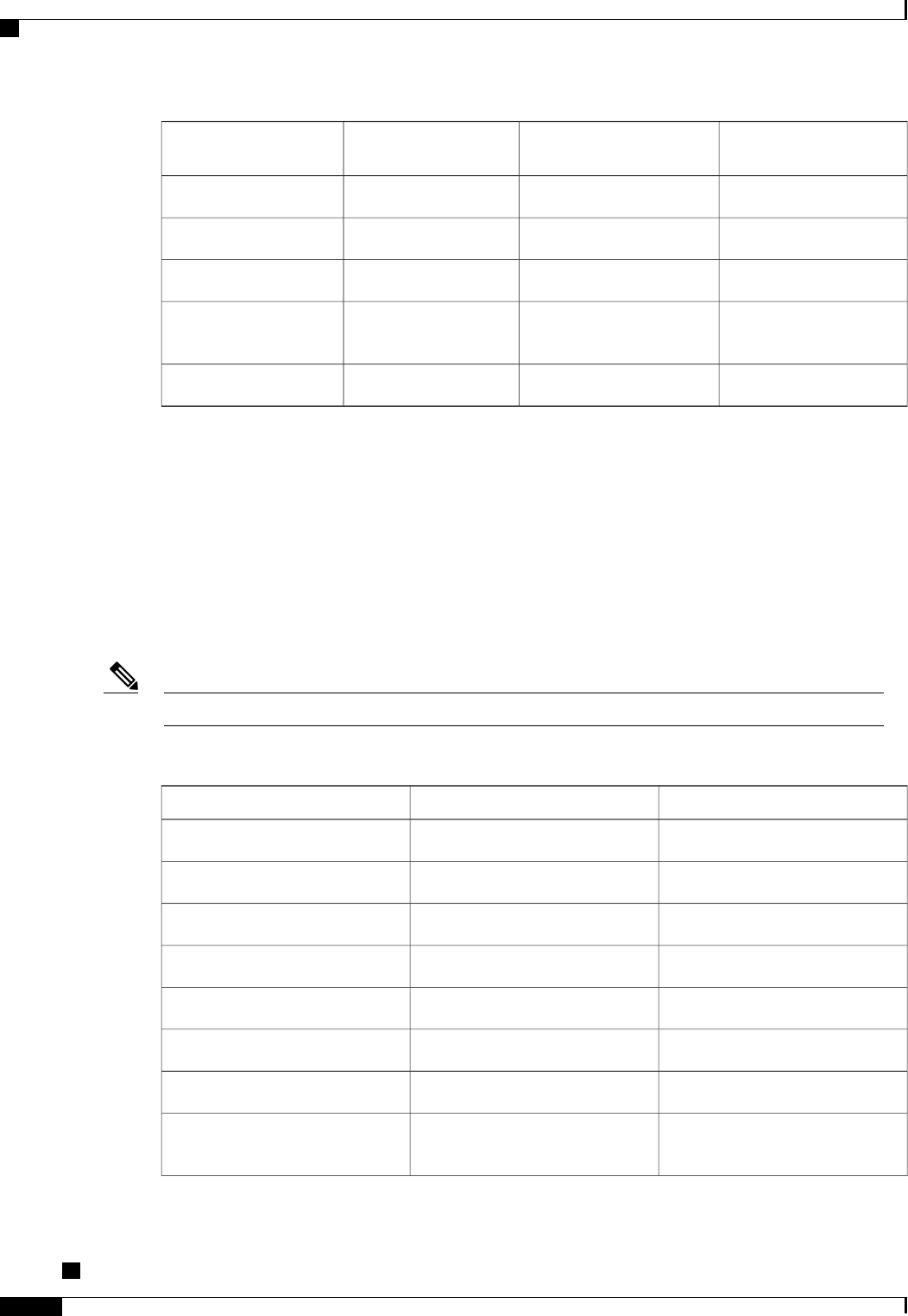
SoftkeyProgrammable feature
button
Dedicated feature
button
Feature name
XXRedial
XXSpeed Dial
XXSpeed Dial Line Status
XSupport for Hold Button
on USB Headsets
XXTransfer
Survivable Remote Site Telephony Overview
If communication between your phone and the Cisco Unified Communications Server is interrupted, you
receive an alert message on your phone. If you are on an active call, the call remains established, and you
enter a failover situation. This failover is the Survivable Remote Site Telephony (SRST) feature.
While in failover, not all the features of your phone are available. The following table describes typical feature
and feature availability, although not all the features may be supported on your phone . For more information
about feature availability during failover, contact your system administrator.
SRST does not support IPv6.Note
Table 2: Feature Support During Failover
NotesSupportedFeature
YesNew Call
YesEnd Call
YesRedial
YesAnswer
YesHold
YesResume
YesConference
The Active Calls softkey does not
display.
NoConference to Active Calls (Join)
Cisco IP Phone 8811, 8841, 8845, 8851, 8851NR, 8861, and 8865 User Guide for Cisco Unified Communications
Manager 11.0
108
Advanced Operations
Survivable Remote Site Telephony Overview
REVIEW DRAFT - CISCO CONFIDENTIAL

NotesSupportedFeature
NoConference List
YesTransfer
NoTransfer to Active Calls (Direct
Transfer)
YesAuto Answer
YesCall Waiting
YesCaller ID
YesAudible Message Waiting Indicator
YesAll Calls Programmable Line Key
YesAnswer Programmable Line Key
Conference is the only feature
supported.
YesUnified Session Presentation
Your voicemail will not be
synchronized with other users in
the Cisco Unified Communications
Manager cluster.
YesVoicemail
YesSpeed Dial
YesService IRL Programmable Line
Key
The iDivert softkey does not
display.
NoTo Voicemail (iDivert)
Lines are supported but cannot be
shared.
PartialLine Filters
The Park softkey does not display.NoPark Monitoring
The Merge softkey does not
display.
NoMerge
Message count badges do not
appear on the phone screen.
Only the Message Waiting icon
displays.
NoEnhanced Message Waiting
Indication
Cisco IP Phone 8811, 8841, 8845, 8851, 8851NR, 8861, and 8865 User Guide for Cisco Unified Communications Manager
11.0
109
Advanced Operations
Survivable Remote Site Telephony Overview
REVIEW DRAFT - CISCO CONFIDENTIAL

NotesSupportedFeature
The softkey does not display.NoDirected Call Park
Calls remain on hold indefinitely.NoHold Reversion
Calls appear as Local Hold calls.NoRemote Hold
The Meet Me softkey does not
display.
NoMeet Me
The softkey causes no action.NoPickUp
The softkey causes no action.NoGroup PickUp
The softkey causes no action.NoOther PickUp
The softkey causes no action.NoMalicious Call ID
The softkey causes no action.NoQRT
The softkey causes no action.NoHunt Group
The softkey causes no action.NoIntercom
The softkey causes no action.NoMobility
The softkey causes no action.NoPrivacy
The Call Back softkey does not
display.
NoCall Back
YesShared line
YesBLF Speed Dial
Video conference is not supported.YesVideo
When your phone loses connectivity, your phone may display a message like this: Service
interruption. Some features unavailable.
Cisco IP Phone 8811, 8841, 8845, 8851, 8851NR, 8861, and 8865 User Guide for Cisco Unified Communications
Manager 11.0
110
Advanced Operations
Survivable Remote Site Telephony Overview
REVIEW DRAFT - CISCO CONFIDENTIAL

CHAPTER 9
User Preferences
•Change the Wallpaper, page 111
•Change the Ringtone, page 112
•Adjust the Phone Screen Brightness, page 112
•Adjust Phone Screen Contrast, page 112
•Change the Font Size, page 113
•Change the Phone Name, page 114
•Adjust the Headset Sidetone, page 114
•Phone Services, page 115
•Line Settings, page 115
Change the Wallpaper
Your system administrator controls if you can change the wallpaper. If you can change the wallpaper, you
can set up your phone with wallpapers that are provided with the phone, or with your own custom wallpaper.
For more information, contact your system administrator.
Procedure
Step 1 Press Applications .
Step 2 Use the Navigation cluster and Select button to scroll and select Settings.
Step 3 Select Wallpaper and select a wallpaper option.
Step 4 Press Preview to see the wallpaper on your phone screen.
Step 5 Press Set to apply the wallpaper to the phone.
Cisco IP Phone 8811, 8841, 8845, 8851, 8851NR, 8861, and 8865 User Guide for Cisco Unified Communications Manager
11.0
111
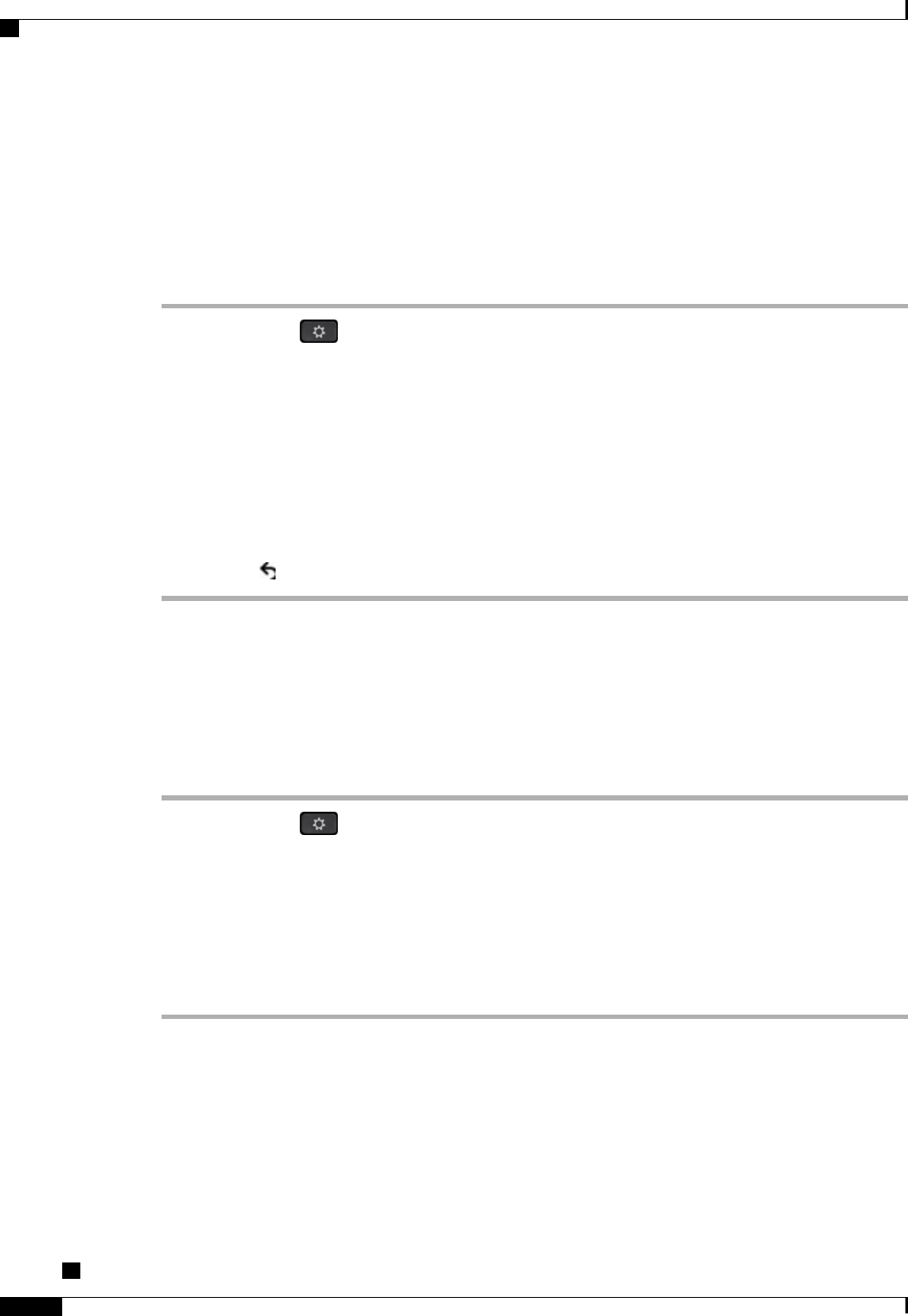
Change the Ringtone
You can choose a different ringtone for each line that your phone plays to indicate an incoming call. For
information about adding custom ringtones to your phone, contact your system administrator.
Procedure
Step 1 Press Applications .
Step 2 Use the Navigation cluster and Select button to scroll and select Settings.
Step 3 Select Ringtone.
Step 4 If your phone has multiple lines, select a line and press Edit or Select.
Step 5 Highlight a ringtone.
Step 6 Press Select or Edit.
Step 7 Press Play to play the sample ringtone.
Step 8 Press Set to apply the ringtone.
Step 9 To apply the ringtone to all lines, press Apply To All.
Step 10 Press Return to return to the Settings screen.
Adjust the Phone Screen Brightness
You can adjust your phone screen brightness level.
Procedure
Step 1 Press Applications .
Step 2 Use the Navigation cluster and Select button to scroll and select Settings.
Step 3 Select Brightness.
•To increase brightness, press up or right on the Navigation cluster.
•To decrease brightness, press down or left on the Navigation cluster.
Step 4 Press Save to set the brightness, or press Cancel to exit.
Adjust Phone Screen Contrast
You can adjust the contract on the Cisco IP Phone 8811.
Cisco IP Phone 8811, 8841, 8845, 8851, 8851NR, 8861, and 8865 User Guide for Cisco Unified Communications
Manager 11.0
112
User Preferences
Change the Ringtone
REVIEW DRAFT - CISCO CONFIDENTIAL

Procedure
Step 1 Press Applications .
Step 2 Use the Navigation cluster and Select button to scroll and select Settings.
Step 3 Select Contrast.
•To increase contrast, press up or right on the Navigation cluster.
•To decrease contrast, press down or left on the Navigation cluster.
Step 4 Press Save to set the contrast, or press Cancel to exit.
Change the Font Size
You can increase or decrease the maximum number of characters the phone displays by changing the font
size for the displayed characters. To increase the maximum number of displayed characters, select a smaller
font size. To decrease the maximum number of displayed characters, select a larger font size.
The font size affects the following labels:
•call screen (caller name and feature key label)
•caller name in the Call History
•line label on the phone screen
•line label on the Cisco IP Phone 8800 Key Expansion Module (KEM)
The following table describes the configuration setting and the corresponding font sizes.
KEMCall HistoryCall Session:
Caller Number
Call Session:
Caller Name
Line LabelConfiguration
Setting
1st Line: 26 px
2nd Line: 22 px
Name: 26 px
Number: 24 px
22 px26 px1st Line: 26 px
2nd Line: 22 px
Huge
1st Line: 24 px
2nd Line: 20 px
Name: 24 px
Number: 22 px
20 px24 px1st Line: 24 px
2nd Line: 20 px
Large
1st Line: 22 px
2nd Line: 18 px
Name: 22 px
Number: 20 px
18 px22 px1st Line: 22 px
2nd Line: 18 px
Regular
(default)
1st Line: 20 px
2nd Line: 16 px
Name: 20 px
Number: 18 px
16 px20 px1st Line: 20 px
2nd Line: 16 px
Small
1st Line: 18 px
2nd Line: 14 px
Name: 18 px
Number: 16 px
14 px18 px1st Line: 18 px
2nd Line: 14 px
Tiny
Cisco IP Phone 8811, 8841, 8845, 8851, 8851NR, 8861, and 8865 User Guide for Cisco Unified Communications Manager
11.0
113
User Preferences
Change the Font Size
REVIEW DRAFT - CISCO CONFIDENTIAL

Procedure
Step 1 Press Applications .
Step 2 Use the Navigation cluster and Select button to scroll and choose Settings.
Step 3 Choose Font Size.
Step 4 Choose Huge,Large,Regular,Small, or Tiny and press Set.
Step 5 Press Exit to return to the Settings screen.
Change the Phone Name
You can change the name of the phone from the default name.
Procedure
Step 1 On the phone, select Applications >Settings.
Step 2 Scroll and select Phone Name.
Step 3 Use the keypad to enter a name.
Step 4 Press Apply to save the changes or press Revert to cancel the change.
Step 5 Press Exit.
Adjust the Headset Sidetone
If your system administrator has sets the Headset Sidetone Controls feature for your phone, you can specify
the volume of your headset from your phone.
Procedure
Step 1 Press Applications .
Step 2 Use the Navigation cluster and Select button to select Settings.
Step 3 Select Headset Sidetone.
Step 4 Select one of these sidetone levels:
•Off
•Low
•Normal
Cisco IP Phone 8811, 8841, 8845, 8851, 8851NR, 8861, and 8865 User Guide for Cisco Unified Communications
Manager 11.0
114
User Preferences
Change the Phone Name
REVIEW DRAFT - CISCO CONFIDENTIAL
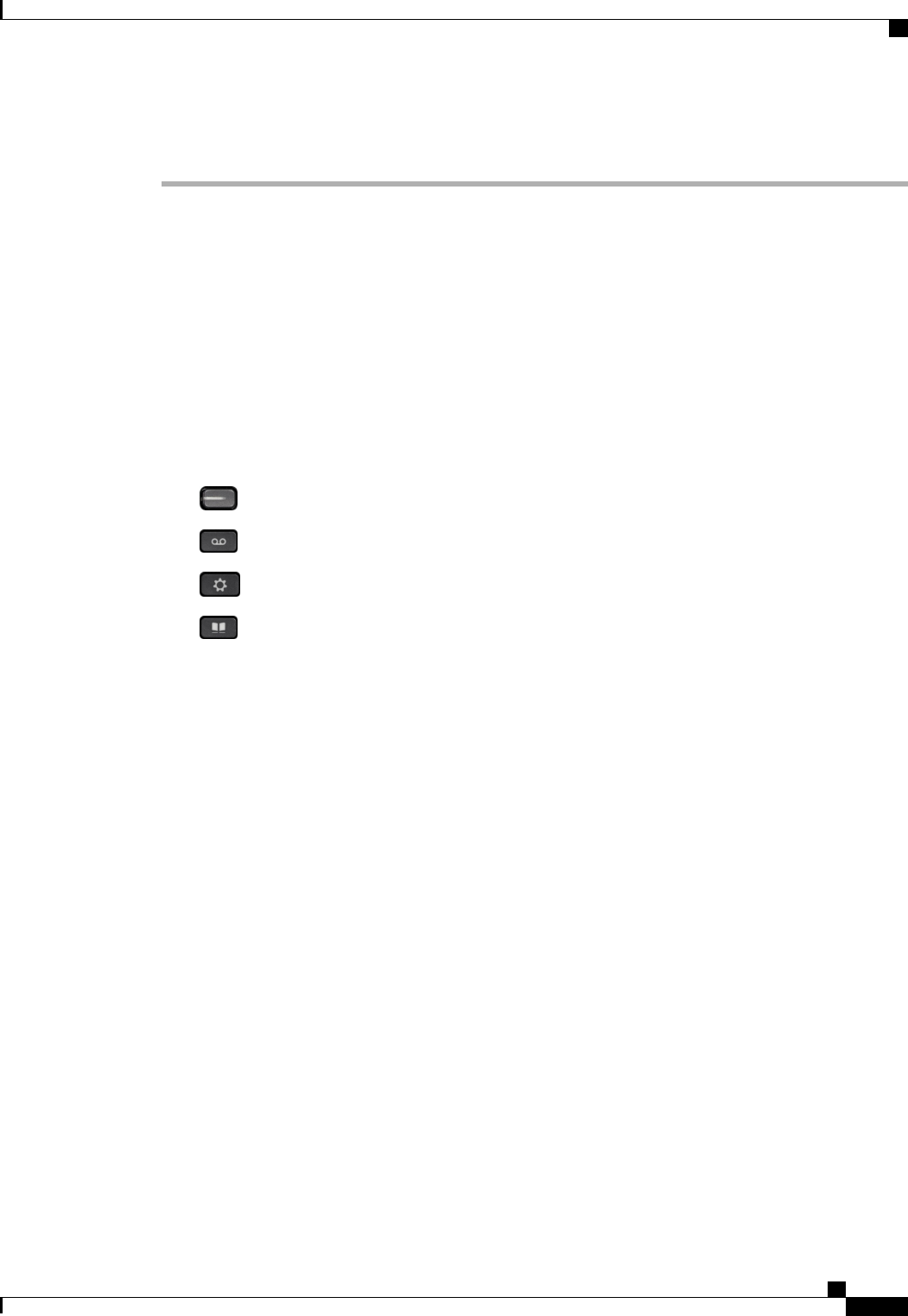
•High
Phone Services
Phone services can include special phone features, network data, and web-based information (such as stock
quotes and movie listings). You must subscribe to a phone service using the Self Care Portal before you access
it on your phone.
For more information, contact your system administrator.
If only one service is set up, the service opens by default. If more than one service is set up, select an option
from the menu.
Select a service by using one of these feature buttons:
•(Feature button that your system administrator sets up)
•Messages
•Applications
•Contacts
For information on Cisco Unified Communications Self Care Portal, see the Cisco Unified Communications
Self Care Portal User Guide, located at http://www.cisco.com/en/US/products/sw/voicesw/ps556/products_
user_guide_list.html.
Line Settings
Line settings affect a specific phone line (directory number) on your phone. Line settings can include call
forwarding, visual and audio message-waiting indicators, voice-message indicators, ring patterns, and other
line-specific settings.
You can change your line settings using the Cisco Unified Communications Self Care Portal. For information,
see the Cisco Unified Communications Self Care Portal User Guide, located at http://www.cisco.com/en/US/
products/sw/voicesw/ps556/products_user_guide_list.html.
Cisco IP Phone 8811, 8841, 8845, 8851, 8851NR, 8861, and 8865 User Guide for Cisco Unified Communications Manager
11.0
115
User Preferences
Phone Services
REVIEW DRAFT - CISCO CONFIDENTIAL

Cisco IP Phone 8811, 8841, 8845, 8851, 8851NR, 8861, and 8865 User Guide for Cisco Unified Communications
Manager 11.0
116
User Preferences
Line Settings
REVIEW DRAFT - CISCO CONFIDENTIAL

CHAPTER 10
Cisco Unified Video Camera
•Install Cisco Unified Video Camera, page 117
•View Camera Details, page 119
•Cisco Unified Video Camera Features, page 119
•Camera Lens Shutter, page 120
•Camera Preferences, page 121
•Reset Camera, page 124
Install Cisco Unified Video Camera
The Cisco Unified Video Camera can be mounted on your Cisco Unified IP Phone 8845 or 8865, or it can be
mounted on your computer monitor. If you need help installing or positioning your camera, contact your
system administrator.
Mount Camera on Phone
Procedure
Step 1 Remove the protective plastic from the camera lens and body.
Step 2 On the phone, remove the small plastic cover located on the topside of the phone display.
Step 3 With your phone idle (no calls), slide the camera USB connector (on the bottom of the camera) into the Phone
USB port (on the back of the phone display).
As you do this, pins on the underside of the camera fit into pinholes on the top of the phone display to further
stabilize the camera.
Cisco IP Phone 8811, 8841, 8845, 8851, 8851NR, 8861, and 8865 User Guide for Cisco Unified Communications Manager
11.0
117
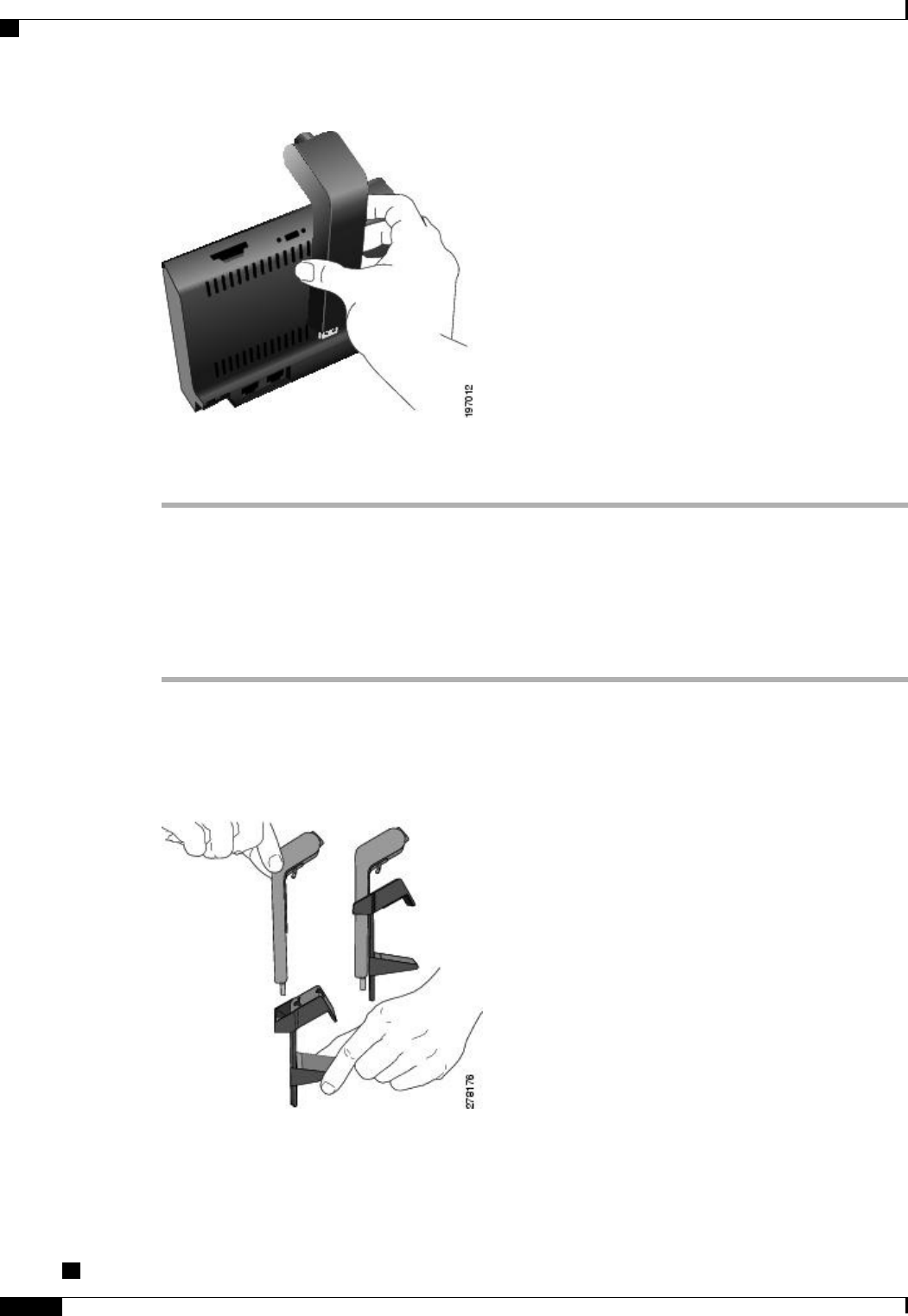
Step 4 Look for the installation confirmation message on the phone screen.
Step 5 After installation is complete, adjust the View Area and Brightness settings as needed.
Mount Camera on Monitor
Procedure
Step 1 Obtain a mounting clip and USB extension cable from your system administrator.
Step 2 Remove the protective plastic from the camera lens and body.
Step 3 Plug the USB extension cable into the USB port on the back of the phone display.
Step 4 Place the camera in the mounting clip, as shown in the following figure.
Step 5 With your phone idle (no calls), attach the USB cable to the USB connector on the bottom of the camera.
Step 6 Adjust the mounting clip as needed to rest securely on your computer monitor.
Cisco IP Phone 8811, 8841, 8845, 8851, 8851NR, 8861, and 8865 User Guide for Cisco Unified Communications
Manager 11.0
118
Cisco Unified Video Camera
Mount Camera on Monitor
REVIEW DRAFT - CISCO CONFIDENTIAL
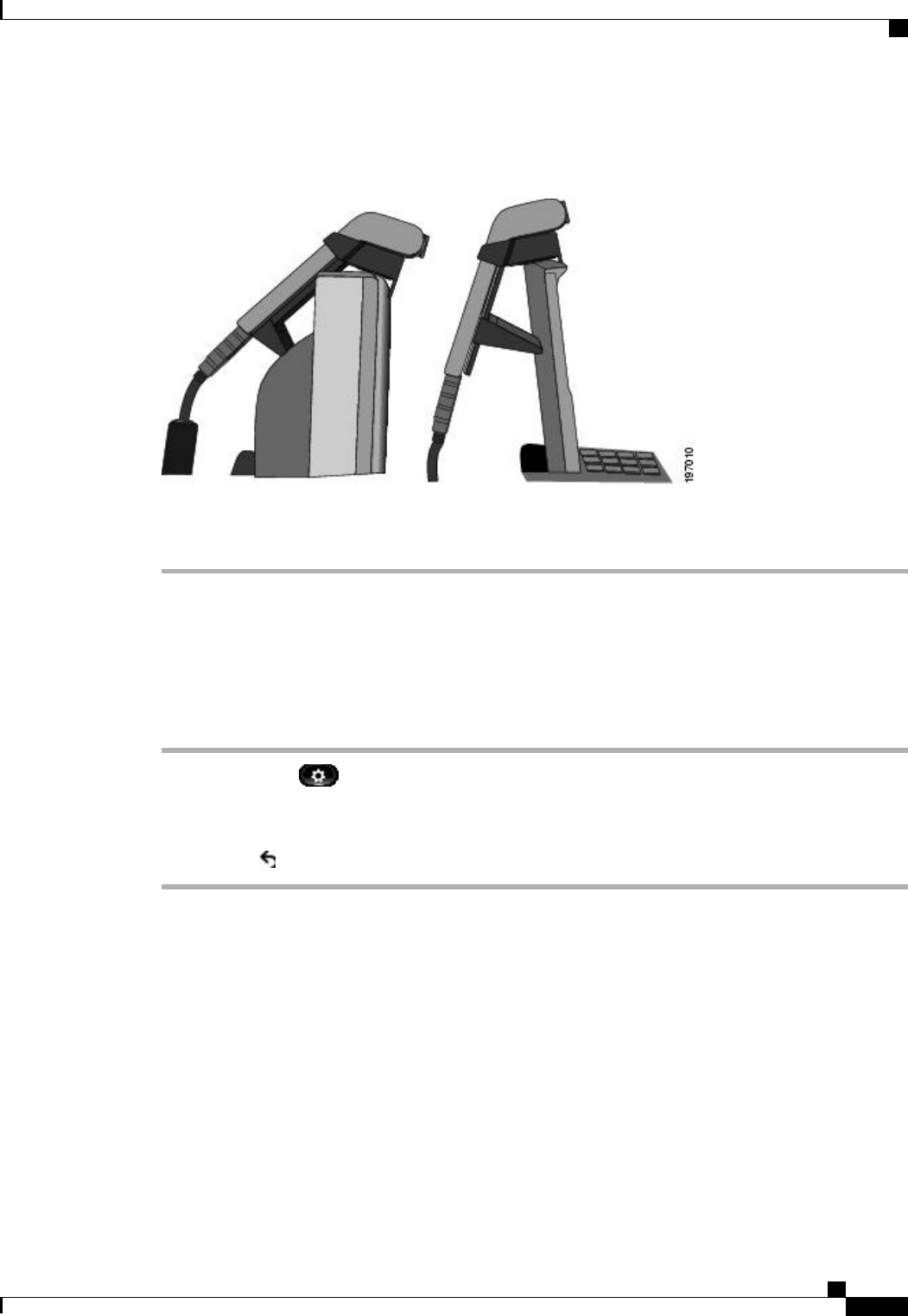
As shown in the following figure, the mounting clip has two removable sliding supports (small and large).
Choose the support that best fits your computer monitor; you can remove the remaining support.
Step 7 Look for the installation confirmation message on the phone screen.
Step 8 After installation is complete, adjust the View Area and Brightness settings as needed.
View Camera Details
Procedure
Step 1 Press Applications .
Step 2 Use the Navigation pad and Select button to scroll and select Accessories.
Step 3 Select Cisco Unified Video Camera and press Details.
Step 4 Press Return to return to the Accessories screen.
Cisco Unified Video Camera Features
The Cisco Unified Video Camera includes the following features.
Cisco IP Phone 8811, 8841, 8845, 8851, 8851NR, 8861, and 8865 User Guide for Cisco Unified Communications Manager
11.0
119
Cisco Unified Video Camera
View Camera Details
REVIEW DRAFT - CISCO CONFIDENTIAL
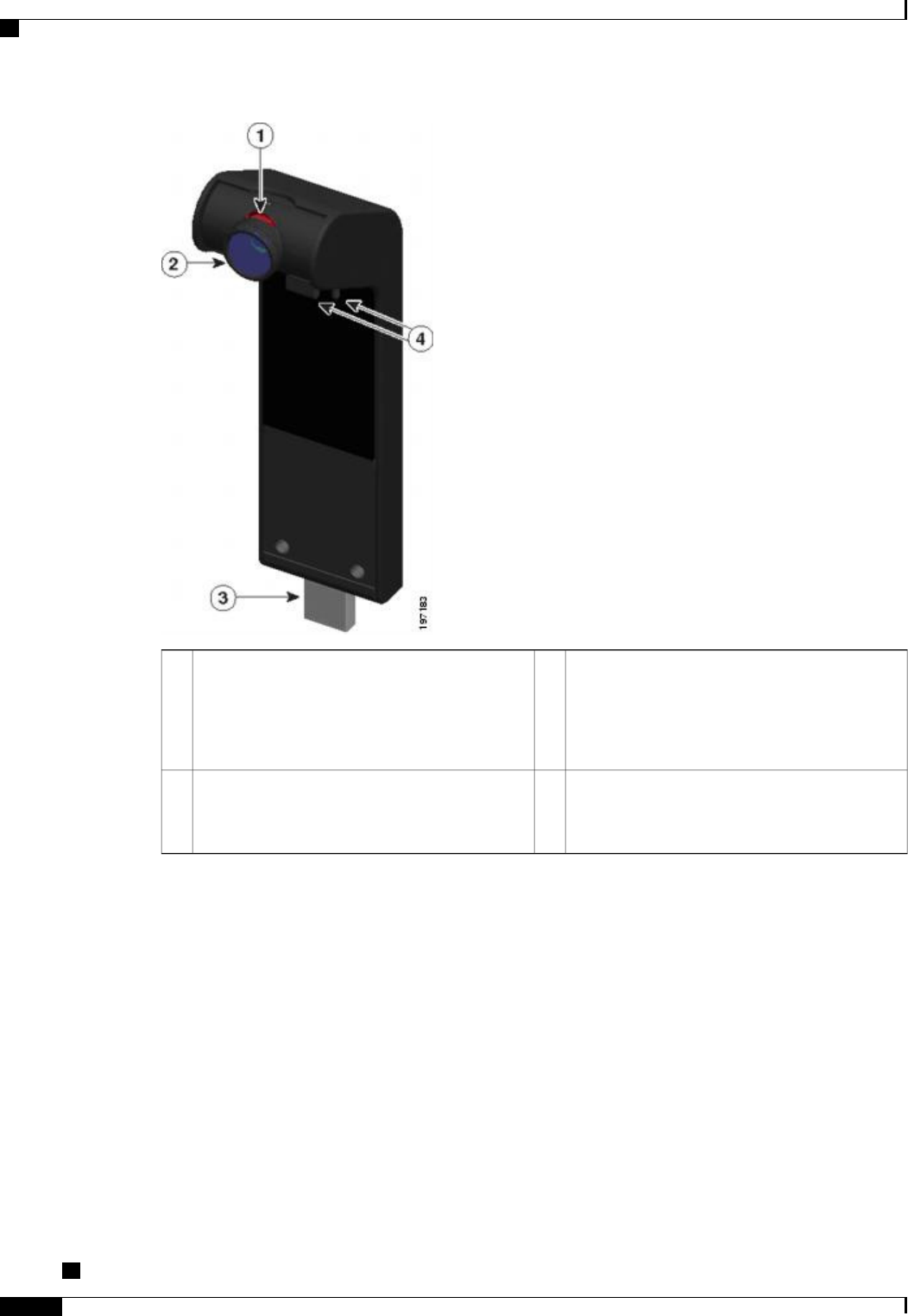
Camera lens: Swivels up and down to adjust the
camera angle. The lens shutter can close to block
video transmission.
2LED: Indicates the state of the camera as follows:
•Video transmitting—Green
•Video muted—Red
1
Mounting pins: Secures the camera to your Cisco
Unified IP Phone. The pins fit into the designated
slots on top of the phone.
4USB connector3
Camera Lens Shutter
The camera lens shutter allows you to physically block video transmission from your camera.
Cisco IP Phone 8811, 8841, 8845, 8851, 8851NR, 8861, and 8865 User Guide for Cisco Unified Communications
Manager 11.0
120
Cisco Unified Video Camera
Camera Lens Shutter
REVIEW DRAFT - CISCO CONFIDENTIAL
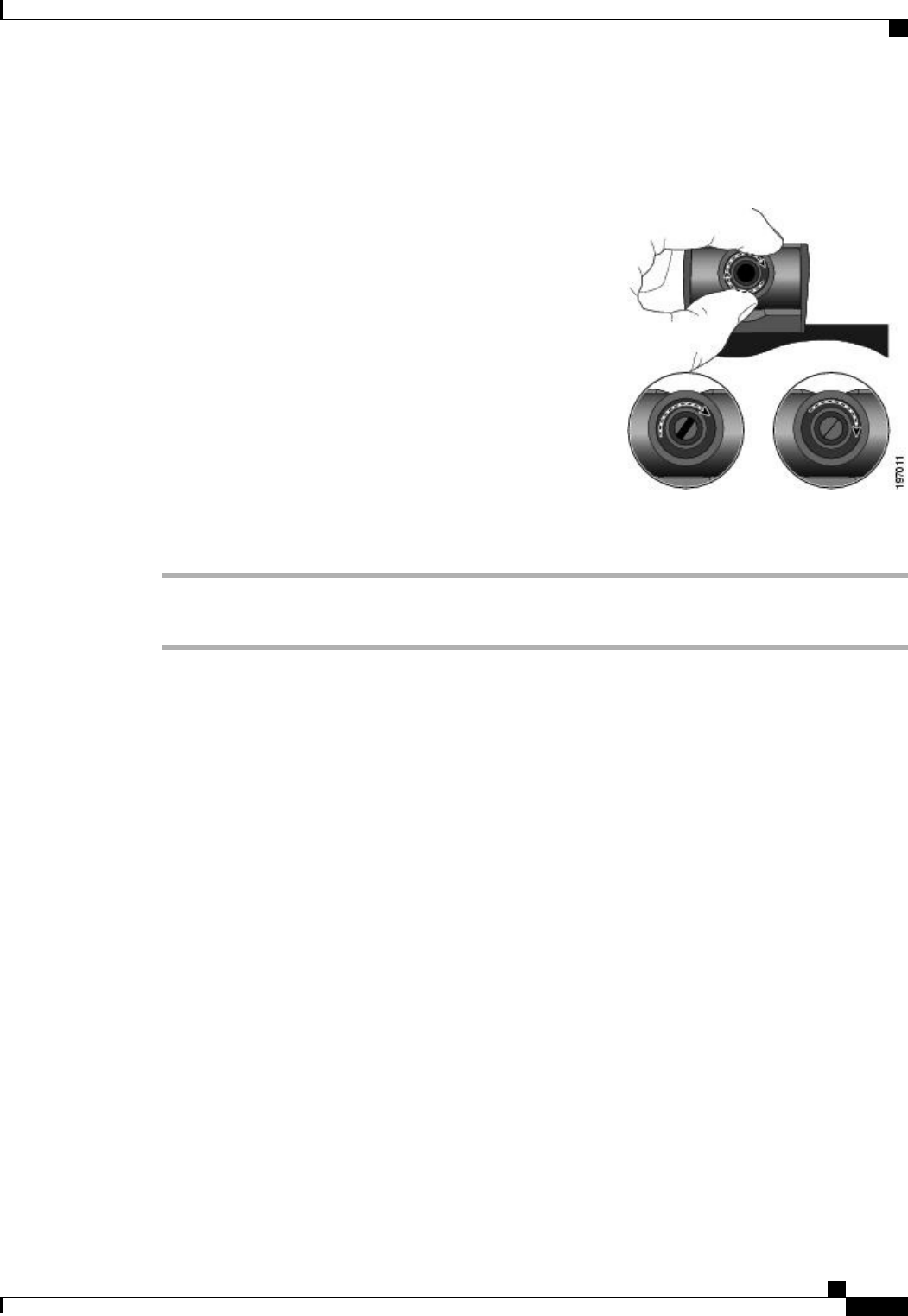
Close Camera Lens Shutter
The following figure shows the location of the camera lens shutter.
Procedure
Step 1 To close the shutter, rotate the lens clockwise.
Step 2 To open the shutter, rotate the lens counterclockwise.
Camera Preferences
Camera preferences allows you to set user preferences for the following items:
•Auto Transmit
•Brightness
•Viewing Areas
Enable Auto Transmit
When Auto Transmit Video is on, the camera streams video automatically during calls.
When Auto Transmit is off, video for each call is automatically muted (however, your phone still receives
video).
Cisco IP Phone 8811, 8841, 8845, 8851, 8851NR, 8861, and 8865 User Guide for Cisco Unified Communications Manager
11.0
121
Cisco Unified Video Camera
Close Camera Lens Shutter
REVIEW DRAFT - CISCO CONFIDENTIAL

Procedure
Step 1 Press Applications .
Step 2 Use the Navigation pad and Select button to scroll and select Accessories.
Step 3 Select Cisco Unified Video Camera.
Step 4 Press Set-up.
Step 5 Press Turn On to enable the Auto Transmit feature, or press Return to return to the Set-up screen.
Adjust Camera Brightness
The brightness setting affects the video that you transmit to others; it does not affect video that you receive
from other parties.
Because the field of view can affect brightness, adjust the View Area before adjusting the brightness.
Procedure
Step 1 Press Applications .
Step 2 Use the Navigation pad and Select button to scroll and select Accessories.
Step 3 Select Cisco Unified Video Camera.
Step 4 Select Brightness.
•To increase brightness, press the right or up arrow on the Navigation pad.
•To decrease brightness, press the left or down arrow on the Navigation pad.
Step 5 Press Save to set the brightness, or press Return to return to the Setup screen.
Adjust Camera View Area
The view area acts as a wide angle and zoom function for your camera:
•Increasing the view area allows the camera to capture a wider image field.
•Decreasing the view area acts as a zoom and narrows the image field.
Cisco IP Phone 8811, 8841, 8845, 8851, 8851NR, 8861, and 8865 User Guide for Cisco Unified Communications
Manager 11.0
122
Cisco Unified Video Camera
Adjust Camera Brightness
REVIEW DRAFT - CISCO CONFIDENTIAL

Procedure
Step 1 Press Applications .
Step 2 Use the Navigation pad and Select button to scroll and select Accessories.
Step 3 Select Cisco Unified Video Camera.
Step 4 Select View Area
•To increase the camera viewing area, press the right or up arrow on the Navigation pad.
•To decrease the camera viewing area, press the left or down arrow on the Navigation pad.
Step 5 Press Save to set the contrast, or press Return to return to the Setup screen.
Access Preview Video
Preview Video allows you to see the view from your camera when you are not in a video call. Use Preview
Video before making video calls to help set up and position your camera effectively.
Procedure
Step 1 Press More.
Step 2 Press Preview Video.
Enable Video
The Enable Video On/Off settings in the phone menu controls the ability to control the video capability of
the phone. If you enabl video, you identify the phone as being capable of sending and receiving video. If you
disable video, your calls use only audio. Your system administrator controls the ability to use video for calls.
Follow these steps to turn this feature on or off:
Procedure
Step 1 Press Applications.
Step 2 Use the navigation pad and Select button to select Preferences.
Step 3 Select Video.
Step 4 Press On/Off softkey or Select button to toggle video on or off.
Cisco IP Phone 8811, 8841, 8845, 8851, 8851NR, 8861, and 8865 User Guide for Cisco Unified Communications Manager
11.0
123
Cisco Unified Video Camera
Access Preview Video
REVIEW DRAFT - CISCO CONFIDENTIAL

Reset Camera
Procedure
Step 1 Press Applications .
Step 2 Use the Navigation pad and Select button to scroll and select Accessories.
Step 3 Select Cisco Unified Video Camera and press Reset.
The phone resets the default configuration of the Cisco Unified Video Camera.
Step 4 Press Cancel to return to the Accessories screen.
Cisco IP Phone 8811, 8841, 8845, 8851, 8851NR, 8861, and 8865 User Guide for Cisco Unified Communications
Manager 11.0
124
Cisco Unified Video Camera
Reset Camera
REVIEW DRAFT - CISCO CONFIDENTIAL

CHAPTER 11
Accessories
•Accessory List, page 125
•View the Accessories List, page 126
•View Accessories Details, page 126
•USB Devices, page 127
•Set Up Wideband for an Analog Headset, page 128
•Bluetooth Headsets, page 129
•USB Headsets, page 132
•Cisco IP Phone 8800 Key Expansion Module, page 132
Accessory List
Your phone supports accessories from Cisco and third-party manufacturers.
Cisco Accessories
XXX
—
Add-on moduleCisco IP Phone 8800 Key
Expansion Module
————
Add-on moduleCisco Unified Camera
XXXXAdd-on moduleVirtual desktop
infrastructure (VDI) client
Third-Party Accessories
Cisco IP Phone 8811, 8841, 8845, 8851, 8851NR, 8861, and 8865 User Guide for Cisco Unified Communications Manager
11.0
125
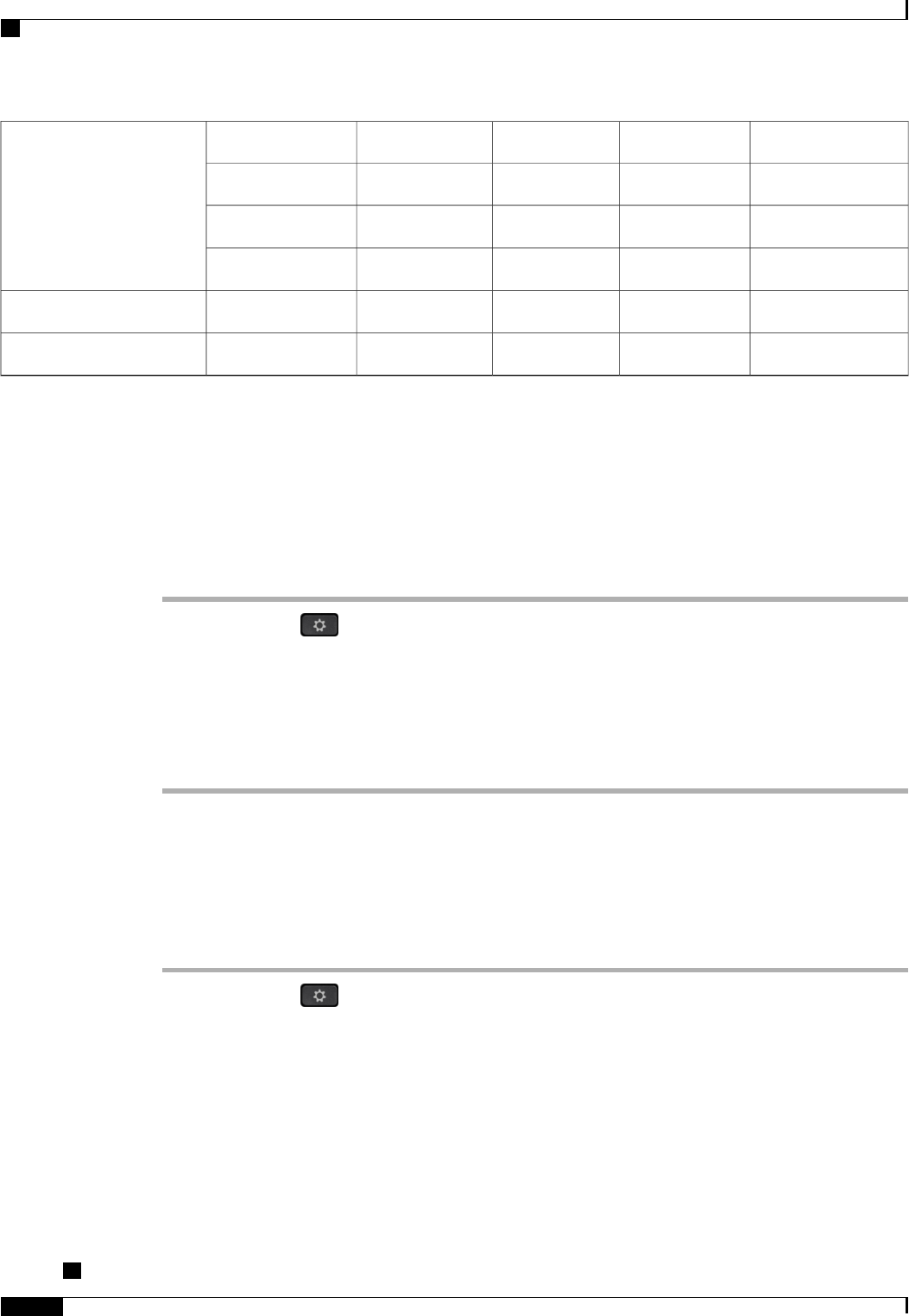
XXXXAnalogHeadset
XXXXAnalog Wideband
X
—
X
—
Bluetooth
XXX
—
USB
X
———
External PCMicrophone
X
———
External PCSpeakers
View the Accessories List
You can connect external hardware to your phone using the headjack, Bluetooth, or USB. The accessory list,
by default, contains an analog headset that can be set up to enable wideband.
Procedure
Step 1 Press Applications .
Step 2 To view most accessories, use the Navigation cluster and Select button to scroll and select Accessories.
A list of phone accessories displays.
Step 3 To view the Bluetooth accessories, use the Navigation cluster and Select button to scroll and select Bluetooth.
A list of Bluetooth accessories displays.
Step 4 Press Exit to return to the Applications screen.
View Accessories Details
Procedure
Step 1 Press Applications .
Step 2 Use the Navigation cluster and Select button to scroll and select Accessories.
A list of phone accessories displays.
Step 3 Select an accessory from list and press Show Detail.
The phone screen displays the details of selected accessory. The information displayed on the phone screen
depends on the accessory selected. Most of the accessories provide these details:
•Device Name
•Hostname
Cisco IP Phone 8811, 8841, 8845, 8851, 8851NR, 8861, and 8865 User Guide for Cisco Unified Communications
Manager 11.0
126
Accessories
View the Accessories List
REVIEW DRAFT - CISCO CONFIDENTIAL

•Device Type
•Device Service
•Firmware Version
•Paired Status (for Bluetooth devices)
•Connected Status
•Configured Status
Step 4 Press Setup to configure the selected accessory for your phone.
Step 5 Press Exit to return to the Applications screen.
USB Devices
Each USB port supports a maximum of five supported and nonsupported devices that are connected to the
phone. Each device connected to the phone is included in the maximum device count.
For example, your phone can support five USB devices on the side port and five additional standard USB
devices on the back port. Many third-party USB products contain more than one USB device, and thus count
as more than one device. For example, a third-party USB device may contain an internal hub and a headset,
and thus count as two USB devices.
If you use a USB hub and remove the USB cable from the phone or device port during an active call, it may
cause your phone or device to reboot. For more information, contact your system administrator.
Mobile Device Charging
You can use the USB port on your Cisco IP phone to charge your mobile device if the device has a USB
connection. USB charging is supported on the following ports:
•Side Port: Supports low current charging with a maximum value of 500mA charging current (2.5 Watt)
•Back Port: Supports SDP and DCP modes, with SDP supporting a maximum of 500mA charging current
and the DCP supporting fast charging with a maximum 2.1A charging current (10.5 Watt)
The back port is only available on the Cisco IP Phone 8861 and 8865.Note
Your Cisco IP phone keeps charging the mobile device while in power saving mode but stops charging in
deep sleep mode.
The USB charging feature supports the following mobile devices:
•Apple
◦iPAD 1, 2,3, and 4
◦iPAD Air
Cisco IP Phone 8811, 8841, 8845, 8851, 8851NR, 8861, and 8865 User Guide for Cisco Unified Communications Manager
11.0
127
Accessories
USB Devices
REVIEW DRAFT - CISCO CONFIDENTIAL
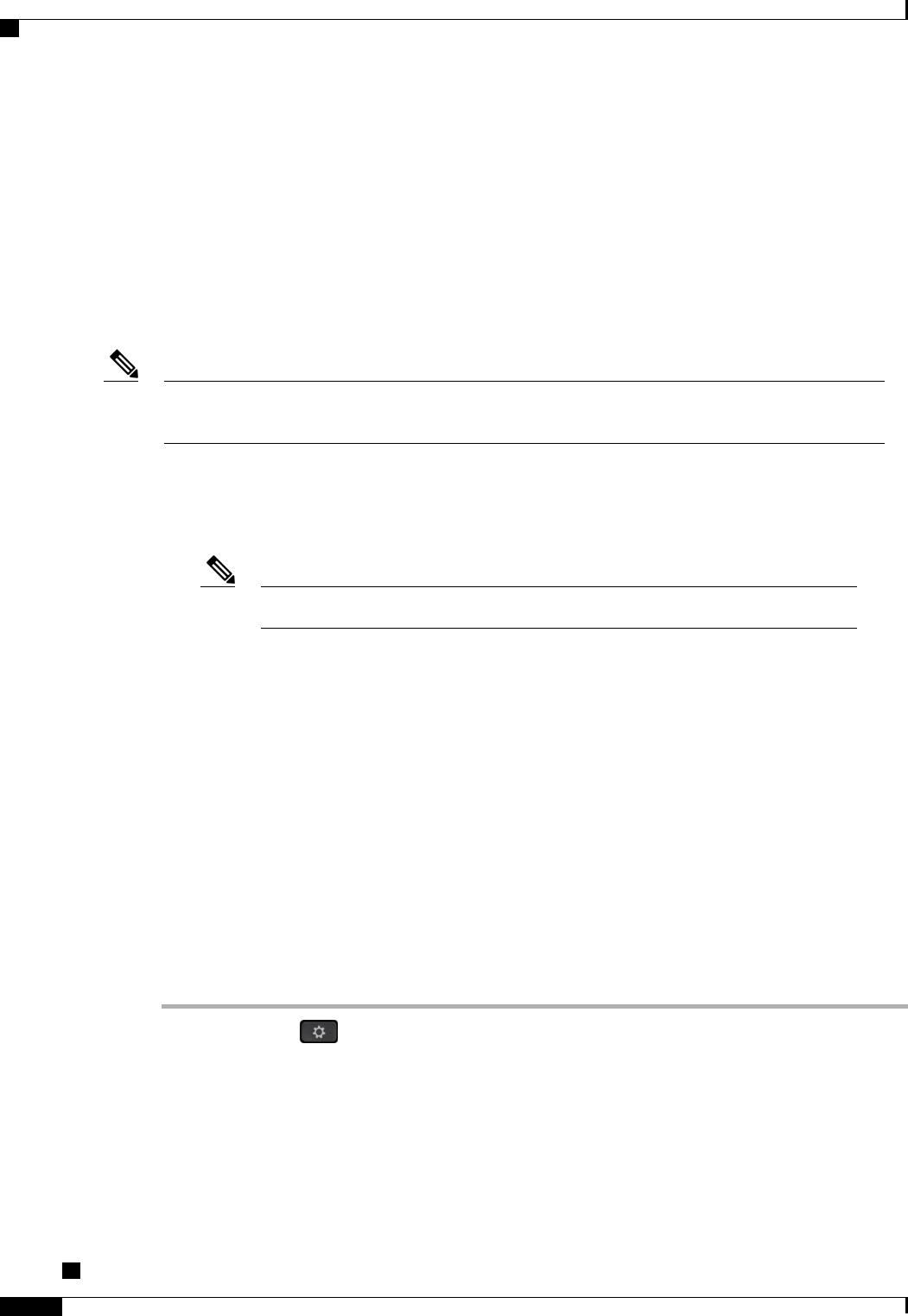
◦iPAD mini
◦iPhone 4 and iPhone 5 series
•Samsung
◦Tablet
◦Note 2 and Note 3 series
◦Galaxy S4 series
Other mobile devices are supported but there may be instances of incompatibility where they will not get
charged.
Note
When charging your mobile device using your Cisco IP Phone, the following conditions apply:
•When you plug in a tablet, it takes about 3 seconds for the charging to begin. When it gets fully charged
or nearly fully charged, the charging icon does not display and the battery capacity may decrease over
time.
You can force the charging icon to display by unplugging and re-plugging in your device.Note
•In the PoE mode, when you plug-in a tablet, it does not display the charging icon and the battery capacity
may decrease over time.
•If the battery capacity of your mobile device is lower than 90% when you plug it in, you will notice that
charging starts immediately, stops for 2 seconds, and then resumes.
•If you unplug your tablet and immediately plug-in a USB headset to the tablet, there will be a delay of
3 seconds before the phone recognizes the USB headset.
•When more than one Cisco IP Phone 8800 Key Expansion Module is attached, back USB port cannot
fast-charge the device.
Set Up Wideband for an Analog Headset
Procedure
Step 1 Press Applications .
Step 2 Use the Navigation cluster and Select button to scroll and select Accessories.
A list of phone accessories displays.
Step 3 Select Analog Headset and press Setup.
The phone screen displays the wideband status for the analog headset.
Cisco IP Phone 8811, 8841, 8845, 8851, 8851NR, 8861, and 8865 User Guide for Cisco Unified Communications
Manager 11.0
128
Accessories
Set Up Wideband for an Analog Headset
REVIEW DRAFT - CISCO CONFIDENTIAL

Step 4 Press On or Off to enable or disable wideband for the analog headset.
Step 5 Press Return to return to the Accessories screen.
Bluetooth Headsets
For Cisco IP Phone 8845, 8851, 8861 and 8865 only; Cisco IP Phone 8851NR does not support Bluetooth.
The Cisco IP Phone 8845, 8851, 8861 and 8865 support Bluetooth Class 1 technology when the headsets
support Bluetooth. Bluetooth enables low-bandwidth wireless connections within a range of 66 feet (20
meters). The best performance is in the 3- to 6-foot (1- to 2-meter) range.
When using Bluetooth headsets with your phone, these conditions apply:
•You can pair and connect up to 50 Bluetooth headsets and smart phones to your phone, but the last
Bluetooth headset or smart phone connected becomes the default for use with the phone.
•After a Bluetooth headset is connected, turning it off and on reconnects it to the phone. The following
instructions apply when using the Bluetooth headset:
◦If you have both a Bluetooth headset and an analog headset attached to the phone, only one type
of headset works at any time. Using a USB headset disables both the Bluetooth and analog headset.
◦Enable the Bluetooth headset to disable the analog headset.
◦Disable the Bluetooth headset to enable the analog headset.
◦Unplug the USB headset and then enable either the Bluetooth headset or the analog headset.
•For optimum headset coverage, use your Bluetooth headset within 10 ft of the phone, although Bluetooth
coverage extends to about 30 ft from the phone.
•Your phone supports the Bluetooth Handsfree Profile. If your Bluetooth headset supports these features,
you can perform these call functions from your Bluetooth headset:
◦Answer a call
◦End a call
◦Change the headset volume for a call
◦Redial
◦Caller ID
◦Reject
◦Divert
◦Hold and Accept
◦Release and Accept
For more information, see the documentation from your Bluetooth headset manufacturer.
Cisco IP Phone 8811, 8841, 8845, 8851, 8851NR, 8861, and 8865 User Guide for Cisco Unified Communications Manager
11.0
129
Accessories
Bluetooth Headsets
REVIEW DRAFT - CISCO CONFIDENTIAL

While using Bluetooth headset, there can be potential interference issues. Therefore Cisco recommends that
you reduce the proximity of other 802.11b/g devices, Bluetooth devices, microwave ovens, and large metal
objects.
For a Bluetooth wireless headset to work, it does not need to be within direct line-of-sight of the phone, but
some barriers, such as walls or doors, and interference from other electronic devices, can affect the connection.
Add a Bluetooth Accessory
For Cisco IP Phone 8845, 8851, 8861 and 8865 only. Cisco IP Phone 8851NR does not support Bluetooth.
Before you add a Bluetooth accessory, it must be discoverable by the phone. Look for a flashing LED on a
Bluetooth accessory as an indication that it is discoverable. For more information, see the documentation from
the Bluetooth accessory manufacturer.
Procedure
Step 1 Press Applications .
Step 2 Select Bluetooth.
Step 3 Select Add Bluetooth Accessory.
The phone searches for discoverable accessories that are supported. When an accessory is found, it is added
to the list in the Adding Bluetooth Accessory screen.
Step 4 Select the accessory and press Connect.
The phone automatically attempts to connect the accessory using a Bluetooth device PIN of “0000”.
Step 5 If your accessory requires a different PIN and the Adding PIN screen appears, enter the PIN for your accessory.
When the connection completes, a checkmark appears next to the connected accessory.
When Bluetooth is turned on, the Bluetooth active icon appears on the phone screen header.
Connect a Bluetooth Accessory
For Cisco IP Phone 8845, 8851, 8861, and 8865 only. Cisco IP Phone 8851NR does not support Bluetooth.
Before You Begin
Before you can connect a Bluetooth accessory, it must be already added as an accessory to the phone.
Procedure
Step 1 Press Applications .
Step 2 Select a Bluetooth accessory and press Connect.
When the connection completes, a checkmark appears next to the connected accessory.
Cisco IP Phone 8811, 8841, 8845, 8851, 8851NR, 8861, and 8865 User Guide for Cisco Unified Communications
Manager 11.0
130
Accessories
Add a Bluetooth Accessory
REVIEW DRAFT - CISCO CONFIDENTIAL
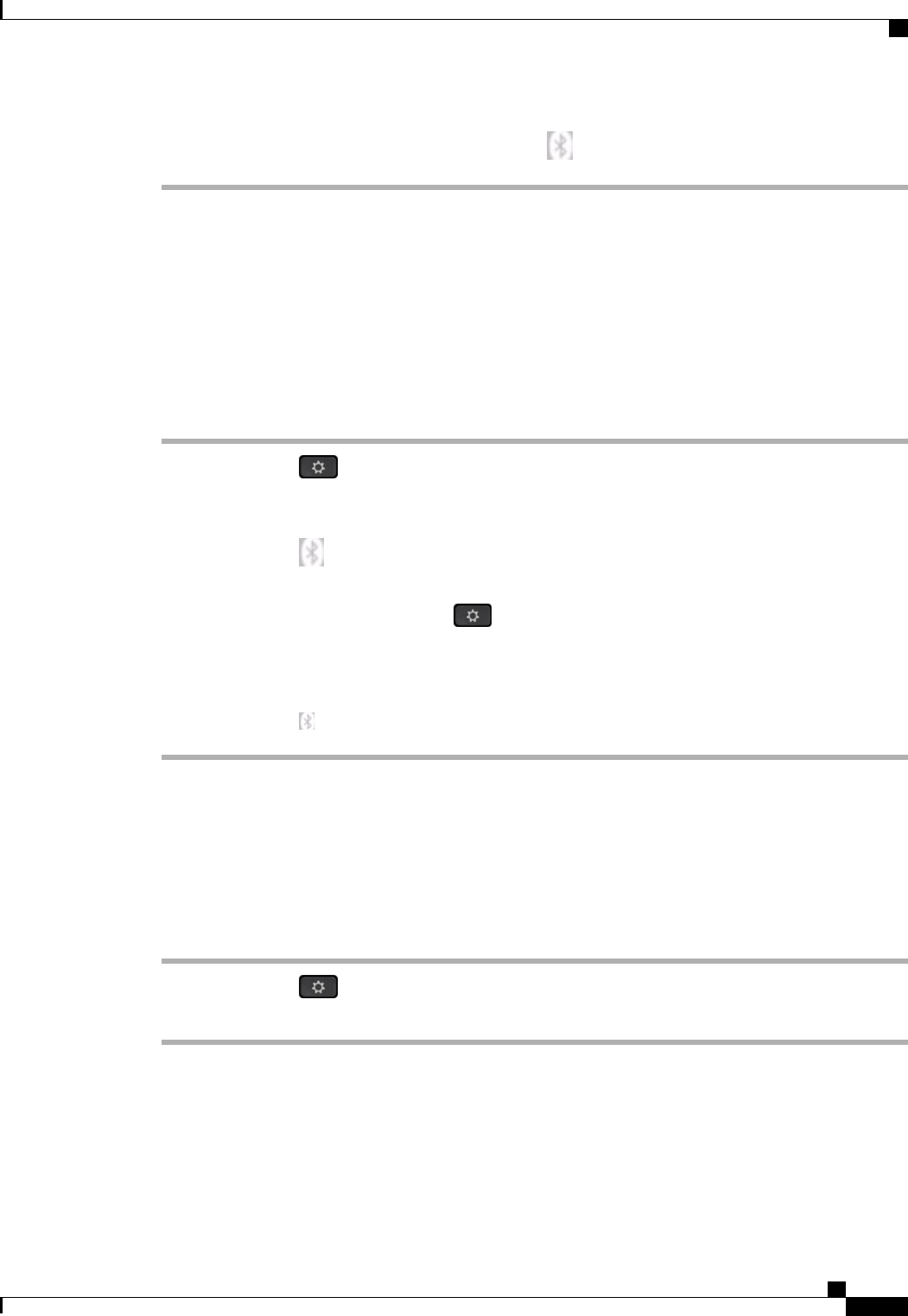
When Bluetooth is turned on, the Bluetooth active icon appears on the phone screen header.
Turn On Bluetooth
For Cisco IP Phone 8845, 8851, 8861 and 8865 only. Cisco IP Phone 8851NR does not support Bluetooth.
If your system administrator has set up the Bluetooth feature for your phone, you can turn it on and off from
your phone.
Procedure
Step 1 Press Applications .
Step 2 Use the Navigation cluster and Select button to scroll and select Bluetooth.
Step 3 Press On.
The Bluetooth icon appears on the phone screen header.
Step 4 (Optional) To add a Bluetooth accessory from this screen, select Bluetooth again and press Add Accessory.
Step 5 To turn off Bluetooth, press Applications .
Step 6 Use the Navigation pad and Select button to scroll and select Settings.
Step 7 Select Bluetooth.
Step 8 Press Off.
The Bluetooth icon disappears from the phone screen header.
Disconnect a Bluetooth Accessory
For Cisco IP Phone 8845, 8851, 8861 and 8865 only. Cisco IP Phone 8851NR does not support Bluetooth.
Procedure
Step 1 Press Applications .
Step 2 Select a Bluetooth accessory and then press Disconnect.
Delete a Bluetooth Accessory
For Cisco IP Phone 8845, 8851, 8861 and 8865 only. Cisco IP Phone 8851NR does not support Bluetooth.
Cisco IP Phone 8811, 8841, 8845, 8851, 8851NR, 8861, and 8865 User Guide for Cisco Unified Communications Manager
11.0
131
Accessories
Turn On Bluetooth
REVIEW DRAFT - CISCO CONFIDENTIAL

Procedure
Step 1 Press Applications .
Step 2 Select a Bluetooth accessory and press Delete.
The Bluetooth accessory disconnects (if it was connected) and does not display on the Accessories list.
USB Headsets
For Cisco IP Phones 8851, 8851NR, 8861 and 8865 only.
Your phone supports USB headset devices attaching to all USB ports including side USB, back USB, and
Key Expansion Module USB ports.
The following USB Headsets are supported:
•Jabra
◦PRO9400 and GO6400 series
◦PRO930, Biz2400, GN2000 series
◦Speak 450, Handset 450, and UC Voice 550
•Plantronics
◦Blackwire 600 and 400 series
◦Savi DECT 740, CS5xx DECT
◦Voyager Pro UC
USB headsets not listed above may not function properly when attached to the USB port. For more information,
see the documentation from your USB headset manufacturer.
When using USB headsets with your phone, these conditions apply:
•The priority of USB headset over Bluetooth or analog headsets depends on the connected state of the
headset (only one headset can be connected at a time).
•During a call using headset, the audio path changes automatically if you plug in a USB headset but does
not change automatically if you plug out a USB headset.
•The phone displays an appropriate message when you plug in the USB headset or adjust the volume
using the phone volume control key.
Cisco IP Phone 8800 Key Expansion Module
The Cisco IP Phone 8800 Key Expansion Module (KEM) attaches to your Cisco IP Phone 8851, 8851NR, or
Cisco IP Phone 8861 and allows you to add up to 36 extra line appearances or programmable buttons to your
Cisco IP Phone 8811, 8841, 8845, 8851, 8851NR, 8861, and 8865 User Guide for Cisco Unified Communications
Manager 11.0
132
Accessories
USB Headsets
REVIEW DRAFT - CISCO CONFIDENTIAL
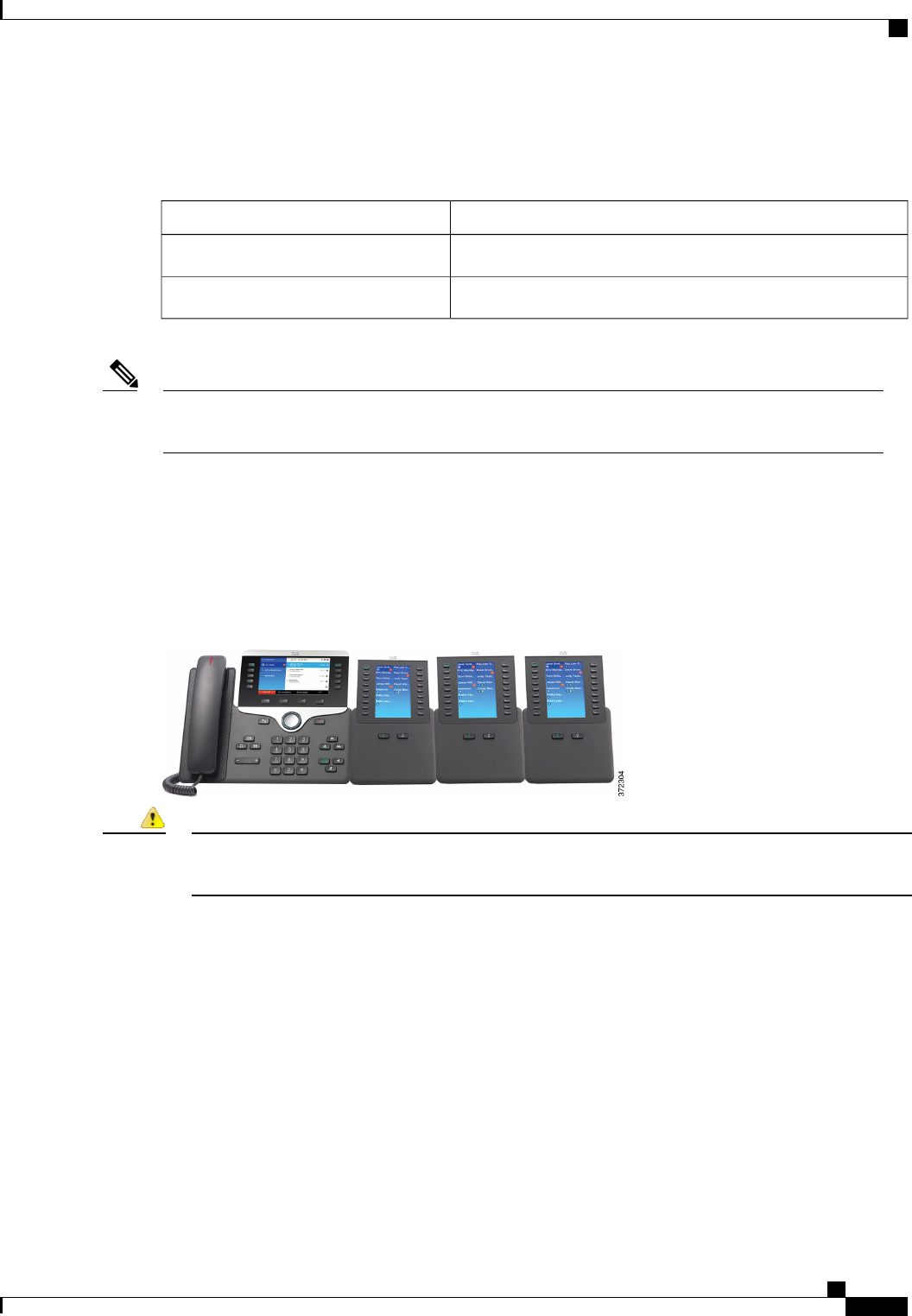
phone. The programmable buttons can be set up as phone line buttons, speed-dial buttons, or phone feature
buttons.
You can add multiple Expansion Modules to the Cisco IP Phone 8851, 8851NR, and Cisco IP Phone 8861.
Number of Expansion Modules supportedCisco Unified IP Phone model
2 Expansion Modules with 72 lines or buttons8851 and 8851NR
3 Expansion Modules with 108 lines or buttons8861
The Cisco IP Phone 8811 and Cisco IP Phone 8841 do not support the Cisco IP Phone 8800 Key Expansion
Module.
Note
When multiple KEMs are attached, they are numbered according to the order in which they are connected to
the phone. For example:
•Key Expansion Module 1 is the Expansion Module closest to the phone.
•Key Expansion Module 2 is the Expansion Module in the middle.
•Key Expansion Module 3 is the Expansion Module farthest to the right.
The following figure shows a Cisco IP Phone 8861 with three Cisco IP Phone 8800 Key Expansion Modules.
The slots in the side of the phone are designed for the KEM spine connector only. Inserting other objects
will cause permanent damage to the phone.
Attention
Cisco IP Phone 8800 Key Expansion Module Features
The Cisco IP Phone 8800 Key Expansion Module includes the following features.
Cisco IP Phone 8811, 8841, 8845, 8851, 8851NR, 8861, and 8865 User Guide for Cisco Unified Communications Manager
11.0
133
Accessories
Cisco IP Phone 8800 Key Expansion Module Features
REVIEW DRAFT - CISCO CONFIDENTIAL
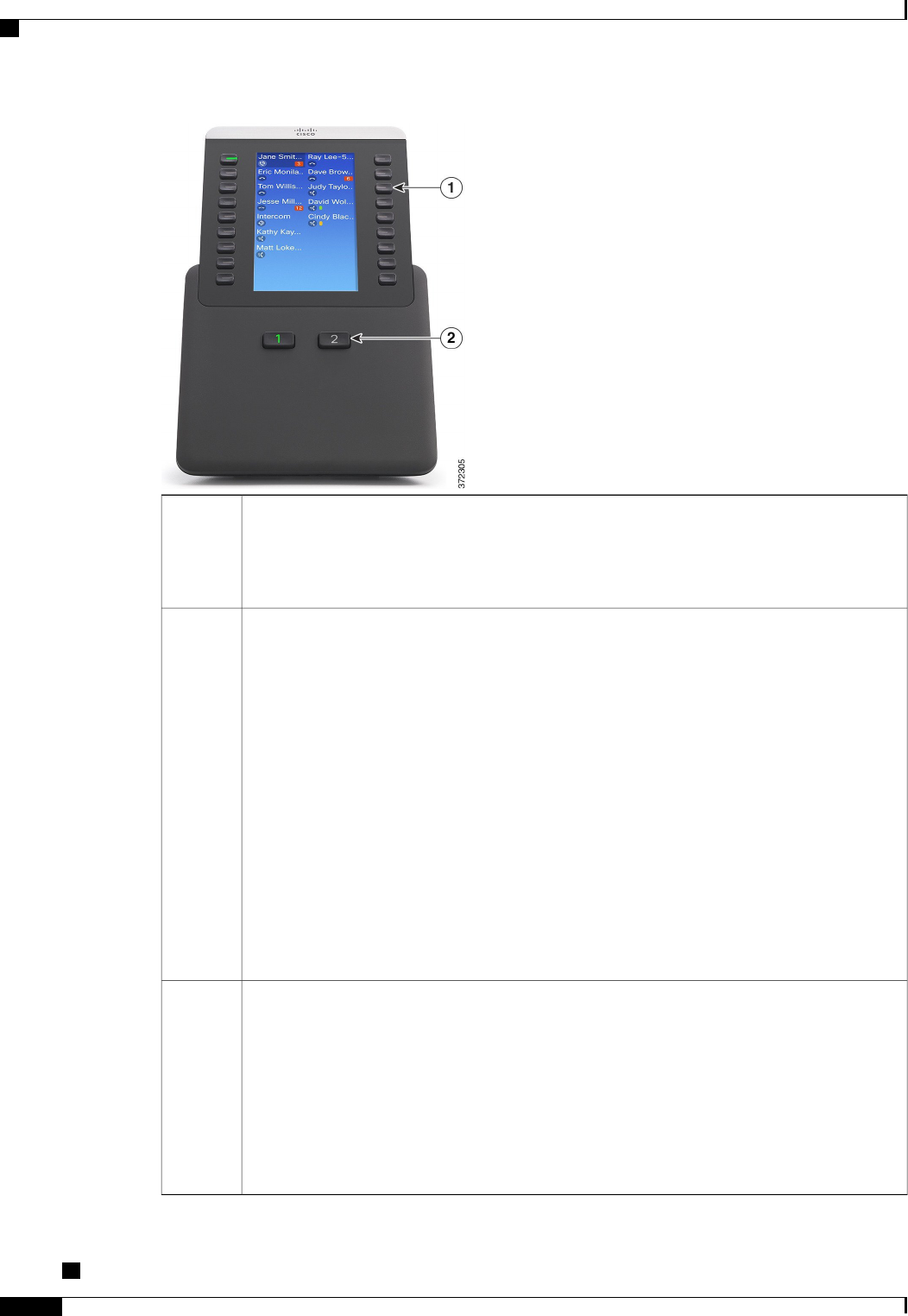
LCD screen: Displays the phone number, speed-dial number (or name or other text label), phone
service, phone feature, or Privacy assigned to each button.
Icons indicating line status appear similar to, and function the same as, those on the Cisco IP
Phone to which the Key Expansion Module is attached.
Lighted Buttons: 18 line buttons. Depending on the mode, each button or pair of buttons
corresponds to one line (as with the Cisco IP Phone). For mode information, see the description
of one-column and 2-column mode following the table. The lights beneath each button indicate
the state of the corresponding line as follows:
•Line available: light off
•Line in use by you: solid green light
•Line in use by someone else: solid red light
•Line ringing: solid amber light
•You have a call on hold: solid green light
•Someone else has a call on hold on a shared line: solid red light
•Call transfer: solid green light
•Call is ringing on an inactive page: light off
1
Shift Buttons: 2 buttons. Each button corresponds to one page of 18 line keys. The button for
page one is labeled with the number 1 and the button for page two is labeled with the number
2. The lights beneath each button indicate the state of the page as follows:
•Page is in view: solid green light
•Page is not in view: light off
•Page is not in view, with one or more alerting calls on the page: solid amber light
•Page is in view with one or more alerting calls on the page: solid green light
2
Cisco IP Phone 8811, 8841, 8845, 8851, 8851NR, 8861, and 8865 User Guide for Cisco Unified Communications
Manager 11.0
134
Accessories
Cisco IP Phone 8800 Key Expansion Module Features
REVIEW DRAFT - CISCO CONFIDENTIAL
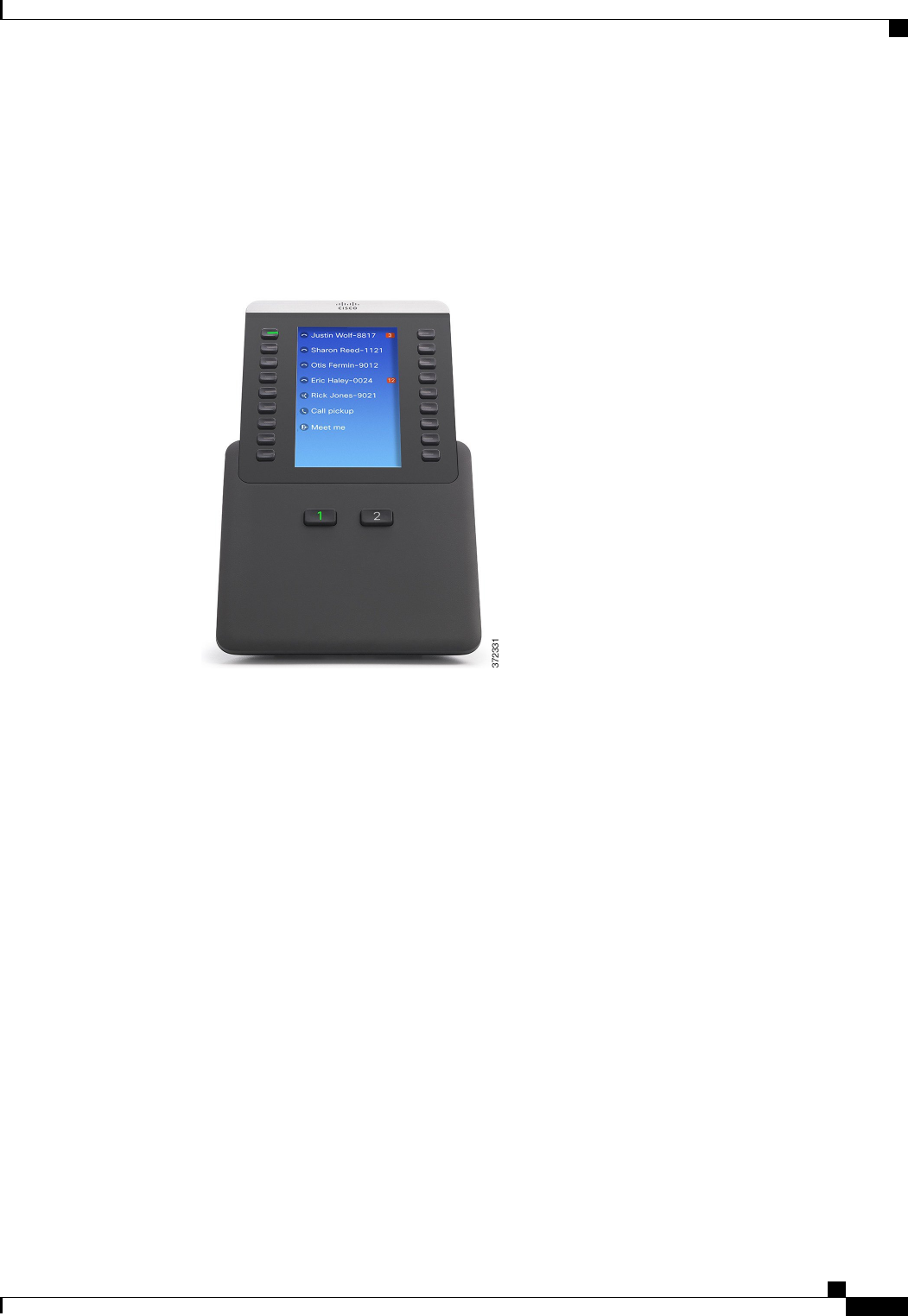
Your administrator sets up the Key Expansion Module to display in one-column or two-column mode.
One-column mode
In one-column mode, each row in the display corresponds to one line, and this line can be accessed by
either the button on the left or the button on the right. In this configuration, the Key Expansion Module
displays 9 lines on page 1, and 9 lines on page 2. The following graphic shows the one-column mode.
Cisco IP Phone 8811, 8841, 8845, 8851, 8851NR, 8861, and 8865 User Guide for Cisco Unified Communications Manager
11.0
135
Accessories
Cisco IP Phone 8800 Key Expansion Module Features
REVIEW DRAFT - CISCO CONFIDENTIAL
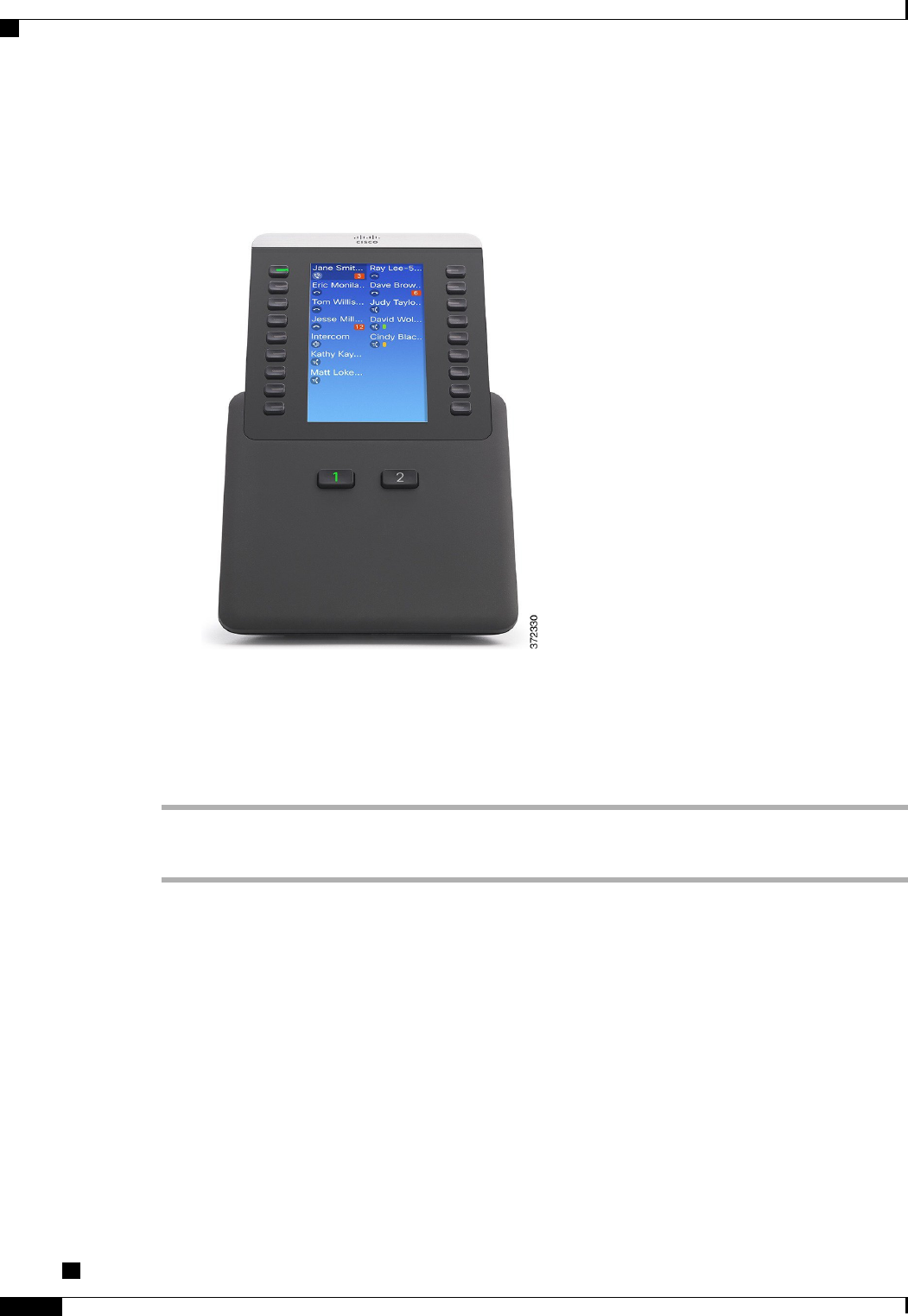
Two-column mode
In two-column mode, each of the buttons on the left and right of the screen is assigned to different lines.
In this configuration, the Key Expansion Module displays 18 lines on page 1, and 18 lines on page 2.
The following graphic shows the two-column mode.
Place a Call on the Key Expansion Module
Procedure
Step 1 Press the line button on the Key Expansion Module.
Step 2 Dial a telephone number.
Configure KEM Buttons
Before you can set up KEM buttons, contact your system administrator for the following information to access
your Self Care Portal:
•URL
•username and password
After you have this information, you can configure your speed-dial numbers or program buttons to access
phone services. Phone services can include, for example, weather, stock quotes, or corporate calendars and
directories.
Cisco IP Phone 8811, 8841, 8845, 8851, 8851NR, 8861, and 8865 User Guide for Cisco Unified Communications
Manager 11.0
136
Accessories
Place a Call on the Key Expansion Module
REVIEW DRAFT - CISCO CONFIDENTIAL

Adjust Key Expansion Module Brightness
Procedure
Step 1 Press Applications on the phone.
Step 2 Use the Navigation pad and Select to scroll and select Settings.
Step 3 Select Brightness.
Step 4 Select Key Expansion Module.
Step 5 If required, select the KEM number.
Step 6 Adjust brightness.
•To increase brightness, press the right arrow on the Navigation pad.
•To decrease brightness, press the left arrow on the Navigation pad.
Step 7 Press Save to set the brightness, or press Cancel to exit.
Cisco IP Phone 8811, 8841, 8845, 8851, 8851NR, 8861, and 8865 User Guide for Cisco Unified Communications Manager
11.0
137
Accessories
Adjust Key Expansion Module Brightness
REVIEW DRAFT - CISCO CONFIDENTIAL

Cisco IP Phone 8811, 8841, 8845, 8851, 8851NR, 8861, and 8865 User Guide for Cisco Unified Communications
Manager 11.0
138
Accessories
Adjust Key Expansion Module Brightness
REVIEW DRAFT - CISCO CONFIDENTIAL

CHAPTER 12
Frequently Asked Questions
•Why Can't I See All Active Calls on My Phone?, page 140
•How Do I Redirect an Incoming Call?, page 140
•How Do I Silence a Ringing Call If I'm On a Call?, page 140
•How Do I Resume a Call That is On Hold?, page 140
•What Is the Difference Between Buttons on the Left and Those on the Right of the Screen?, page 141
•Why Do Softkeys Keep Changing?, page 141
•What Is the Best Way to Look at Calls When I Have a Shared Line or Multiple Lines?, page 141
•What Should I Do If I Accidentally Press a Button While on a Call?, page 142
•How Do I Check Missed Calls?, page 142
•How Do I Exit from a Running Application?, page 142
•How Do I Connect Two Calls and then Drop from the Line Myself?, page 143
•What Does the Swap Softkey Do?, page 143
•How Do I Cancel a Conference or Transfer After I Start It?, page 143
•How Can I Combine Two Calls Into a Single Conference Call? , page 144
•Why Does My Phone Not Wake Up?, page 144
•What Do Four Rings in Succession Mean?, page 144
•Where Should I Mount My Cisco Unified Video Camera?, page 145
•How Can I Prevent Theft of my Cisco Unified Video Camera?, page 145
•Why Do Some Calls Not Present Video On My Video Phone?, page 145
•What Happens to Video When I Put a Call On Hold?, page 146
•What Do the Light Colors on My Cisco Unified Video Camera Indicate?, page 146
•How Do I Close the Shutter on my Cisco Unified Video Camera?, page 146
•Why Does the Video on my Cisco Unifed Video Camera Appear Too Dark?, page 146
Cisco IP Phone 8811, 8841, 8845, 8851, 8851NR, 8861, and 8865 User Guide for Cisco Unified Communications Manager
11.0
139

Why Can't I See All Active Calls on My Phone?
Question
Why can't I see all the active calls on my phone?
Answer
When there are more calls than available session buttons on the phone, you can scroll to see them. Calls are
sorted from oldest to newest, with the oldest call at the top of the list.
How Do I Redirect an Incoming Call?
Question
How do I redirect an incoming call when I am on a call?
Answer
To redirect an incoming (ringing) call while on another call, highlight the incoming call, and then press
Decline. Otherwise press Decline to redirect the current, active call.
How Do I Silence a Ringing Call If I'm On a Call?
Question
How do I silence a ringing call, if I'm on a call?
Answer
You can silence the incoming (ringing) call. Press Volume down once, and then let the incoming call go to
the target number (voice mail or predetermined number set up the system administrator).
How Do I Resume a Call That is On Hold?
Question
How do I resume a call that is on hold?
Answer
To resume a call on hold, you can use any of the following methods:
•Press the pulsing green session button.
•Press the call session on the phone display.
Cisco IP Phone 8811, 8841, 8845, 8851, 8851NR, 8861, and 8865 User Guide for Cisco Unified Communications
Manager 11.0
140
Frequently Asked Questions
Why Can't I See All Active Calls on My Phone?
REVIEW DRAFT - CISCO CONFIDENTIAL

•Press Resume.
•Highlight the call by using the Navigation cluster and press Select button.
•Press Hold.
What Is the Difference Between Buttons on the Left and Those
on the Right of the Screen?
Question
What is the difference between the buttons on the left and those on the right of the screen?
Answer
Your phone has feature buttons on the left and call session buttons on the right. Use the feature buttons to
access features (such as speed dial) or select a phone line. Use call session buttons to perform call-related
tasks, such as making a new call, resuming a held call, or checking your voicemail. The positions of the session
buttons and feature buttons can be reversed on phones that use a locale with a right-to-left reading orientation,
such as Hebrew and Arabic.
Why Do Softkeys Keep Changing?
Question
Why do the softkeys keep changing?
Answer
Softkeys act on the selected (highlighted) call or menu item only. The softkeys that display depend on the
call or item you have selected.
What Is the Best Way to Look at Calls When I Have a Shared
Line or Multiple Lines?
Question
What is the best way to look at calls when I have a shared line or multiple lines?
Answer
If you have a shared line or multiple lines, it is recommended that you use the All Calls feature to view calls.
When you press the All Calls button (on the left), all calls for all your lines are listed on the phone screen in
chronological order (oldest first). If you do not have an All Calls button, contact your system administrator
to set up this feature. Your administrator can also set up your primary line key to act the same as the All Calls
button.
Cisco IP Phone 8811, 8841, 8845, 8851, 8851NR, 8861, and 8865 User Guide for Cisco Unified Communications Manager
11.0
141
Frequently Asked Questions
What Is the Difference Between Buttons on the Left and Those on the Right of the Screen?
REVIEW DRAFT - CISCO CONFIDENTIAL

What Should I Do If I Accidentally Press a Button While on a
Call?
Question
What should I do if I accidentally press a button while on a call?
Answer
If you are on a call and press a button for another line, your line view will change. Your current call disappears
from view and calls for the newly selected line are displayed. To redisplay the call you are on, select the line
that it is on, press All Calls, or, press the Primary line key if it is set up by your administrator to display all
calls.
How Do I Check Missed Calls?
Question
How do I check missed calls on my phone?
Answer
To check missed calls on your phone:
•Press Applications , select Recents, and press Missed Calls.
•Press All Calls, and then press Missed Calls.
How Do I Exit from a Running Application?
Question
How do I exit from a running application?
Answer
To exit from a running applications you must:
1Press Applications .
2Scroll and select Running Applications.
3Select a running application and press Close App to close the application.
When prompted, save your changes.
4Press Exit to end the running application.
If you do not exit a running application, it continues to run in the background.
Cisco IP Phone 8811, 8841, 8845, 8851, 8851NR, 8861, and 8865 User Guide for Cisco Unified Communications
Manager 11.0
142
Frequently Asked Questions
What Should I Do If I Accidentally Press a Button While on a Call?
REVIEW DRAFT - CISCO CONFIDENTIAL

How Do I Connect Two Calls and then Drop from the Line
Myself?
Question
How do I connect two calls and then drop from the line myself?
Answer
When you are on an active call (not on hold), do the following:
1Press Transfer and enter the transfer recipient’s phone number in one of these ways:
•Press the session button of a held call.
•Enter the transfer recipient’s phone number.
•Scroll to a Call History record and press Call.
•Press a speed-dial button.
•Press Speed Dial, enter a speed-dial number or highlight the number you want to call, and press
Speed Dial again.
•Press Active Calls and select a held call. The transfer completes immediately.
2Press Transfer again. You do not have to wait for the recipient to answer to complete the transfer.
What Does the Swap Softkey Do?
Question
What does the Swap softkey do?
Answer
The Swap softkey allows you to toggle between two calls before completing the transfer or creating a
conference. This allows you to consult privately with the party or parties on each call before combining the
calls into a conference.
How Do I Cancel a Conference or Transfer After I Start It?
Question
Can I cancel a conference or transfer procedure after I have started it?
Cisco IP Phone 8811, 8841, 8845, 8851, 8851NR, 8861, and 8865 User Guide for Cisco Unified Communications Manager
11.0
143
Frequently Asked Questions
How Do I Connect Two Calls and then Drop from the Line Myself?
REVIEW DRAFT - CISCO CONFIDENTIAL

Answer
Yes, before completing a conference or transfer, you can press Release or Cancel to cancel it.
How Can I Combine Two Calls Into a Single Conference Call?
Question
How can I combine two calls on hold into a single conference call?
Answer
Make sure that one of the calls is active (not on hold). If both calls are on hold, resume one cal, and then:
1Press Conference .
2Press the line button for the other (held) call.
The conference begins. The conference is established on the line that had the active call.
Why Does My Phone Not Wake Up?
Question
Why does my phone not work “wake up”when it worked before?
Answer
If your system administrator has set up your phone for EnergyWise, the phone may be sleeping (powered
down). Your system administrator sets your phone to sleep at a certain time and wake (power up) at a certain
time. Your phone wakes up at the time your system administrator configured. You can press the Select button
to wake your phone up. Contact your system administrator to have the sleep and wake up times changed.
What Do Four Rings in Succession Mean?
Question
My phone played the ring tone four times in succession, but there is no call. What does this mean?
Answer
The phone is notifying you that your phone will power down (sleep) soon to conserve energy (the EnergyWise
feature). Your system administrator sets your phone to sleep at a certain time and wakes (power up) at a certain
time. Your phone wakes up at the time your system administrator configured, or you can press Select to wake
it up. Contact your system administrator to have the sleep and wake up times changed.
Cisco IP Phone 8811, 8841, 8845, 8851, 8851NR, 8861, and 8865 User Guide for Cisco Unified Communications
Manager 11.0
144
Frequently Asked Questions
How Can I Combine Two Calls Into a Single Conference Call?
REVIEW DRAFT - CISCO CONFIDENTIAL

Where Should I Mount My Cisco Unified Video Camera?
Question
Should I mount my Cisco Unified Video Camera on my phone or on my computer monitor?
Answer
For casual video calling, a camera mounted directly on the phone is recommended. If you plan to turn to face
your computer monitor often (for example, if you are presenting slides), a camera mounted on monitor might
be preferable. Experiment with both and see what works best for you.
If you prefer to mount your camera on your computer monitor, ask your system administrator for a camera
mounting clip and USB extension cable.
How Can I Prevent Theft of my Cisco Unified Video Camera?
Question
How can I keep my Cisco Unified Video Camera secure to prevent theft?
Answer
If you are concerned about theft, you can place the camera in a locked drawer when not in use. If you plan to
remove the camera regularly for this reason, consider attaching the camera to a USB extension cable (available
from your system administrator) rather than mounting the camera directly on the phone.
Connecting and disconnecting the camera is easy and neither resets the phone nor disrupts the audio portion
of an active call. However, you may find connecting and disconnecting the camera easier if a USB cable is
used rather than directly removing and reattaching the camera to the phone.
Note that the Cisco wall mount kit contains a security mechanism which locks the camera to the phone.
Why Do Some Calls Not Present Video On My Video Phone?
Question
Why do not all calls display video on my phone?
Answer
To see an image of the other party on your phone screen, the other party’s phone must support video and the
other party must have a camera installed and enabled on the phone. During conference calls, the conference
system used during the call must support video conferencing.
Cisco IP Phone 8811, 8841, 8845, 8851, 8851NR, 8861, and 8865 User Guide for Cisco Unified Communications Manager
11.0
145
Frequently Asked Questions
Where Should I Mount My Cisco Unified Video Camera?
REVIEW DRAFT - CISCO CONFIDENTIAL

What Happens to Video When I Put a Call On Hold?
Question
What happens to video when I put a call on hold?
Answer
Video transmission is muted (blocked) until you resume the call.
What Do the Light Colors on My Cisco Unified Video Camera
Indicate?
Question
What do the different light colors on my Cisco Unified Video Camera indicate?
Answer
The colors indicate video transmission states as follows:
•Green: Your video is transmitting.
•Red: Your video is muted.
How Do I Close the Shutter on my Cisco Unified Video Camera?
Question
How can I close the shutter on my Cisco Unified Video Camera?
Answer
Close the camera shutter by rotating the camera lens clockwise. Rotate counter-clockwise to open the shutter
again
Why Does the Video on my Cisco Unifed Video Camera Appear
Too Dark?
Question
Why does video from my Cisco Unified Video Camera appear too dark (or too light)?
Cisco IP Phone 8811, 8841, 8845, 8851, 8851NR, 8861, and 8865 User Guide for Cisco Unified Communications
Manager 11.0
146
Frequently Asked Questions
What Happens to Video When I Put a Call On Hold?
REVIEW DRAFT - CISCO CONFIDENTIAL

Answer
Lighting conditions (such as windows and ceiling lights) within the camera field of view affect the brightness.
Try moving the camera to see if the brightness improves. You can also adjust the brightness setting.
Cisco IP Phone 8811, 8841, 8845, 8851, 8851NR, 8861, and 8865 User Guide for Cisco Unified Communications Manager
11.0
147
Frequently Asked Questions
Why Does the Video on my Cisco Unifed Video Camera Appear Too Dark?
REVIEW DRAFT - CISCO CONFIDENTIAL

Cisco IP Phone 8811, 8841, 8845, 8851, 8851NR, 8861, and 8865 User Guide for Cisco Unified Communications
Manager 11.0
148
Frequently Asked Questions
Why Does the Video on my Cisco Unifed Video Camera Appear Too Dark?
REVIEW DRAFT - CISCO CONFIDENTIAL

CHAPTER 13
Troubleshooting
•Missing Alert Calls Button, page 149
•Missing All Calls Button, page 149
•Missing Mobile and Remote Access through Expressway Sign-in Window, page 150
•Cannot Sign In to Personal Directory, page 150
•Cannot Access Self Care Portal, page 151
•Security Error Message, page 151
•Report Phone Problems, page 151
•Documentation, Service Requests, and Additional Information, page 152
Missing Alert Calls Button
Issue
I would like to use the Alert Calls button but it is not on my phone.
Possible Cause
It has not been set up by your system administrator.
Solution
Contact your system administrator to enable the Alert Calls feature for you.
Missing All Calls Button
Issue
I would like to use the All Calls button, but it is not on my phone.
Cisco IP Phone 8811, 8841, 8845, 8851, 8851NR, 8861, and 8865 User Guide for Cisco Unified Communications Manager
11.0
149

Possible Cause
It has not been set up by your system administrator or your system administrator may have set up your phone
so that the primary line button performs the All Calls function.
Solution
Contact your system administrator to enable the All Calls feature for you or check with your administrator
about the primary line button functionality.
Missing Mobile and Remote Access through Expressway
Sign-in Window
Issue
The Mobile and Remote Access through Expressway sign-in window did not appear on my phone.
Possible Cause
The DHCP setting is enabled on your network router.
Solution
Check your network router settings and, if necessary, disable the DHCP setting and configure the static IP on
the phone directly. Contact your administrator for assistance.
Cannot Sign In to Personal Directory
Problem
You are unable to sign in to your personal directory.
Possible Cause
•You are using your password to sign in, not your personal identification number (PIN).
•Your PIN needs to be reset.
Solution
•Use your PIN, not your password.
•Contact your system administrator.
Cisco IP Phone 8811, 8841, 8845, 8851, 8851NR, 8861, and 8865 User Guide for Cisco Unified Communications
Manager 11.0
150
Troubleshooting
Missing Mobile and Remote Access through Expressway Sign-in Window
REVIEW DRAFT - CISCO CONFIDENTIAL

Cannot Access Self Care Portal
Problem
You are unable to access your Self Care Portal.
Possible Cause
Your password needs to be reset or your administrator may have changed your access to the pages.
Solution
Contact your system administrator.
Security Error Message
Problem
Your phone displays Security Error.
Cause
Your phone firmware has identified an internal error.
Solution
If the message persists, contact your system administrator.
Report Phone Problems
Your system administrator may temporarily configure your phone with the Quality Reporting Tool (QRT) to
troubleshoot performance problems. Depending on configuration, use the QRT to:
•Immediately report an audio problem on a current call.
•Select a general problem from a list of categories and choose reason codes.
Procedure
Step 1 Press Report Quality.
Step 2 Scroll and select the item that closely matches your problem.
Step 3 Press the Select softkey.
The information is sent to your system administrator.
Cisco IP Phone 8811, 8841, 8845, 8851, 8851NR, 8861, and 8865 User Guide for Cisco Unified Communications Manager
11.0
151
Troubleshooting
Cannot Access Self Care Portal
REVIEW DRAFT - CISCO CONFIDENTIAL

Documentation, Service Requests, and Additional Information
For information about how to obtain documentation, submit a service request, and gather additional information,
see the monthly What’s New in Cisco Product Documentation, which also lists all new and revised Cisco
technical documentation, at http://www.cisco.com/c/en/us/td/docs/general/whatsnew/whatsnew.html.
Subscribe to the What’s New in Cisco Product Documentation as a Really Simple Syndication (RSS) feed
and set content to be delivered directly to your desktop using a reader application. The RSS feeds are a free
service and Cisco currently supports RSS Version 2.0.
Cisco IP Phone 8811, 8841, 8845, 8851, 8851NR, 8861, and 8865 User Guide for Cisco Unified Communications
Manager 11.0
152
Troubleshooting
Documentation, Service Requests, and Additional Information
REVIEW DRAFT - CISCO CONFIDENTIAL

CHAPTER 14
Product Safety and Security
•Safety and Performance Information, page 153
•FCC Compliance Statements, page 154
•Cisco Product Security Overview, page 155
Safety and Performance Information
Power Outage
Power outages and other devices can affect your Cisco IP Phone.
Your access to emergency service through the phone requires that the phone receive power. If a power
interruption occurs, Service and Emergency Calling Service dialing will not function until power is restored.
In case of a power failure or disruption, you may need to reset or reconfigure the equipment before you can
use the Service or Emergency Calling Service dialing.
External Devices
We recommend using good-quality external devices, such as headsets, cables, and connectors, that are shielded
against unwanted radio frequency (RF) and audio frequency (AF) signals.
Not all Cisco IP Telephony products support external devices, cords or cables. For more information,
consult the documentation for your endpoint.
Note
Depending on the quality of these devices and their proximity to other devices, such as mobile phones or
two-way radios, some audio noise may still occur. In these cases, Cisco recommends that you take one or
more of these actions:
•Move the external device away from the source of the RF or AF signals.
•Route the external device cables away from the source of the RF or AF signals.
Cisco IP Phone 8811, 8841, 8845, 8851, 8851NR, 8861, and 8865 User Guide for Cisco Unified Communications Manager
11.0
153

•Use shielded cables for the external device, or use cables with a better shield and connector.
•Shorten the length of the external device cable.
•Apply ferrites or other such devices on the cables for the external device.
Cisco cannot guarantee the performance of external devices, cables, and connectors.
In European Union countries, use only external speakers, microphones, and headsets that are fully compliant
with the EMC Directive [89/336/EC].
Caution
Bluetooth Wireless Headset Performance
The Cisco IP Phones support Bluetooth Class 2 technology when the headsets support Bluetooth. Bluetooth
enables low-bandwidth wireless connections within a range of 30 feet (10 meters). The best performance is
in the 3- to 6-foot (1- to 2-meter) range. You can connect up to five headsets, but only the last one connected
is used as the default.
Because there can be potential interference issues, Cisco recommends that you move 802.11b/g devices,
Bluetooth devices, microwave ovens, and large metal objects away from the wireless headset.
For a Bluetooth wireless headset to work, it does not need to be within direct line-of-sight of the phone, but
some barriers, such as walls or doors, and interference from other electronic devices, can affect the connection.
Power Information
Connect your Cisco IP phone to your LAN using a CAT 5e Ethernet cable to enable full functionality of your
Cisco IP phone. If your Ethernet port is equipped with Power over Ethernet (PoE), your Cisco IP phone can
be powered through the LAN port. Do not extend the LAN Ethernet cable outside the building.
FCC Compliance Statements
The Federal Communications Commission requires compliance statements for the following:
FCC Part 15.21 Statement
Changes or modifications not expressly approved by the party responsible for compliance could void the
user’s authority to operate the equipment.
FCC RF Radiation Exposure Statement
This equipment complies with FCC radiation exposure limits set forth for an uncontrolled environment. End
users must follow the specific operating instructions for satisfying RF exposure compliance. This transmitter
must be at least 20 cm from the user and must not be collocated or operating in conjunction with any other
antenna or transmitter.
Cisco IP Phone 8811, 8841, 8845, 8851, 8851NR, 8861, and 8865 User Guide for Cisco Unified Communications
Manager 11.0
154
Product Safety and Security
Bluetooth Wireless Headset Performance
REVIEW DRAFT - CISCO CONFIDENTIAL

FCC Receivers and Class B Digital Statement
This product has been tested and complies with the specifications for a Class B digital device, pursuant to
Part 15 of the FCC Rules. These limits are designed to provide reasonable protection against harmful
interference in a residential installation. This equipment generates, uses, and can radiate radio frequency
energy and, if not installed and used according to the instructions, may cause harmful interference to radio
communications. However, there is no guarantee that interference will not occur in a particular installation.
If this equipment does cause harmful interference to radio or television reception, which is found by turning
the equipment off and on, the user is encouraged to try to correct the interference by one or more of the
following measures:
•Reorient or relocate the receiving antenna
•Increase the separation between the equipment or devices
•Connect the equipment to an outlet other than the receiver's
•Consult a dealer or an experienced radio/TV technician for assistance
Cisco Product Security Overview
This product contains cryptographic features and is subject to United States and local country laws governing
import, export, transfer, and use. Delivery of Cisco cryptographic products does not imply third-party authority
to import, export, distribute, or use encryption. Importers, exporters, distributors, and users are responsible
for compliance with U.S. and local country laws. By using this product you agree to comply with applicable
laws and regulations. If you are unable to comply with U.S. and local laws, return this product immediately.
Further information regarding U.S. export regulations may be found at http://www.bis.doc.gov/index.php/
regulations/export-administration-regulations-ear.
Cisco IP Phone 8811, 8841, 8845, 8851, 8851NR, 8861, and 8865 User Guide for Cisco Unified Communications Manager
11.0
155
Product Safety and Security
FCC Receivers and Class B Digital Statement
REVIEW DRAFT - CISCO CONFIDENTIAL

Cisco IP Phone 8811, 8841, 8845, 8851, 8851NR, 8861, and 8865 User Guide for Cisco Unified Communications
Manager 11.0
156
Product Safety and Security
Cisco Product Security Overview
REVIEW DRAFT - CISCO CONFIDENTIAL

CHAPTER 15
Warranty
•Cisco One-Year Limited Hardware Warranty Terms, page 157
Cisco One-Year Limited Hardware Warranty Terms
Special terms apply to your hardware warranty and services that you can use during the warranty period.
Your formal Warranty Statement, including the warranties and license agreements applicable to Cisco software,
is available on Cisco.com at the following URL: http://www.cisco.com/go/hwwarranty.
Cisco IP Phone 8811, 8841, 8845, 8851, 8851NR, 8861, and 8865 User Guide for Cisco Unified Communications Manager
11.0
157

Cisco IP Phone 8811, 8841, 8845, 8851, 8851NR, 8861, and 8865 User Guide for Cisco Unified Communications
Manager 11.0
158
Warranty
Cisco One-Year Limited Hardware Warranty Terms
REVIEW DRAFT - CISCO CONFIDENTIAL
